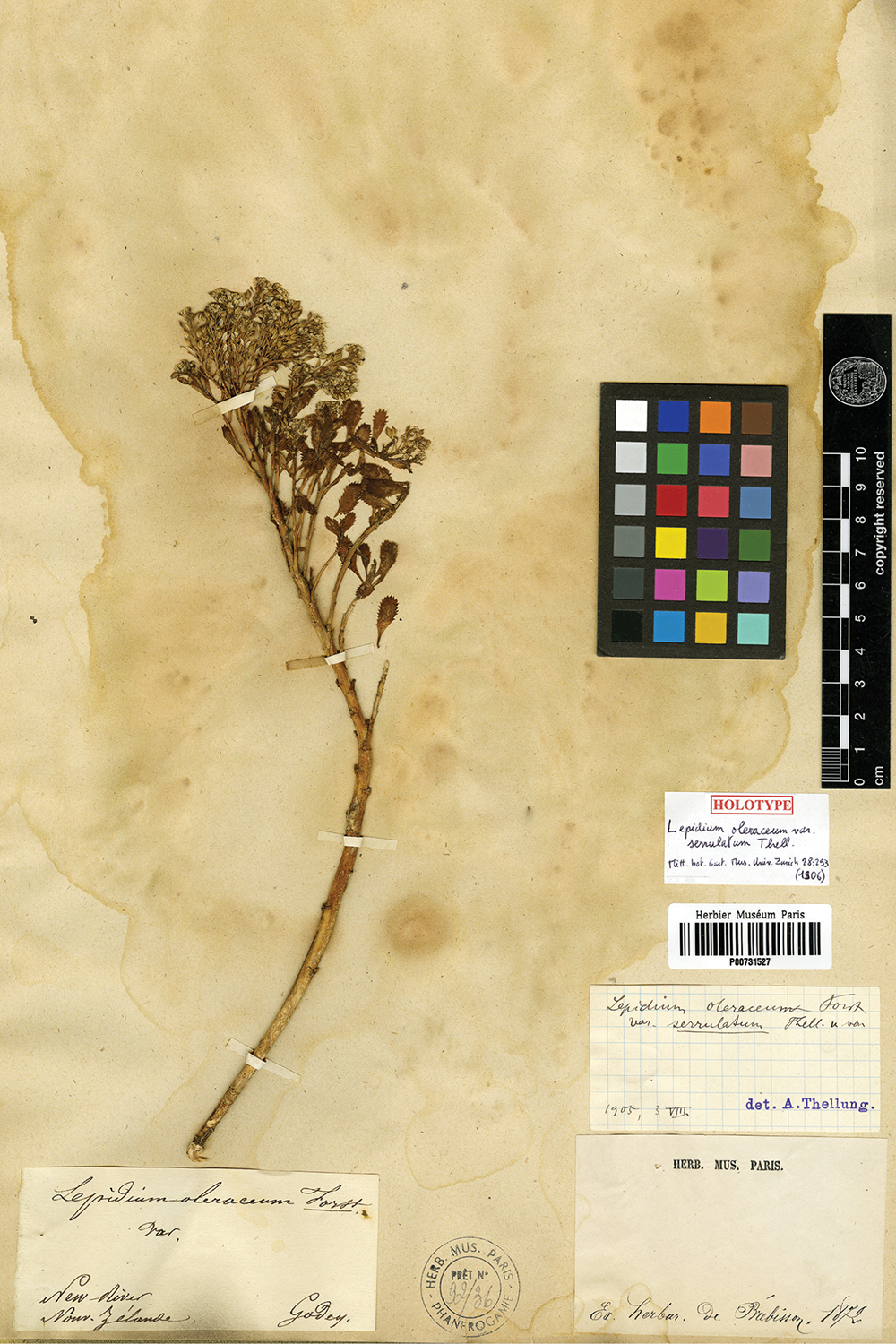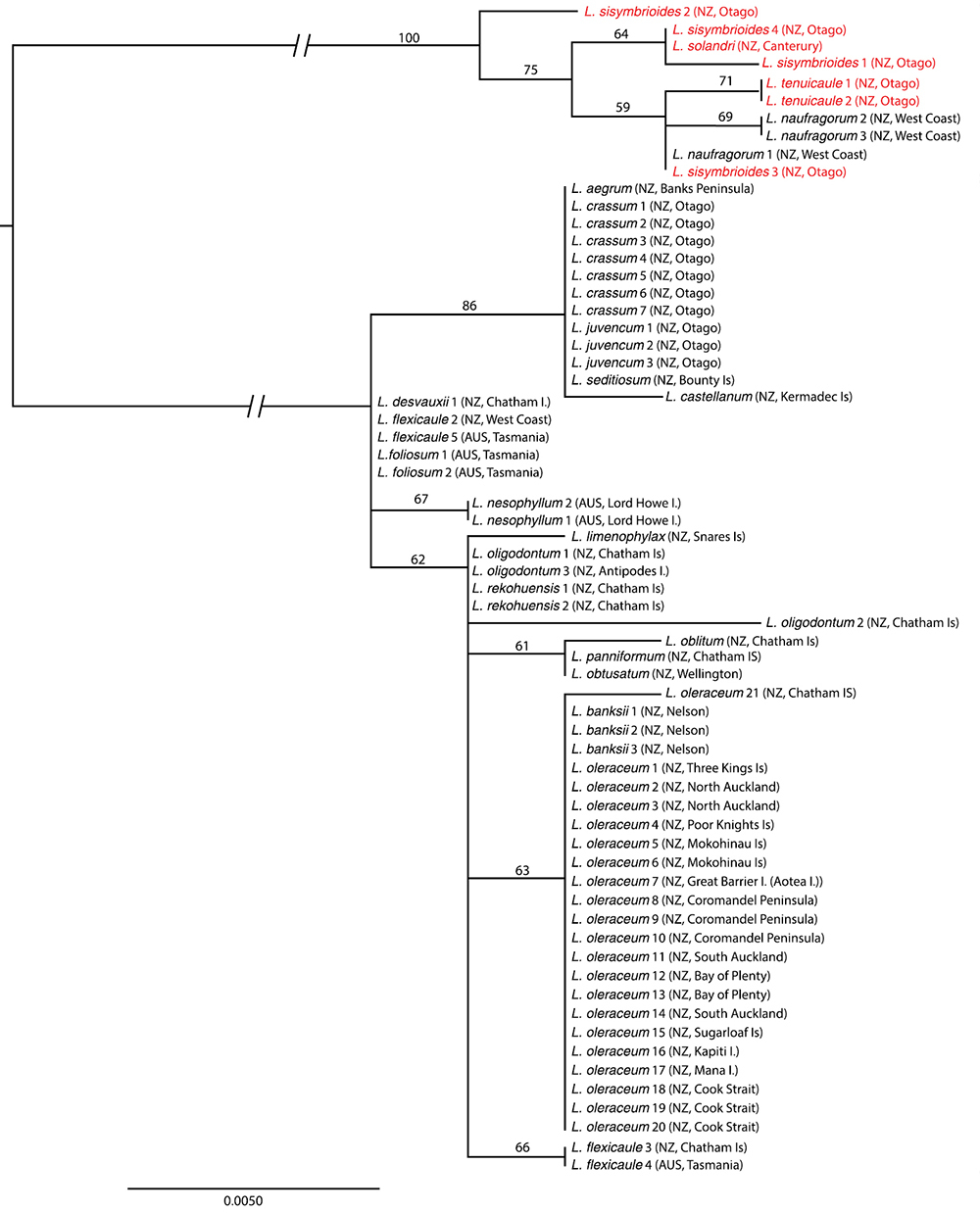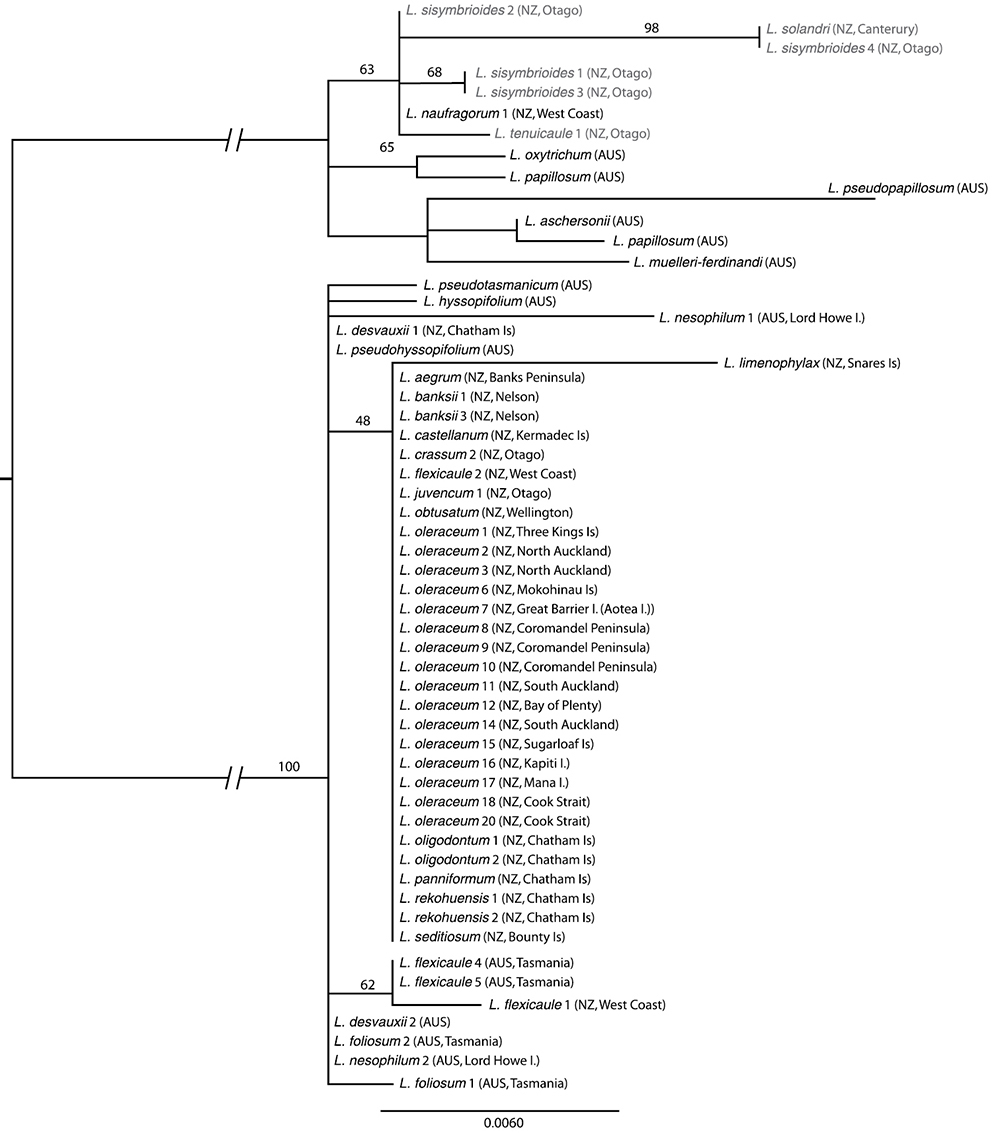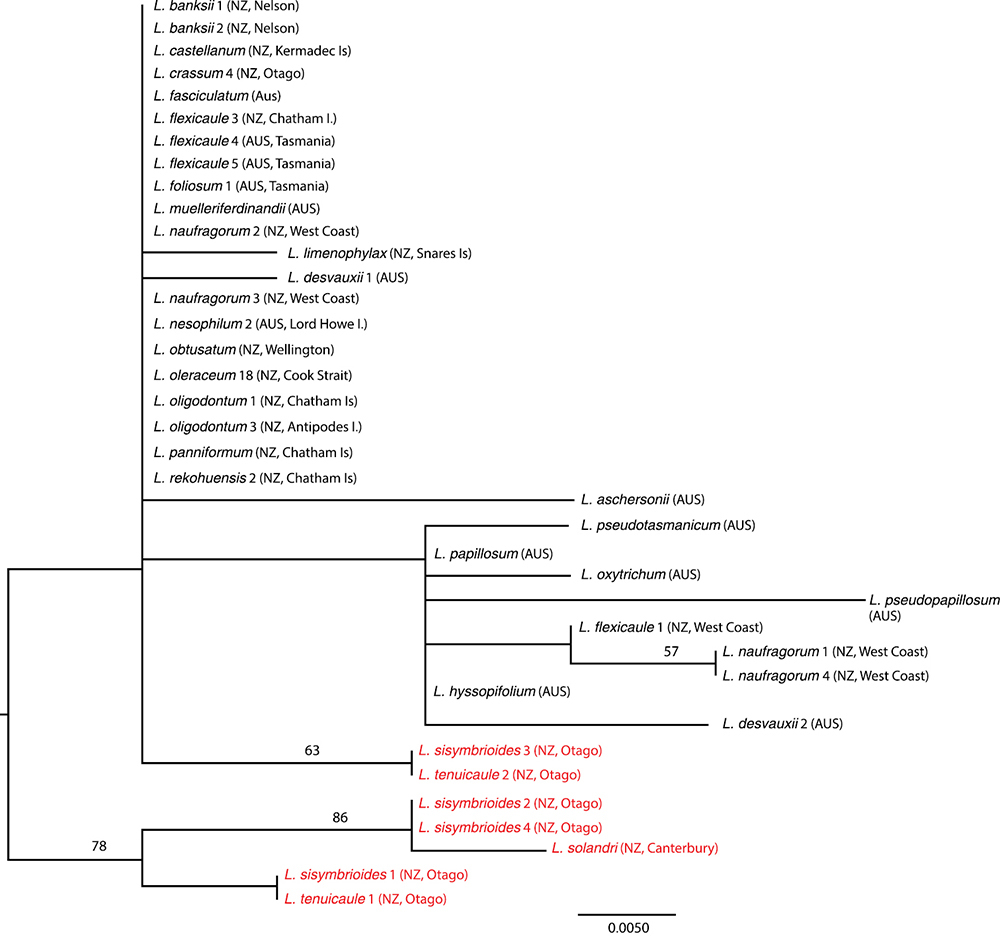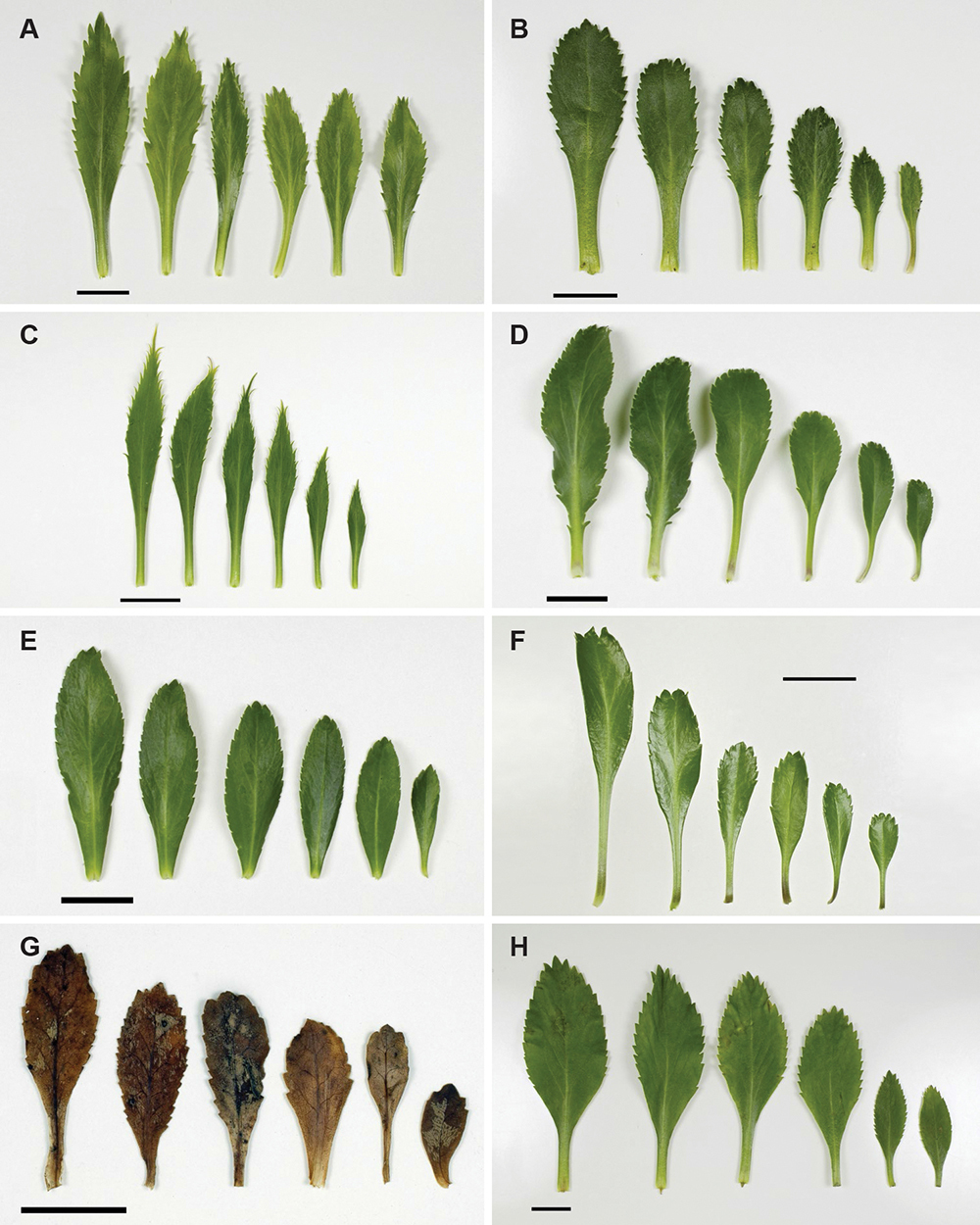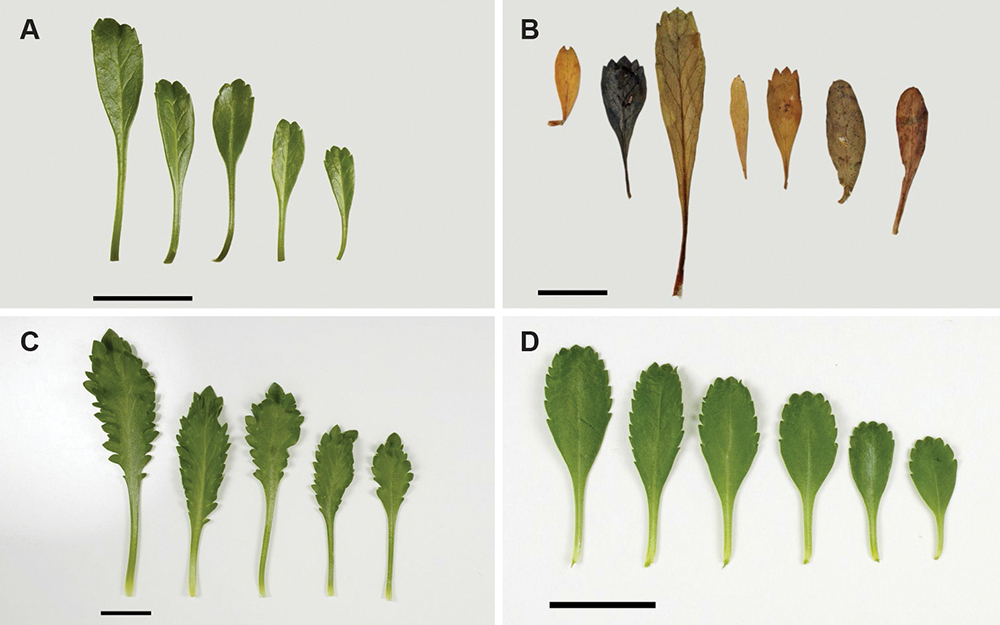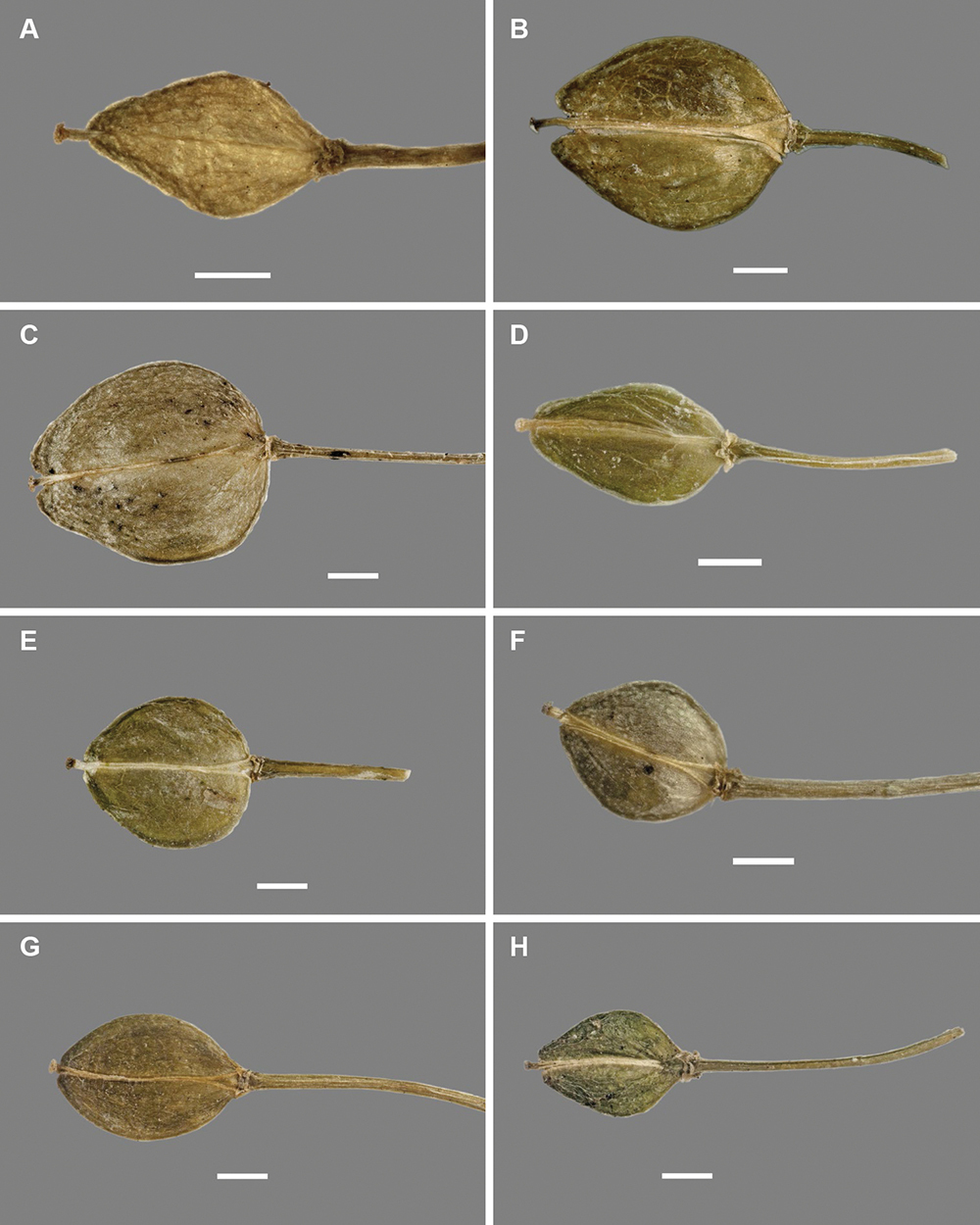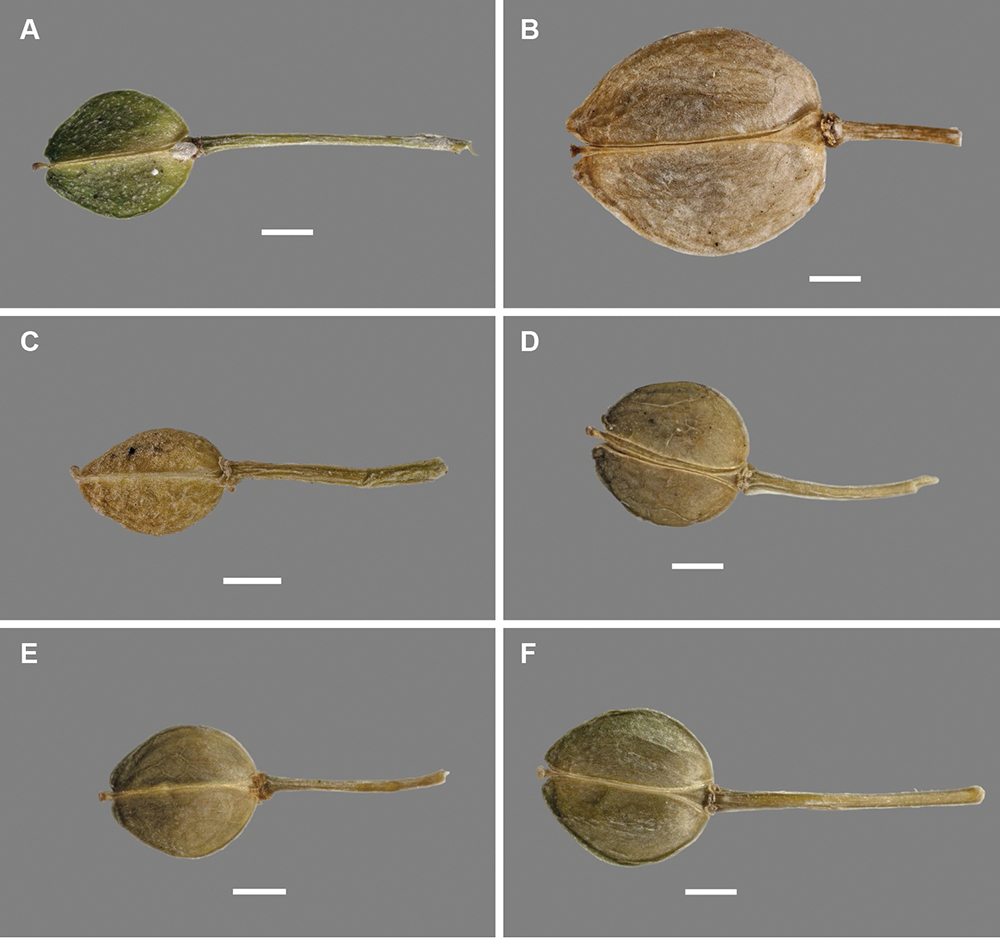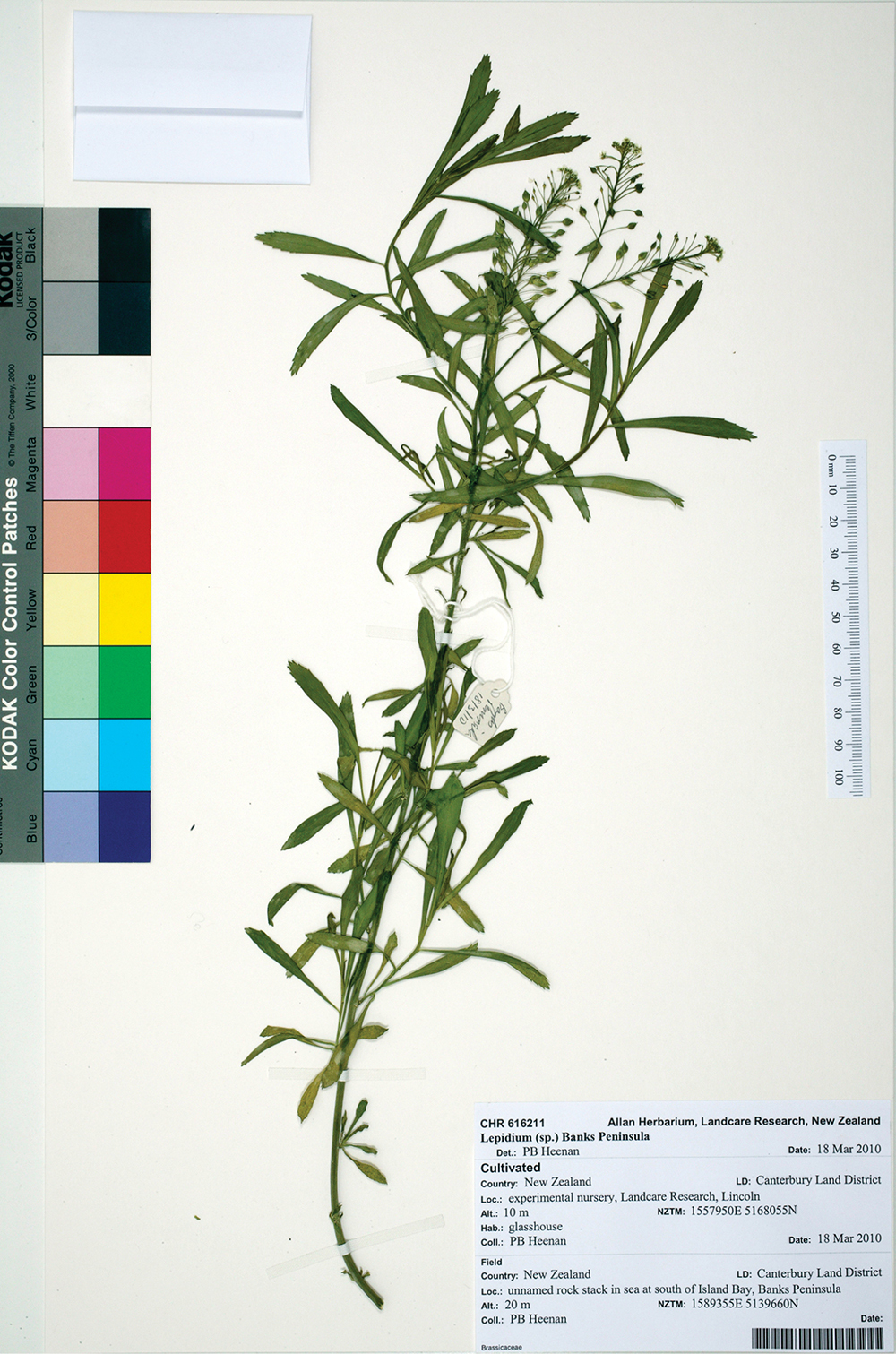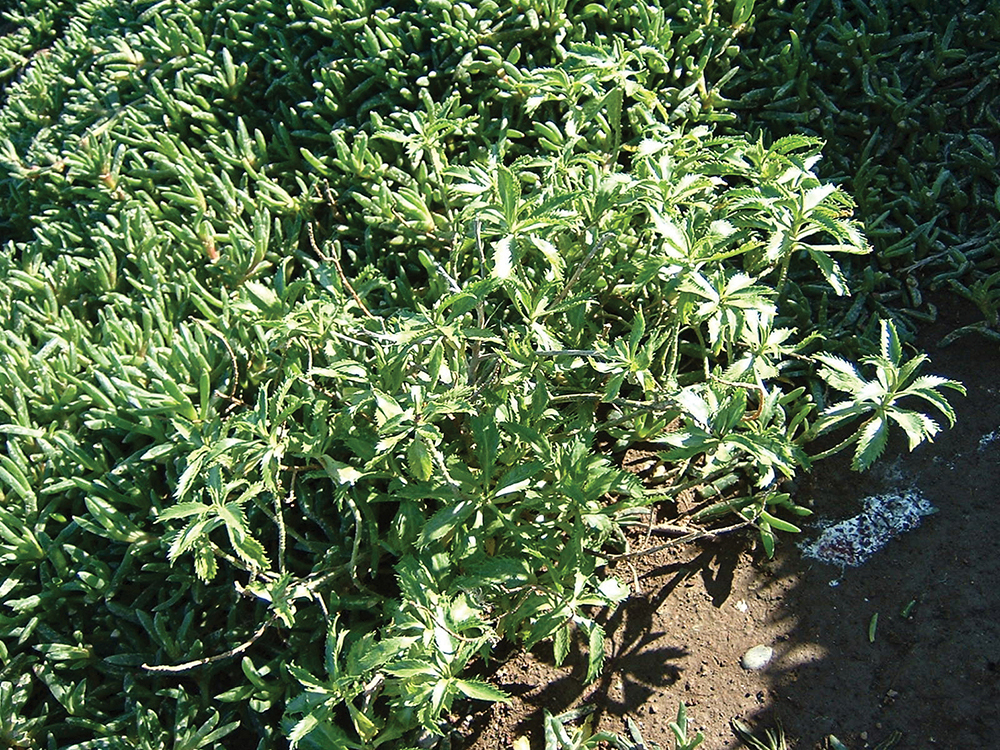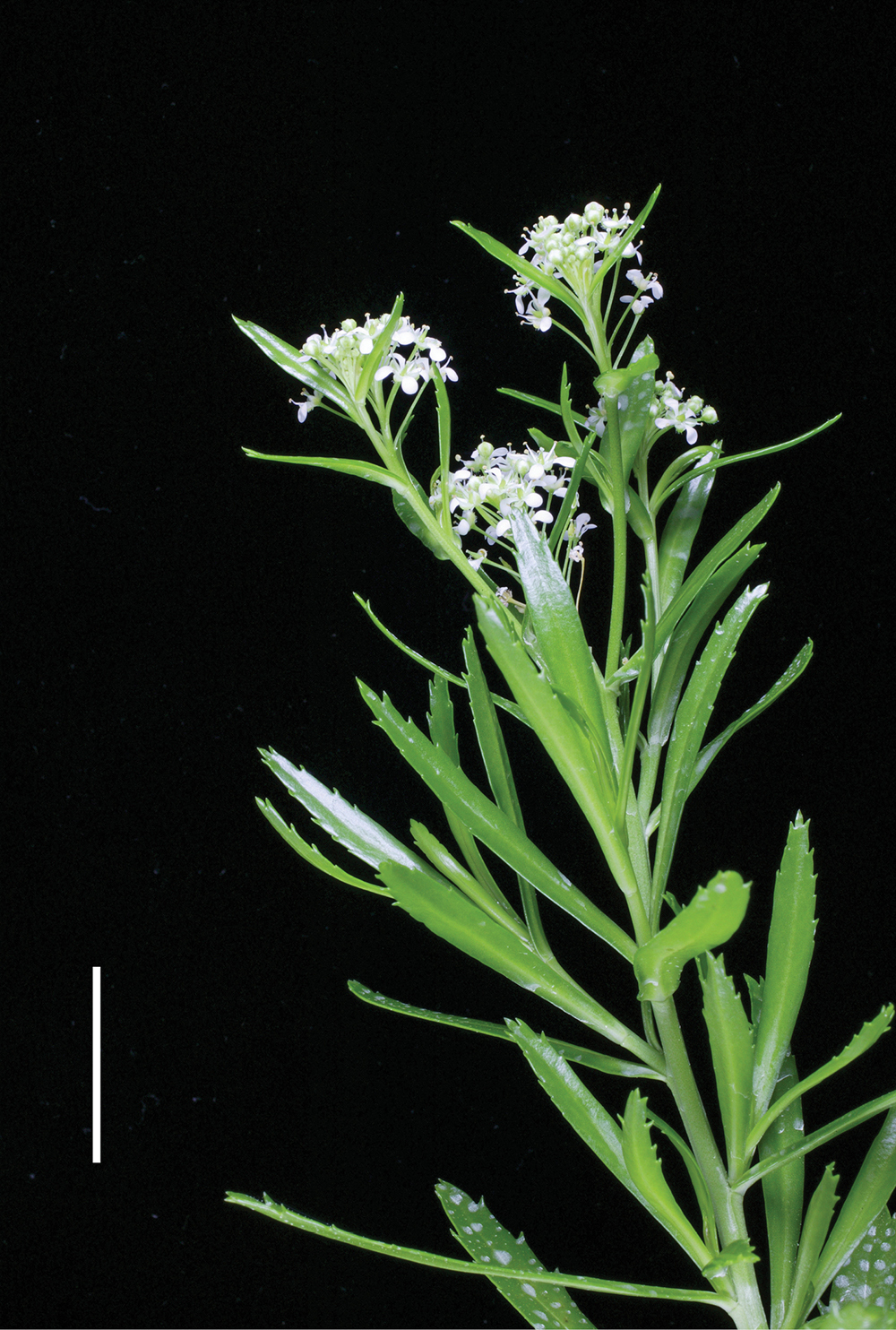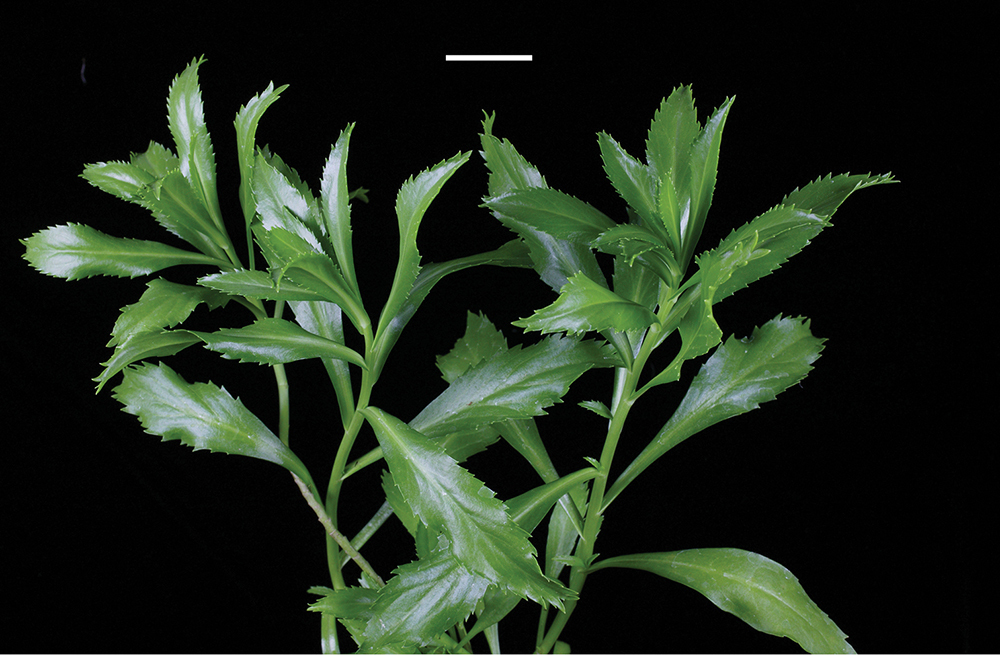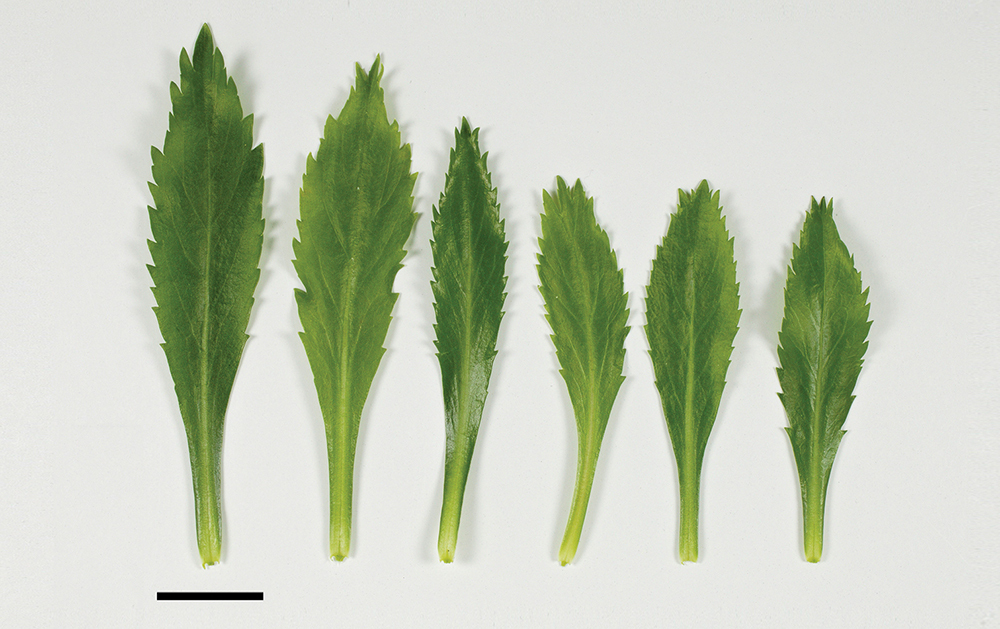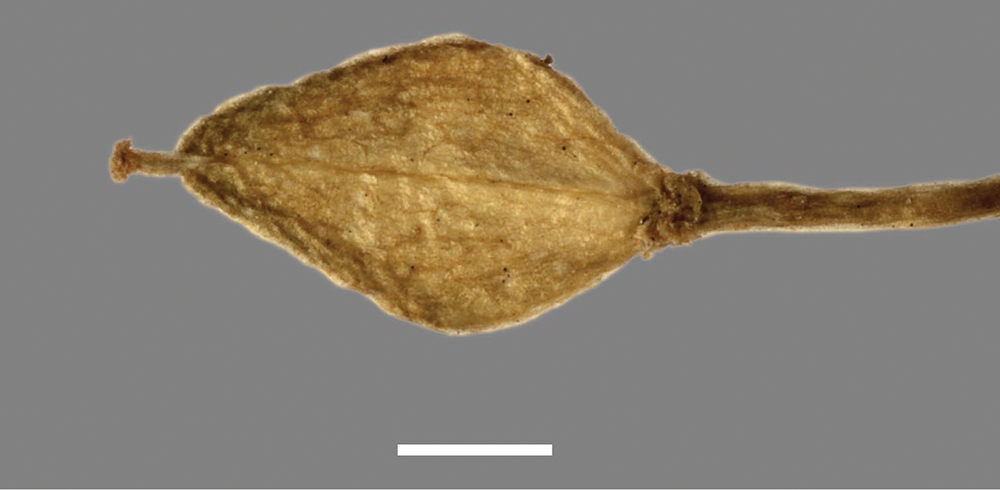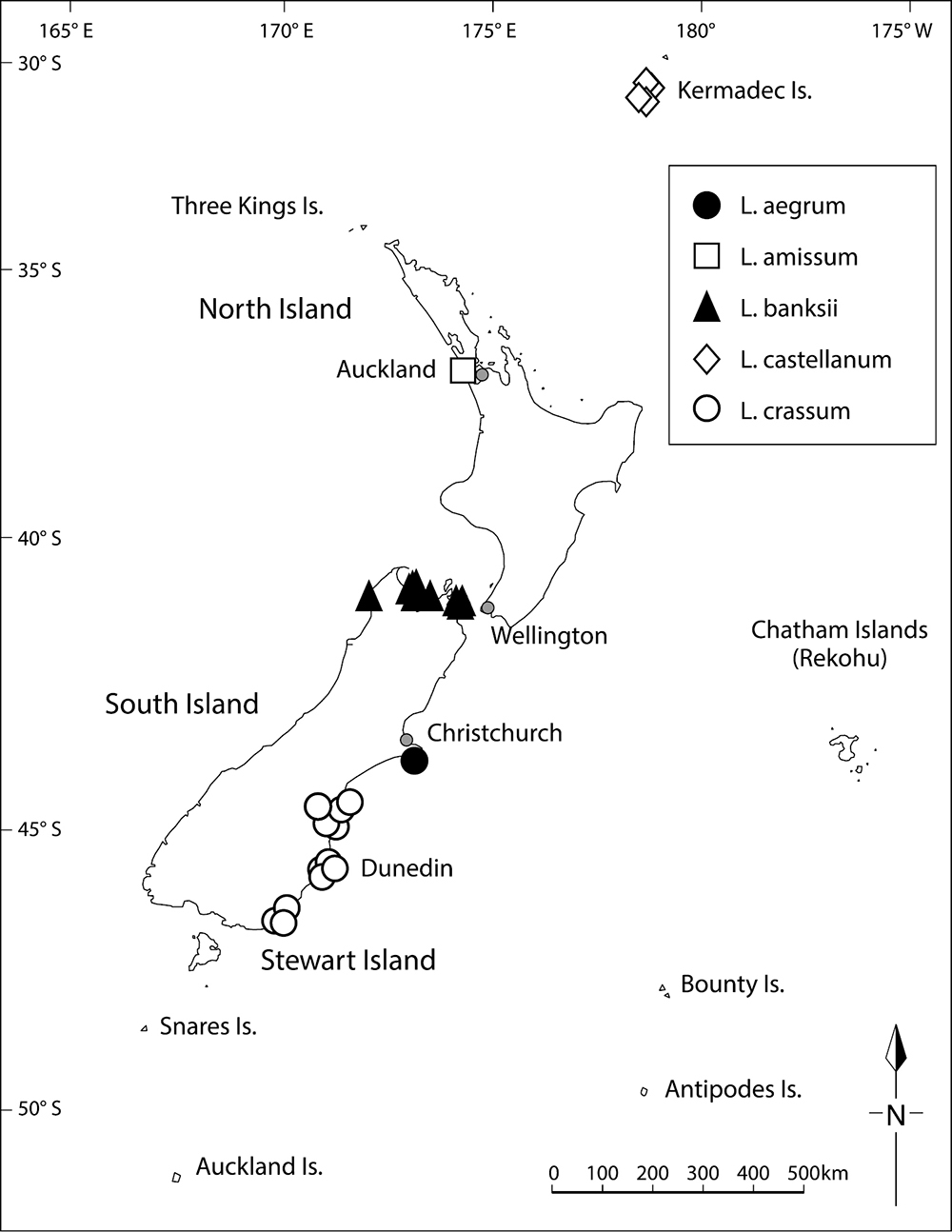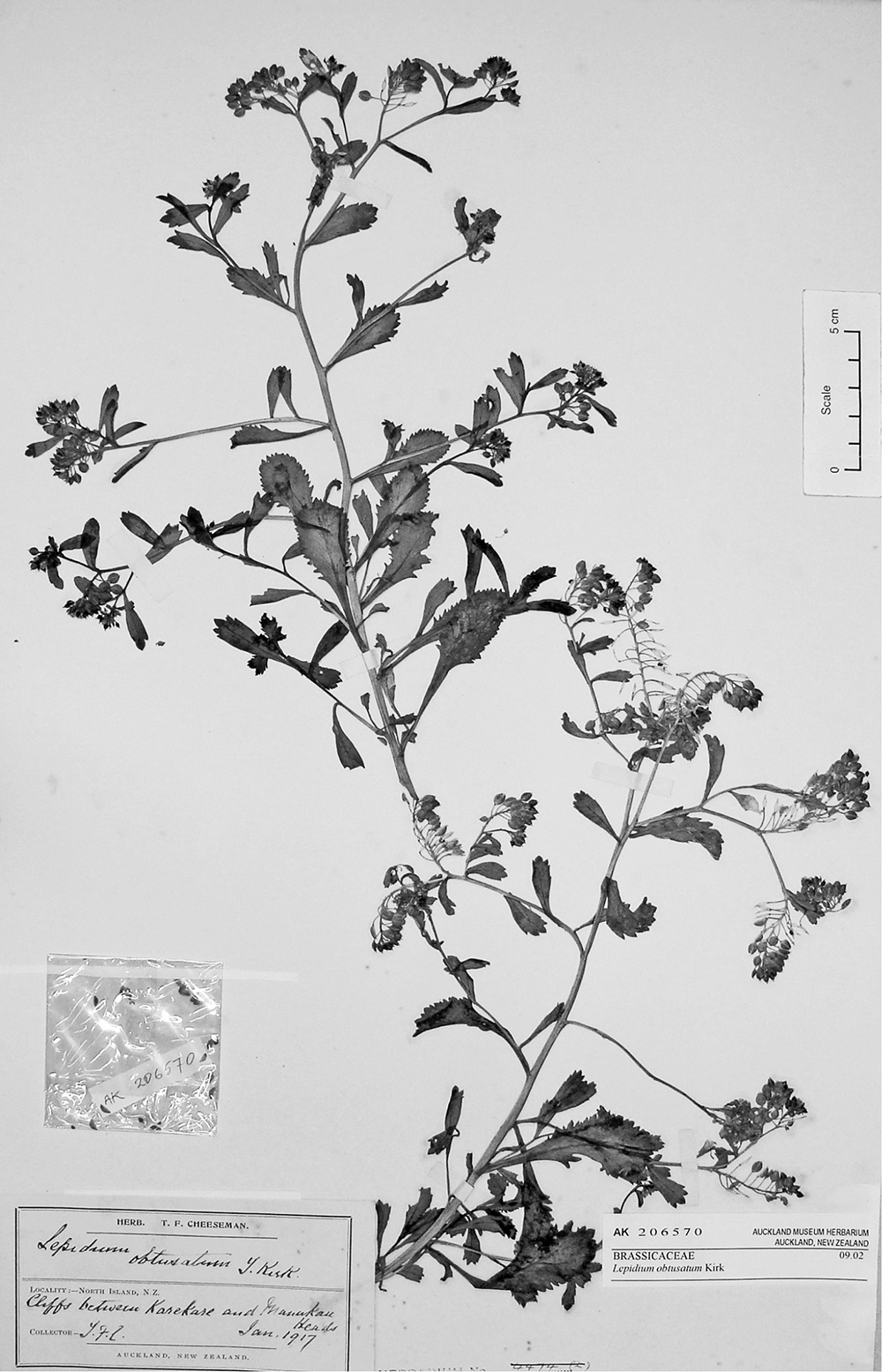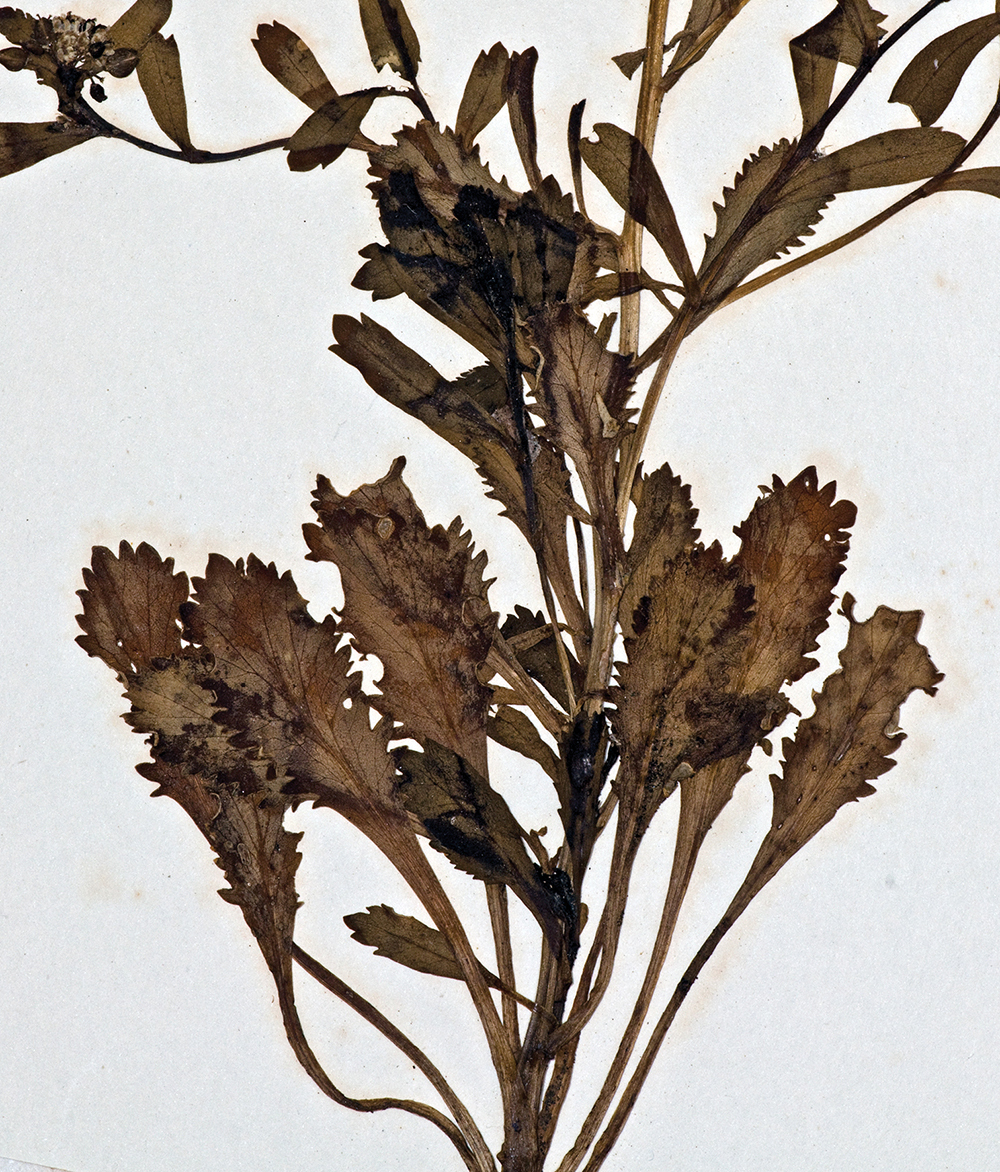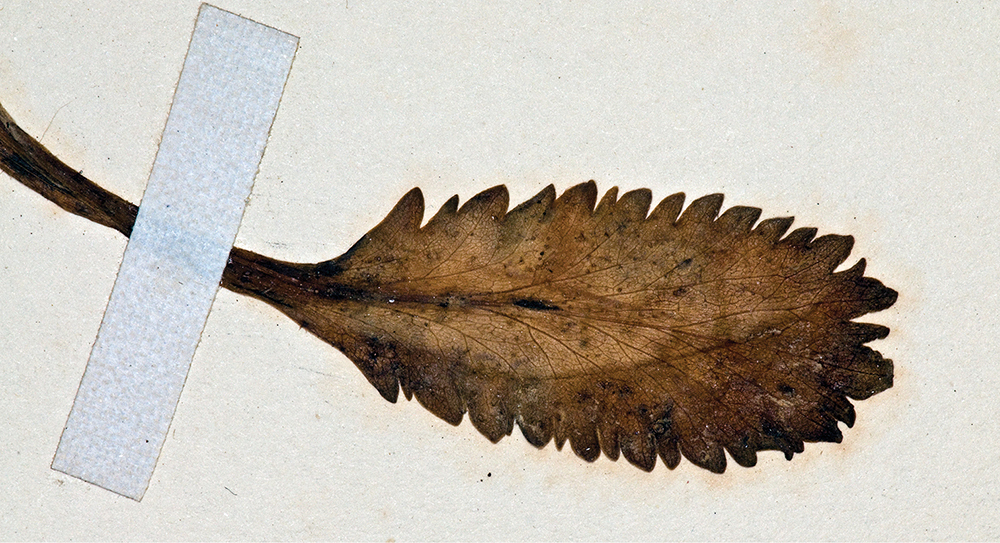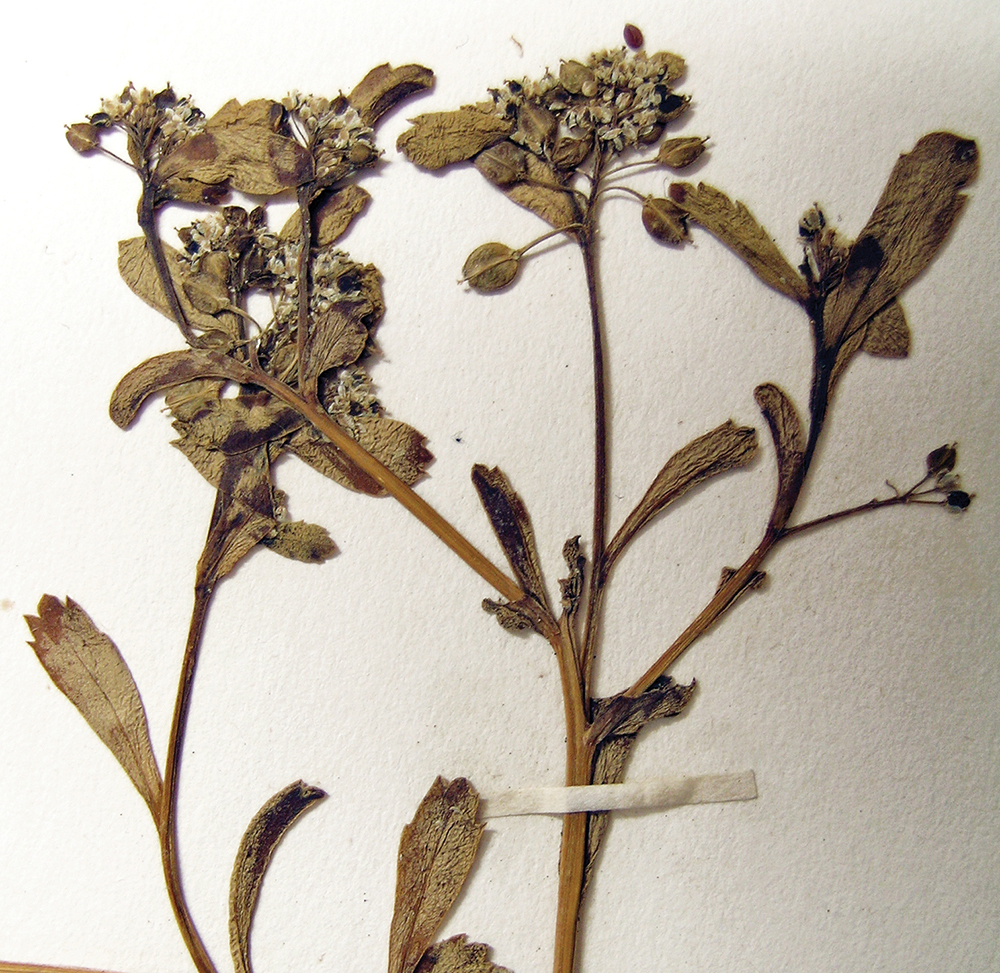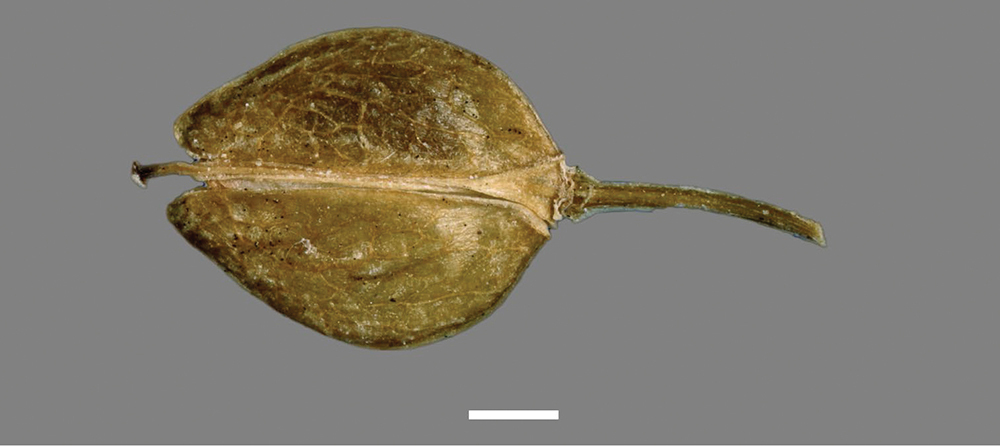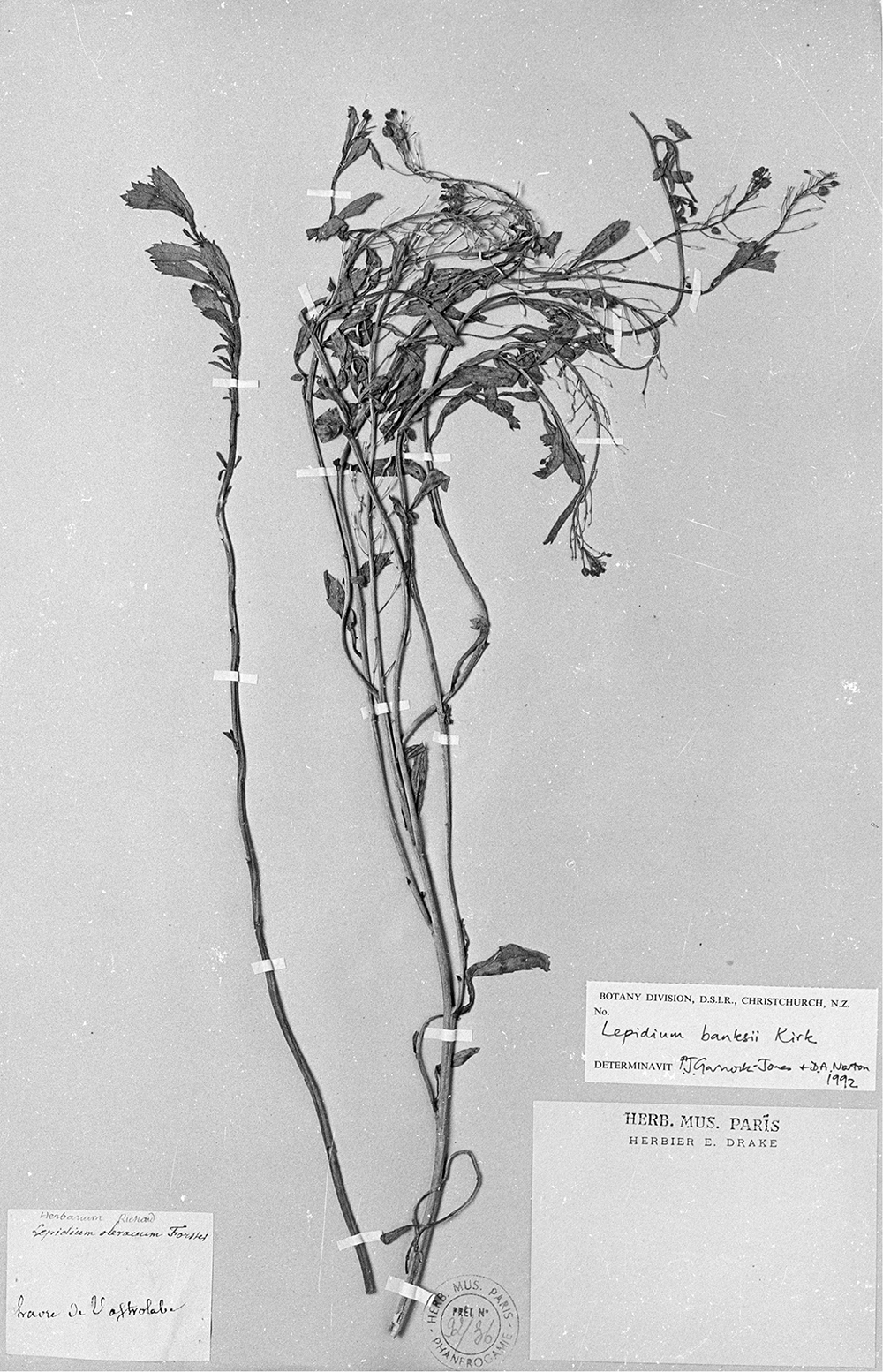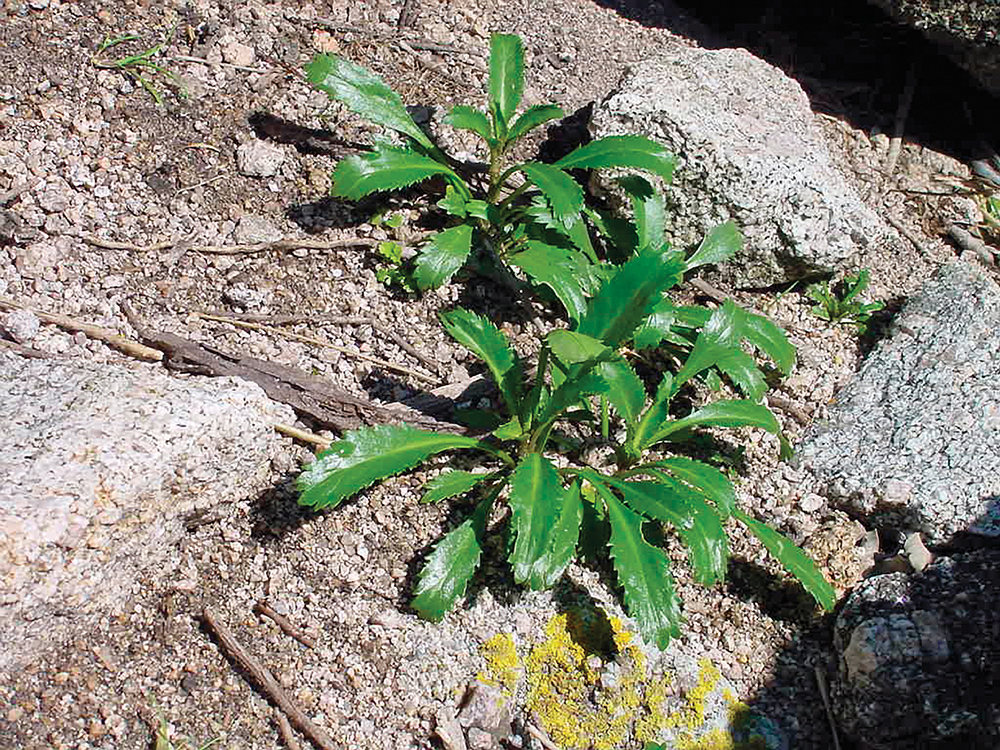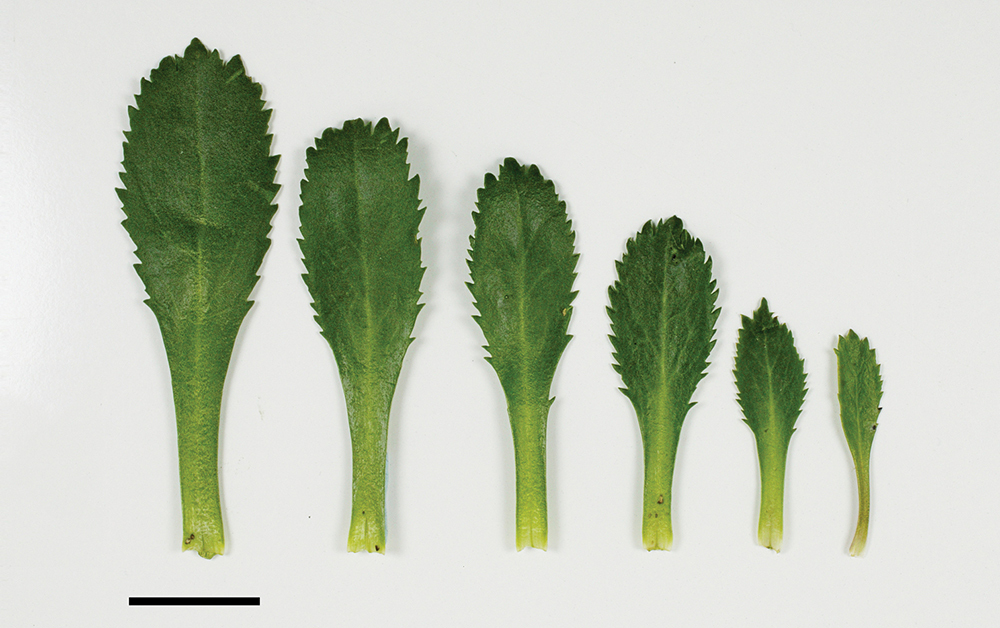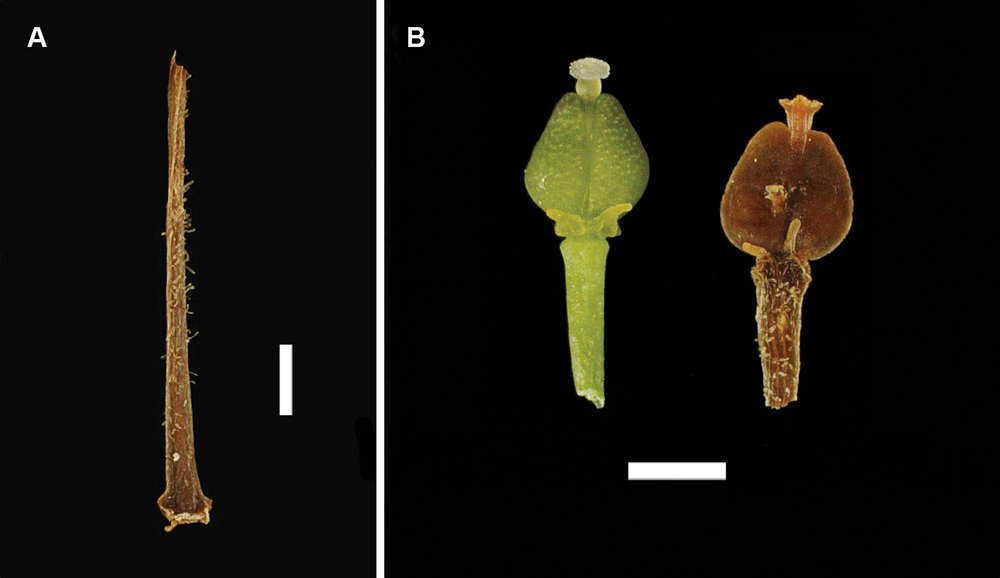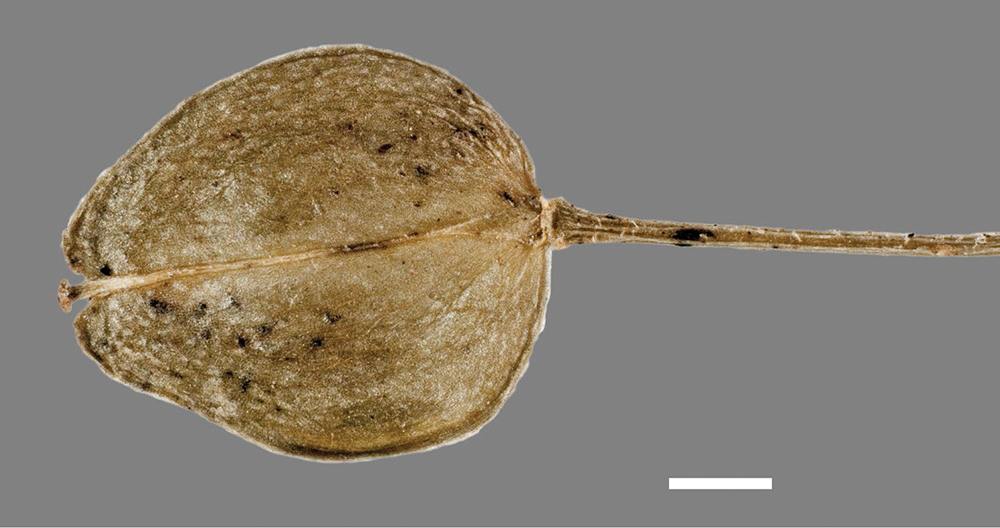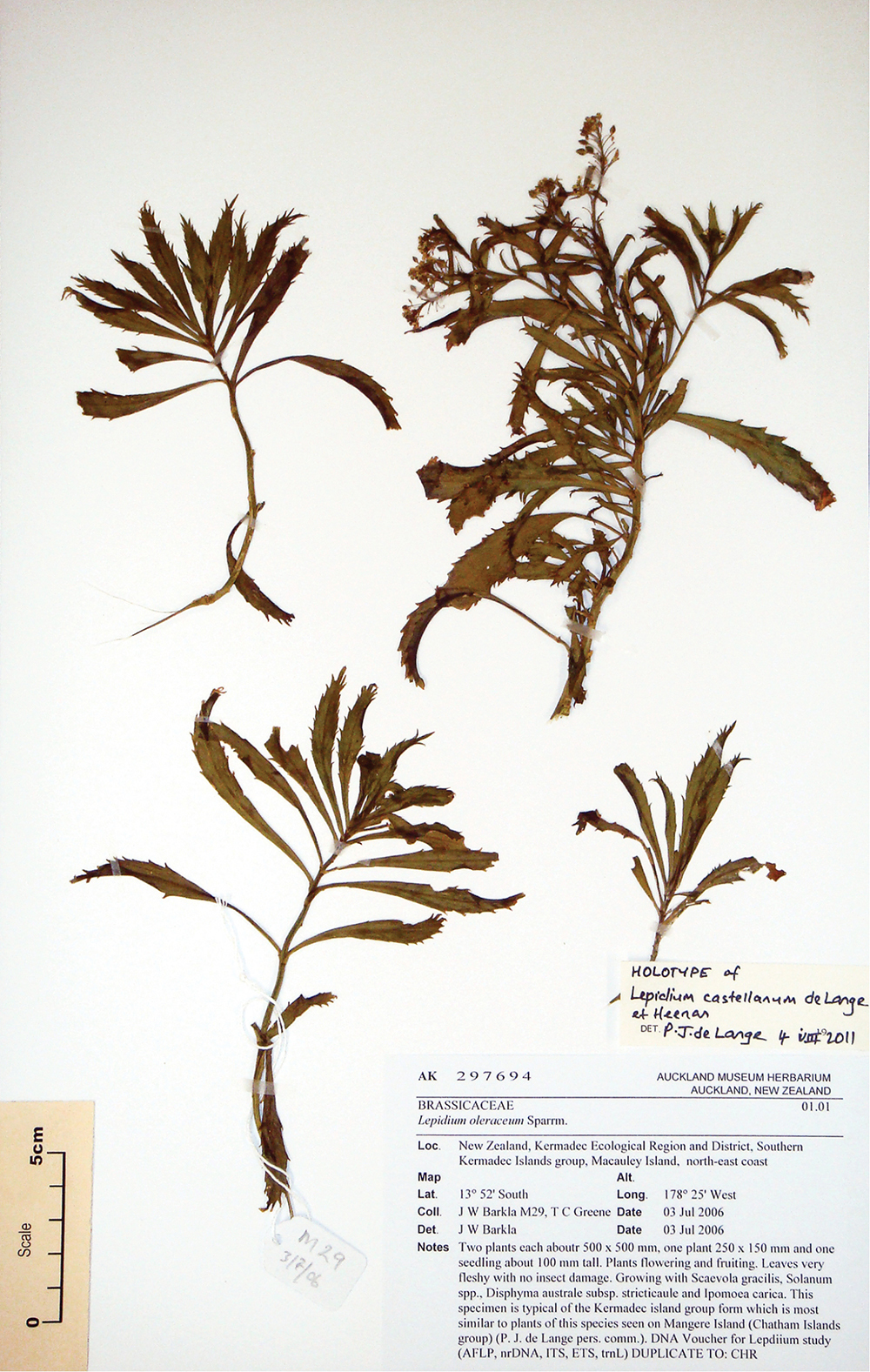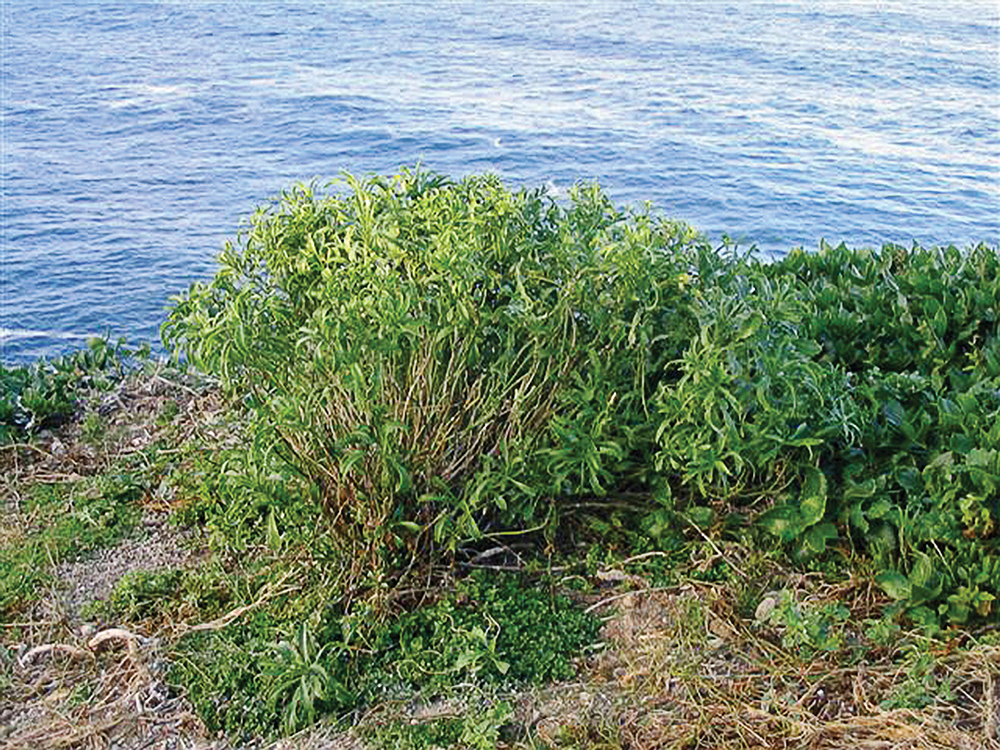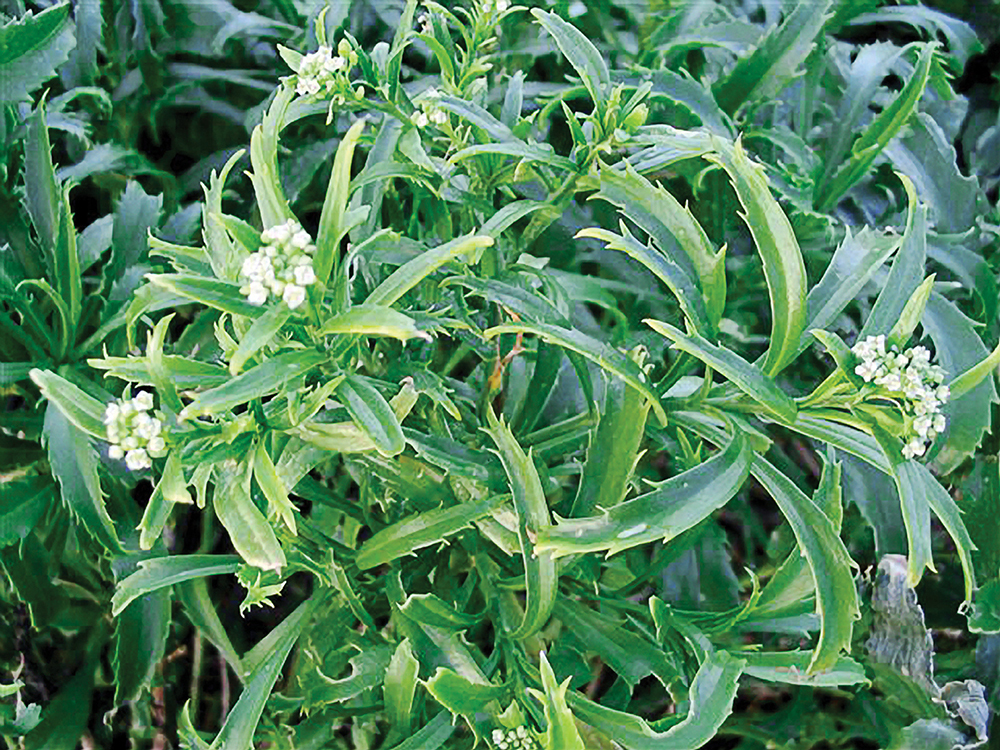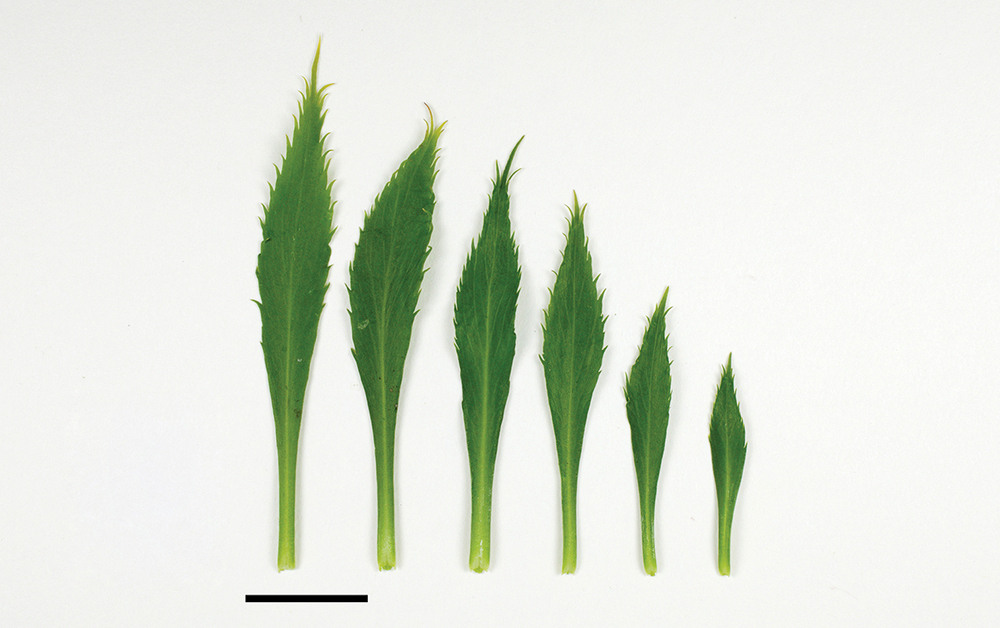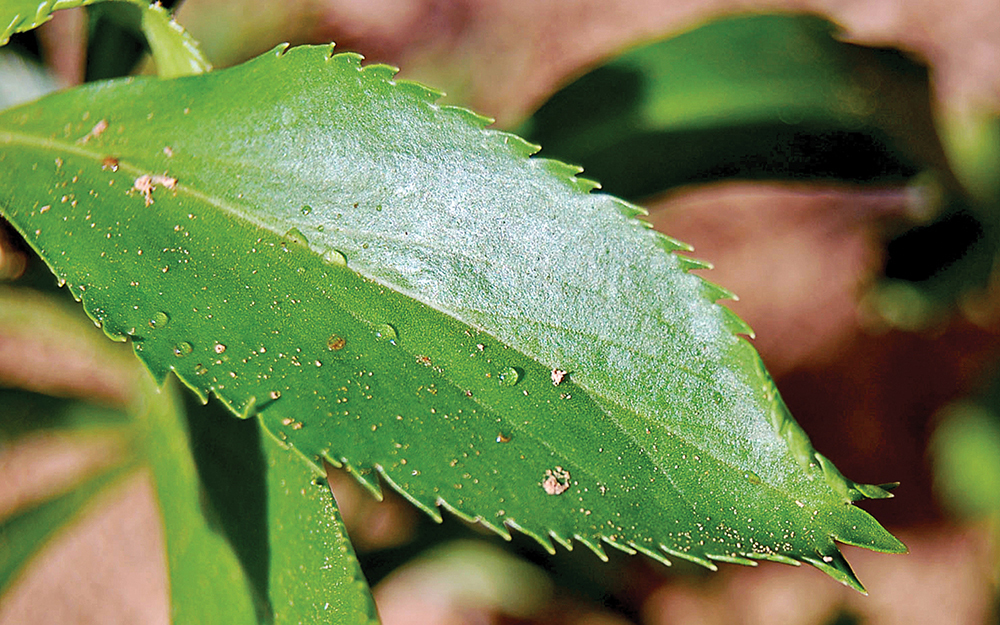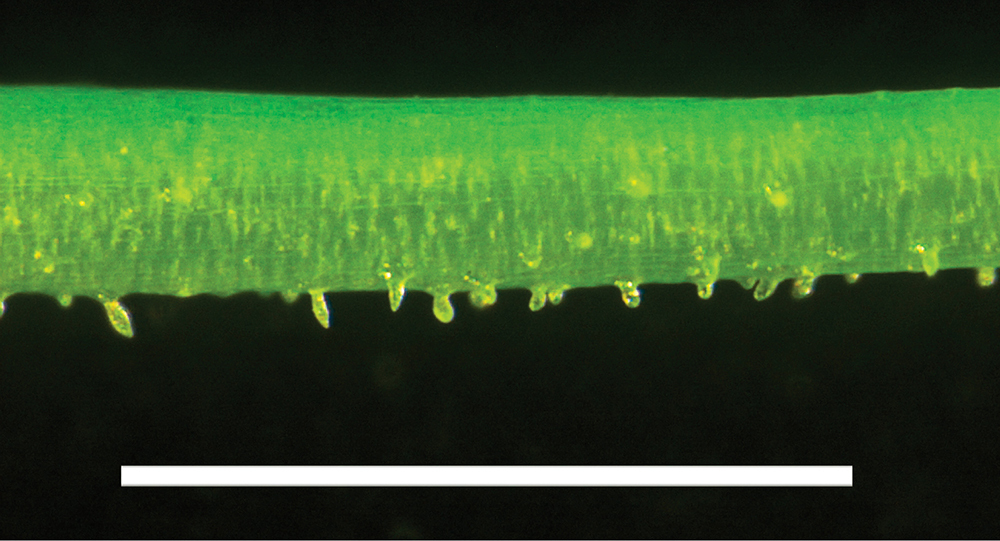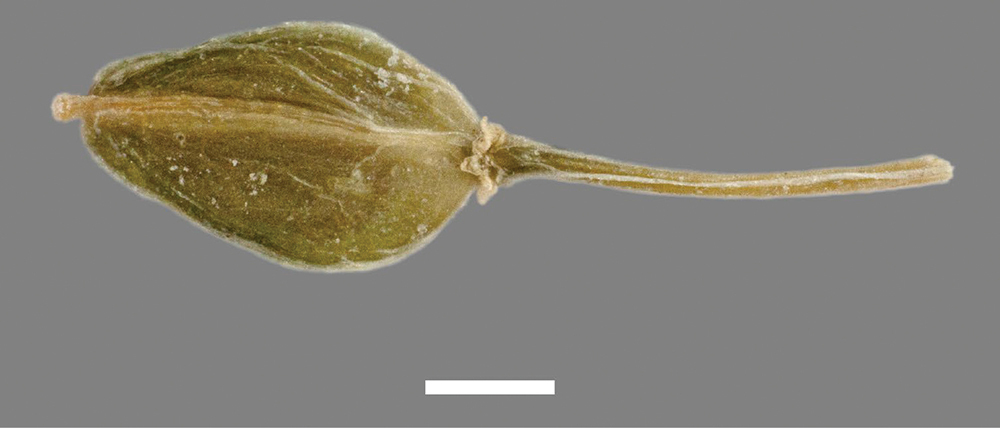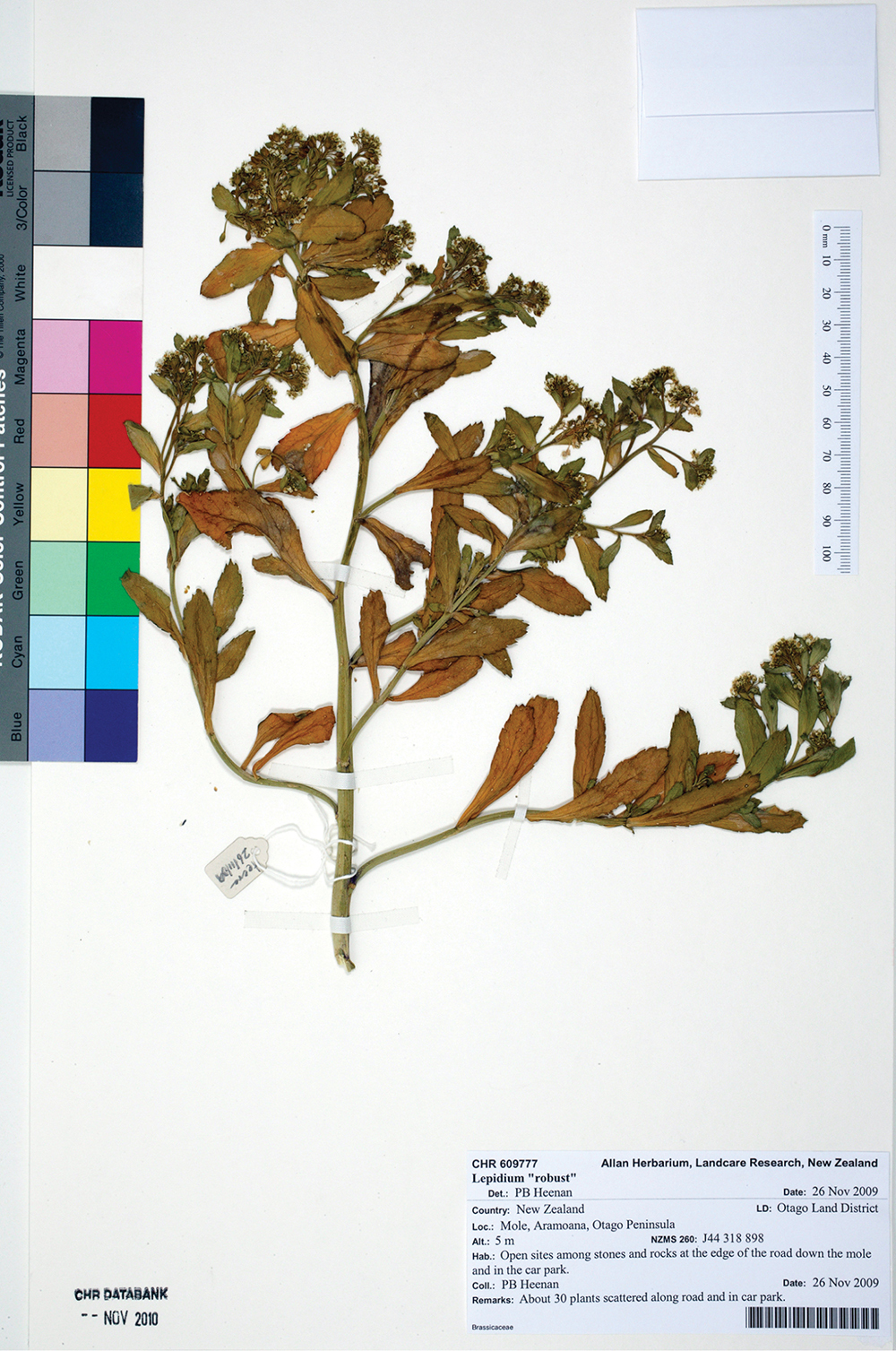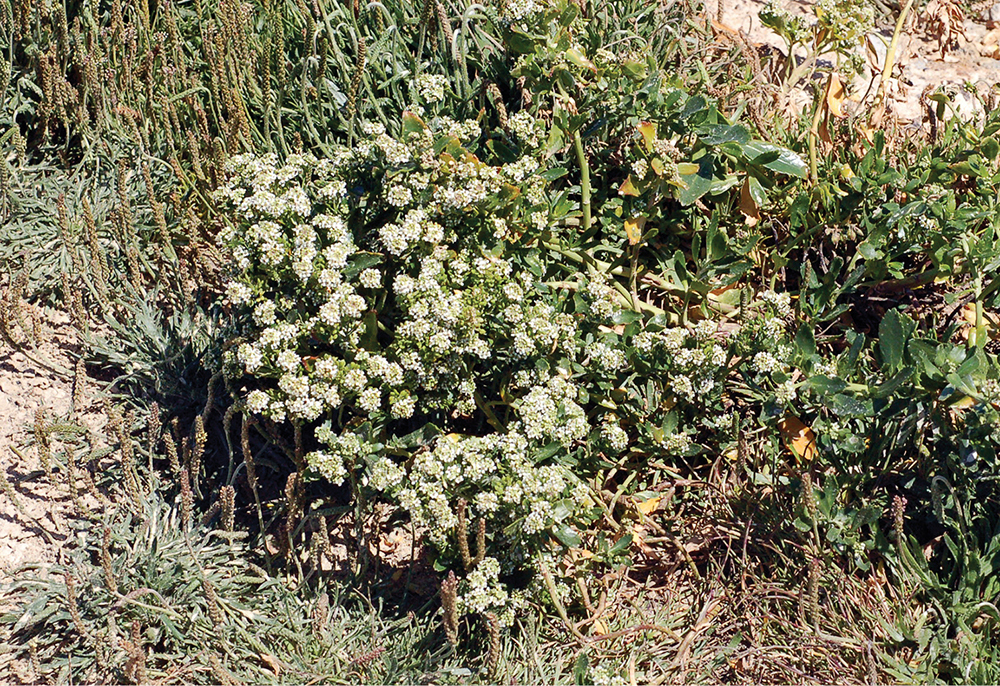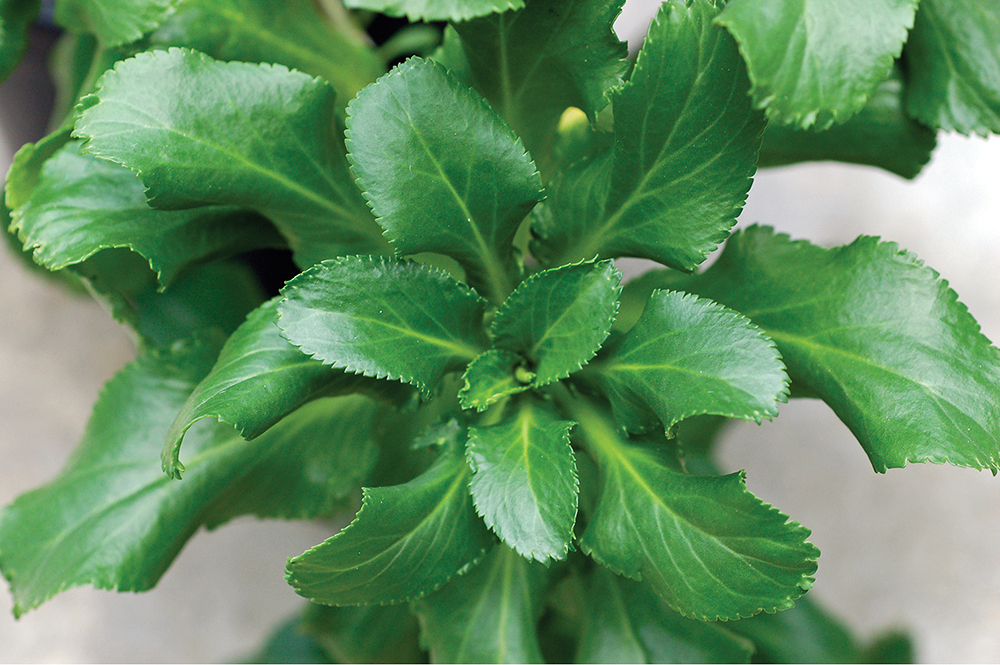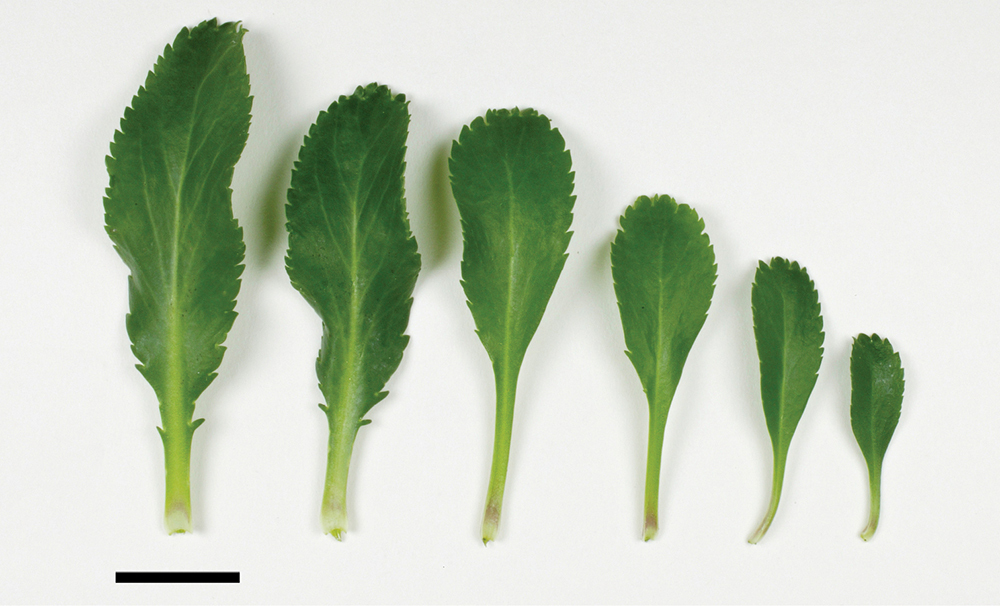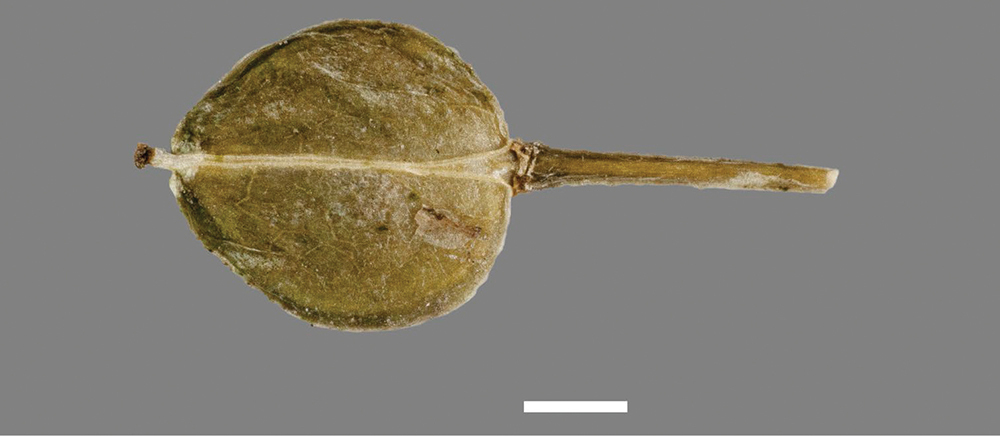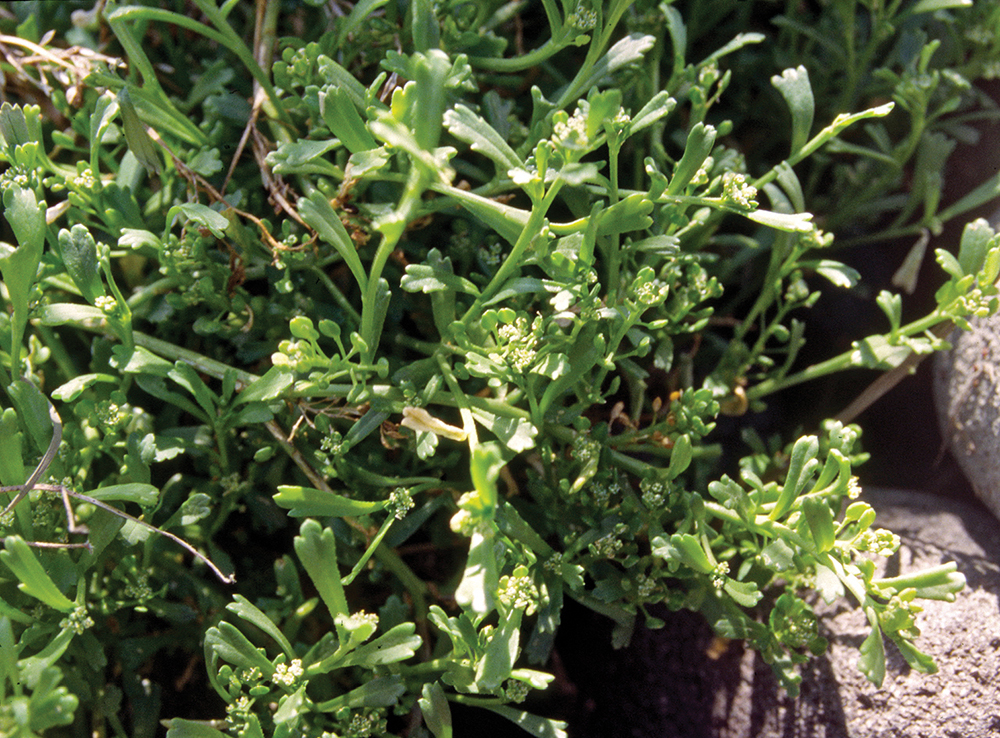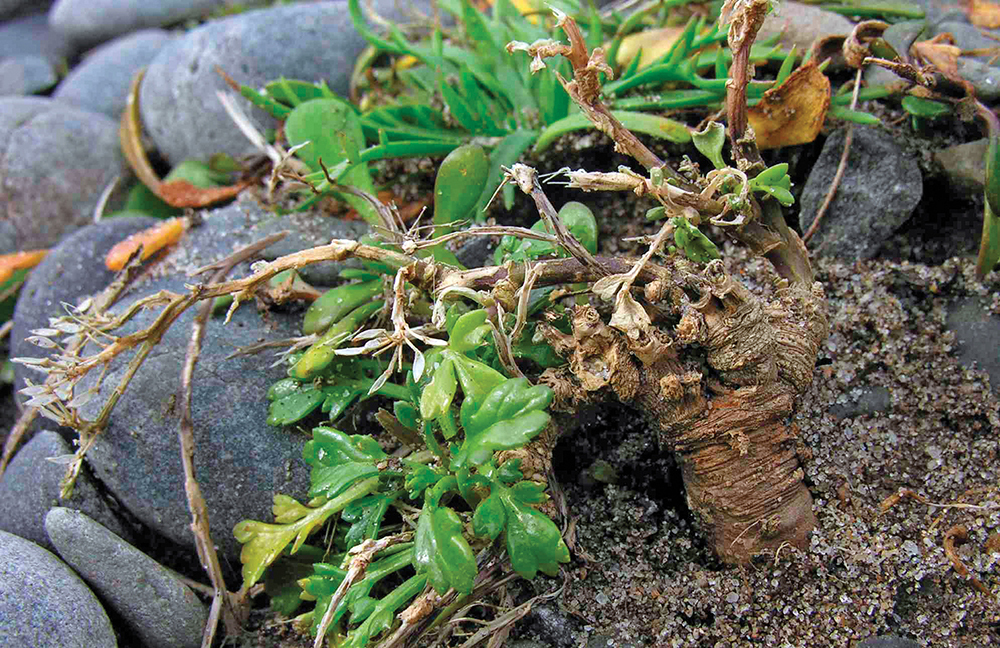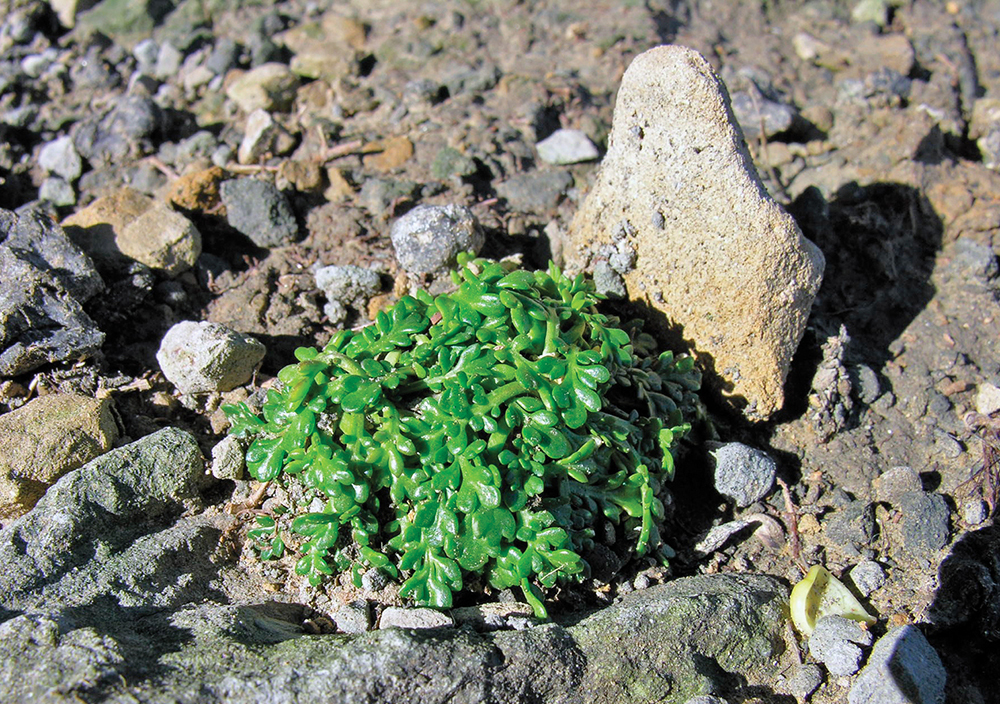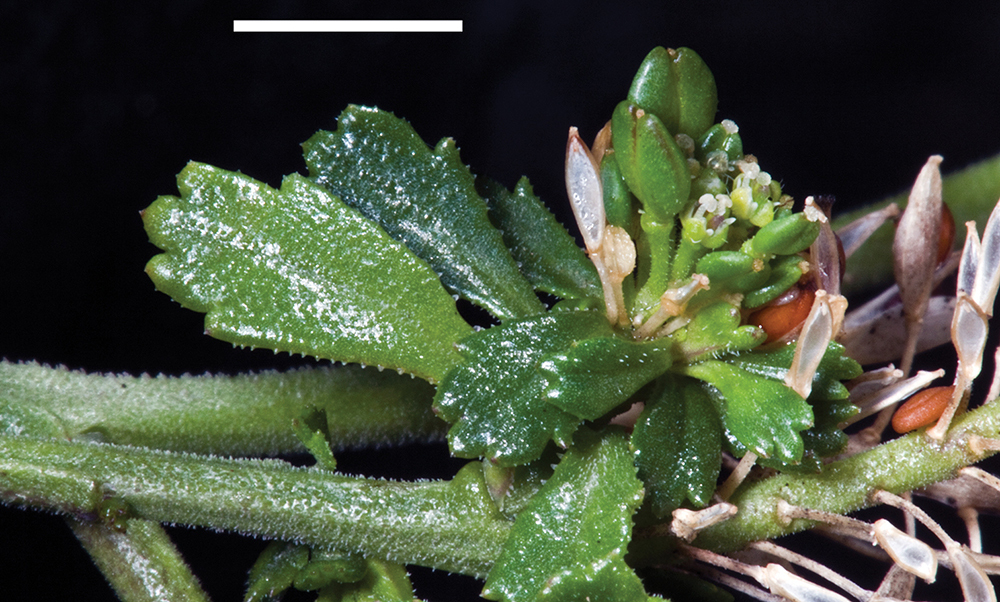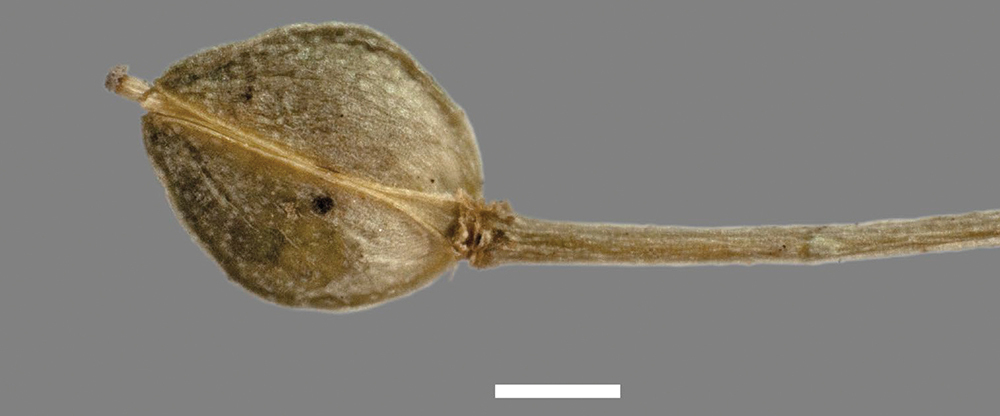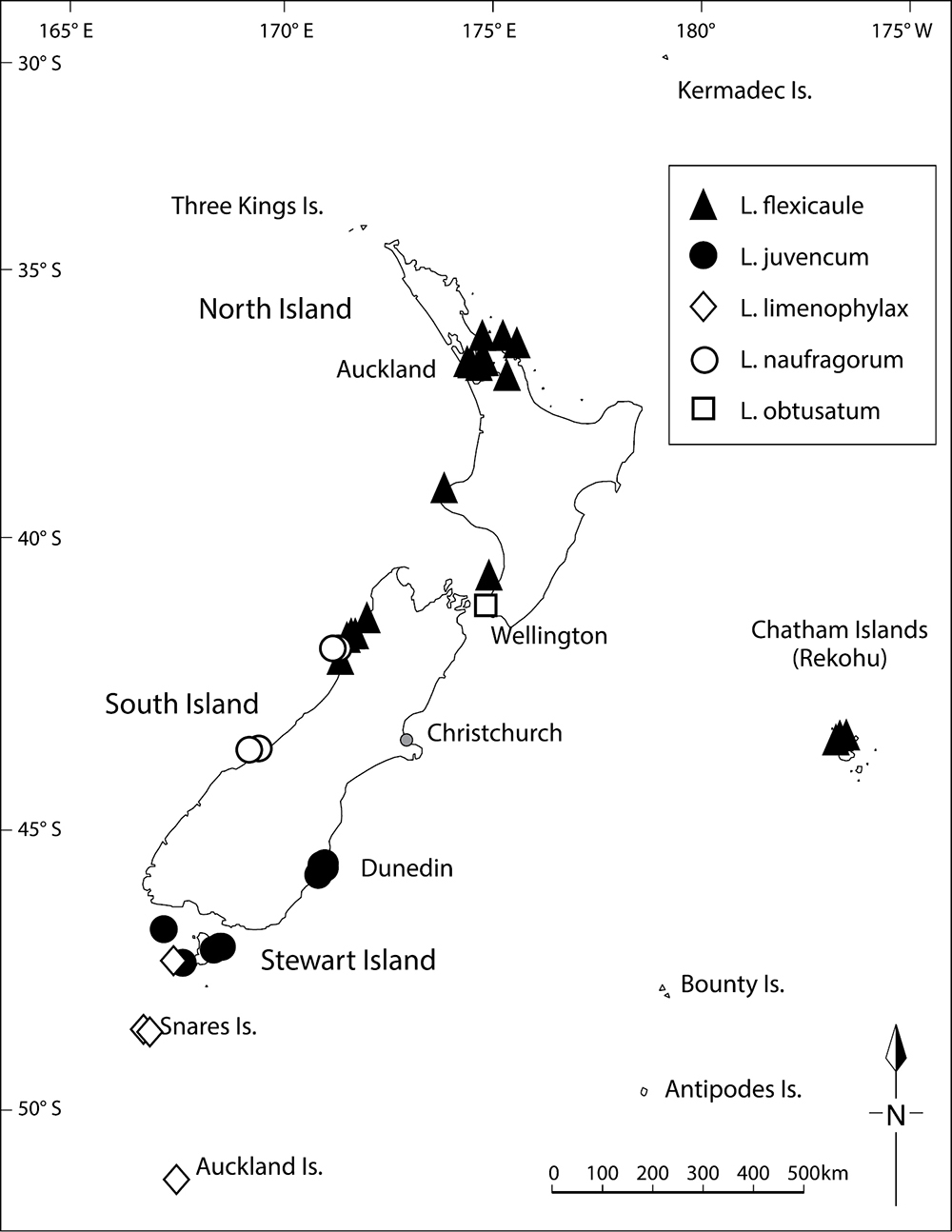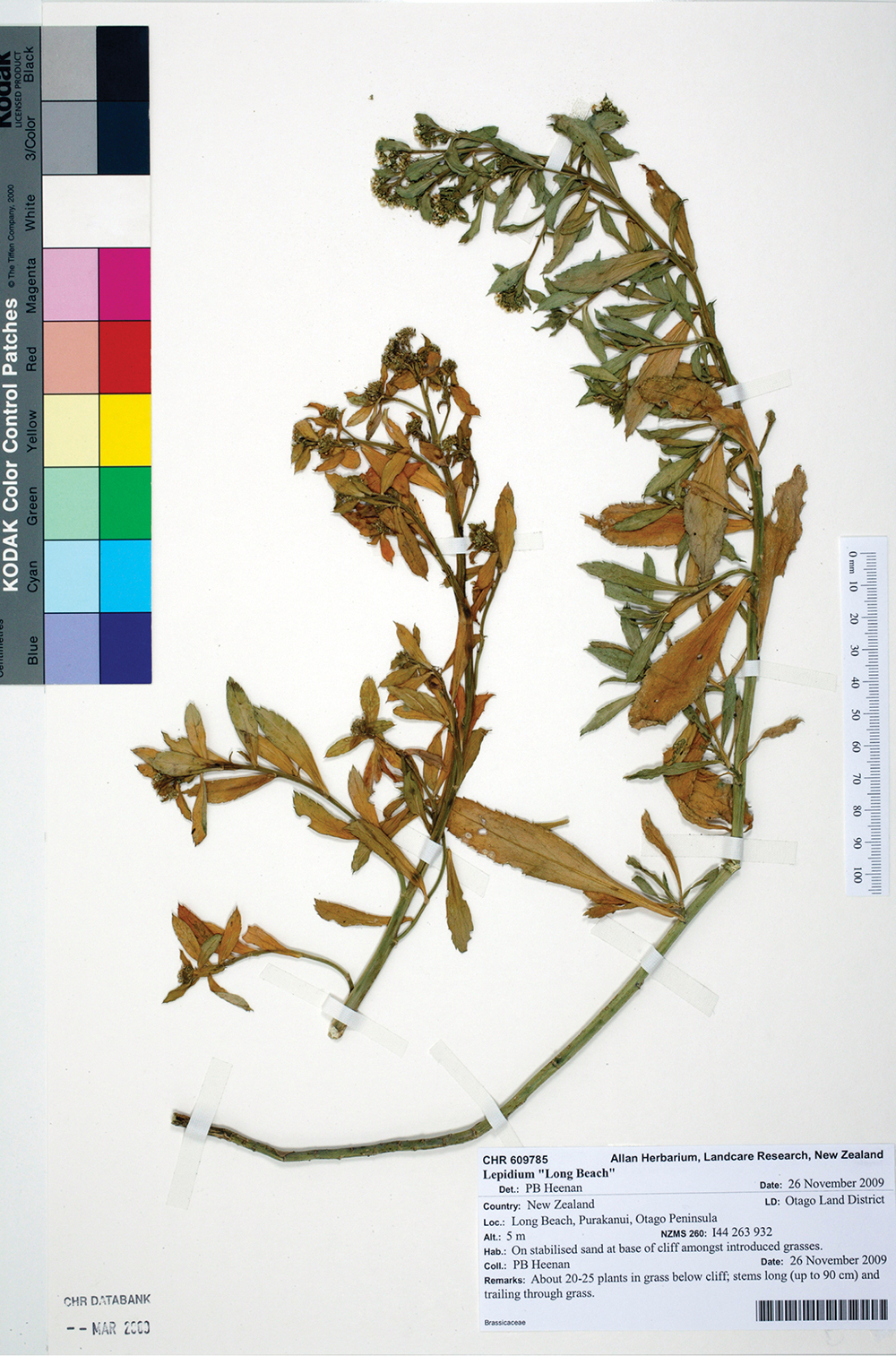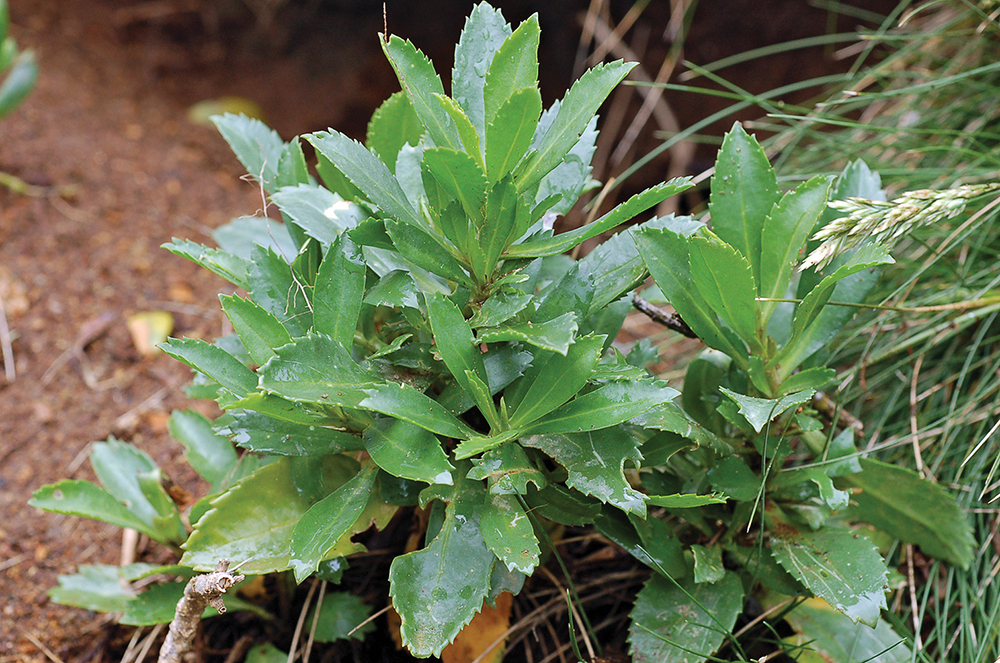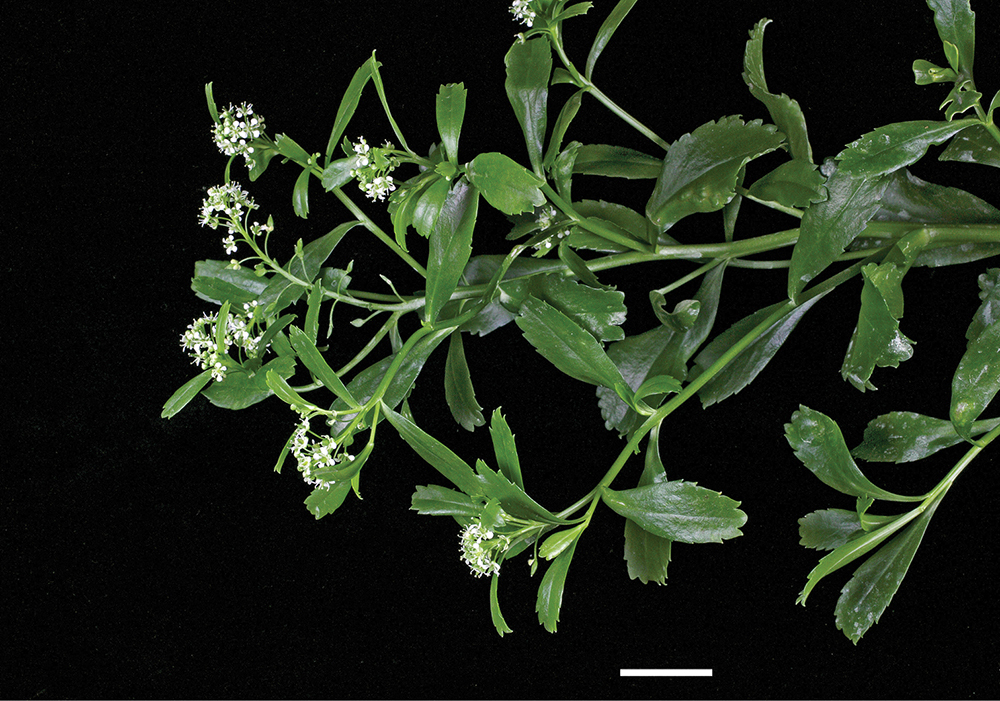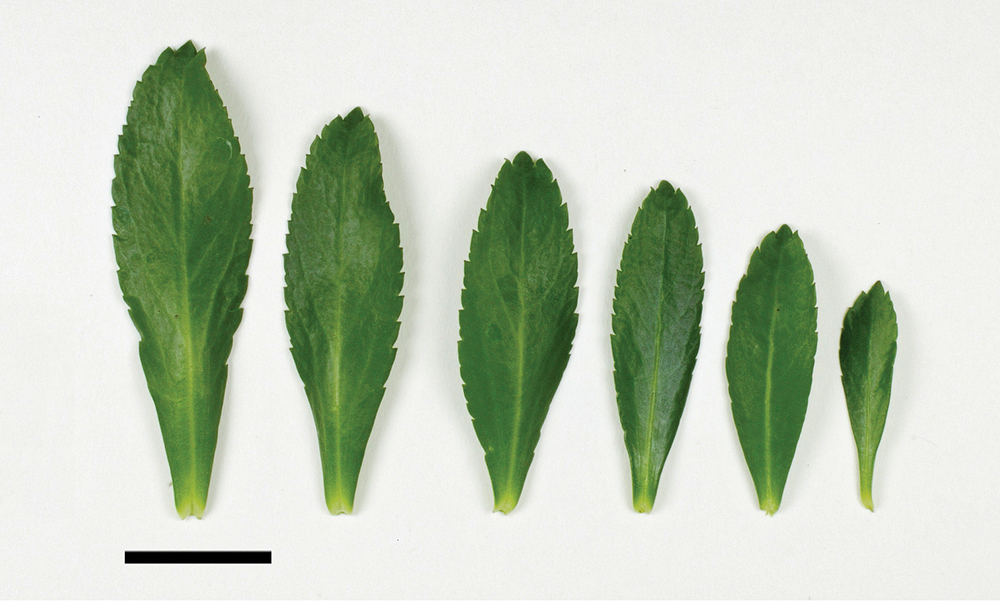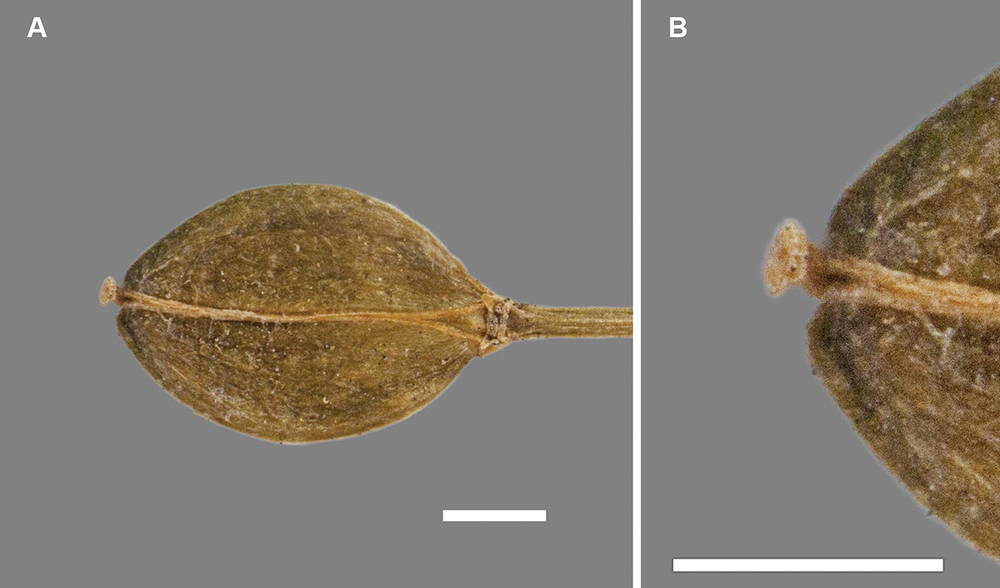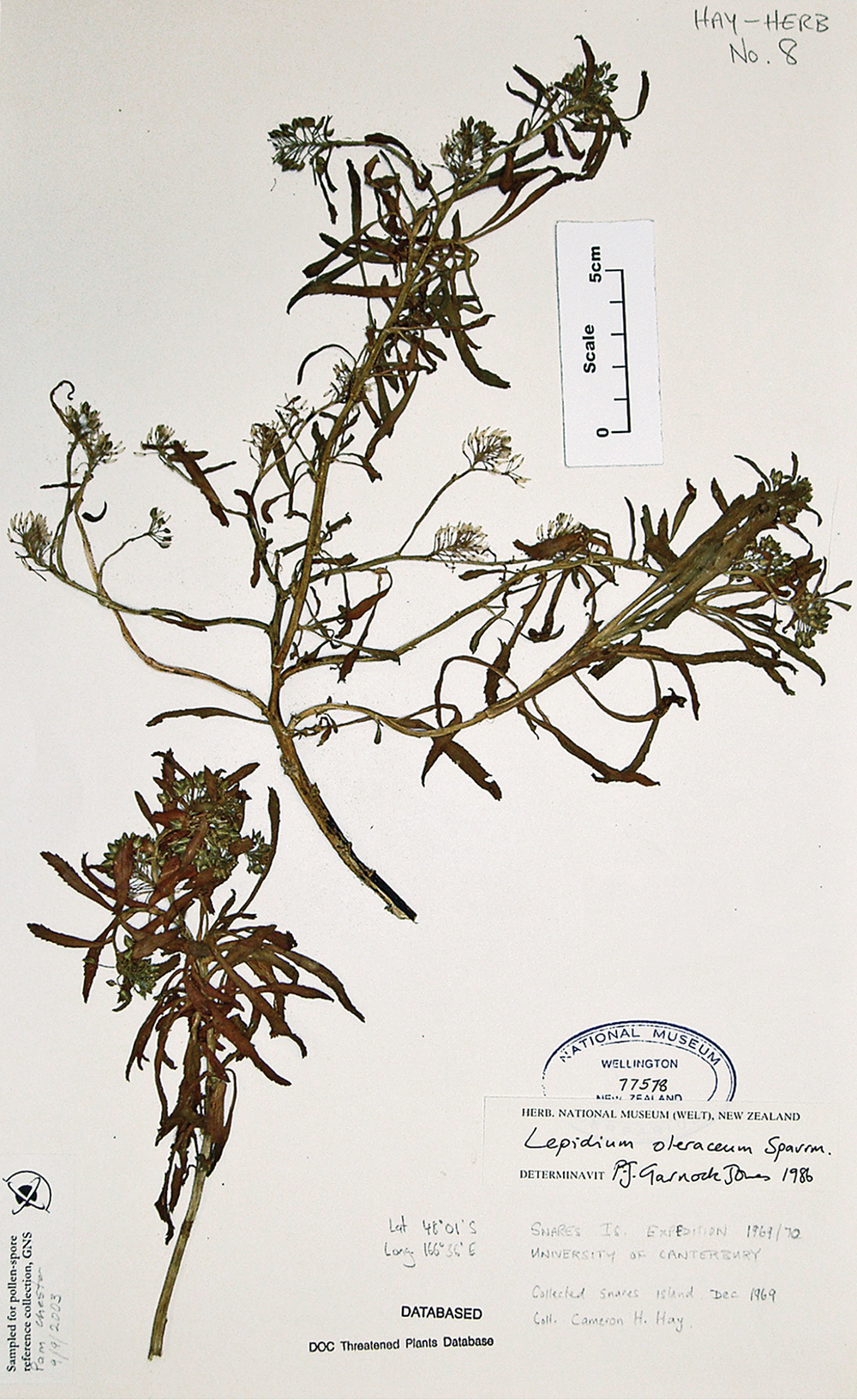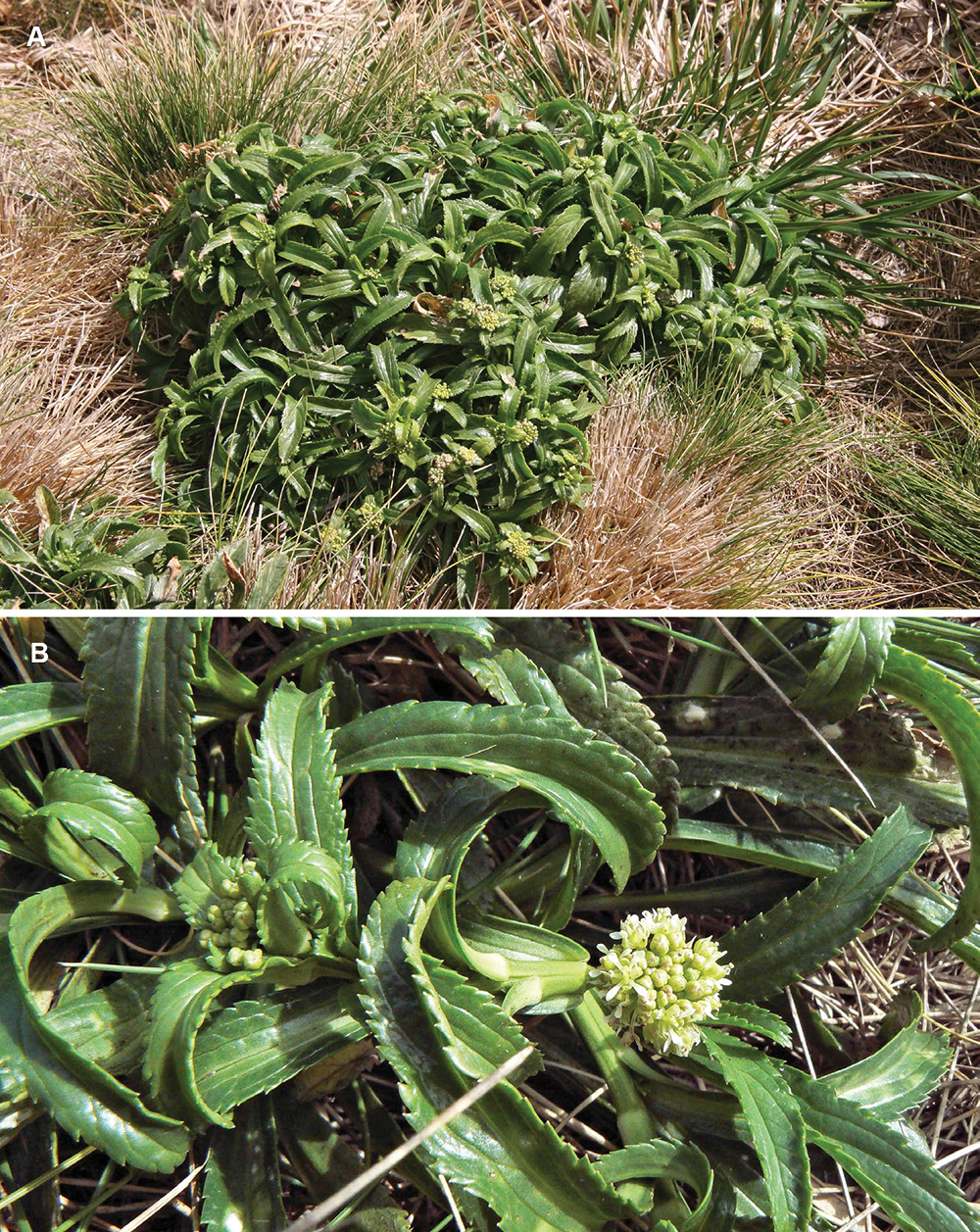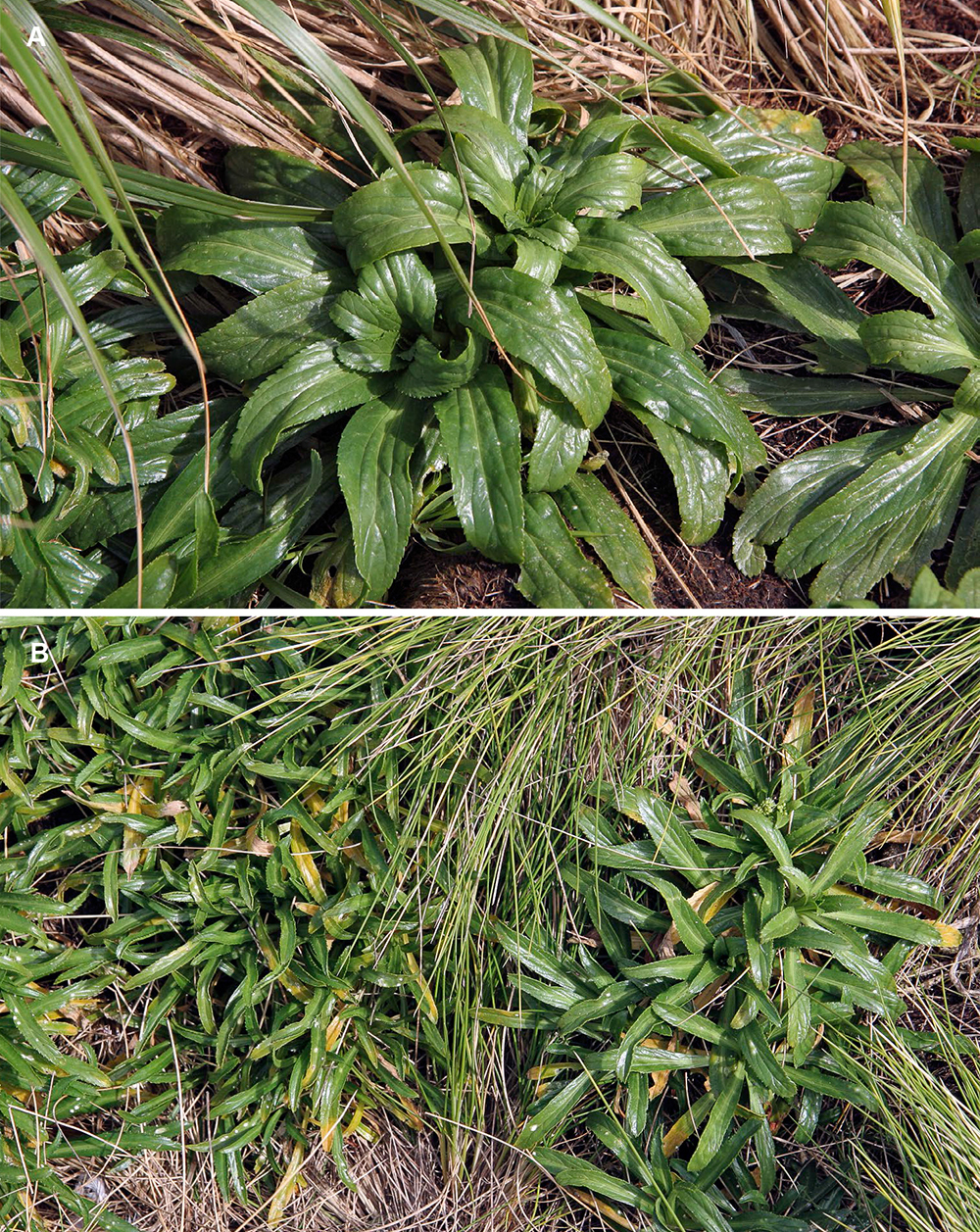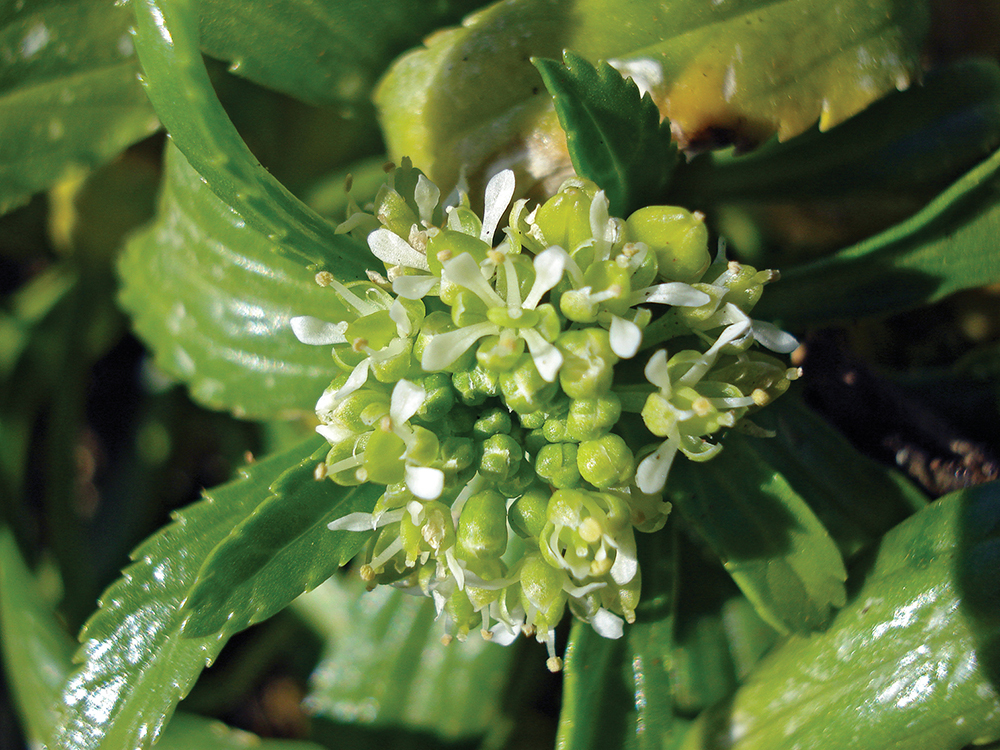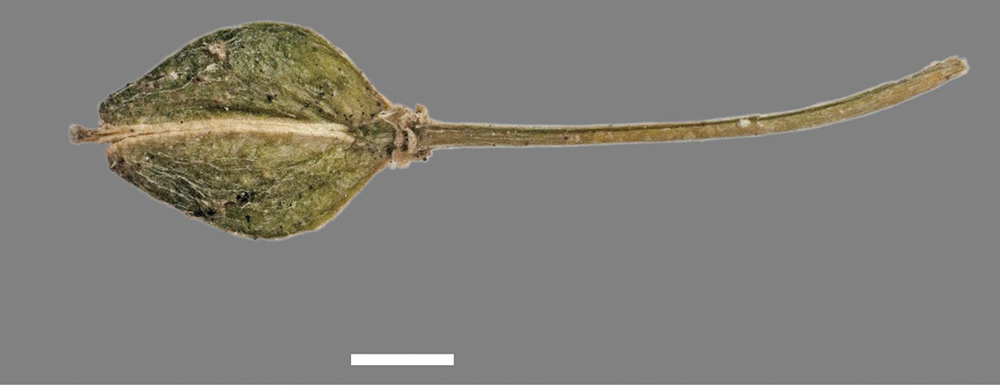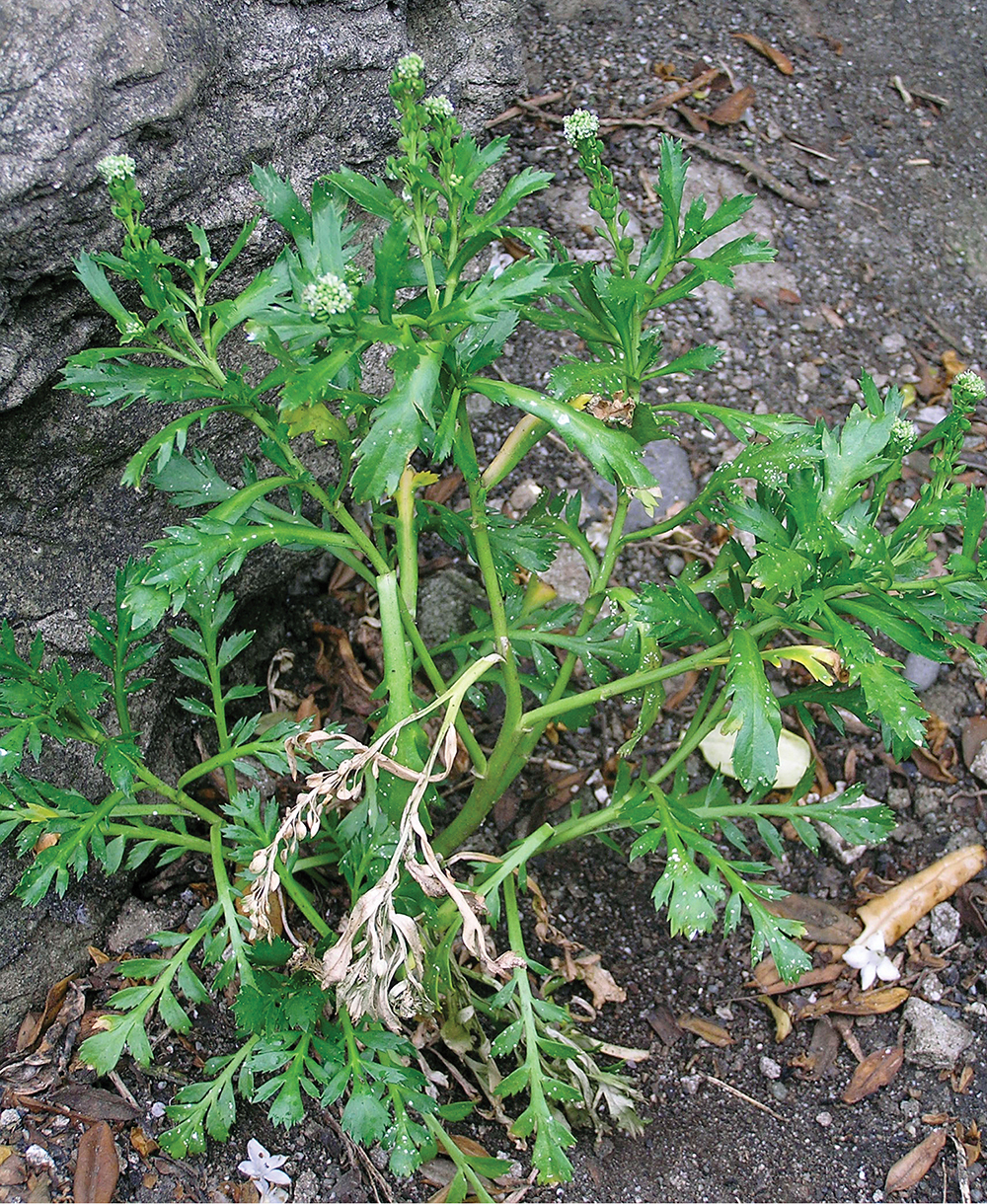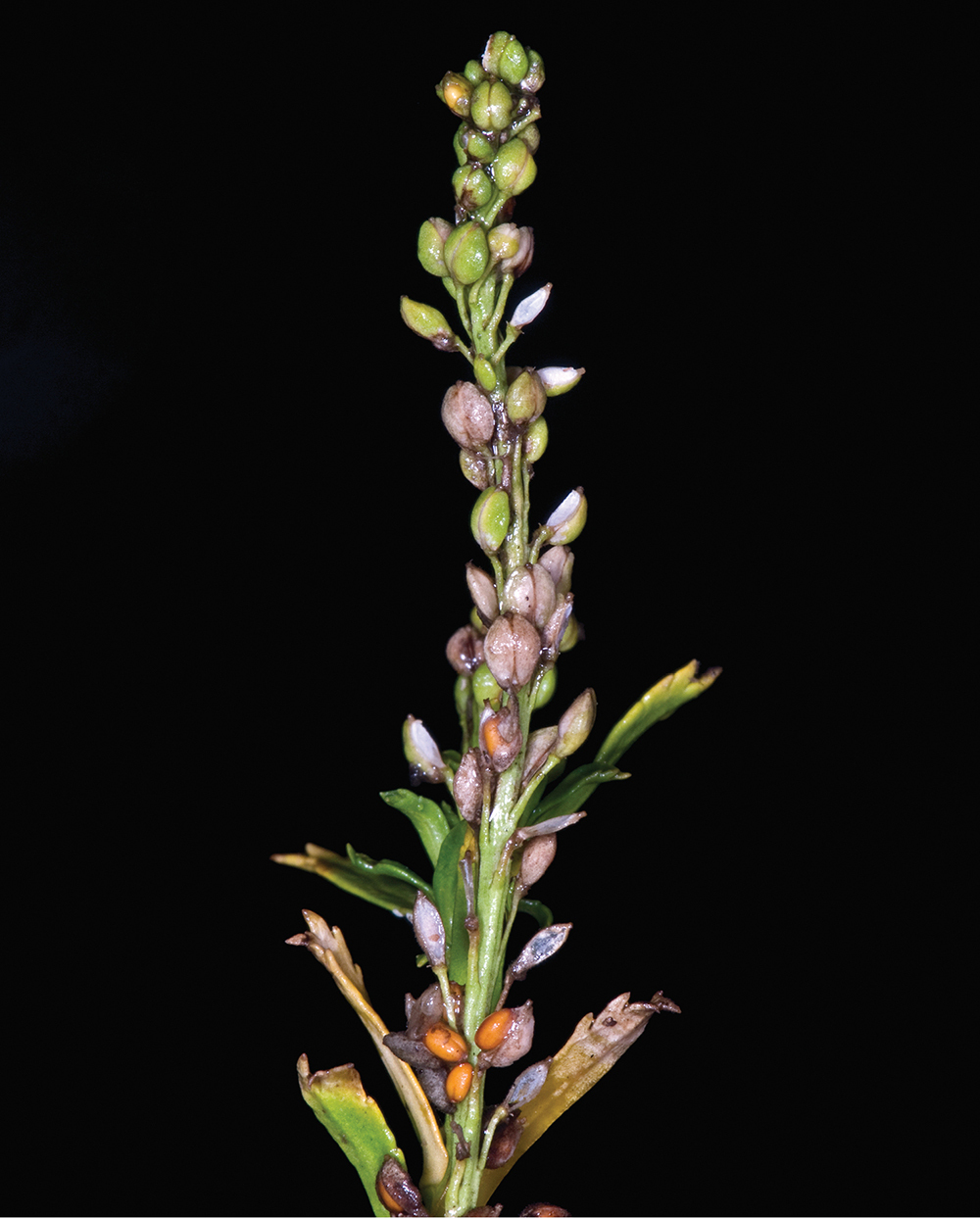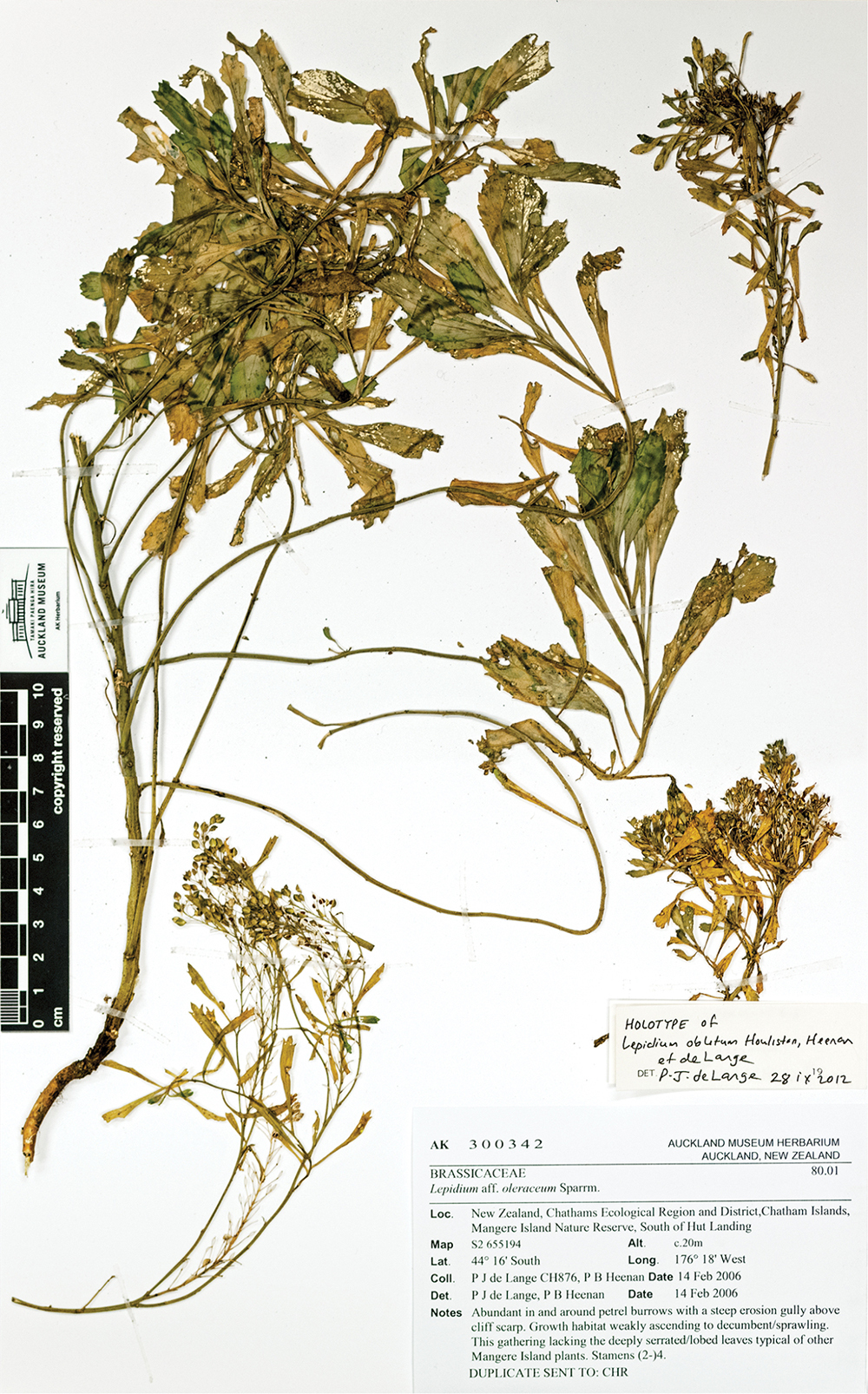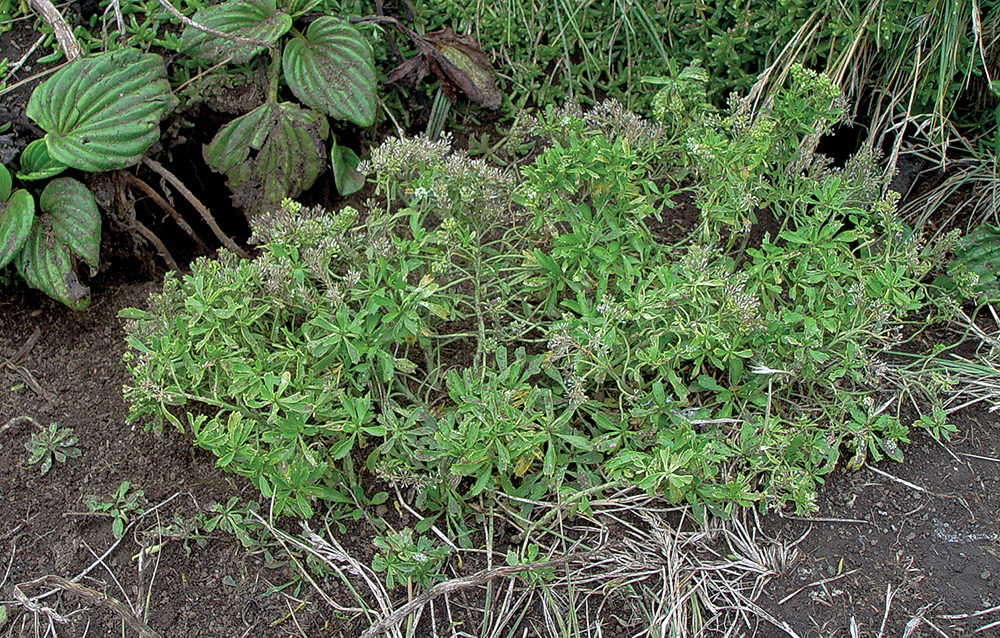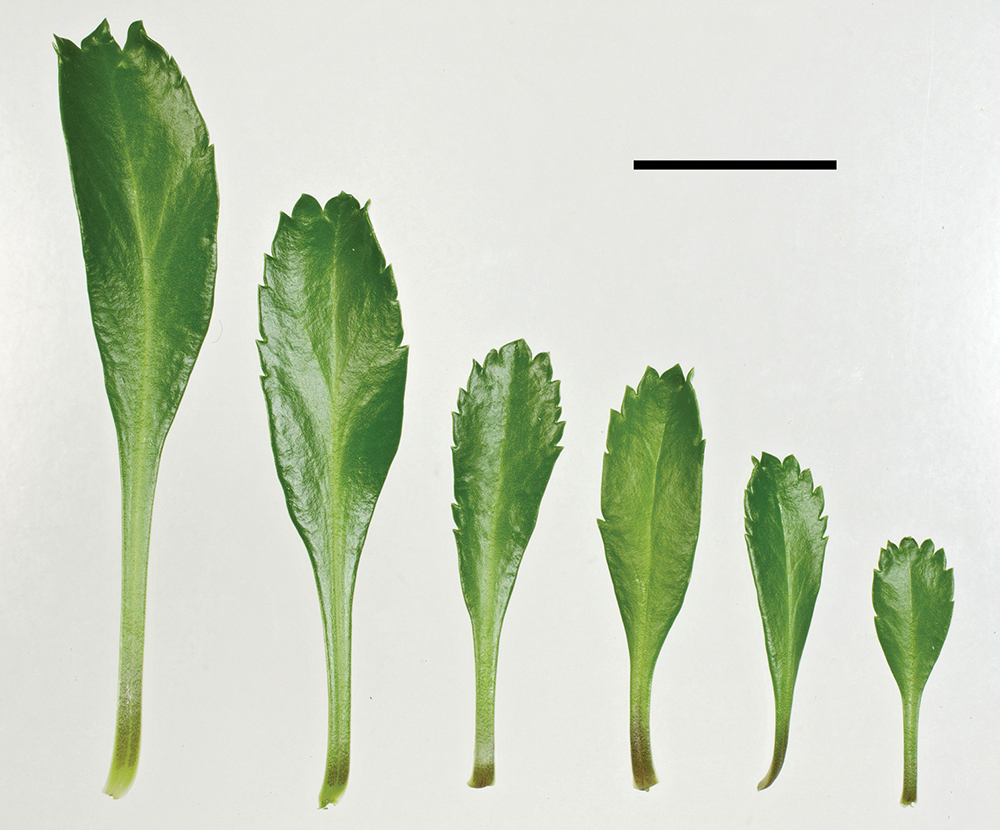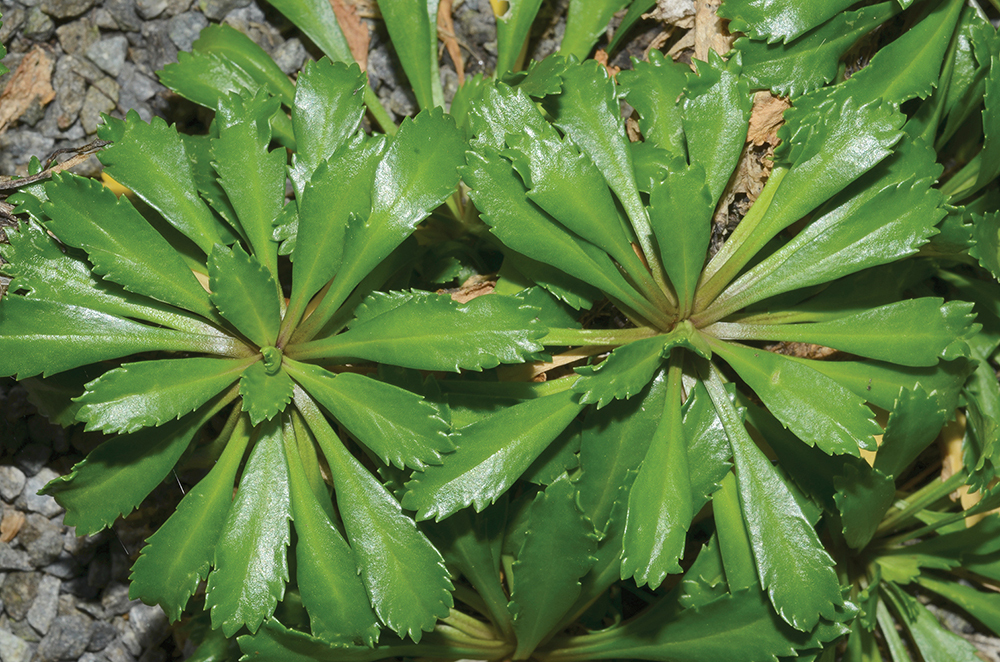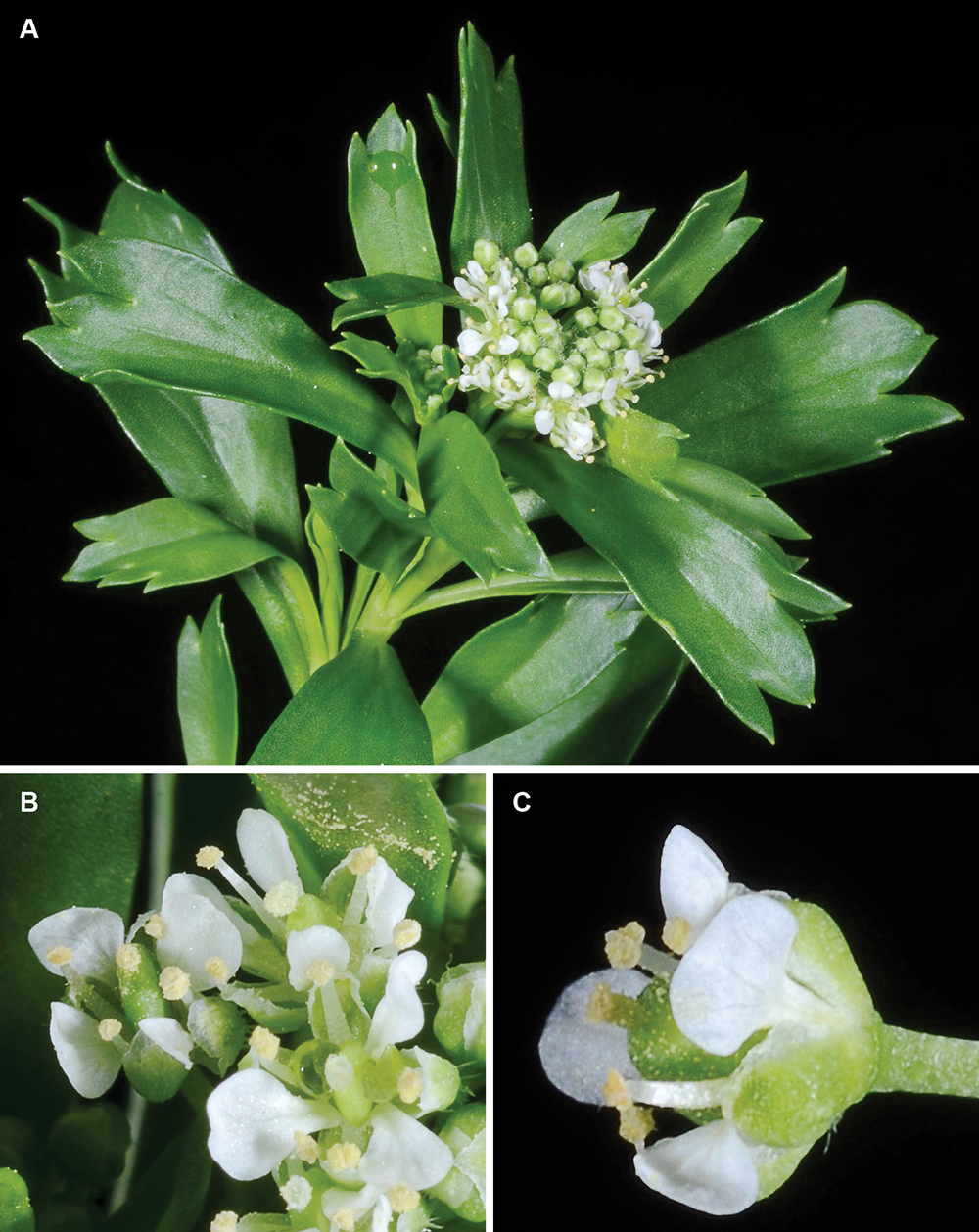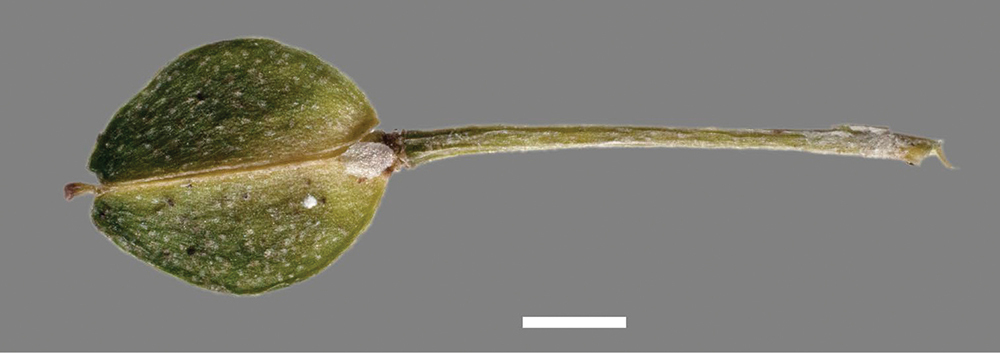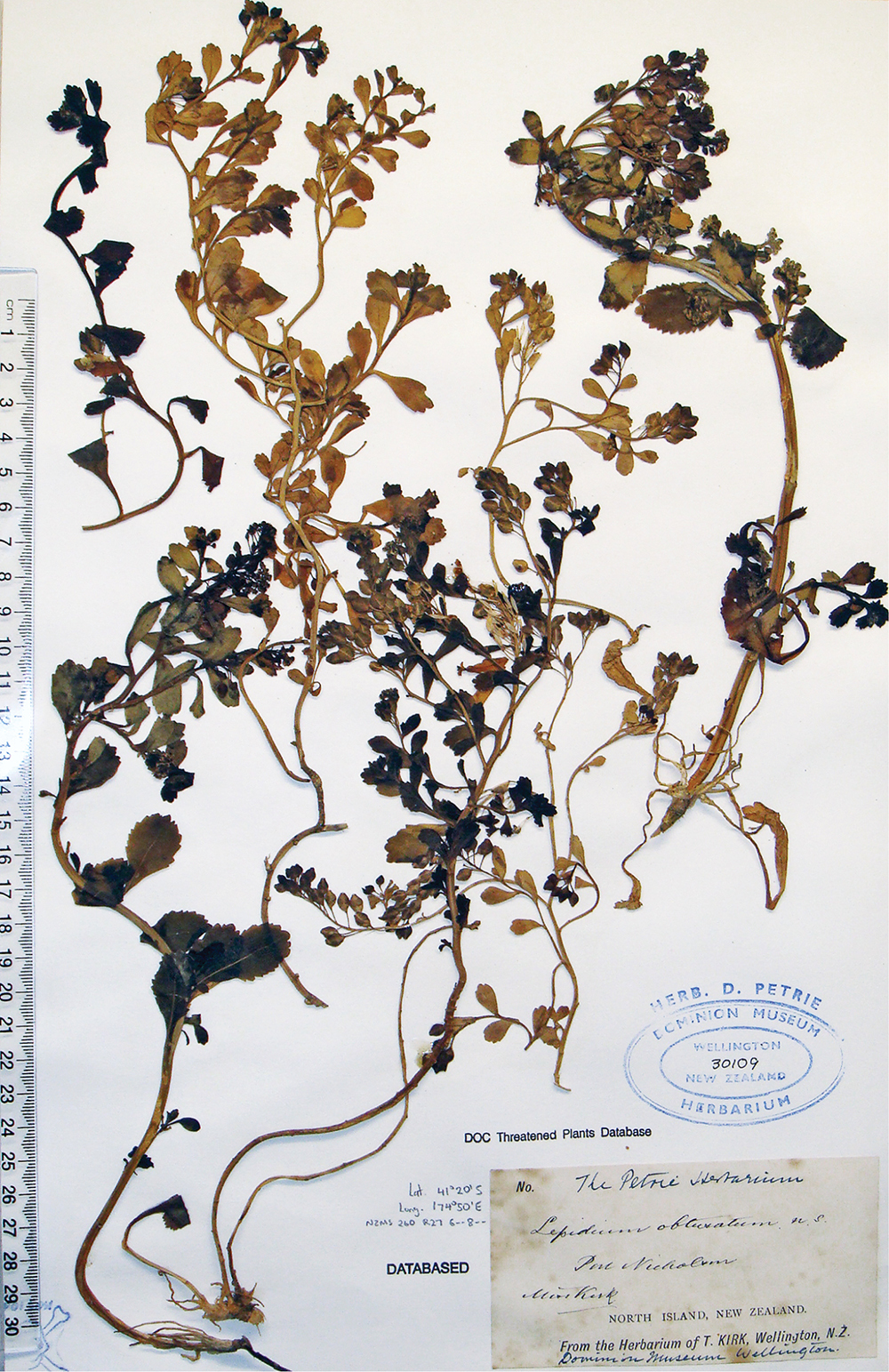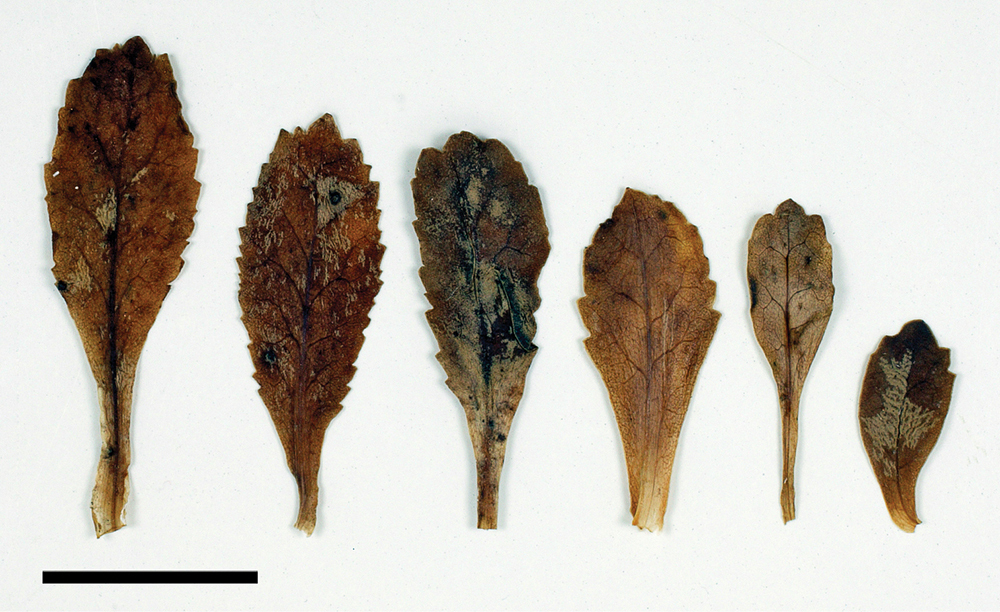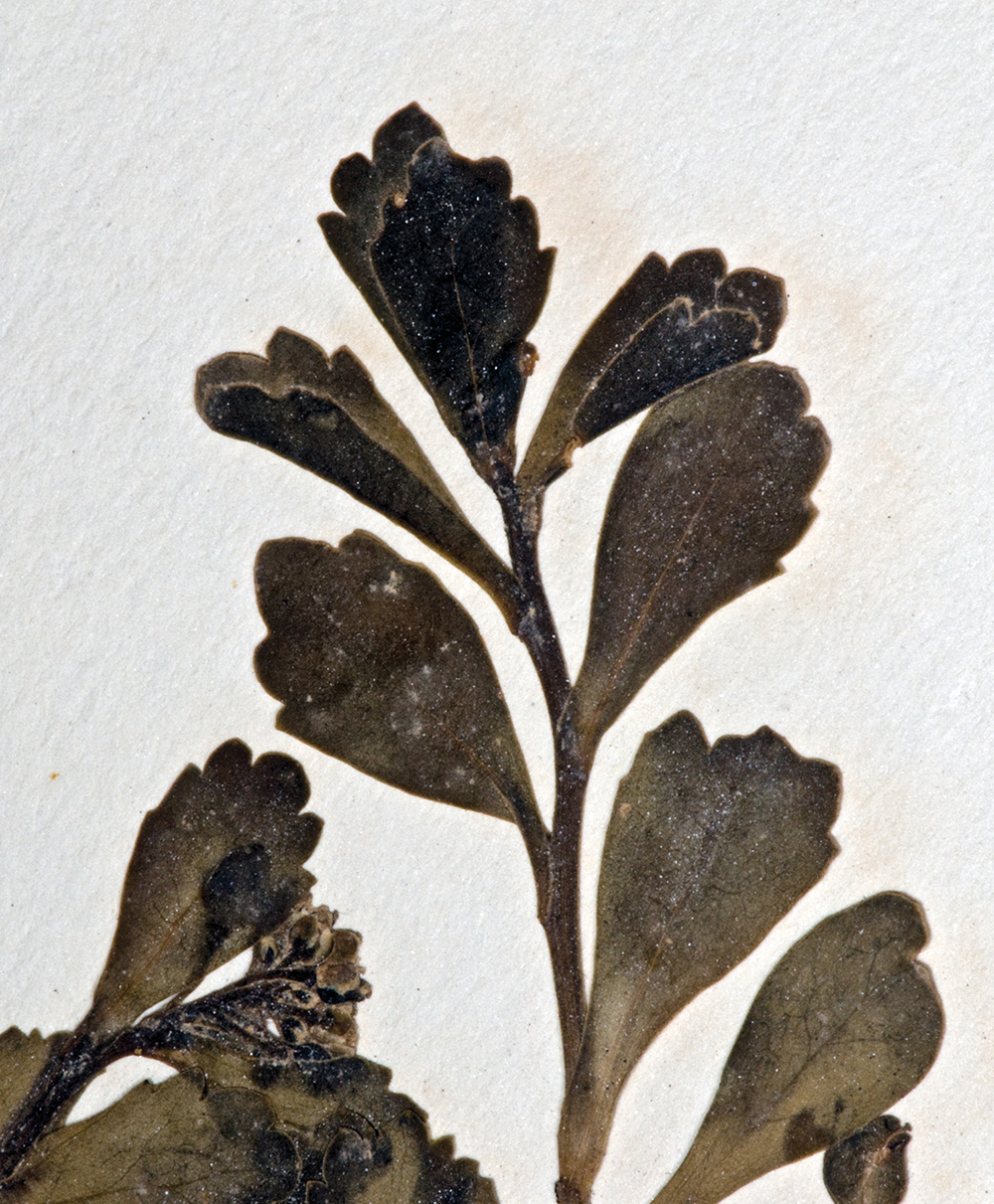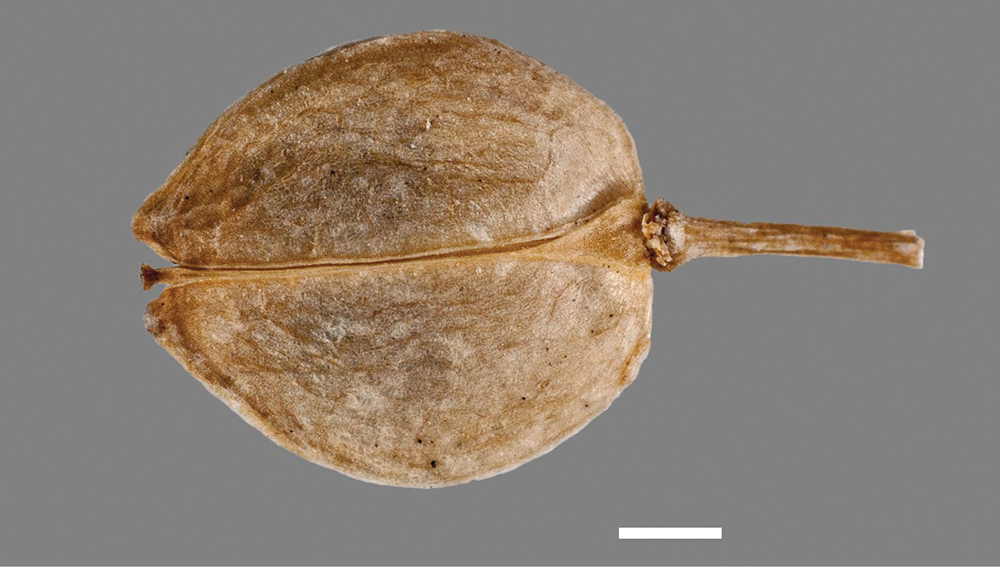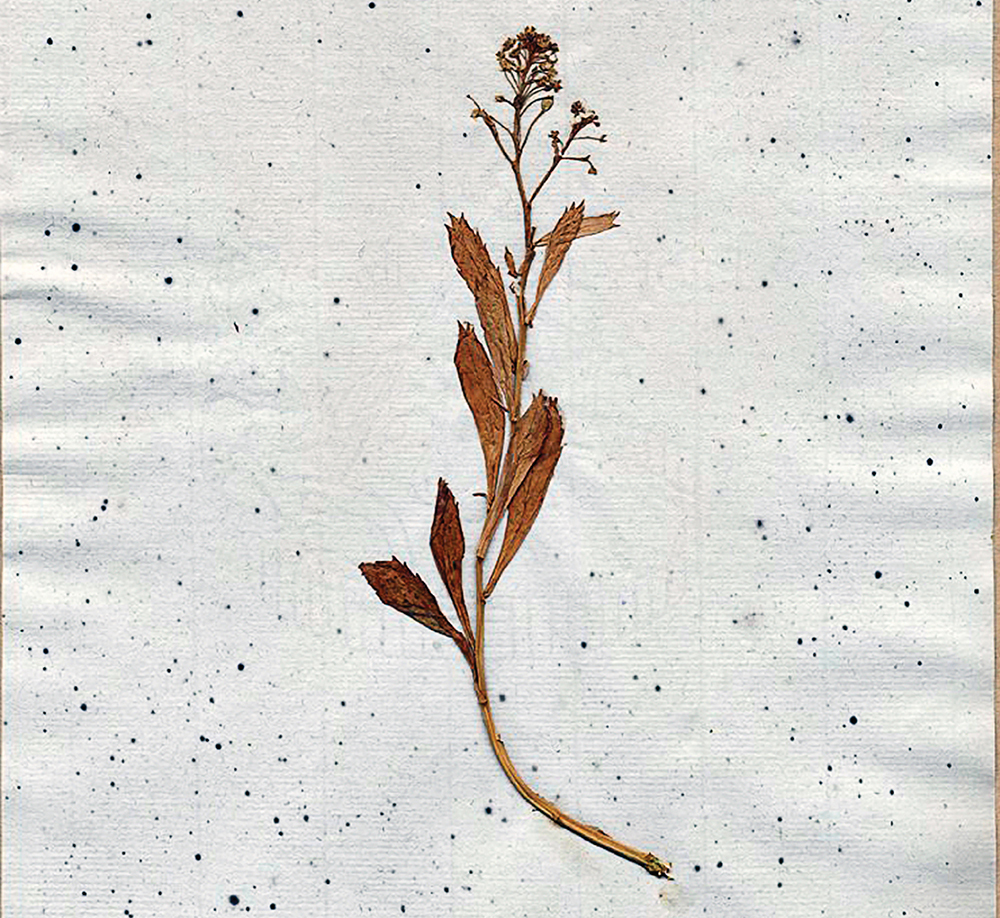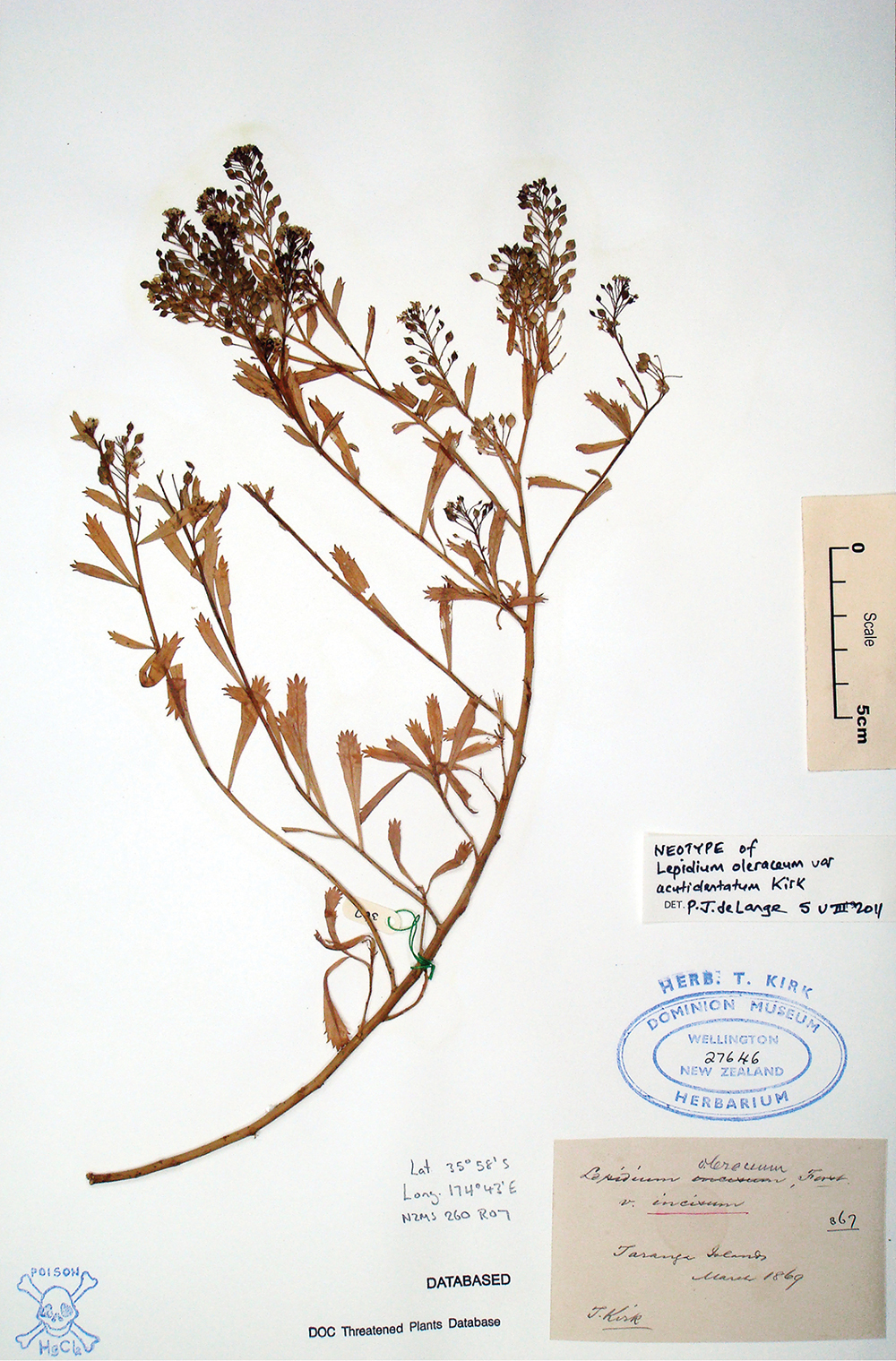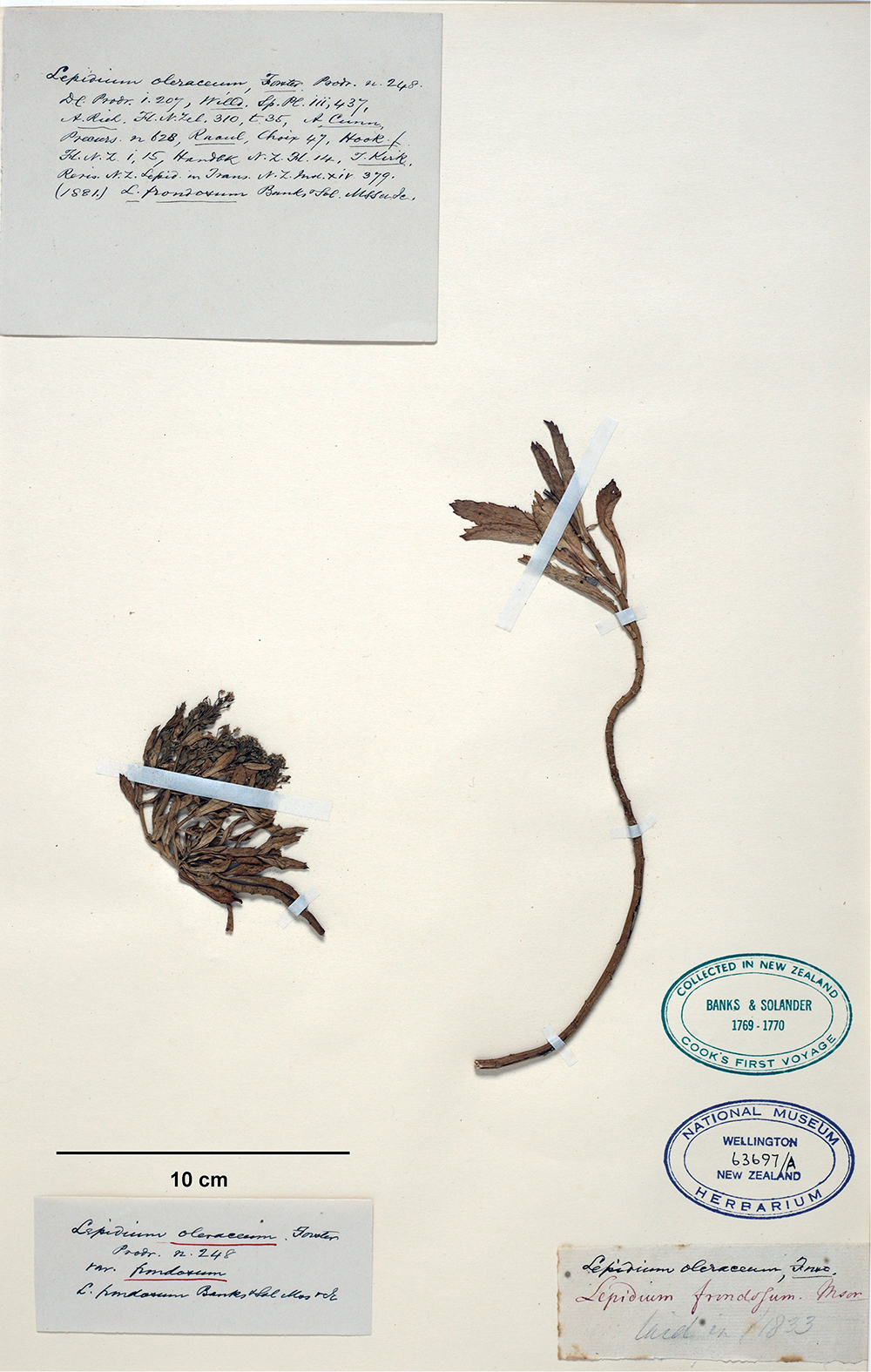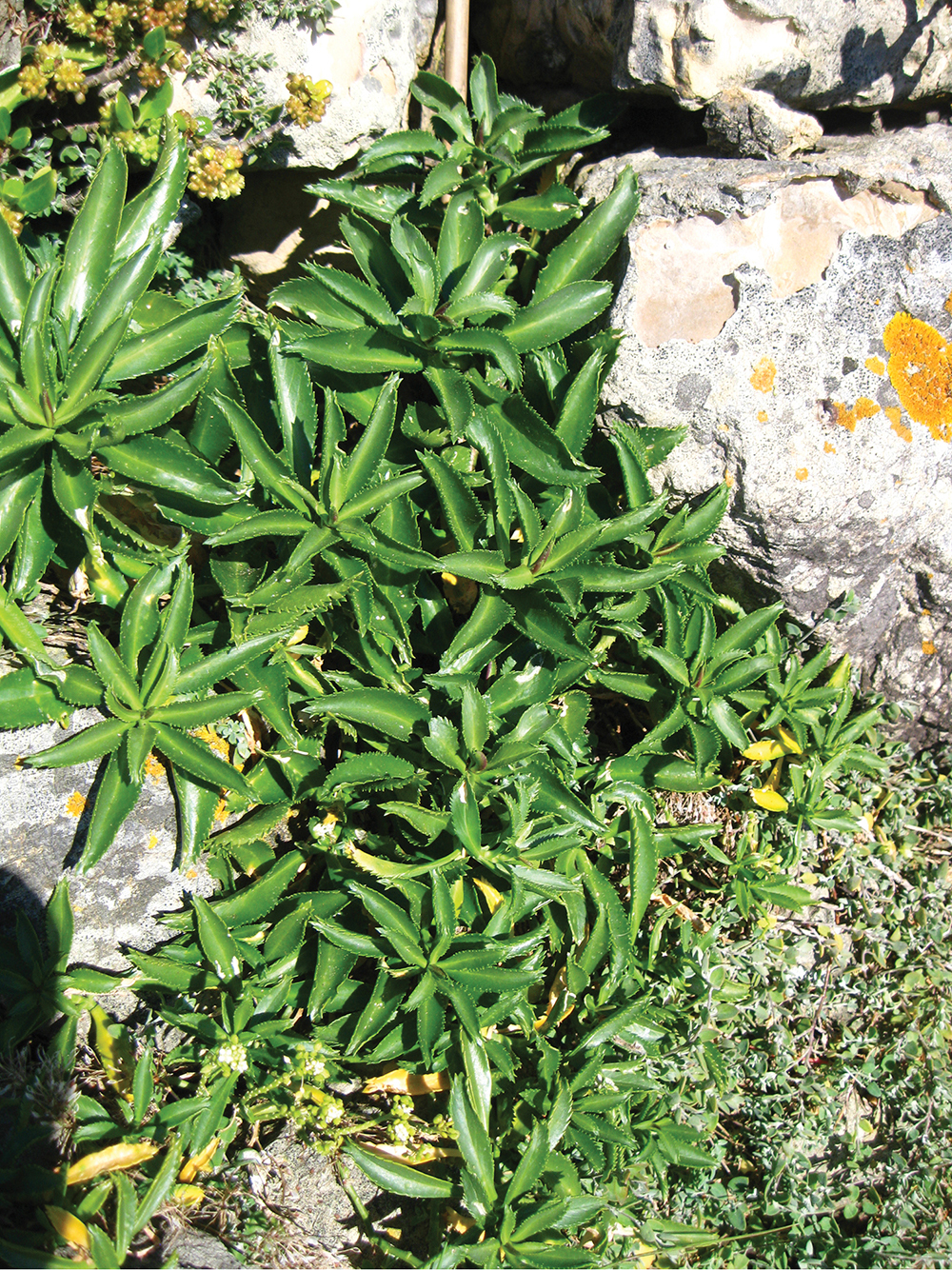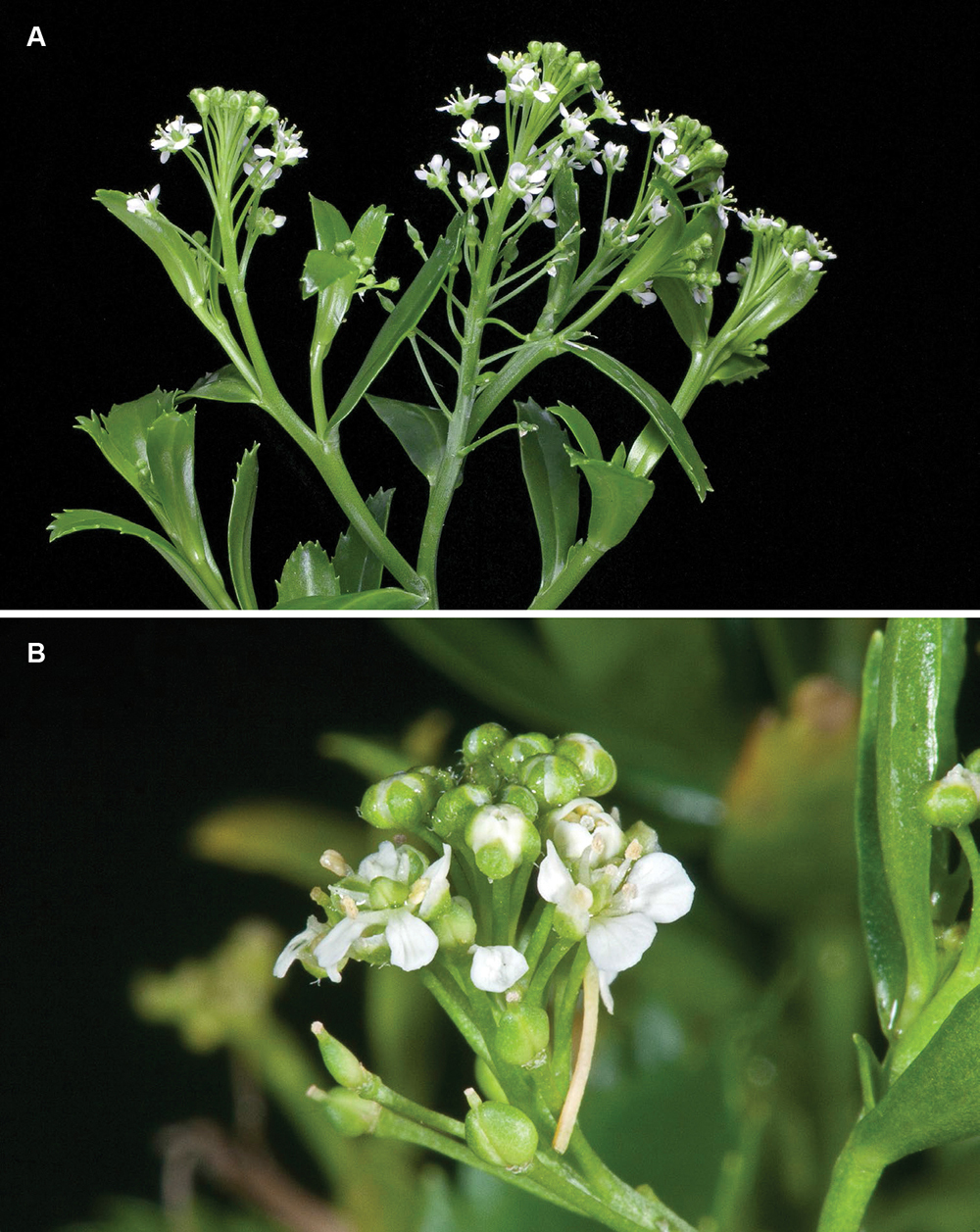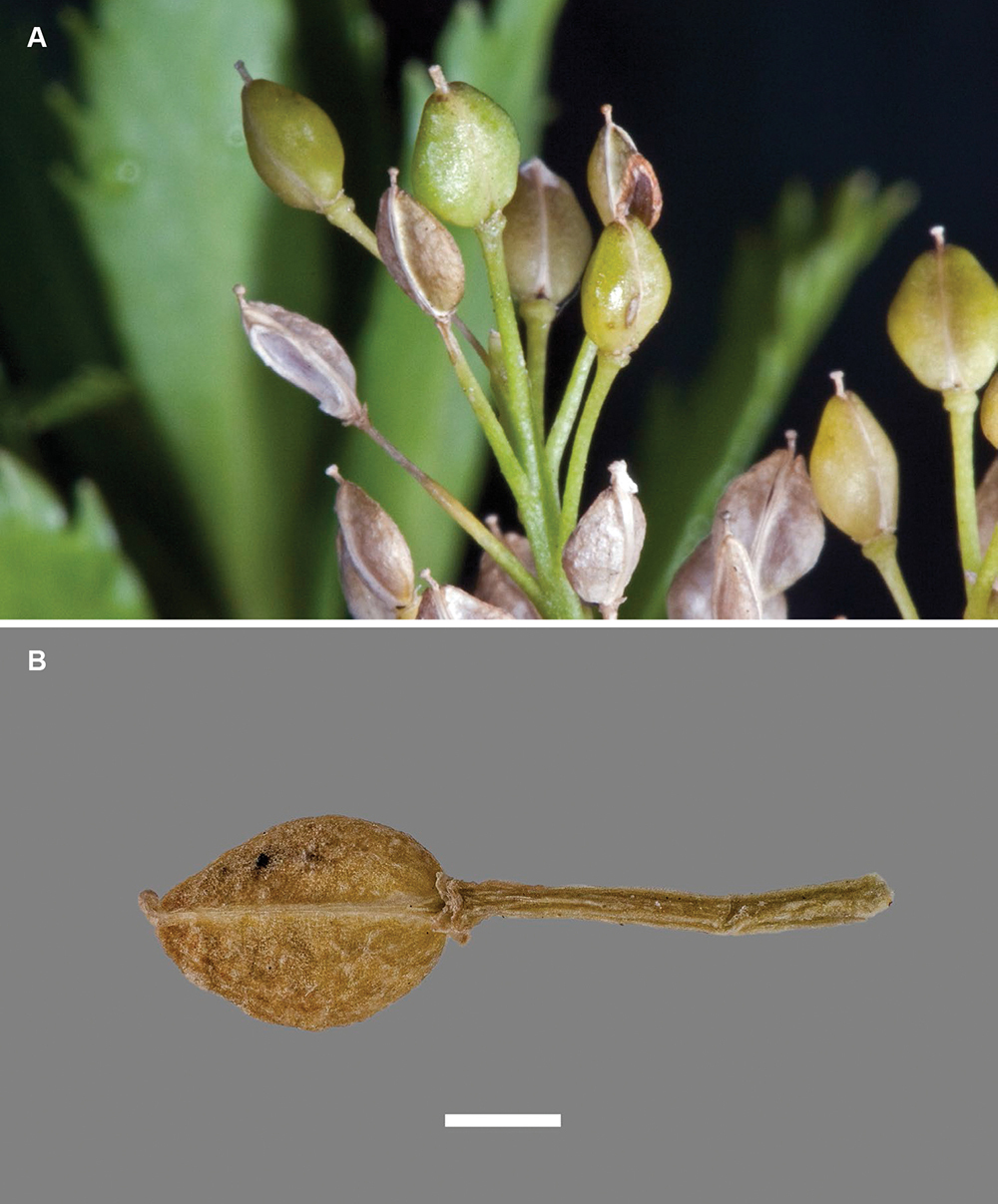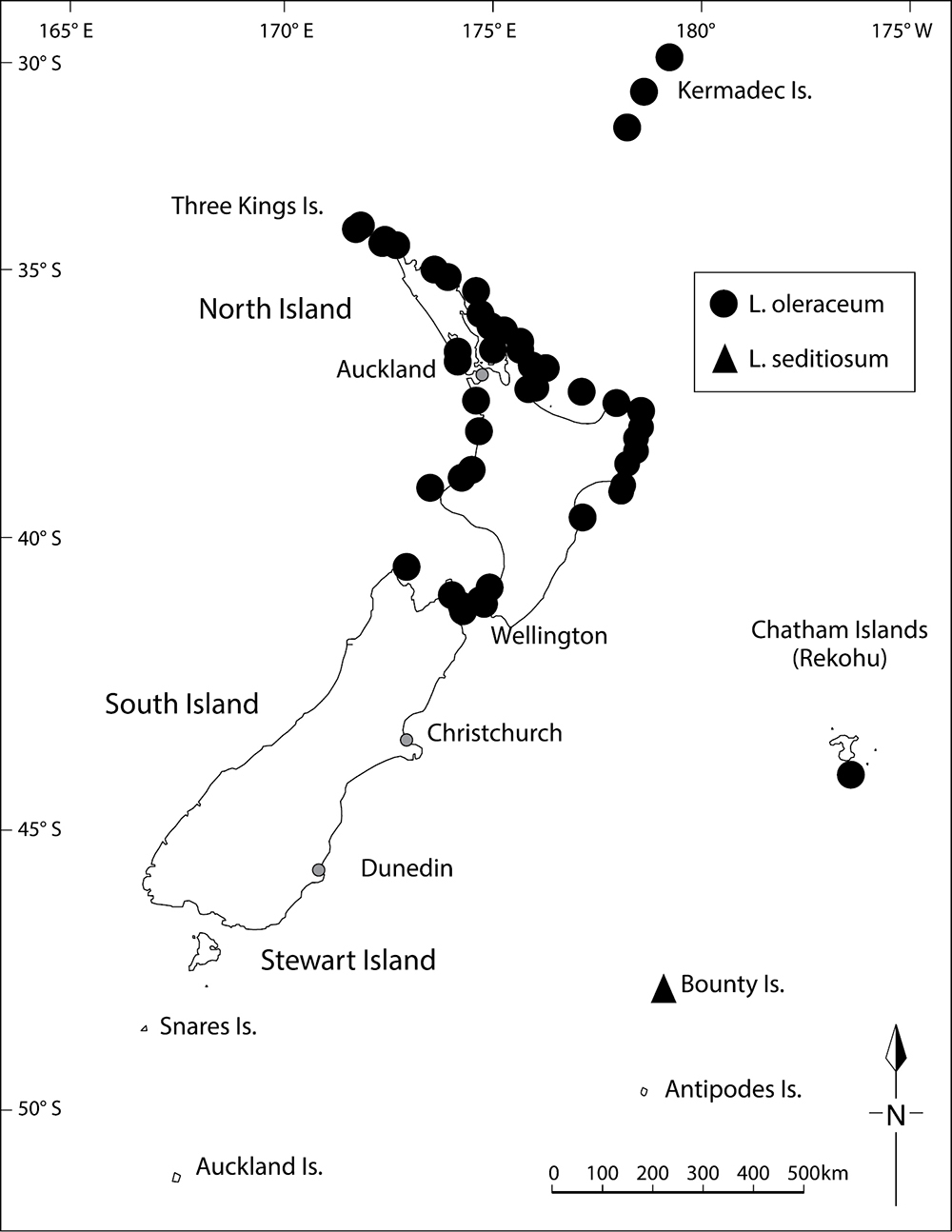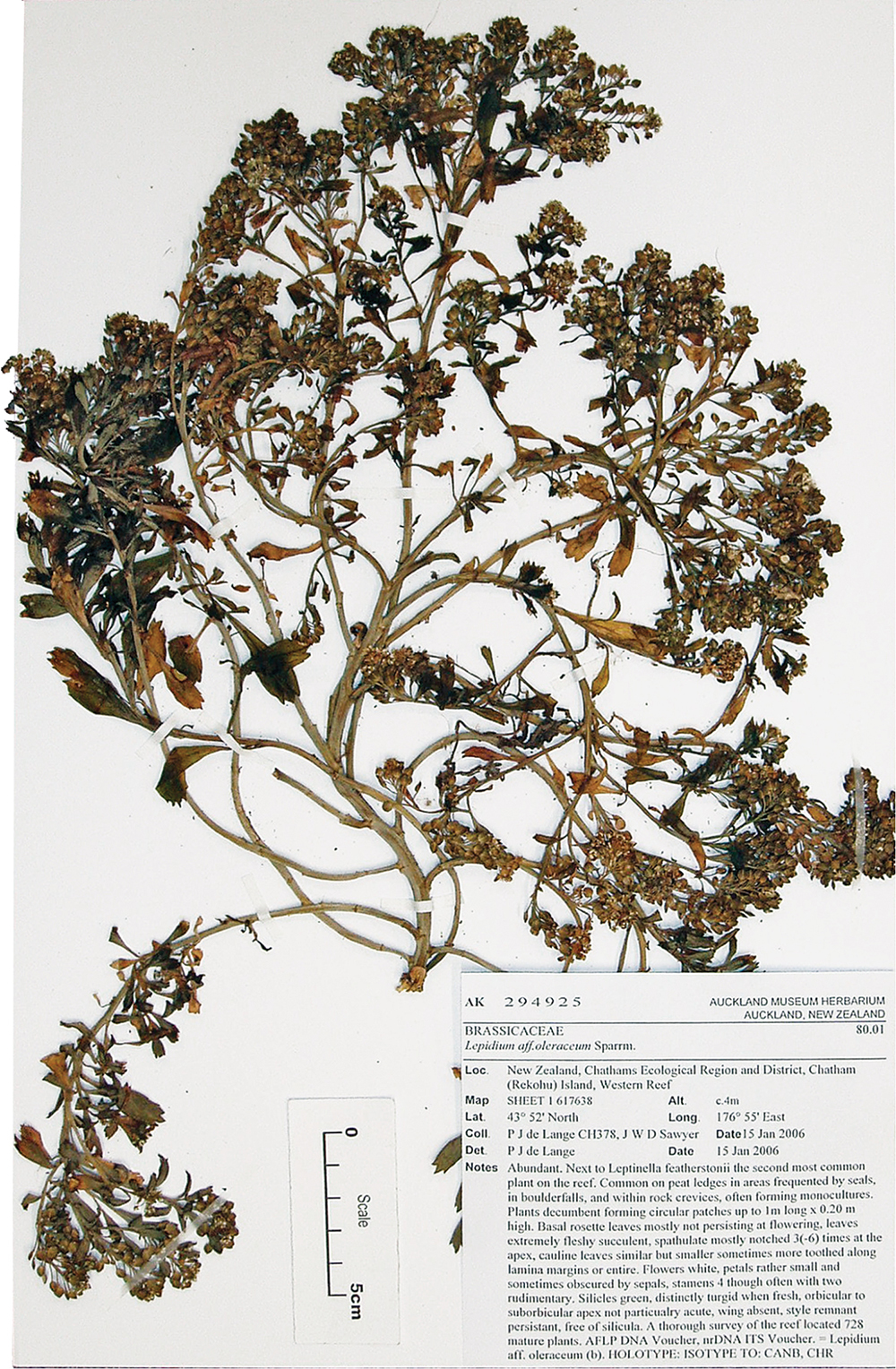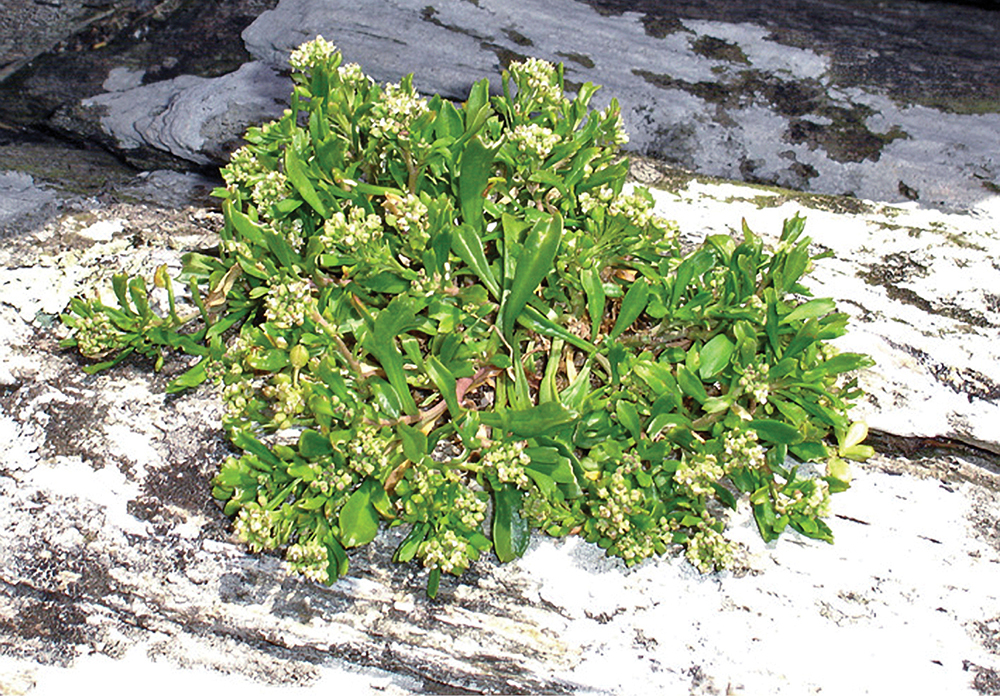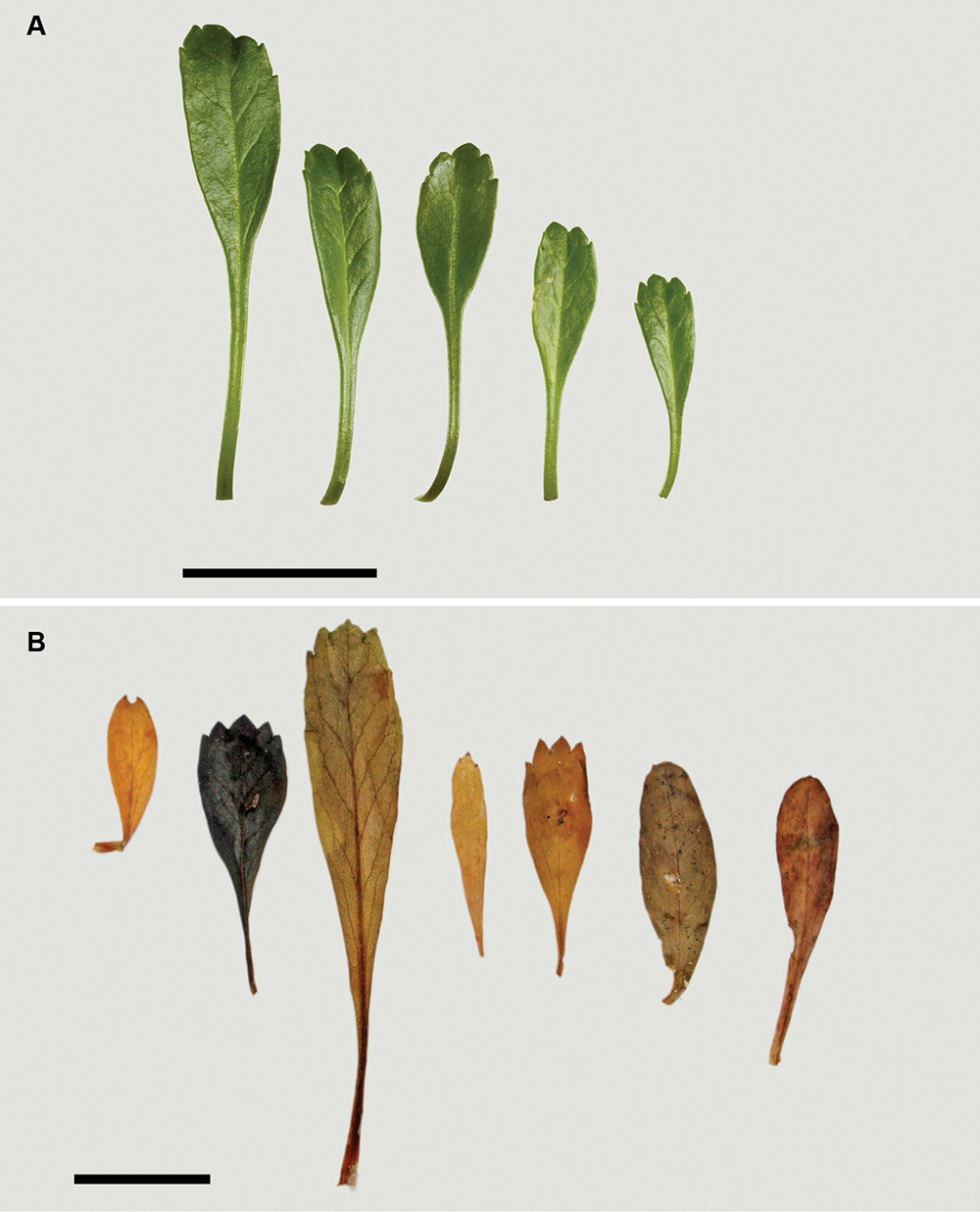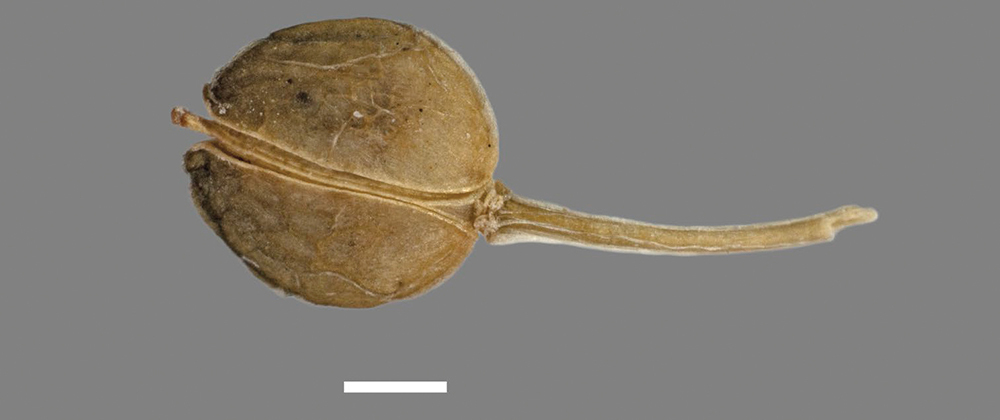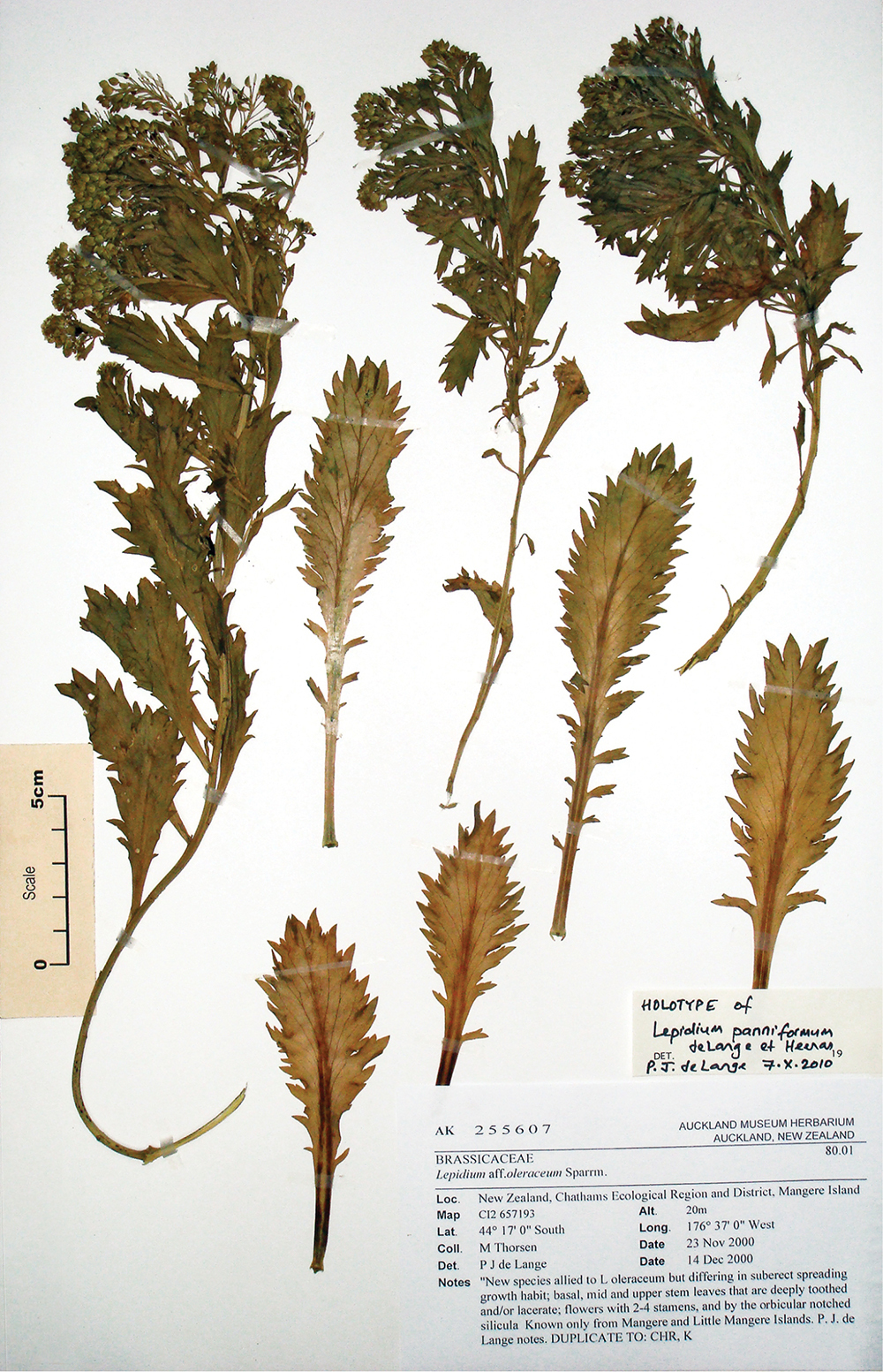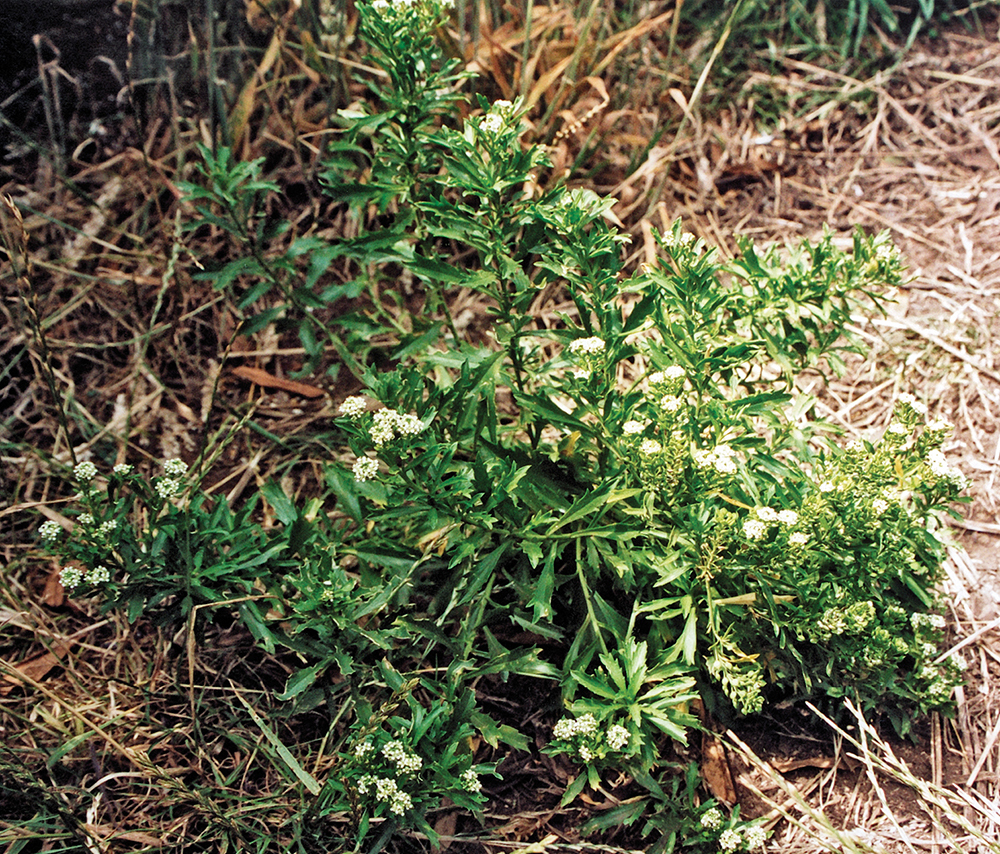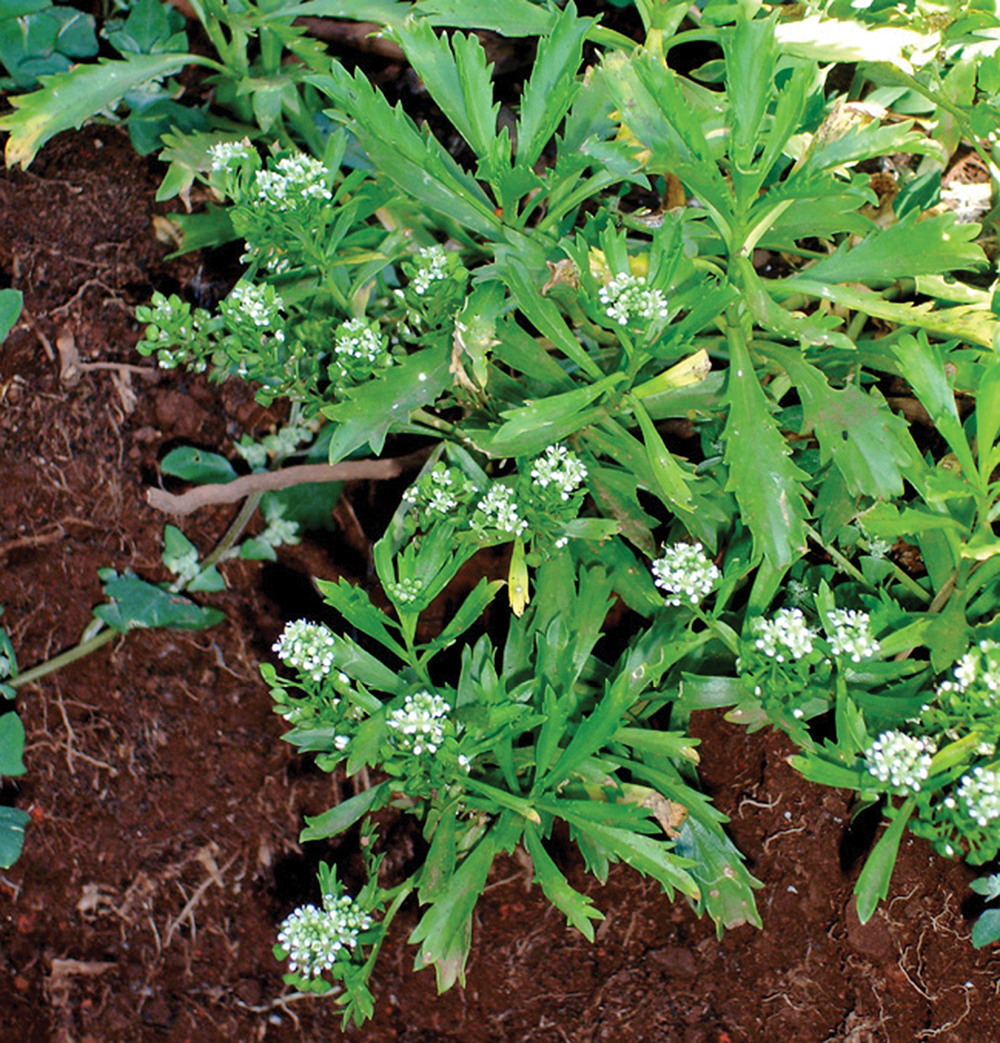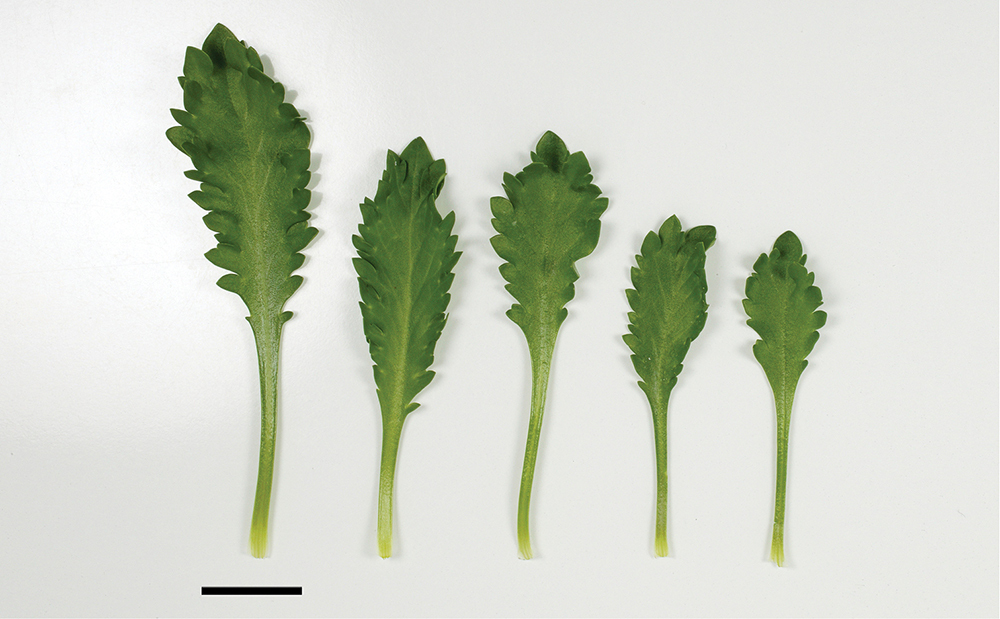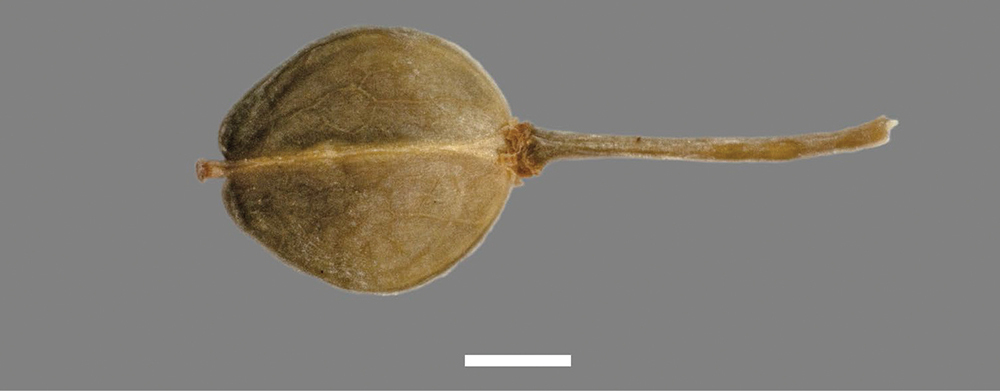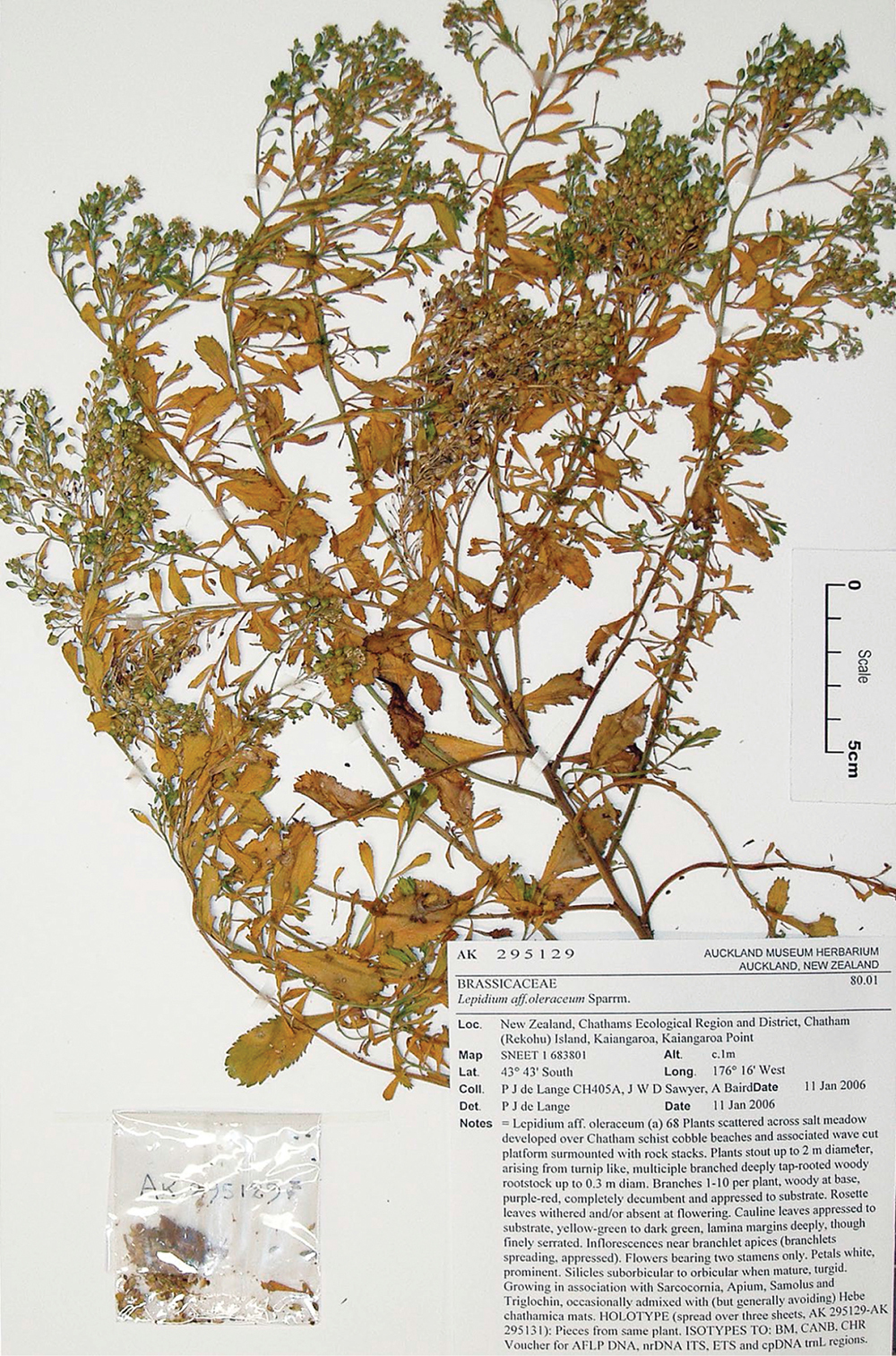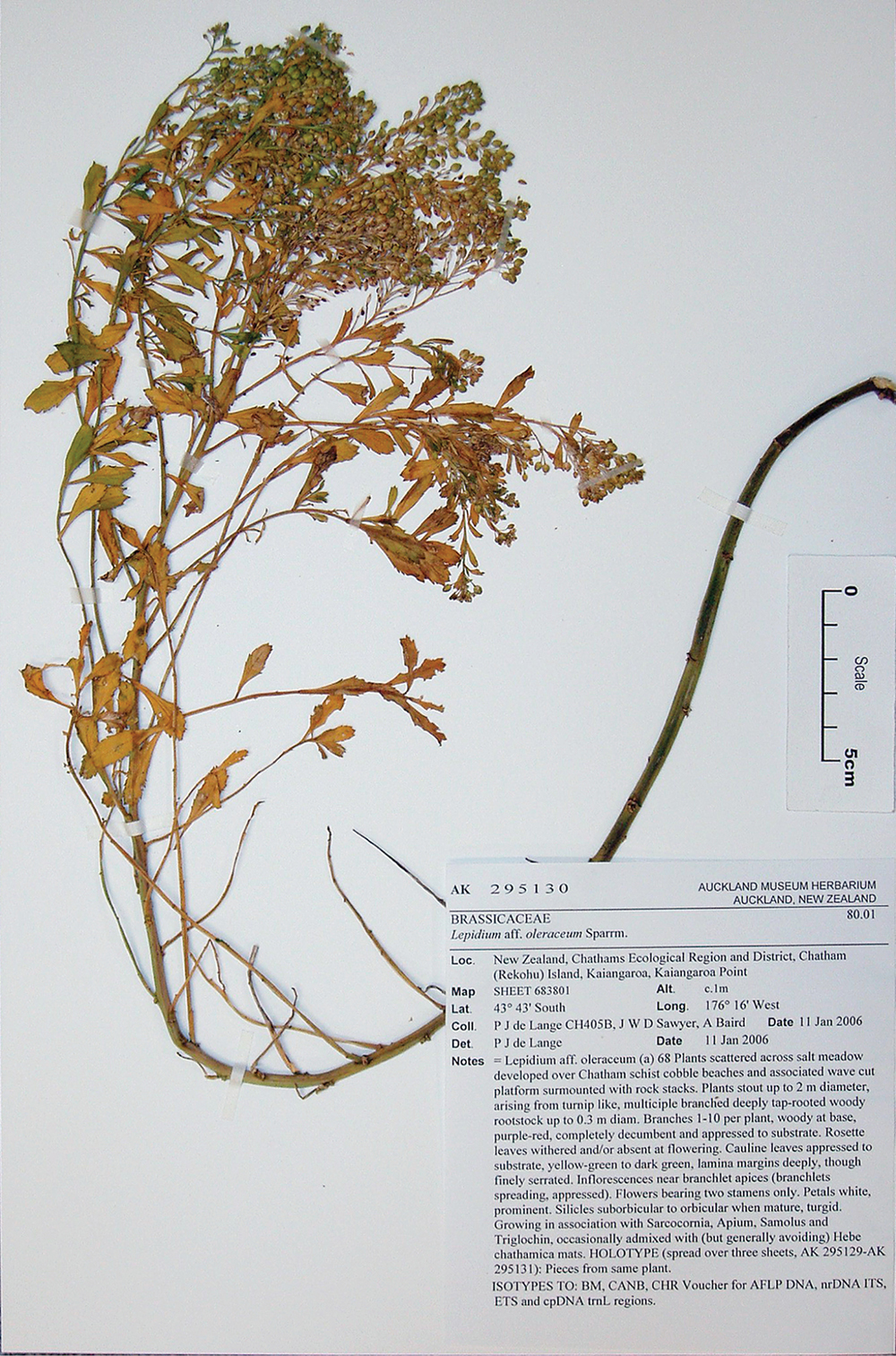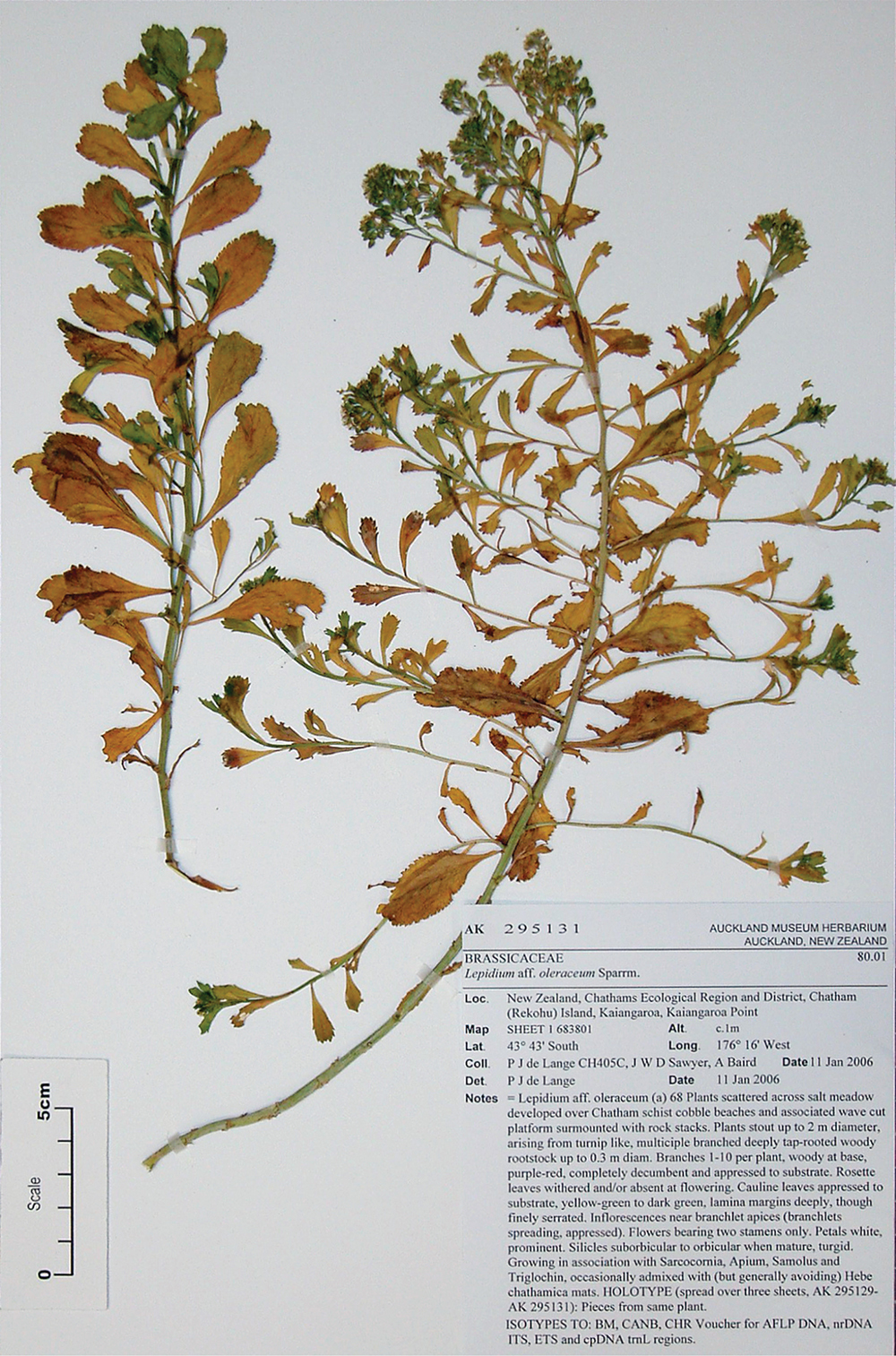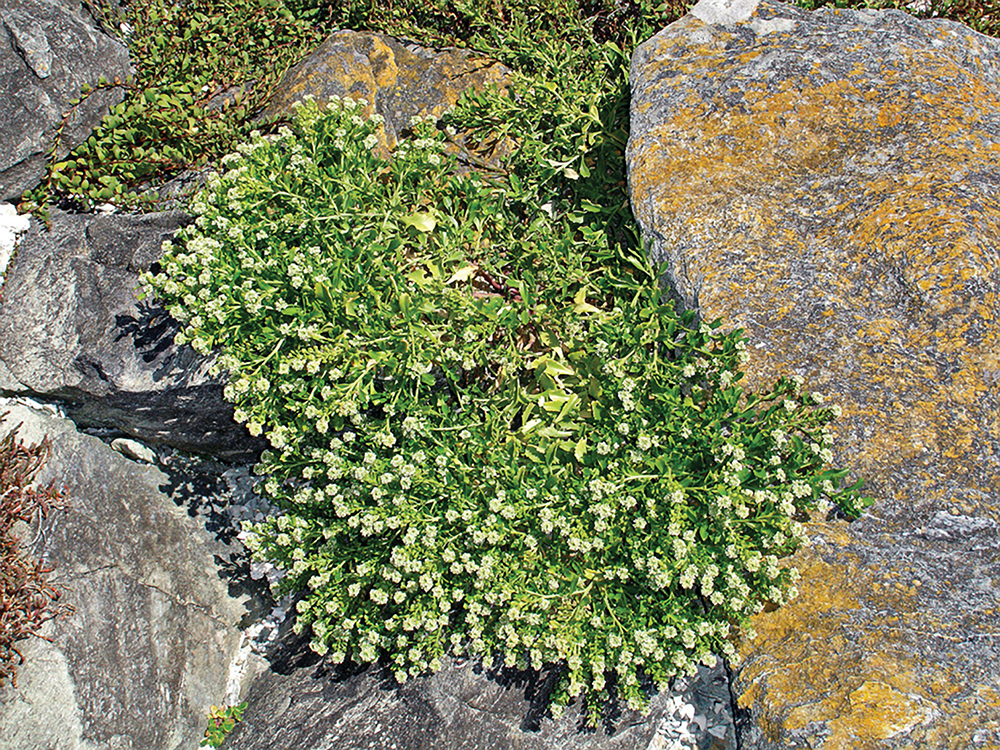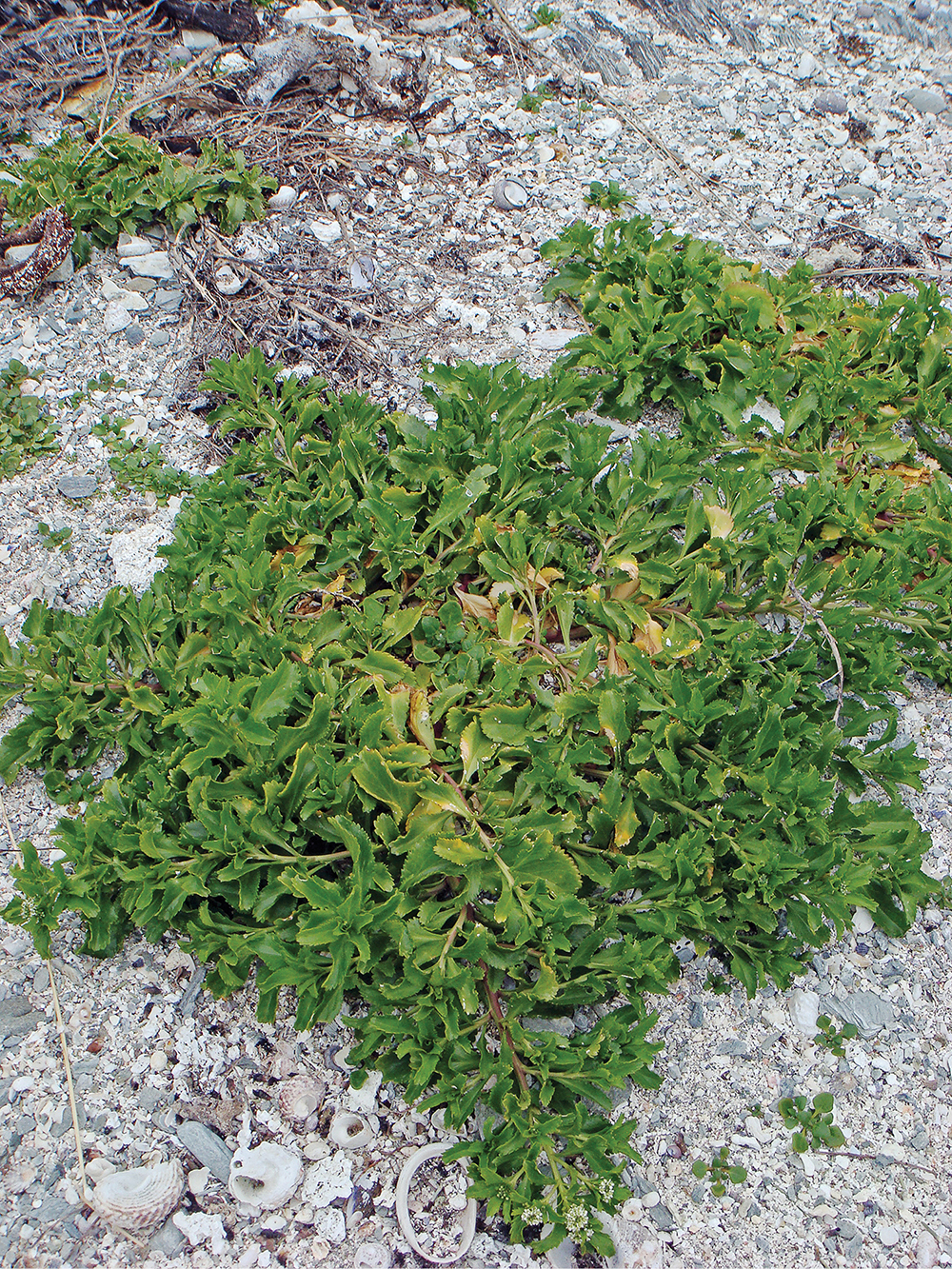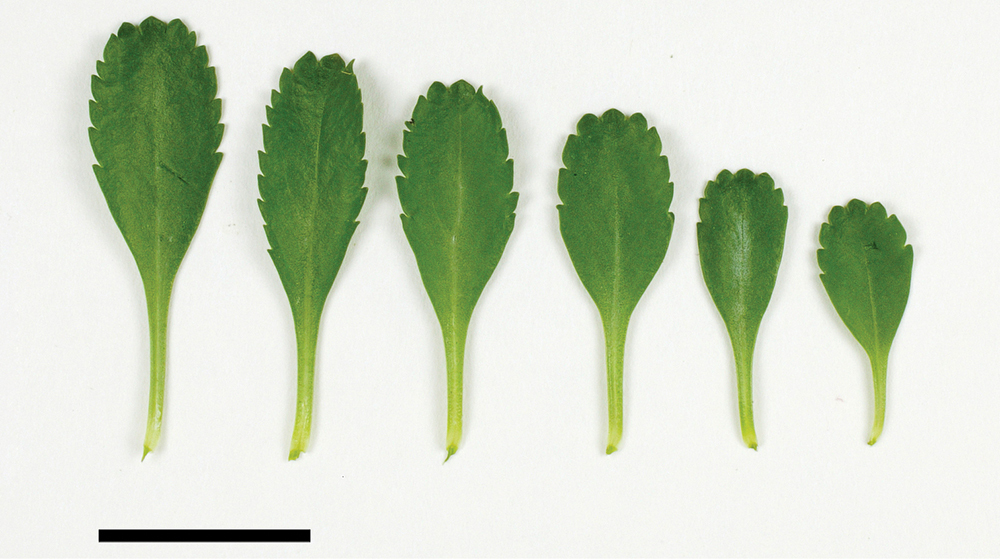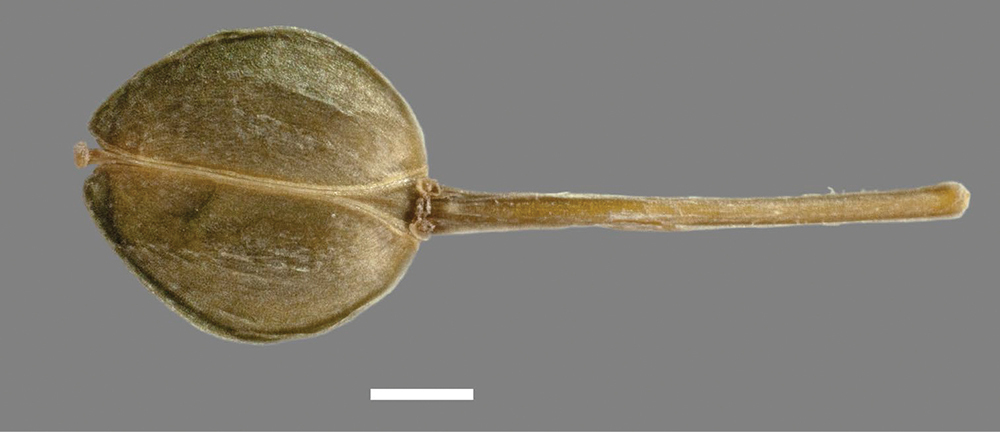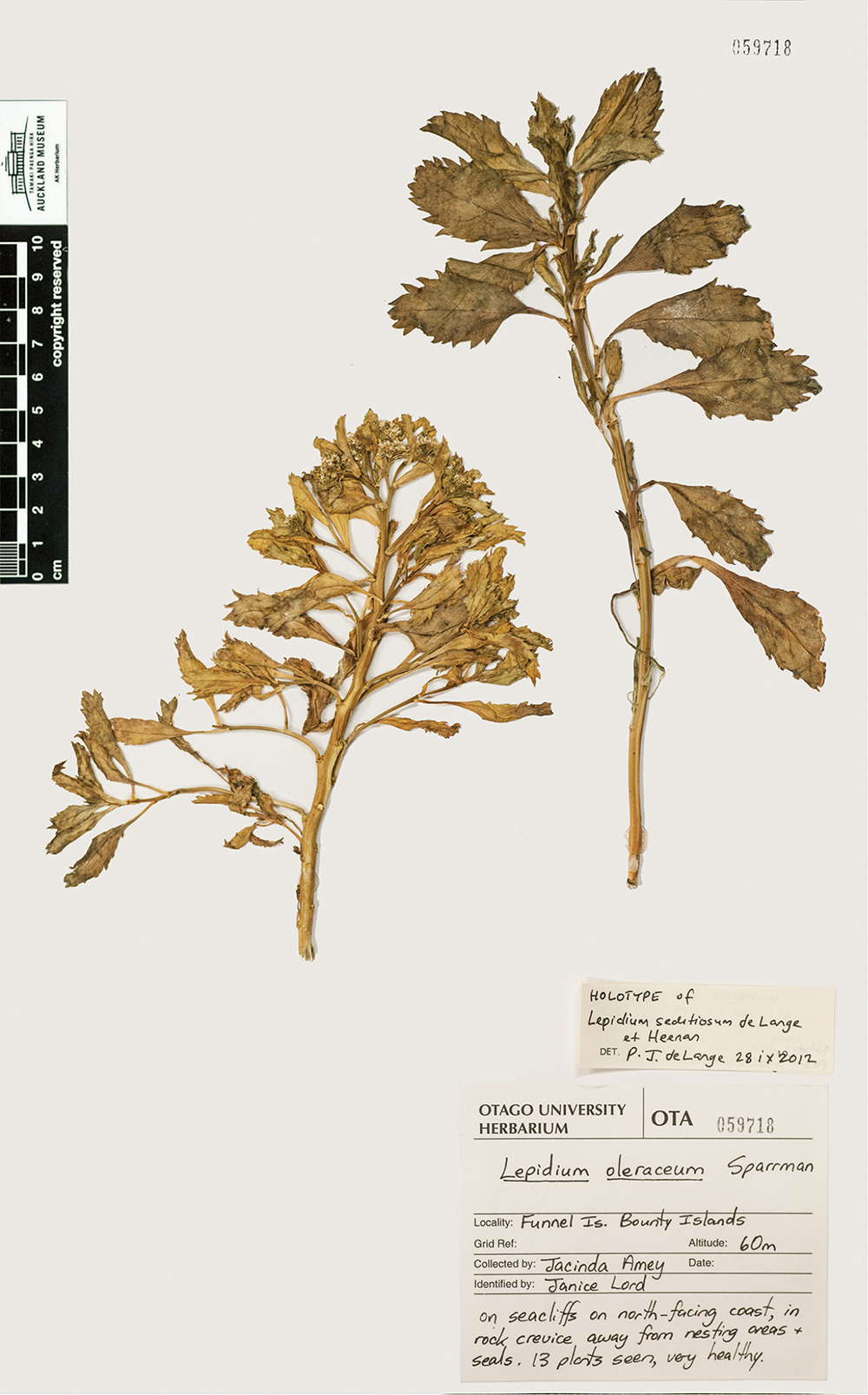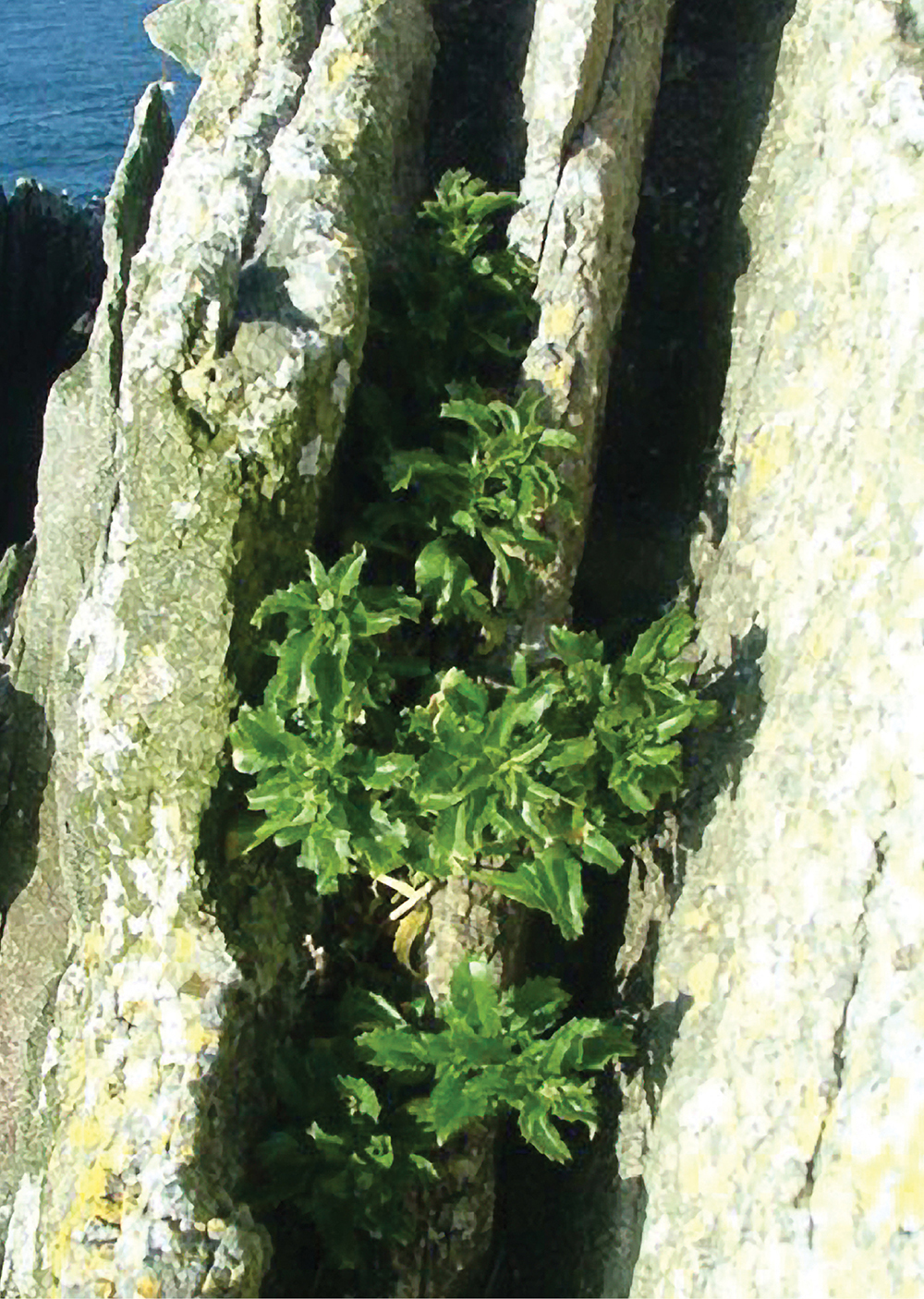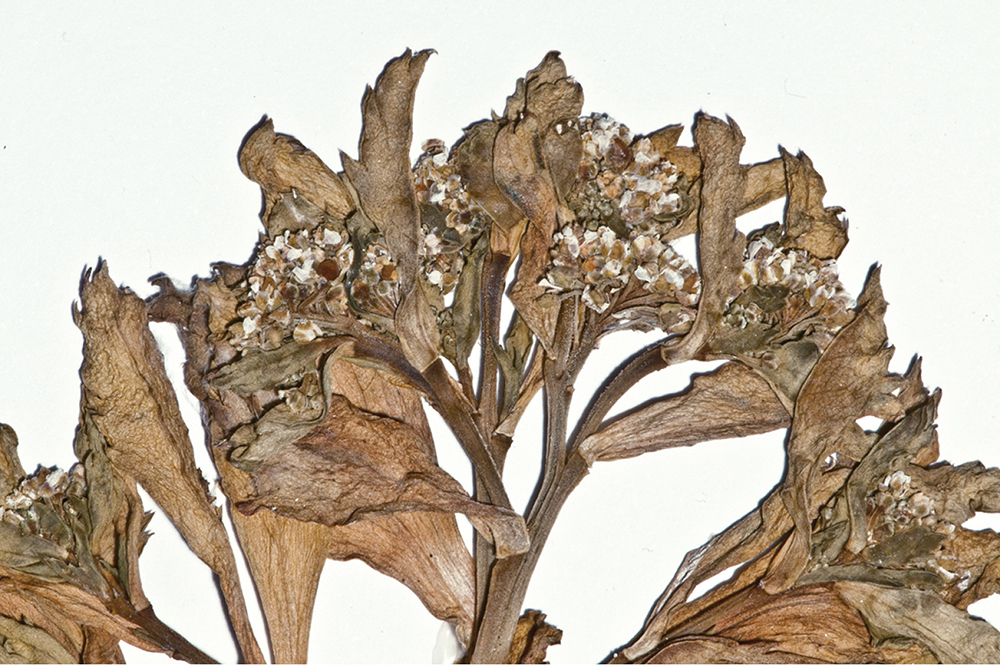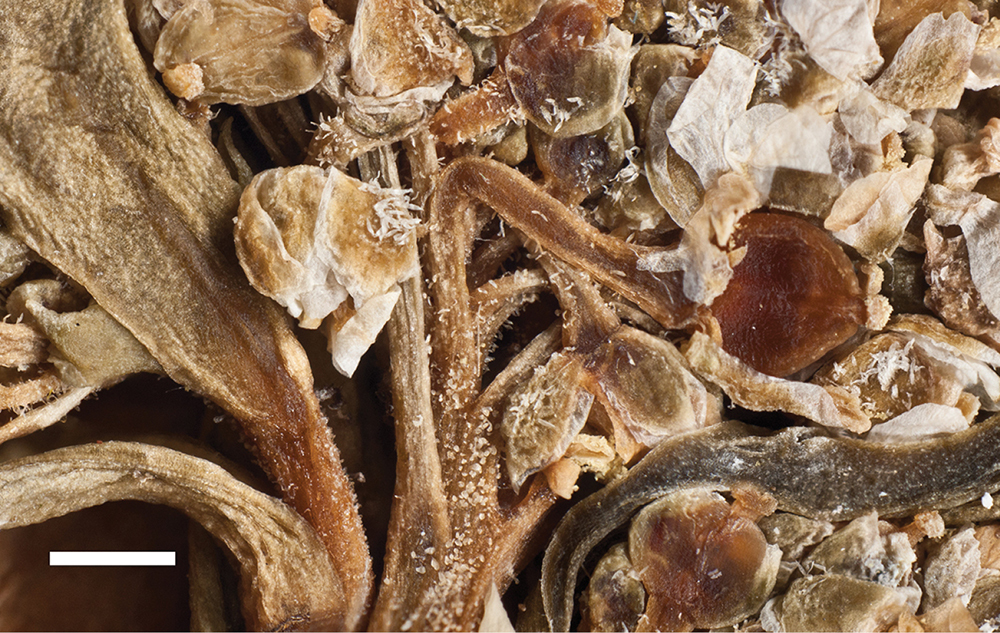






(C) 2013 P. J. de Lange. This is an open access article distributed under the terms of the Creative Commons Attribution License 3.0 (CC-BY), which permits unrestricted use, distribution, and reproduction in any medium, provided the original author and source are credited.
For reference, use of the paginated PDF or printed version of this article is recommended.
A revision of the New Zealand endemic Lepidium oleraceum and allied species is presented. Sixteen species are recognised, 10 of these are new. The new species are segregated on the basis of morphological characters supported by molecular data obtained from three DNA markers (two rDNA and one cpDNA). One species, Lepidium castellanum sp. nov., is endemic to the Kermadec Islands where it is sympatric with Lepidium oleraceum. The North Island of New Zealand supports four species, with two of them, Lepidium amissum sp. nov. and Lepidium obtusatum, now extinct. The South Island supports six species, that, aside from Lepidium banksii, Lepidium flexicaule and Lepidium oleraceum, are all confined to the south-eastern half of the island (Lepidium aegrum sp. nov., Lepidium crassum sp. nov. and Lepidium juvencum sp. nov.). One of these, Lepidium juvencum sp. nov., extends to Stewart Island. The Chatham Islands support six species (Lepidium flexicaule, Lepidium oblitum sp. nov., Lepidium oleraceum, Lepidium oligodontum sp. nov., Lepidium panniforme sp. nov., and Lepidium rekohuense sp. nov.), one of which, Lepidium oligodontum sp. nov., extends to the Antipodes Islands group. The remote, subantarctic Bounty Islands group supports one endemic, Lepidium seditiosum sp. nov., which is the only vascular plant to be recorded from there. Lepidium limenophylax sp. nov. is known from islands off the south-western side of Stewart Island/Rakiura, The Snares and Auckland islands. Lepidium naufragorum, although not related to Lepidium oleraceum and its allies, is also treated because populations with entire leaves are now known. Typification is undertaken for Lepidium banksii, Lepidium oleraceum, Lepidium oleraceum var. acutidentatum, var. frondosum and var. serrulatum.
New Zealand Archipelago, Kermadec Islands, Brassicaceae, Lepidium, L. oleraceum group , new species, L. aegrum sp. nov. , L. amissum sp. nov. , L. castellanum sp. nov. , L. crassum sp. nov. , L. juvencum sp. nov. , L. limenophylax sp. nov. , L. oblitum sp. nov. , L. oligodontum sp. nov. , L. panniforme sp. nov. , L. rekohuense sp. nov. , L. seditiosum sp. nov. , typifications, ecology, conservation
As currently circumscribed, the New Zealand members of the cosmopolitan genus Lepidium comprise 10 indigenous species (
It has long been recognised that Lepidium oleraceum G.Forst ex Sparrm. is a widely distributed and rather variable coastal species (
Holotype of Lepidium oleraceum var. serrulatum Thell.
Various authors have suggested that Lepidium oleraceum s.l. requires further taxonomic study to resolve the variation that had been observed throughout its distributional range. In reference to the three varieties,
In this paper we present a taxonomic revision of Lepidium oleraceum s.l. (hereafter referred to as the Lepidium oleraceum group), along with the allied species Lepidium banksii Kirk, Lepidium flexicaule Kirk, and the extinct Lepidium obtusatum Kirk. This revision began in 1990 (
In addition to revising the Lepidium oleraceum group, we also treat Lepidium naufragorum. At the time of its formal naming Lepidium naufragorum was regarded as having a relationship to Lepidium flexicaule and the Lepidium oleraceum group (
The taxonomic revision presented in this paper is based on the critical study of specimens and type material of Lepidium banksii, Lepidium flexicaule, Lepidium obtusatum, Lepidium oleraceum group, and Lepidium naufragorum held at the following herbaria AK, BM, CANU, CHR, HO, K, MEL, MPN, NSW, OTA, P, UNITEC, WAIK, WELT, and WELTU. Herbarium acronyms follow
To this sampling were added further plants of Lepidium banksii, Lepidium flexicaule, Lepidium oleraceum group and Lepidium naufragorum collected by New Zealand botanists from a wide range of sites, and held by the Auckland Botanic Gardens, University of Auckland, Oratia Native Plant Nurseries, Motukarara Conservation Nursery and Landcare Research (Lincoln campus) to meet the ex-situ objectives of the Department of Conservation Coastal Cress Recovery Plan (
In conjunction with the taxonomic revision of the Lepidium oleraceum group and allied species, phylogenetic studies were carried out to determine relationships among the taxa, as well as to gain a better understanding of the population variation in extant populations of Lepidium species. For simplicity and clarity we use the new taxonomic names described here throughout the manuscript.
All taxa accepted in the revision presented here were included in the phylogenetic analyses as well as other closely related New Zealand and Australian taxa (Table 1) (
Herbarium vouchers and GenBank numbers of Lepidium study group and outgroup samples used in the present investigation.
| Taxon | Nr. | Locality | ETS | ITS | trnL | Voucher or reference |
|---|---|---|---|---|---|---|
| Lepidium aegrum Heenan & de Lange | New Zealand, South I., Canterbury, Banks Peninsula | KC109387 | KC109330 | — | AK 283510 | |
| Lepidium aschersonii Thell. | Australia | — | AJ582426, AJ582483 | AY015838, AY015926 | ||
| Lepidium banksii Kirk | 1 | New Zealand, South I., Nelson, Abel Tasman National Park, Totaranui Point | KC109388 | KC109331 | KC109368 | AK 259119 |
| Lepidium banksii Kirk | 2 | New Zealand, South I., Nelson, Abel Tasman National Park, Totaranui | KC109389 | — | KC109369 | CHR 515311 |
| Lepidium banksii Kirk | 3 | New Zealand, South I., Nelson, Nguroa I. | KC109390 | KC109332 | — | AK 259118 |
| Lepidium castellanum de Lange & Heenan | Kermadec Is., Macauley I. | KC109391 | — | — | AK 306194 | |
| Lepidium crassum Heenan & de Lange | 1 | New Zealand, South I., Otago, Bridge Point, | KC109394 | — | — | CHR 609797 |
| Lepidium crassum Heenan & de Lange | 2 | New Zealand, South I., Otago Peninsula, Aramoana | KC109395 | KC234312 | KC109370 | AK 234312 |
| Lepidium crassum Heenan & de Lange | 3 | New Zealand, South I., Otago Peninsula, Aramoana | KC109396 | — | — | CHR 609772 |
| Lepidium crassum Heenan & de Lange | 4 | New Zealand, South I., Otago Peninsula, Wharekakahu I. | KC109393 | — | — | CHR 609801 |
| Lepidium crassum Heenan & de Lange | 5 | New Zealand, South I., Otago Peninsula, Eye talus | KC109392 | — | — | no voucher |
| Lepidium crassum Heenan & de Lange | 6 | New Zealand, South I., Otago, Tairei | KC109397 | — | — | no voucher |
| Lepidium crassum Heenan & de Lange | 7 | New Zealand, South I., Otago, Nugget Point | KC109398 | — | — | CHR 609805 |
| Lepidium desvauxii Thell. | 1 | Chatham Is., Rekohu (Chatham I.), Waitangi West | KC109399 | KC109334 | KC109371 | AK 294948 |
| Lepidium desvauxii Thell. | 2 | Australia | — | AJ582429, AJ582486 | AY015848, AY015935 | |
| Lepidium fasciculatum Thell. | Australia | — | AJ582428, AJ582485 | AJ582563, AJ582564 | ||
| Lepidium flexicaule Kirk | 1 | New Zealand, South I., Karamea, Scott’s Beach | — | AJ582430, AJ582487 | AY015853 | |
| Lepidium flexicaule Kirk | 2 | New Zealand, South I., Karamea, Scott’s Beach | KC109403 | — | — | — |
| Lepidium flexicaule Kirk | 3 | Chatham Is., Rekohu (Chatham I.) Point Somes | KC109400 | KC109335 | KC109372 | AK 289897 |
| Lepidium flexicaule Kirk | 4 | Australia, Tasmania, Port Davy, Elliot Point | KC109401 | KC109336 | KC109373 | HO 402077 |
| Lepidium flexicaule Kirk | 5 | Australia, Tasmania, Port Davy, Gull Reef | KC109402 | KC109337 | KC109374 | HO 26460 |
| Lepidium foliosum Desv. | 1 | Australia, Tasmania, Furneaux, Little Dog Island | KC109404 | KC109338 | KC109375 | HO 525314 |
| Lepidium foliosum Desv. | 2 | Australia, Tasmania, Marion Bay, Vischer Island, | KC109405 | KC109339 | — | HO 306271 |
| Lepidium hyssopifolium Desv. | Australia | — | AJ582435, AJ582492 | AY015861, AY015970 | ||
| Lepidium juvencum Heenan & de Lange | 1 | New Zealand, South I., Otago Peninsula, Long Beach | KC109406 | KC109340 | — | CHR 609803 |
| Lepidium juvencum Heenan & de Lange | 2 | New Zealand, South I., Otago Peninsula, Green Island | KC109407 | — | — | no voucher |
| Lepidium juvencum Heenan & de Lange | 3 | New Zealand, South I., Otago Peninsula, Green Island | KC109408 | — | — | AK 238646 |
| Lepidium limenophylax de Lange, B.D.Rance & D.A.Norton | Snares Is, North-East I. | KC109409 | KC109341 | KC109376 | AK 283482 | |
| Lepidium muelleri-ferdinandi Thell. | Australia | — | AJ582427, AJ582484 | AY015870, AY015956 | ||
| Lepidium naufragorum Garn.-Jones & D.A.Norton | 1 | New Zealand, South I., West Coast, Open Bay Is., Taumaka | AJ532422 | DQ989386 | AY015958 | |
| Lepidium naufragorum Garn.-Jones & D.A.Norton | 2 | New Zealand, South I., West Coast, Open Bay Is., Taumaka | KC109410 | — | KC109377 | AK 317068 |
| Lepidium naufragorum Garn.-Jones & D.A.Norton | 3 | New Zealand, South I., West Coast, Open Bay Is., Taumaka | KC109411 | — | KC109378 | AK 317070 |
| Lepidium naufragorum Garn.-Jones & D.A.Norton | 4 | New Zealand, South I., West Coast, Open Bay Is., Taumaka | — | — | AY015872, AY015958 | |
| Lepidium nesophilum Hewson | 1 | Lord Howe I., Gower Track | KC253769 | KC109342 | — | NSW 253769 |
| Lepidium nesophilum Hewson | 2 | Lord Howe I., Little Slope | KC109413 | KC109343 | KC109379 | NSW 492466 |
| Lepidium oblitum Houliston, Heenan & de Lange | Chatham Is., Mangere I. | KC109415 | — | — | AK 300342 | |
| Lepidium obtusatum Kirk | New Zealand, North I., Wellington, Miramar Peninsula, Seatoun | KC109414 | KC109344 | KC109380 | CHR 329224 | |
| Lepidium oleraceum G.Forst. ex Sparrm. | 1 | New Zealand, Three Kings Is., West I. | KC109435 | KC109360 | — | AK 288471 |
| Lepidium oleraceum G.Forst. ex Sparrm. | 2 | New Zealand, North I., North Auckland, Te Paki, Motuopao I. | KC109428 | KC109354 | — | AK 195840 |
| Lepidium oleraceum G.Forst. ex Sparrm. | 3 | New Zealand, North I., North Auckland, Te Oneroa-a-Tohe (Ninety Mile Beach), Matapia I. | KC109424 | KC109350 | — | AK 212201 |
| Lepidium oleraceum G.Forst. ex Sparrm. | 4 | New Zealand, North I., Poor Knights Is., Archway I. | KC109430 | — | — | AK 302001 |
| Lepidium oleraceum G.Forst. ex Sparrm. | 5 | New Zealand, North I., Mokohinau Is, Motuharakeke I. | KC109420 | — | — | AK 226984 |
| Lepidium oleraceum G.Forst. ex Sparrm. | 6 | New Zealand, North I., Mokohinau Is., Motukino (Fanal I.) | KC109427 | KC109353 | — | AK 258785 |
| Lepidium oleraceum G.Forst. ex Sparrm. | 7 | New Zealand, North I., Great Barrier I. (Aotea I.), Mahuki I. | KC109421 | KC109348 | — | AK 255389 |
| Lepidium oleraceum G.Forst. ex Sparrm. | 8 | New Zealand, North I., Coromandel Peninsula, Aldermen Is., Hongiora | KC109416 | KC109345 | — | AK 304818 |
| Lepidium oleraceum G.Forst. ex Sparrm. | 9 | New Zealand, North I., Coromandel Peninsula, Aldermen Is., Middle Is, | KC109426 | KC109352 | — | AK 293250 |
| Lepidium oleraceum G.Forst. ex Sparrm. | 10 | New Zealand, North I., Coromandel Peninsula, Matariki I. | KC109425 | KC109351 | — | AK 231114 |
| Lepidium oleraceum G.Forst. ex Sparrm. | 11 | New Zealand, North I., South Auckland, Ngatutura Point, Shag Rock | KC109429 | KC109355 | — | AK 306120 |
| Lepidium oleraceum G.Forst. ex Sparrm. | 12 | New Zealand, North I., Bay of Plenty, Karewa I. | KC109418 | KC109347 | — | AK 293306 |
| Lepidium oleraceum G.Forst. ex Sparrm. | 13 | New Zealand, North I., Bay of Plenty, Karewa I. | KC109419 | — | — | AK 299140 |
| Lepidium oleraceum G.Forst. ex Sparrm. | 14 | New Zealand, North I., South Auckland, Albatross Point, Waioioi Reef | KC109436 | KC109361 | — | AK 297502 |
| Lepidium oleraceum G.Forst. ex Sparrm. | 15 | New Zealand, North I., Taranaki, Sugarloaf Is., Motumahanga I. | KC109434 | KC109359 | — | AK 293304 |
| Lepidium oleraceum G.Forst. ex Sparrm. | 16 | New Zealand, North I., Kapiti I. | KC109417 | KC109346 | — | AK 259125 |
| Lepidium oleraceum G.Forst. ex Sparrm. | 17 | New Zealand, North I., Wellington, Mana I. | KC109423 | KC109349 | — | AK 293308 |
| Lepidium oleraceum G.Forst. ex Sparrm. | 18 | New Zealand, South I., Marlborough, Cook Strait Takapourewa (Stephens I.) | KC109433 | KC109358 | KC109381 | AK 233809 |
| Lepidium oleraceum G.Forst. ex Sparrm. | 19 | New Zealand, South I., Marlborough, Cook Strait Brothers Is., South Brother | KC109431 | KC109356 | — | AK 293307 |
| Lepidium oleraceum G.Forst. ex Sparrm. | 20 | New Zealand, South I., Marlborough, Cook Strait Brothers Is., North Brother | KC109432 | KC109357 | — | no voucher |
| Lepidium oleraceum G.Forst. ex Sparrm. | 21 | Chatham Is., Mangere I. | KC109422 | — | — | AK 295979 |
| Lepidium oligodontum de Lange & Heenan | 1 | Chatham Is., The Sisters (Rangitatahi) | KC109438 | KC109363 | KC109382 | AK 290289 |
| Lepidium oligodontum de Lange & Heenan | 2 | Chatham Is., Rekohu (Chatham I.), Point Somes | KC109437 | KC109362 | — | AK 292941 |
| Lepidium oligodontum de Lange & Heenan | 3 | Antipodes Is., Antipodes I. | KC109439 | — | KC109383 | AK 293309 |
| Lepidium oxytrichum Sprague | Australia | — | AJ582424, AJ582481 | AY015877, AY015963 | ||
| Lepidium panniforum de Lange & Heenan | Chatham Is., Mangere I., | KC109440 | KC109364 | KC109384 | AK 293305 | |
| Lepidium papillosum F.Muell. | Australia | — | AJ582425, AJ582482 | AY015878, AY015964 | ||
| Lepidium pseudohyssopifolium Hewson | Australia | — | AJ582431, AJ582488 | — | ||
| Lepidium pseudopapillosum Thell. | Australia | — | AJ582423, AJ582480 | AY015886, AY015971 | ||
| Lepidium pseudotasmanicum Thell. | Australia | — | AJ582432, AJ582489 | AY015887, AY015972 | ||
| Lepidium rekohuense de Lange & Heenan | 1 | Chatham Is., Rekohu (Chatham I.), Kaiangaroa | KC109441 | KC109365 | — | AK 259130 |
| Lepidium rekohuense de Lange & Heenan | 2 | Chatham Is., Forty Fours (Motuhara), Chatham Islands | KC109442 | KC109366 | KC109385 | AK 290290 |
| Lepidium seditiosum de Lange Heenan, & J.Rolfe | Bounty Is., Funnel I. | KC109443 | KC109367 | — | OTA 59718 | |
| Outgroups | ||||||
| Lepidium sisymbrioides Hook.f. | 1 | New Zealand, South I., Otago, Gards Road | DQ989378 | DQ997560 | DQ997064 | |
| Lepidium sisymbrioides Hook.f. | 2 | New Zealand, South I., Otago, Otematata | DQ989376 | DQ997565 | DQ997054 | |
| Lepidium sisymbrioides Hook.f. | 3 | New Zealand, South I., Otago, Falls Dam | DQ989381 | DQ997569 | DQ997061 | |
| Lepidium sisymbrioides Hook.f. | 4 | New Zealand, South I., Otago, Nevis Bluff | DQ989383 | DQ997561 | DQ997067 | |
| Lepidium solandri Kirk | New Zealand, South I., Canterbury, Castle Hill | DQ989389 | DQ997553 | DQ997060 | ||
| Lepidium tenuicaule Kirk | 1 | New Zealand, South I., Otago, Shag Point | DQ989404 | AJ582421 | AY015899 | |
| Lepidium tenuicaule Kirk | 2 | New Zealand, South I., Otago, Shag Point | KC109444 | — | KC109386 | AK 232774 |
Total genomic DNA was extracted from 0.1–1.0 g of leaf tissue using a QIAGEN DNeasy® Plant Mini Kit or an INTRON Plant DNA kit using fresh material, fresh material stored in Silica Gel, and from herbarium specimens. DNA sequencing of nrDNA (ITS1-5.8S-ITS2 and ETS), and plastid DNA (trnL-F spacer regions) were carried out following the methods of
PCR products were purified using either the Perfectprep PCR cleanup kits (Eppendorf), or diluted to approximately 1:4 with ultrapure water. Each sample was sequenced in the sense and antisense direction by the Centre for Gene Technology (University of Auckland), the Allan Wilson Centre Genome Service, (Massey University, Albany), or the Landcare Research Ecological Genetics Laboratory (Tamaki). Sequencing reactions were performed with the same primers as the PCR amplifications and the 3.1 ABI PrismTM Big Dye Terminator Sequencing Kit (Applied Biosystems, Scoresby, Vic.). Sequences obtained in this study have been assigned GenBank accession numbers (Table 1).
Sequence alignment was performed using ClustalX vers. 1.81 (
Maximum likelihood (ML) analyses were conducted using RaXML (
Trees were drawn in Figtree version 1.3.1. (
Phylogenetic analyses provided some resolution of relationships, with ETS the most informative (Fig. 2), resolving the Lepidium oleraceum and Lepidium sisymbrioides groups. Within the Lepidium oleraceum group there is a strong north-south dichotomy, with another group present on the Chatham Islands and sub-Antarctic islands. The samples from the North Island comprised only Lepidium oleraceum sensu stricto (s.s.), and the southern group included Lepidium aegrum Heenan et de Lange from Banks Peninsula, Lepidium crassum Heenan et de Lange from the Otago coast, Lepidium juvencum Heenan et de Lange from Green Island and Long Beach Otago, Lepidium limenophylax de Lange, B.D.Rance et D.A.Norton from the Snares Islands, and the Kermadec Islands’ Lepidium castellanum de Lange et Heenan. Chatham Island and sub-Antarctic species included Lepidium rekohuense de Lange & Heenan, Lepidium oblitum Houliston, Heenan et de Lange, Lepidium panniforme de Lange & Heenan, and Lepidium oligodontum de Lange et Heenan from the Chatham Islandsand Lepidium seditiosum de Lange, Heenan & J.Rolfe from Bounty Island. ITS also resolved the Lepidium oleraceum and Lepidium sisymbrioides groups, but within ITS, there was no resolution within the Lepidium oleraceum groupincluding Lepidium banksii (Fig. 3). The pattern for trnL-F was more complex (Fig. 4), and is discussed below, although it again provided no resolution within the Lepidium oleraceum groupand Lepidium banksii.
Maximum likelihood phylogeny of ETS as calculated in RaXML, showing the Lepidium oleraceum (black text) and Lepidium sisymbrioides (red text) groups, including the newly described taxa. Bootstrap support from 1000 replicates is shown for branches where it is greater than 50. Codes for each individual in the phylogeny are shown in Table 1. The main clade branches have been truncated to accommodate the tree within the journal format. AUS = Australia, NZ = New Zealand.
Maximum likelihood phylogeny of ITS as calculated in RaXML, showing the Lepidium oleraceum (black text) and Lepidium sisymbrioides (red text) groups, including the newly described taxa. Bootstrap support from 1000 replicates is shown for branches where it is greater than 50. Codes for each individual in the phylogeny are shown in Table 1. The main clade branches have been truncated to accommodate the tree within the journal format.
Maximum likelihood phylogeny of trnL-F as calculated in RaXML, showing the Lepidium oleraceum (black text) and Lepidium sisymbrioides (red text) groups, including the newly described taxa. Bootstrap support from 1000 replicates is shown for branches where it is greater than 50. Codes for each individual in the phylogeny are shown in Table 1.
Eighteen unique ETS sequences were present among the 65 Lepidium samples that were amplified for this region (58 from the Lepidium oleraceum group and seven from the Lepidium sisymbrioides group) (Fig. 2). Within the Lepidium sisymbrioides group, the four samples of Lepidium sisymbrioides all had different ETS ribotypes, and Lepidium naufragorum, and Lepidium tenuicaule Kirk also contained more than one ribotype. Within the Lepidium oleraceum group, one described species, Lepidium flexicaule, was found to contain more than one ETS ribotype, with the New Zealand and Tasmanian examples of this species differing by two base substitutions.
Two pairs of species (Lepidium rekohuense and Lepidium seditiosum; Lepidium oleraceum and Lepidium banksii) shared the same ETS type (Fig. 2). Lepidium flexicaule (Tasmanian sample), Lepidium foliosum Desv.(Australian endemic) and Lepidium desvauxii Thell. (Australia and New Zealand samples) also share identical ETS sequences, however New Zealand Lepidium flexicaule have a different ETS type (Fig. 2). The three most southern / central South Island species, Lepidium crassum, Lepidium aegrum and Lepidium juvencum, share an identical ETS type with Lepidium seditiosum from the Bounty Islands, while Lepidium castellanum from Macauley Island (Kermadec Islands group) is also similar, differing by only one base pair (Fig. 2).
There were three different ribotypes in Lepidium oleraceum s.s., with a single sample from Mangere Island differing by a single base pair to the other Lepidium oleraceum s.s. samples.
The extinct Lepidium obtusatum and morphologically rather different Chatham Islands endemic Lepidium panniforme also share an ETS sequence type, which is almost identical to that of another Chatham Islands endemic, Lepidium oblitum (Fig. 2). Notably, these three species also differ from the other Chatham Islands endemic, Lepidium rekohuense, and the Chatham /Antipodes islands endemic, Lepidium oligodontum (Fig. 2). Lepidium limenophylax, known from the southern Titi Island of the south-western coastline of Stewart Island, the Snares and Auckland Islands, is sister to these Chatham / Antipodes islands species (i.e., Lepidium oblitum, Lepidium oligodontum, Lepidium panniforme, and Lepidium rekohuense) (Fig. 2).
This study also confirms the taxonomic status of the Lord Howe Island endemic, Lepidium nesophilum Hewson, which is a species that had previously been treated as Lepidium oleraceum (see
The 56 samples of Lepidium from which ITS data were collated (48 Lepidium oleraceum group, 6 Lepidium sisymbrioides group) are shown in Fig. 3. With the exception of Lepidium limenophylax, all of the other species within the Lepidium oleraceum group, including Lepidium banksii and the Chatham Island sample of Lepidium flexicaule, shared the same ITS sequence (Fig. 3).
The New Zealand (Karamea) sample of Lepidium flexicaule grouped with Australian samples from which it differed by a single base pair (Fig. 3). In addition, the two Lord Howe samples of Lepidium nesophilum, had markedly different ITS sequences, though, notably, they clustered with other Australian species and shared an identical ETS sequence.
The plastid data (trnL-F spacer region, 30 Lepidium oleraceum group, 7 Lepidium sisymbrioides group included) is interesting for the lack of strong divergence between the oleraceum and sisymbrioides groups, with two species (Lepidium sisymbrioides and Lepidium naufragorum) being found in both clades (Fig. 4); see
Although the trnL-F spacer region showed only low sequence variation, several patterns were evident. For example, the morphologically distinctive species Lepidium naufragorum (New Zealand), Lepidium flexicaule (Australia + New Zealand), Lepidium muelleri-ferdinandi Thell. (Australia), L. fasciculatum Thell. (Australia) and Lepidium oleraceum (Kermadec Islands and New Zealand)had identical sequences (Fig. 4), a pattern that suggests a recent origin for these taxa. Further, the two New Zealand samples of Lepidium flexicaule (South Island (Karamea) and Chatham Islands) have distinct trnL-F sequences (Fig. 4). Morphologically, the Chatham Island race of Lepidium flexicaule differs from the majority of New Zealand (North Island and South Island) Lepidium flexicaule plants in that they lack the marginal leaf, pedicel and stem denticles that are diagnostic of the species on mainland New Zealand (see
Bootstrap support for the trees was low to moderate, as would be expected for recently diverged taxa where resolution and divergence is low and where there has possibly been recent reticulation. An earlier study has indicated that hybridisation, and biocontinental origin for the New Zealand / Australian Lepidium is likely, although the age of this event and whether it is related to the divergence from the rest of the Lepidium group is unclear (
Lepidium naufragorum was found in the Lepidium oleraceum clade for the plastid data, but is a member of the Lepidium sisymbrioides group for both nuclear regions. This incongruence suggests that Lepidium naufragorum could have had a hybrid origin, with a parent from each of these groups (see in this respect also
In general, the Lepidium oleraceum and Lepidium sisymbrioides groups formed two distinct clades in both nuclear datasets, but was not strongly supported by the plastid data, as was found by
Lepidium oleraceum s.s., its allied species, and the unrelated Lepidium naufragorum are all perennial herbs that can be distinguished by their growth habit. This includes plants with an upright, spreading or sprawling, shrubby growth habit (Lepidium castellanum, Lepidium aegrum, Lepidium banksii, Lepidium crassum, Lepidium juvencum, Lepidium oleraceum, Lepidium panniforme and Lepidium seditiosum) and those with a prostrate or decumbent growth habit (Lepidium amissum, Lepidium flexicaule, Lepidium limenophylax, Lepidium oblitum, Lepidium obtusatum, Lepidium oligodontum, and Lepidium rekohuense). Lepidium obtusatum is, as discussed by
The leaves of Lepidium oleraceum and allied species show a diversity of shape and degree of dentition that has been the basis for the recognition of a number of species and varieties (see
Cauline leaves of (A) Lepidium aegrum, (B) Lepidium banksii, (C) Lepidium castellanum, (D) Lepidium crassum, (E) Lepidium juvencum, (F) Lepidium oblitum, (G) Lepidium obtusatum, (H) Lepidium oleraceum. Scale bars = 20 mm.
Cauline leaves of (A) Lepidium oligodontum—variation within a single plant, (B) Lepidium oligodontum - variation amongst plants from different locations: (left to right) The Sisters, Western Reef, Point Somes, Moriori Creek, Star Keys, Rangatira Island, Antipodes Island. (C) Lepidium panniforme, (D) Lepidium rekohuense. Scale bars = 20 mm.
The inflorescences, flowers and fruits of the Lepidium oleraceum group provide a number of characters enabling species recognition. The inflorescences of the species in the group are usually leaf-opposed. While in some species (Lepidium flexicaule and Lepidium obtusatum) the inflorescences tend to be obscured by foliage, they are held well above the surrounding foliage in the majority of species. In most species the inflorescence rachises and pedicels are glabrous, but in Lepidium castellanum, Lepidium banksii, Lepidium rekohuense, Lepidium seditiosum, (and very rarely Lepidium oblitum), minute, usually sparse, eglandular, clavate hairs are present. The sepals and petals show little variation with respect to size, shape, and degree of investiture. The size, shape and degree of notching of the silicles, and the length and shape of the stigma remnant are also critical characters (see
Stamen number of the Lepidium oleraceum group varies between species with two (Lepidium flexicaule, Lepidium limenophylax and Lepidium rekohuense), those with four (Lepidium castellanum, Lepidium aegrum, Lepidium amissum, Lepidium juvencum, Lepidium banksii, Lepidium crassum, Lepidium juvencum, Lepidium naufragorum, Lepidium obtusatum, Lepidium oleraceum, and Lepidium seditiosum), to those with variable stamen numbers (Lepidium oblitum, Lepidium panniforme, and Lepidium oligodontum). In these three species, stamen numbers may vary from two to four (Lepidium oblitum, Lepidium panniforme) to a maximum of six in Lepidium oligodontum, often within the same inflorescence, or on different individuals of the same species.
Silicle shape (Table 1, Figs 7, 8) varies and comprises four main shapes: 1. Silicles mostly elliptic to elliptic-rhomboid (rarely orbicular-rhomboid) (Lepidium castellanum, Lepidium aegrum, Lepidium juvencum, Lepidium limenophylax, Lepidium naufragorum, Lepidium oleraceum); 2. Silicles orbicular-rhomboid only (Lepidium crassum, Lepidium juvencum); 3. Silicles mostly ovate (ovoid), oval to obovate (Lepidium amissum, Lepidium banksii, Lepidium oblitum, Lepidium obtusatum, Lepidium panniforme); and, 4. Silicles mostly orbicular (rarely ovoid, obovate) (Lepidium flexicaule, Lepidium oligodontum, Lepidium rekohuense). The silicles of Lepidium panniforme can vary from ovate (the usual state) through to elliptic-rhomboid. With respect to silicle size, Lepidium obtusatum has the largest silicles (up to 6.4 × 4.9 mm) and both Lepidium limenophylax and Lepidium panniforme the smallest (up to 3.5 × 3.3 mm) (Table 1). Although silicle characters are unavailable for Lepidium seditiosum, of which we have only a single immature fruiting specimen, the few immature silicles present indicate that, as with all the other members of the Lepidium oleraceum group, the two valves are dehiscent (see Lepidium key).
Silicles of (A) Lepidium aegrum, (B) Lepidium amissum, (C) Lepidium banksii, (D) Lepidium castellanum, (E) Lepidium crassum, (F) Lepidium flexicaule, (G) Lepidium juvencum, (H) Lepidium limenophylax. Scale bars = 1mm.
Silicles of (A) Lepidium oblitum, (B) Lepidium obtusatum, (C) Lepidium oleraceum, (D) Lepidium oligodontum, (E) Lepidium panniforme, (F) Lepidium rekohuense. Scale bars = 1 mm.
The presence or absence of an apical notch to the silicle in the New Zealand species was an important character emphasised by
A L. oleraceo caulibus gracilibus flexilibus, foliis pallide viridibus membranaceis, lanceolatis elliptico-lanceolatis vel anguste ellipticis, apice prominente acuto vel subacuto, marginibus serratis dentibus prominentibus profundis, et sequentia nucleotidorum DNA distinguenda.
(Fig. 9). New Zealand: Canterbury, Lincoln, Landcare Research experimental nursery, ex Banks Peninsula, rock stack near Island Bay, May 2011, P. B. Heenan s.n., CHR 616211!
Holotype of Lepidium aegrum Heenan & de Lange.
The specific epithet ‘aegrum’ is derived from Latin, meaning ‘diseased and/or sick body’ and refers to the condition of the plants in the single known extant wild population on the unnamed rock stack near Island Bay, many of which are infected with turnip mosiac virus (
(Figs 10–14). Tap-rooted, strongly pungent smelling, perennial herb. Growth habit open, up to 50 cm tall, stems arising from basal woody stems. Stems upright, slender, flexible; mature stems woody, 100–500 × 10–12 mm, often devoid of foliage on middle and lower parts of stems; new stems 80–200 × 3–4 mm, leafy, glabrous. Leaves glabrous, membranous, light green, planar, pellucid glands sometimes scattered on abaxial surface, rosette and stem leaves usually withering, variable in size and shape. Leaves of young and vigorous plants and stems: lamina 35–80 × 10–20 mm, lanceolate, elliptic-lanceolate, narrowly elliptic; apex subacute, with a single prominent tooth; margin singly serrate, with 8–12 pairs of teeth; teeth up to 3.5 mm deep, not overlapping; base attenuate, tapering to distinct petiole. Leaves of mature plants and cauline stems: lamina 30–65 × 4–11 mm, narrowly lanceolate, elliptic-lanceolate, narrowly elliptic; apex acute to subacute, with a single prominent tooth; margin singly serrate in upper and/or lower half, with 2–10 pairs of teeth; teeth up to 1.2 mm deep, not overlapping; base attenuate, tapering to petiole. Inflorescence terminal and lateral, racemose, often branched, up to 95 mm long, rachis up to 2.1 mm diam., glabrous; pedicels 4–10 mm long, erecto-patent, glabrous. Flowers 4.0–4.5 mm diam. Sepals 4, 1.0–1.5 mm long, saccate, green, apex obtuse, margin white, shape dimorphic; lateral sepals broad, 1.0–1.1 mm diam., orbicular, abaxial surface often hairy, hairs entirely eglandular or with glandular tip, 0.2–0.3 mm long; median sepals narrow, 0.8–0.9 mm diam., broadly elliptic, glabrous. Petals white, 2.3–2.5 × 1.2–1.4 mm, spreading, claw 0.7–0.9 mm long; limb broadly elliptic to orbicular, apex obtuse to rounded. Stamens 4; filaments 1.7–2.0 mm long, base 0.3–0.4 mm diam., equal; anthers 0.4–0.5 mm long. Ovary 0.9–1.0 × 0.9–1.0 mm, broadly ovate to broadly elliptic, green, apex usually with shoulders; style 0.3–0.4 mm long, cylindrical; stigma 0.3–0.4 mm diam. Nectaries 4, 0.2–0.3 × c. 0.1 mm, oblong, green. Silicles cartilaginous when fresh, coriaceous when dry, 4.0–4.7 × 3.2–3.5 mm, elliptic-rhomboid to orbicular-rhomboid, apex shallowly notched, valves pale brown, glabrous, not winged; style 0.3–0.4 mm long, exserted. Seeds 1.6–1.7 × 0.9–1.0 mm, narrowly ovoid, brown to orange-brown, not winged. FL Mar. FR Mar.
Lepidium aegrum plant in the wild showing usual growth habit (Lepidium aegrum growing in association with Disphyma australe subsp. australe) amongst petrel burrows).
Lepidium aegrum stem showing four inflorescences. Scale bar = 20 mm.
Lepidium aegrum leafy stems showing mid-stem and apical foliage. Scale bar = 20 mm.
Lepidium aegrum (from left to right) basal- to mid-stem foliage. Scale bar = 20 mm.
Mature silicle of Lepidium aegrum. CHR 222380. Scale bar = 1 mm.
New Zealand (South Island): Banks Peninsula, Waikerikeri, n.d., R. M. Laing s.n., (AK 4463); Banks Peninsula, Akaroa, Akaroa Head, Island Bay, Unnamed Islet, July 2002, N. Head s.n., AK 283510. Cultivated (New Zealand): Landcare Research experimental nursery, Lincoln, ex Akaroa, Akaroa Head, Island Bay, Unnamed Islet, 5 September 2008, P. J. de Lange 7363 & G. Houliston, (AK 303515);Landcare Research experimental nursery, Lincoln, ex Island Bay, Banks Peninsula, 13 January 2010, P. B. Heenan s.n., (CHR 609820); Landcare Research experimental nursery, Lincoln, ex Island Bay, Banks Peninsula, 13 January 2010, P. B. Heenan s.n., (CHR 609821); Landcare Research experimental nursery, Lincoln, ex Island Bay, Banks Peninsula, 1 April 2009, P. B. Heenan s.n., (CHR 609804); Landcare Research experimental nursery, Lincoln, ex Island Bay, Banks Peninsula, 11 August 2009, P. B. Heenan s.n., (CHR 609792).
Distribution (Fig. 15). Endemic. New Zealand, South Island, Canterbury, Banks Peninsula, Island Bay, unnamed rock stack.
Distribution of Lepidium aegrum, Lepidium amissum, Lepidium castellanum (Kermadec Islands only), Lepidium banksii, and Lepidium crassum.
Known from a single wild population on a small and unnamed island near Island Bay. Here it grows in open and disturbed areas among petrel burrows and Disphyma australe (W.I.Aiton) N.E.Br. subsp. australe (Fig. 6). Additional populations of Lepidium aegrum have been established in Canterbury on Motunau Island (Pegasus Bay), Quail Island (Lyttleton Harbour), and at Stony Bay (Banks Peninsula).
Recognition. Lepidium aegrum is distinguished by its slender flexible stems (Figs 11, 12), light green membranous leaves that are lanceolate, elliptic-lanceolate or narrowly elliptic with a prominent acute to subacute apex, and margins that are serrate with prominent and deep teeth (Fig. 13).
Conservation Status. Lepidium aegrum is known from a single wild population and three additional populations that have been established with nursery-raised plants. The single wild population and unknown recruitment patterns means that this species is especially vulnerable to stochastic events. Furthermore, turnip mosiac virus, which deforms and retards growth, is common in plants at the wild population, and this will likely reduce reproductive success (
A L. obtusato habitu suberecto parce ramoso et sine rhizome, caulibus arcutis potius quam flexuosis, foliis rosulae et caulis inferi profunde denticutis persistente oblanceolato-spathulatis ad obovato-spathulatis, foliis caulis superi sparsis lanceolatis ad anguste oblanceolatis vel obdetoideis truncatis et profunde dentatis (raro integris) paribus dentorum usque ad 6 profunde incises et sparsim foliaceis, racemis longioribus quibus non obscuris caulibus vegetativis siliclisque parvioribus et angustioribus differt.
New Zealand (Fig. 16): Cliffs between Karekare and Manukau Heads, January 1917, T. F. Cheeseman s.n., AK 4474! Isotypes: AK 206570!, WELT SP030095!
Holotype of Lepidium amissum de Lange & Heenan.
The epithet ‘amissum’ is derived from the Latin ‘amissus’ meaning ‘lost’ and is used here to refer to the loss though extinction, of this plant from the New Zealand flora.
(Figs 17–20). Glabrous, suberect, sparingly branched, succulent, perennial, herb forming open patches up to c. 1 m diam. Rootstock stout, woody, exposed portion rough, covered in old dead stem and rosette-leaf remnants admixed with actively growing stems. Stems arching, widely spreading, possibly with apices weakly ascendent, succulent, mature stems woody, 200–300 × 3–6 mm, densely leafy near base, leaves more widely spaced along upper stems. Leaves glabrous, coriaceous, probably succulent, dark green, planar, variable size and shape. Rosette leaves persistent at fruiting 71.7–95.2 × 12.4–23.2 mm, oblanceolate-spathulate to obovate-spathulate; apex, truncate, praemorse, with 3–8 deeply incised teeth; margin coarsely and often irregularly incised or dentate, often weakly bidentate, with 24–36 pairs of teeth; teeth up to 4.8 mm deep, irregular in size, protruding beyond leaf outline; base narrowly attenuate to cuneate, ± decurrent, petiole distinct, 43.4–55.2 × 1.4–2.3 mm long, slightly winged, or not, channelled. Lower stem leaves similar to rosette leaves, apparently persistent, widely spaced, gradually decreasing in size toward inflorescence; petioles distinct, slightly winged or not. Upper stem leaves much reduced; lamina 10.3–27.5 × 3.4–7.6 mm, lanceolate, narrowly oblanceolate, lanceolate to narrowly obdeltoid, apex truncate, with 3–4 prominent teeth, margins prominently toothed in upper ⅓ of lamina with 4–6 deeply incised pairs of teeth (rarely entire except for apex), base cuneate to broadly cuneate; petiole distinct or indistinct, up to 6 mm long when present, channelled. Inflorescence racemose, terminal and lateral, conspicuous, sparingly leafy and unfettered by associated vegetative leafy stems; racemes 22–68 mm long, rachis 0.9–1.6 mm diam., glabrous; pedicels 2.8–3.2 mm long at flowering, erecto-patent, elongating somewhat after anthesis, glabrous. Flowers 4.3–4.6 mm diam. Sepals 4, saccate, overlapping at base, green, apex obtuse, margin white, shape and size dimorphic; lateral sepals 2.2–2.9 × 2.1–3.0 mm, suborbicular, mostly glabrous, sometimes sparsely hairy, hairs 0.2–0.4 mm long, caducous; median sepals 1.9–2.9 × 1.5–1.7 mm, broadly elliptic to obovate, abaxial surface glabrescent, sparsely hairy, hairs 0.2–0.4 mm long, caducous. Petals white, 1.3–1.8 × 1.3–1.8 mm, erect, claw minute, 0.2–0.3 mm; limb orbicular, apex obtuse. Stamens 4, ± equal lengths, 1.2–1.8 mm long, base 0.6–1.0 mm wide; anthers 0.6–0.8 mm long, yellow, pollen yellow. Ovary 1.3–1.8 × 1.3–1.7 mm, broadly ovate to suborbicular green, apex distinctly notched; style 0.3–0.5 mm long, cylindrical below, spreading at apex; stigma 0.5–0.6 mm diam. Nectaries 4, green, 0.12–0.14 × c. 0.09 mm, narrow oblong, apex obtuse. Silicles 3.4–4.5 × 2.9–3.9 mm, broadly ovate, oval to obovate, apex prominently notched, valves yellow-green (in dried specimens), glabrous, slightly winged; style 0.2–0.5 mm long, not or only slightly exserted. Seeds 2.0–2.7 × 1.8–2.0 mm, obovate, broadly obovate, brown to orange-brown, not winged. FL: Dec–Jan. FR: Dec–Jan.
Basal stem leaves of Lepidium amissum. AK 4473
Basal stem leaf of Lepidium amissum. AK 4473.
Upper-stem leaves and inflorescences of Lepidium amissum. AK 4473.
Mature silicle of Lepidium amissum. AK 4473. Scale bar = 1 mm.
New Zealand (North Island): North Auckland, Cliffs north of the Manukau heads, December 1870, T. F. Cheeseman s.n., (AK 4473).
(Fig. 15). Endemic. New Zealand, North Island, where it was recorded from ‘between Manukau Heads and Karekare’ (
Lepidium amissum had previously been included in Lepidium obtusatum, perhaps because the species have no obvious floral differences and both have deeply notched and winged silicles with tapering bases. However, from Lepidium obtusatum, Lepidium amissum differs by the non-rhizomatous, suberect growth habit; arching, sparingly leafy stems (Fig. 16); long persistent, deeply, and sharply incised rosette and lower stem leaves (Figs 17, 18); upper stem leaves which are lanceolate, narrowly oblanceolate, to narrowly obdeltoid and mostly prominently toothed, with up to 6 pairs of deeply incised teeth, and with a truncate apex bearing 3–4 prominent teeth. The inflorescences of Lepidium amissum are larger, only sparsely leafy when mature, and without associated vegetative stems (Fig. 19). The silicles are smaller than those of Lepidium obtusatum (Fig. 20).
Little is known about the habitat preferences and ecology of Lepidium amissum, beyond that it grew on sea cliffs (
Lepidium amissum is considered to be extinct. There have been repeated unsuccessful surveys for this species over the last fifty years by various botanists. Aside from the type the species is known from only one collection made in 1917. This collection and the type came from an ill defined area of coastline stretching for some 6 km from the Manukau Heads to Karekare. Today this coastline is protected within the Centennial Park, Waitakere Ranges. However, during the period when this species was gathered, all of the coastline was being modified as a result of kauri (Agathis australis (D.Don) Lindl.) logging (see
“SOUTH Island: Queen Charlotte Sound and Astrolabe Habrour, A. Richard, l.c.”
(Fig. 21, designated here): Herbarium Richard, Paris!
Lectotype of Lepidium banksii.
Although
= Lepidium banksii var. ovatum Kirk, Stud. Fl. N. Z., 35 (1899)
(fide
Although
The key provided by
(Figs 22–25). Tap-rooted, strongly pungent smelling, perennial herb. Growth habit dense, stems closely placed, 20–50 cm tall. Stems upright to spreading, stout, barely flexuous; mature stems woody, 100–500 × 3–8 mm, often devoid of foliage on middle and lower parts of stems. Leaves glabrous, coriaceous, green, planar, rosette and stem leaves usually withering, variable in size and shape. Leaves of young and vigorous plants and stems: lamina 20–40 × 6–15 mm, oblanceolate-spathulate, obovate; apex obtuse, often with up to 3 or 4 teeth; margin coarsely serrate, with 15–21 pairs of teeth; teeth up to 2.0 mm deep, irregular in size, protruding beyond leaf outline; base attenuate to cuneate, petiole distinct; petiole up to 35.0 × 1.3–2.8 mm, channelled. Leaves of mature plants and cauline stems: lamina 8–25 × 3–6 mm, linear-oblanceolate, obovate; apex obtuse to truncate, often with up to 3 or 4 teeth; margin serrate in upper half, up to 7 pairs of teeth; not overlapping, up to 1.5 mm deep, often protruding beyond leaf outline; base attenuate to cuneate, usually tapering to ± distinct petiole, sometimes appearing sessile; petiole up to 8.0 × 1.0–1.8 mm, channelled. Inflorescences terminal and lateral, racemose, 20–80 mm long, rachis 0.6–1.4 mm diam., glabrous or sometimes with pale clavate hairs; pedicels 5–8 mm long, erecto-patent, with pale clavate hairs on adaxial surface, hairs 0.1–0.15 mm long. Flowers 4.0–4.5 mm diam. Sepals 4, saccate, overlapping at base, green, apex obtuse, margin white, shape and size dimorphic; lateral sepals 1.6–2.1 × 1.1–1.5 mm, orbicular, glabrous; median sepals 1.5–1.9 × 0.9–1.1 mm, broadly elliptic, abaxial surface glabrous or sparsely hairy, hairs 0.2–0.4 mm long. Petals white, 1.8–2.0 × 0.1–0.9 mm, erect, claw indistinct; limb narrrowly obovate, elliptic or filiform, often irregular in shape, apex obtuse to subacute. Stamens 4, ± equal lengths, 1.2–1.7 mm long, base 0.6–0.9 mm wide; anthers 0.4–0.7 mm long, yellow or sometimes violet. Ovary 1.4–1.6 × 1.0–1.6 mm, broadly ovate, green, apex round or sometimes weakly shouldered; style 0.2–0.3 mm long, cylindrical below, spreading at apex; stigma 0.45–0.5 mm diam. Nectaries 4, 0.2–0.4 × c. 0.1 mm, oblong, green. Silicles cartilaginous when fresh, coriaceous when dry, 4.5–5.5 × 4.0–5.0 mm, broadly ovate, apex notched, base cordate, valves green maturing yellow-green, glabrous, slightly winged; style 0.2–0.3 mm long, exserted. Seeds 1.8–2.3 × 1.0–1.2 mm, obovate or obovate-elliptic, brown to orange-brown, not winged. FL Nov–Jan. FR Nov–Jan.
Young wild plant of Lepidium banksii (image: S. Walls).
(From left to right) rosette-, basal- and upper-stem leaves of Lepidium banksii. Scale bar = 20 mm.
(A) Pedicel of Lepidium banksii showing hairs, (B) emasculated flowers showing nectaries, ovary and stigma. Scale bars = 1 mm
Mature silicle of Lepidium banksii. CHR 509034. Scale bar = 1 mm.
New Zealand (South Island): Tennyson Inlet, Tawa Bay, January 1910, E. Phillips-Turner 93, (AK 100087); Kenepuru Head, Pipi’s Beach, 1917, J. H. MacMahon s.n., (WELT SP030112); Kenepuru, n.d., n.c., , (WELT SP030113); ?Queen Charlotte Sound, n.d., J. H. MacMahon s.n., (WELT SP081929); Boulder Bank, November 1908, F. G. Gibbs s.n., (CHR 81737); Abel Tasman National Park, Totaranui Headland, December 1961, A. E. Esler s.n., (AK 218197); Abel Tasman National Park, Totaranui Headland, 27 January 1963, A. E. Esler s.n., (CHR 181143); Abel Tasman National Park, Totaranui Point, 12 January 1984, D. R. Given 13871 & A. D. Given, (CHR 509034); Abel Tasman National Park, Totaranui, 12 January 1986, D. R. Given 14106, (CHR 420352); Abel Tasman National Park, Totaranui Trig, 9 January 1984, D. R. Given 13505 & B. A. Duncan, (CHR 416178); Abel Tasman National Park, Separation Point, 28 January 1997, P. J. de Lange 3249 & G. M. Crowcroft, (AK 231008); Karamea, 28 January 1985, P. Wardle s.n., (CHR 446772); Bird Island, Waimea Estuary, 1946, C. Baas s.n., (CHR 278958). Cultivated (New Zealand). Landcare Research experimental nursery, Lincoln, ex Totaranui, Nelson, 17 November 2005, P. B. Heenan s.n., (CHR 504666); Landcare Research experimental nursery, Lincoln, ex Abel Tasman National Park, 6 August 2006, P. B. Heenan s.n., (CHR 609830).
(Fig. 15). Endemic. New Zealand, South Island, Marlborough Sounds (Queen Charlotte, Kenepuru and Pelorus Sounds), Nelson (Waimea Estuary, Totaranui, Separation Point, Wainui Inlet), north-west Nelson (Karamea).
Lepidium banksii is recognised by the clavate hairs on the pedicels (Fig. 24A), mostly filiform petals, styles that spread at the apex into a broad plate (Fig. 24B), and silicles that have a prominent apical notch (Fig. 25). In comparison, the styles of the other Lepidium species except for Lepidium seditiosum, are cylindrical for their whole length.
Lepidium banksii is a strictly coastal species favouring rubble slopes, boulder beaches, exposed rocky headlands (Fig. 22), and sparsely vegetated cliff faces usually near penguin colonies or low lying, estuarine shell banks and sand and shell barrier islands used as high tide roosts by wading birds.
Lepidium banksii is currently listed as ‘Threatened/Nationally Critical CD, EF’ by
A Lepidio oleraceo sympatrico sed foliis in caule medio ad supero anguste lanceolatis ad linearo-lanceolatis dentibus acicularibus, apicibus foliorum decresento-acuminatis, et pedicellis minutis et sparsim puberuli differt, et sequentia nucleotidorum DNA distinguenda.
Kermadec Islands (Fig. 26): Macauley Island, north-east coast, 3 July 2006, J. W. Barkla M29 & T. C. Greene, AK 297694! Isotype: CHR 552474!
Holotype of Lepidium castellanum de Lange & Heenan.
The epithet ‘castellanum’ from the Latin ‘associated with a fort, fortress or castle’ refers to the remote, craggy, castle-like habitats of this species in the southern Kermadec Islands group on which islands it is endemic.
(Figs 27–32). Tap-rooted, strongly pungent smelling, much-branched, leafy perennial shrub, up to 1.8 × 2.0 m. Tap-root up to 800 mm long, ± napiform and/or scarcely branched. Rootstock 6–10 mm diam., woody, exposed portion smooth. Stems persistent, arising from rootstock base and basal portion of main central stem, closely packed, woody, erect, weakly angled to ± terete, glabrous; mature stems 3.8–8.2 mm diam., 0.3–1.8 m long; red-green to yellow-green, brittle, bases bearing numerous leaf abscission scars otherwise mostly leafy from mid-stem to apex at flowering; middle stems dark green to red-green, fleshy and pliant, initially ± square, prominently angled, becoming ± terete with age. Leaves coriaceous, fleshy, green to dark green, rosette-leaves absent, stem leaves withering with age; basal stem leaves 88.5–120.0 × 14.5–30.0 mm, lamina broadly lanceolate to lanceolate, margin ± deeply and ± evenly incised, teeth in 50–90 ± equal pairs, 0.5–2.9 mm long, protruding beyond leaf line, narrowly deltoid, to deltoid, leaf apex truncate-praemorse often deeply lacerate, teeth 3–5, cut 2.4–4.2 mm to lamina, narrowly deltoid, to deltoid, often bidentate, leaf base attenuate extending into a broad petiole wing; petiole distinct, 23.6–31.0 × 3.1–3.3 mm, decurrent, channelled, often with a broadly sheathing base; upper stem leaves 50.0–68.0 × 4.4–12.2 mm, decreasing in size toward inflorescences, lamina narrowly lanceolate to linear-lanceolate, margin ± deeply and ± evenly incised, teeth in 6–14 widely and evenly spaced ± pairs, 1.5–7.2 mm long, protruding beyond leaf line, narrowly deltoid, tapering, acerose, ± acicular to acicular-falcate; lamina apex acute (rarely truncate-praemorse), acuminate, acumen 5.8–11.0 mm long, margins of acumen toothed, teeth often bidentate, 8–10 mm long, acerose, often acicular, or acicular-falcate, leaf base attenuate extending into a narrow petiole wing; petiole distinct, 2.9–8.2 × 1.2–3.3 mm, decurrent, channelled, often with a broadly sheathing base. Inflorescences racemose, 50–100 mm long at fruiting; rachis 0.5–2.25 mm diam., terminal and lateral, leaf-opposed, often long-persistent, sparsely to densely covered in pale, patent, ± clavate hairs or rarely glabrous, hairs 0.1–0.14 mm long; pedicels 5.6–7.2 mm long at fruiting, erecto-patent, with sparse, pale, patent, clavate hairs on adaxial surface, hairs 0.1–0.12 mm long. Flowers 3.0–4.5 mm diam., fragrant. Sepals 4, saccate, ± overlapping at base, lateral sepals broad, 0.5–1.5 mm diam., orbicular, pale to dark green with a broad white, ± undulose margin, apex rounded to obtuse, abaxial surface often hairy, hairs 0.2–0.4 mm long, eglandular or with glandular tip, mostly shedding at anthesis except near base, median sepals 0.5–0.9 mm diam., broadly elliptic, pale to dark green with a broad white, ± undulose margin, apex rounded to obtuse, abaxial surface glabrous. Petals white, 1.1–2.0 × 1.0–1.6 mm, spreading, claw 0.4–0.8 mm long; limb obovate, obovate-spathulate to orbicular, apex obtuse to rounded often slightly emarginate, margins smooth, sometimes weakly undulose. Stamens 4, filaments 1.2–2.0 mm long, white; anthers 0.3–0.5 mm long, yellow. Ovary 1.1–1.8 × 0.6–1.3 mm, ovate, broadly ovate to elliptic, green-brown, apex subacute; style 0.11–0.4 mm long, cylindrical; stigma 0.2–0.5 mm diam. Nectaries 4, 0.2–0.3 × 0.1–0.15 mm, narrow-oblong to deltoid, pale translucent green. Silicles cartilaginous when fresh, coriaceous when dry, 2.4–3.6 × 1.8–2.5 mm, elliptic to rhomboid, apex acute and tapering, valves green maturing grey-white, glabrous, scarcely separating at apex at maturity, not winged; style 0.3–0.7 mm long, exserted. Seeds 2, 1.3–1.9 × 0.8–1.6 mm, narrowly to broadly ovoid, brown to orange-brown, not winged. FL Jul–Jun. FR Sep–Jul.
(A) Wild plant of Lepidium castellanum on cliff top of Macauley Island showing growth habit (plant growing with Scaevola gracilis, Tetragonia tetragonioides and Disphyma australe subsp. stricticaule) (image: J.W. Barkla).
Young inflorescences and upper-stem leaves of Lepidium castellanum (image: J.W. Barkla).
(From leaf to right) basal-, mid- and upper-stem leaves of Lepidium castellanum. Scale bar = 20 mm.
Close up of basal-stem leaf of Lepidium castellanum on Cheeseman Island (image: W. Chinn).
Pedicel hairs of Lepidium castellanum. Scale bar = 1 mm.
Mature silicle of Lepidium castellanum. From holotype (AK 297694). Scale bar = 1 mm).
Kermadec Islands: Curtis I., 18 July 1969, W. R. Sykes 836/K, (CHR 193789); Haszard Islet, 21 July 2002, T. Greene s.n., P. Dilks & P. Scofield, (AK 258039); Cheeseman Island, 19 November 1971, W. R. Sykes 932/K, (CHR 211838); Cheeseman Island, 26 July 2002, T. Greene s.n., P. Dilks & P. Scofield, (AK 258038);Cheeseman Island, “Te Mimi Paora Rock”, 24 May 2011, P. J. de Lange K850, (AK 326008); Cheeseman Island, “The Castle”, 24 May 2011, P. J. de Lange K851, (AK 326009); Cheeseman Island, “The Castle”, 24 May 2011, P. J. de Lange K852, (AK 326010). Cultivated (New Zealand): ex Curtis I. from CHR 193789, 9 January 1970, W. R. Sykes 901/K, (CHR 20188A); ex. Curtis I. from CHR 193789, 25 February 1971, W. R. Sykes 901/K, (CHR 201088B); Lincoln, ex Macauley Island, Landcare Research experimental nursery, 10 July 2008, P. B. Heenan s.n., (CHR 609796); Lincoln, ex Macauley Island, Landcare Research experimental nursery, 2 October 2009, P. B. Heenan s.n., (CHR 609806).
(Fig. 15). Endemic. Kermadec Islands (Macauley Island, Curtis Island, Haszard Islet and Cheeseman Island).
Lepidium castellanum is distinguished by its very robust, shrubby growth habit (Fig. 27), sometimes up to 1.8 × 2.0 m, erect, often closely packed, usually leafy stems, narrowly lanceolate to linear-lanceolate upper stem leaves, and by the very long, needle-shaped teeth of the leaves which reach well beyond the leaf margin (Figs 28–30). In this species, the pedicels (and often the inflorescence rachises) are minutely hairy (Fig. 31), whilst those of Lepidium oleraceum are glabrous. Lepidium castellanum is sympatric with Lepidium oleraceum on Curtis Island. Elsewhere, in northern New Zealand, especially on the Poor Knights and Hen (Taranga) islands, narrow-leaved forms of Lepidium oleraceum are also common. However, these plants have a much smaller growth habit, their leaves lack the distinctive long needle-shaped teeth and long-acuminate leaf apices of Lepidium castellanum, and, as with Lepidium oleraceum populations elsewhere, their pedicels are glabrous.
Lepidium castellanum is a sparse associate of the vegetation that has colonised the soft, erosion-prone cliff tops of Macauley Island, the less geothermally active summit slopes of Curtis Island, and the rocky tops of Haszard Islet and Cheeseman Island. On Macauley Island, Lepidium castellanum was recorded from open or sparsely vegetated, petrel-burrowed ground where it formed windswept shrubs in association with the creeping Scaevola gracilis Hook.f., tangles of Ipomoea cairica (L.) Sweet., Disphyma australe subsp. stricticaule Chinnock and Polycarpon tetraphyllum (L.) L. (
Lepidium castellanum is confined to the Southern Kermadec Island group (see
A L. oleraceo habitu temporali, caulibus ad caudicem lignosum emorientibus, foliis crasse coriaceis, distincte petiolatis, late ellipticis, ellipticis vel obovatis, apicibus obtusis vel truncatis, marginibus saepe duplicato-serratis, siliculis orbiculatis vel orbiculato-rhomboideis, et sequentia nucleotidorum DNA distinguenda.
New Zealand (Fig. 33): Otago Land District, Otago Peninsula, Aramoana, Mole, open sites among stones and rocks at the edge of the road down mole and in car park, 26 November 2009, P. B. Heenan s.n., CHR 609777A! Isotype: CHR 609777B!
Holotype of Lepidium crassum Heenan & de Lange.
The specific epithet ‘crassum’ from the Latin for ‘thick’ refers to the distinctly thick and fleshy leaves of this species.
(Figs 34–37). Tap-rooted, strongly pungent smelling, perennial herb. Growth habit dense, stems closely placed, up to 50 cm tall, arising from underground woody stems. Stems upright to spreading, stout, short, rigid; mature stems woody, 100–400 × 10–12 mm, often devoid of foliage on middle and lower parts of stems, new stems 50–200 × 4–5 mm, leafy, glabrous. Leaves glabrous, coriaceous, green, undulate, rosette and stem leaves usually withering, variable in size and shape. Leaves of young and vigorous plants and stems: lamina 50–90 × 17–35 mm, broadly elliptic, elliptic to obovate; apex obtuse to truncate, often with up to 3 or 4 teeth; margin singly or doubly crenate, with 15–32 pairs of teeth; teeth up to 3.5 mm deep, sometimes overlapping, often protruding beyond leaf outline; base cuneate, petiole usually distinct; petiole up to 35.0 × 3.0–6.0 mm, channelled. Leaves of mature plants and cauline stems: lamina 15–45 × 6–15 mm, broadly elliptic, elliptic-obovate to obovate-oblong; apex obtuse to truncate, often with up to 3 or 4 teeth; margin singly crenate in upper half, teeth often protruding from leaf outline, with 5–10 pairs of teeth; teeth up to 1.2 mm deep, not overlapping, often protruding beyond leaf outline; base cuneate, sometimes narrowly so, usually tapering to ± distinct petiole; petiole 5–12 × 1.6–2.3 mm, channelled. Inflorescence terminal and lateral, racemose, 15–60 mm long, rachis 0.7–1.2 mm diam., glabrous; pedicels 4–7 mm long, erecto-patent, glabrous. Flowers 4.0–5.0 mm diam. Sepals 4, 1.3–1.6 mm long, saccate, overlapping at base, green, apex obtuse, margin white, shape dimorphic; lateral sepals broad, 1.4–1.5 mm diam., orbicular, abaxial surface often hairy, hairs 0.2–0.5 mm long; median sepals narrow, 1.0–1.3 mm diam., broadly elliptic, glabrous. Petals white, 1.8–2.0 × 1.0–1.1 mm, spreading, claw 0.6–0.8 mm long; limb broadly elliptic to orbicular, apex obtuse to rounded. Stamens 4; filaments 1.2–1.6 mm long, base 0.4–0.5 mm diam., equal; anthers 0.4–0.6 mm long. Ovary 1.0–1.6 × 0.9–1.1 mm, broadly ovate to broadly elliptic, green to green-brown, apex round or sometimes weakly shouldered; style 0.15–0.3 mm long, cylindrical; stigma 0.2–0.4 mm diam. Nectaries 4, 0.2–0.3 × 0.1–0.15 mm, oblong to oblong-triangular, green. Silicles cartilaginous when fresh, coriaceous when dry, 3.0–3.7 × 2.6–3.1 mm, orbicular to orbicular-rhomboid, apex obtuse to shallowly notched, valves pale brown, glabrous, not winged; style 0.2–0.3 mm long, exserted. Seeds 1.6–1.7 × 0.9–1.1 mm, narrowly ovoid, brown to orange-brown, not winged. FL Dec–Mar. FR Jan–Jul.
Wild plant of Lepidium crassum showing growth habit at Aramoana Mole.
Leafy stem of Lepidium crassum showing basal leaves.
(From left to right) basal-, mid- to upper-stem leaves of Lepidium crassum. Scale bar = 20 mm.
Mature silicle of Lepidium crassum. CHR 439956. Scale bar = 1 mm.
New Zealand (South Island): Oamaru, n.d., D. Petrie s.n., (WELT SP027632); Weston, North Otago, n.d., D. Petrie, s.n., (CHR 328313); south of Orore Point, North Otago, March 1982, T. R. Partridge s.n., (CHR 464024); Bridge Point, near Kakanui, North Otago, 13 February 1988, P. N. Johnson 751, (CHR 439956); Dunedin, February 1920, A. Wall s.n., (CHR 329217); Dunedin, St Leonards, 31 December 1896, B. C. Aston s.n., (WELT SP027641, SP027642); near Port Chalmers, Deborah Bay, March 1891, D. Petrie s.n., (WELT SP027633); Aramoana, The Mole, 13 November 1997, P. J. de Lange 3378 & J. W. Barkla, (AK 234312); Sandymount, Otago Peninsula, 12 May 1985, P. N. Johnson 300, (CHR 417850); Tairoa Head, Otago Peninsula, 27 March 1998, J. Barkla s.n. & L. Perriman, (CHR 579981); near mouth of Catlins River, n.d., D. Petrie s.n., (WELT SP027639); The Nuggets, South Otago, 5 Apr 1984, J. Ward s.n., (CHR 415751). South Otago, Waikawa Harbour, North Head, 9 February 1896, B. C. Aston s.n., (WELT SP027640); The Mole, Aramoana, 13 July 2009, P. B. Heenan s.n., (CHR 609772); Bridge Point, Orore Point, Waianakaru Road, 12 July 2009, P. B.Heenan s.n., CHR 609774. Cultivated (New Zealand): Auckland Regional Botanic Gardens, ex. Dunedin, The Mole, 1 December 1996, J. Lord 5/96, (AK 231116); Landcare Research experimental nursery, Lincoln, ex Bridge Point, 10 July 2008, P. B. Heenan s.n., (CHR 609797); Landcare Research experimental nursery, Lincoln, ex Aramoana, 10 July 2008, P. B. Heenan s.n., (CHR 609800); Landcare Research experimental nursery, Lincoln, ex Wharekakahu Island, 10 July 2008, P. B. Heenan s.n., (CHR 609801); Landcare Research experimental nursery, Lincoln, ex Nugget Point, 30 March 2009, P. B. Heenan s.n., (CHR 609805); Landcare Research experimental nursery, Lincoln, ex Wharekakahu Island, 25 January 2010, P. B. Heenan s.n., (CHR 609814).
(Fig. 15). Endemic. New Zealand, South Island, Otago and Southland. Lepidium crassum once ranged from the Waitaki Valley (an inland location) and coastal locations at Oamaru to North Head, Waikawa Harbour in the south Catlins. Today, Lepidium crassum is most common on Otago Peninsula, but occurs in small populations from near Kakanui, North Otago to The Nuggets, South Otago.
Lepidium crassum differs from the related Lepidium oleraceum by its usually much smaller stature (Fig. 34) and seasonal growth habit (with plants dying back to a basal rosette overwinter). Lepidium crassum has distinctly petiolate, uniformly broadly elliptic, elliptic to obovate, thickly coriaceous, often doubly crenate leaves with obtuse to truncate apices (Figs 35, 36). Its silicles are usually orbicular, sometimes orbicular-rhomboid, and with obtuse to shallowly notched apices (Fig. 37) and by its rDNA ETS sequence.
Known from scattered populations that usually comprise fewer than 50 plants in a small geographic area. Lepidium crassum usually occurs on coastal headlands and rocky outcrops where it grows in disturbed open areas and among coastal herbfield of Disphyma australe subsp. australe and Samolus repens (J.R.Forst. et G.Forst.) Pers. var. repens. This species has also colonised the man made ‘Mole’ at Aramoana (Fig. 34) where it is can be common amongst rubble, concrete blocks and landfill.
Lepidium crassum is known from a small number of wild populations on the Otago coast. As most populations comprise few plants or occur on unstable coastal headlands and rocky outcrops, this species is vulnerable to stochastic events. We estimate there are between 250 and 1000 plants and the largest population comprises fewer than 300 plants. Using the New Zealand Threat Classification System (
New Zealand (North Island) (fide
The exact meaning of the species ‘flexicaule’ was not given by
= Lepidium incisum Banks et Sol. ex Hook.f., Flora Novae-Zelandiae 1, 15 (1853) nom. illeg., non Roth, Neue Beytr. Bot. 1: 224 (1802), nec Edgew., Trans. Linn. Soc. 20, 33 (1851)
New Zealand (North Island) (fide
Banks and Solander evidently chose the epithet ‘incisum’ in allusion to the deeply incised leaves of their specimens.
(Figs 38–43). Tap-rooted, strongly pungent smelling, decumbent, summer-green, perennial herb forming densely leafy, patches up to 1.5 m diam., and arising from stout, semi-circular, whitish-grey (when exposed) rootstock 3–10 mm diam. when fresh. Tap root fleshy, yellow to yellow-white when fresh, up to 300 mm long, deeply descending. Plants dying down in winter or in times of adversity to rootstock (in well-grown individuals the new season’s branchlets may die back to the previous season’s stem nodes). Stems prostate, weakly flexuous, divergent to widely spreading, 100–800 mm long, 0.8–5.2 mm diam., woody near base, initially spherical in cross-section, pale yellow-green to dark green, sometimes tinged maroon and finely puberulent with short papillate or tapered hairs; becoming glabrous and prominently ridged and/or grooved with age, and usually bearing numerous leaf scars and withered petioles; upper portion of stems sparingly and openly to heavily branched; branches and branchlets, usually very leafy. Leaves glabrous, firmly fleshy to succulent, glossy dark green to yellow-green, at senescence turning yellow. Rosette and lower stem leaves withering at fruiting; petioles distinct 10–50 × 1–3 mm, slightly concave in cross-section, fleshy; leaves glabrous above, with papillae or denticles along midrib beneath and margins in New Zealand plants, or without denticles (absent in Chatham Islands and most Australian plants); lamina 50–90 × 15–30 mm, pinnatifid, obovate to oblanceolate; pinnae in 1–3 pairs, bluntly toothed or crenate at apex and distal margins. Upper stem leaves glabrous above, usually with triangular denticles, dense on margins and sparse to dense beneath (although absent in Chatham Islands and most Australian plants); mostly apetiolate, petiole if present minute up to 1.5 mm long; lamina 5–30 × 3–10 mm, obovate, oblanceolate, or spathulate, apex bluntly toothed to crenate, base broadly to narrowly cuneate. Racemes 10–50 mm long, elongating up to 60 mm at fruiting, terminal and leaf-opposed; rachis and pedicels puberulent with short tapering hairs, and ± covered in triangular denticles (absent in Chatham Islands and most Australian plants) or glabrous; axillary; rachis and pedicels hairs if present, retrorse to patent, very short, 0.05–0.8 mm long, ± clavate, eglandular – glandular; pedicels, erecto-patent to patent, initially 1.04–1.27(–2.38) mm; elongating to 2.34–5.00(–6.02) mm long at fruiting. Flower buds dark green, apex bearing a conspicuous, caducous, crest of white, eglandular, antrorse hairs up to 0.9 mm long. Flowers sweetly fragrant, 1.4–1.8(–2.3) mm diam. Sepals, broadly ovate to oval, apex broadly obtuse, centrally green with a white margin, deeply concave, adaxially weakly keeled, adaxial midrib invested in conspicuous, caducous, white, eglandular, antrorse, hispid hairs, hairs sometimes scattered across rest of adaxial surface; abaxial surface glabrous; lateral sepals broad, 0.6–1.0 × 0.6–1.2 mm , median sepals narrower 0.4–0.8 × 0.4–0.7 mm. Petals white, 0.3–0.8(–1.0) × 0.2–0.8 mm, erecto-patent or patent, clawed; limb broadly obovate, apex obtuse, retuse or distinctly emarginate. Stamens 2, equal. Anthers c.0.16 mm long. Pollen bright yellow. Nectaries 4, subulate, 0.40 mm long. Silicles cartilaginous when fresh, subcoriaceous when dry, (2.1–)3.3(–4.1) × (2.2–)3.3–3.4(–4.0) mm, orbicular, obovate, to ovate, slightly winged in upper ¼, apex scarcely or shallowly notched, valves green maturing yellow-green, glabrous; style 0.8 (–1.0) mm long, free from the narrow wing, equal to or slightly exceeding the notch; stigma 0.2–0.4 mm diam. Seeds 2, 1.20–1.38 × 0.80–1.10 mm, ovoid to suborbicular, red-brown, dark red-brown or brownish black, not winged. FL. Oct–Feb. FR. Dec–Apr.
Wild plant of Lepidium flexicaule growing on cobble beach showing decumbent growth habit (image: C.C. Ogle).
Mature plant of Lepidium flexicaule with exposed root stock showing persistent past season’s stems and new season’s growth (image: S. Walls).
Lepidium flexicaule plant at rosette stage of growth (early in growing season) (image: S. Walls).
Old and new inflorescences of Lepidium flexicaule.
Close up of stems, upper-stem leaves and inflorescences showing denticles of Lepidium flexicaule. Scale bar = 5 mm.
Mature silicle of Lepidium flexicaule. AK 294940. Scale bar = 1 mm.
Australia (Tasmania): Port Davey, Gull Reef, January 1977, M. Allan s.n., (HO 26460); Port Davey, Elliot Point, 20 January 1986, A. Moscal 11876, (HO 402077); 1 km South of Rheuben Creek, 22 February 1985, A. Moscal 9734, (HO 401030); 1 km South of Nye Bay, 6 February 1986, A. M. Buchanan 8210, (HO 98828); Endeavour Bay, 30 January 1984, A. M. Moscal 6017, (HO 74481); Hibbs Bay, 25 January 1984, A. M. Buchanan 2775, (HO 74480); Bruny Island, n.d. L. Rodway s.n., (HO 54049). New Zealand (North Island): Great Barrier (Aotea island), Saddle Island, 7 January 1989, E. K. Cameron 5295, (AK 206897, AD, CHR).North Auckland, Waitemata, North Head, n.d., T. Kirk 342, (WELT SP030081); Waitemata, T. Kirk 41, n.d., WELT SP030088 (Duplicate AK 11429); Waitakere, May 1885, Ball s.n., (AK 261800); Bethell’s [Beach], 7 Jan 1934, L. M. Cranwell s.n., (AK 100102); Hauraki Gulf, Rangitoto Island, December 1882, T. F. Cheeseman s.n., (AK 4481); South Auckland, Manukau Harbour, Mangere, n.d., T. F.Cheeseman s.n., (AK 4480); Piako, n.d. J. Adams s.n., (AK 14865, AK 14866); Taranaki, Stent Road, 26 Jan 2010, P. J. de Lange 9279 & G. M. Crowcroft, (AK 317033), Kapiti Island, n.d. J. Buchanan s.n., (WELT SP087437). New Zealand (South Island): Between Little Whanganui River and Mokihinui, n.d., ?W. L. Townson 24, (WELT SP044035); Vicinity of Westport, 1903, W. Townson s.n., (WELT SP030082, WELT SP030084); Westport, Orowaiti River Bank, n.d., W. L. Townson s.n., (AK 253094); Westport, Orowaiti River Bank, 31 January 1953, R. Mason & N. T. Moar 2163, (AK 225200, CHR 81618); Cape Foulwind, n.d., W. Townson s.n., (WELT SP30085); Cape Foulwind, 4 February 1913, D. Petrie s.n., (WELT SP30086); Cape Foulwind, Tauranga Bay (Seal Colony), 14 August 1992, P. J. de Lange 1478 & D. A. Norton, (WELT SP079914); Punakaiki, 18 January 1931, L. B. Moore s.n. & L. M. Cranwell, (AK 100103). Chatham Islands: Rekohu, Point Somes, 25 January 2005, I. Keenan s.n., (AK 289897); Rekohu, Zimmermans Property, Point Somes, 10 January 2006, P. J. de Lange CH392, (AK 294940, CANB, CHR); Rekohu, Zimmermans Property, Point Somes, 10 January 2006, P. J. de Lange CH395, (AK 294940, CANB, CHR, WAIK); Rekohu, Ocean Bay, Unnamed Point south west of Bay, 14 January 2006, P. J. de Lange CH440 & J. W. D. Sawyer, (AK 295121); Rekohu, Wharekauri Farm Station, Cape Young, 13 January 2006, P. J. de Lange CH425 & J. W. D. Sawyer, (AK 295154).
(Fig. 44). Indigenous. Australia (Tasmania) and New Zealand (North, South, Chatham islands). In the North Island of New Zealand, Lepidium flexicaule is now known from only two extant populations, one on Saddle Island off the west coast of Great Barrier Island (Aotea Island) (
Distribution of Lepidium flexicaule (New Zealand distribution shown only), Lepidium juvencum, Lepidium limenophylax, Lepidium naufragorum and Lepidium obtusatum.
Lepidium flexicaule is easily distinguished from all other indigenous Lepidium species by the combination of having a decumbent growth habit, pinnatifid rosette and basal stem leaves (Figs 38–41), and flowers with two stamens. Most North Island and South Island populations are further distinguished by the presence of triangular denticles on branchlet stems, leaf margins and petioles, and on the rachis and pedicels of the inflorescences (Fig. 42, see also
Lepidium flexicaule is however, commonly confused in the field with the naturalised Lepidium didymum L. and Lepidium coronopus (L.) Al-Shehbaz, species with which it sometimes grows. Both Lepidium didymum and Lepidium coronopus have long been treated in New Zealand under the segregate genus Coronopus but
The ecology of Lepidium flexicaule was described in some detail by
Previously Lepidium flexicaule had been assessed ‘Threatened / Nationally Vulnerable CD, EF’ (
On the Chatham Islands, Lepidium flexicaule is occasionally found growing with Lepidium oligodontum and Lepidium rekohuense, and putative hybrids have been collected when these species occur together. There is good evidence for the hybrid Lepidium flexicaule × Lepidium oligodontum (represented by AK 294939, P. J. de Lange CH391; AK 294942, P. J. de Lange CH394; AK 295119, P. J. de Lange CH442 & J. W. D. Sawyer). This hybrid is known from two sites on Chatham (Rekohu) Island where it is found in association with both parents. Like the parents, the hybrids have a decumbent growth habit. They share with Lepidium flexicaule pinnatifid rosette leaves, but vegetative features of Lepidium oligodontum are evident in the mid to upper stem leaves that are mostly spathulate to cuneiform (but with occasional deeply lobed margins to weakly pinnatifid leaves that are similar to Lepidium flexicaule). The flowers of the hybrids have variable stamen numbers ranging from 1–5 per flower, compared to 2 in Lepidium flexicaule and 2–4–6 in Lepidium oligodontum, while pollen stainability varied from 80 to 85%. Seedlings raised from AK 295119 presented a bewildering array of foliage types grading into either parent. Unfortunately, through mishap these plants failed to reach maturity, so vouchers showing this are unavailable.
Evidence for Lepidium flexicaule × Lepidium rekohuense is less convincing. This putative hybrid is known from only one gathering (AK 295155, P. J. de Lange CH426 & J. W. D. Sawyer) which was collected in January 2006 from Cape Young, Rekohu, at a site where both parents grew. In the field, this specimen resembled Lepidium flexicaule closely except that the plant was distinctly leafy and the upper stem foliage was more copious and larger than is usual for Lepidium flexicaule. As with all Rekohu gatherings of Lepidium flexicaule, this specimen lacked stem and marginal leaf denticles. Furthermore, as with both parents, there are two stamens per flower, and pollen stainability of this gathering was 98%. No fruiting material was present, and on a subsequent search of this site in 2007 the putative hybrid and its parents had gone. This specimen may be a very well grown example of Lepidium flexicaule but, as it appears anomalous alongside other Rekohu, New Zealand, and Australian gatherings of that species, we prefer to treat it as a putative Lepidium flexicaule × Lepidium rekohuense hybrid.
The putative hybrid Lepidium flexicaule × Lepidium oleraceum has also been recorded once, as a spontaneous plant arising in cultivation at the Auckland Regional Council Botanic Gardens (AK 228296 S. P. Benham s.n., AK 223492 S. P. Benham s.n.). The hybrid grew in a site where both parents (Scots Beach Lepidium flexicaule and Stephens Island Lepidium oleraceum) were planted together. The hybrid appeared from a seed lot gathered from the cultivated Lepidium flexicaule plant. It initially appeared to be different because it was much larger and more vigorous than Lepidium flexicaule, which it otherwise closely resembled (S. P. Benham pers. comm.). Over time, the hybrid developed weakly ascendant branches with rhomboid deeply serrated to pinnatifid mid and upper stem leaves, and flowers with 1–6 stamens. The hybrid appeared to be fully fertile, and seedlings raised from it showed clear segregation back to either parent (S. P. Benham pers. comm.). Again through mishap, these plants were lost before they reached maturity and specimens could be taken.
A L. oleraceo habitu decumbente vel effuso patuloque, caulibus sparsis effusis gracilibus flexilibus, foliis subcoriaceis, apice obtuso vel truncato, plerumque 2--3 dentibus prominentibus ut videtur irregularibus, floribus fructibusque e plantis juvenibus prodientibus, et propria sequentia nucleotidorum DNA distinguenda.
New Zealand (Fig. 45): Otago Land District, Otago Peninsula, Long Beach, Purakanui, on stabilised sand at base of cliff amongst introdued grasses, 26 November 2009, P. B. Heenan s.n., CHR 609785B! Isotype CHR 609785A!
Holotype of Lepidium juvencum Heenan & de Lange.
The specific epithet ‘juvencum’ from the Latin for ‘youthful’ refers to plants flowering and fruiting only a few months after germinating from seed.
(Figs 46–49). Tap-rooted, strongly pungent smelling, perennial herb. Growth habit open, straggly, up to 50 cm tall. Stems usually decumbent to sprawling, slender, flexible, sparse; mature stems woody, 100–1000 × 8–12 mm, often devoid of foliage on middle and lower parts of stems; new stems 100–400 × 3–4 mm, leafy, glabrous. Leaves glabrous, subcoriaceous, green, often undulate, rosette and stem leaves usually withering, variable in size and shape. Leaves of young and vigorous plants and stems: lamina 37–87 × 12–32 mm, elliptic, obovate or elliptic-oblanceolate; apex truncate to obtuse, usually with 2–3 prominent teeth and often appearing irregular; margin singly crenate, with 4–19 pairs of teeth; teeth up to 1.5 mm deep, not overlapping; base attenuate to cuneate, tapering to a distinct or indistinct petiole; petiole up to 23.0 × 2.0–5.0 mm, or sessile. Leaves of mature plants and cauline stems: lamina 10–60 × 3–21 mm, elliptic, elliptic-oblanceolate, obovate to elliptic-obovate; apex subacute, truncate or obtuse, usually with 2–3 prominent teeth and often appearing irregular; margin singly crenate in upper and/or lower half, with 4–19 pairs of teeth; teeth up to 1.3 mm deep, not overlapping; base attenuate to cuneate, tapering to distinct or indistinct petiole, or sessile. Inflorescence terminal and lateral, racemose, 10–60 mm long, rachis 1.0–1.3 mm diam., glabrous; pedicels 4.0–6.0 mm long, erecto-patent, usually glabrous although lower pedicels occasionally sparsely hairy on adaxial surface. Flowers 4.0–5.0 mm diam. Sepals 4, 1.3–1.5 mm long, saccate, overlapping at base, green, apex obtuse, margin white, shape dimorphic; lateral sepals broad, 1.1–1.5 mm diam., orbicular, abaxial surface often hairy, hairs 0.1–0.5 mm long; median sepals narrow, 0.9–1.2 mm diam., broadly elliptic, glabrous. Petals white, 2.0–2.4 × 1.1–1.5 mm, spreading, claw 0.6–1.0 mm long; limb broadly elliptic to orbicular, apex obtuse to rounded. Stamens 4(–5); filaments 1.4–1.7 mm long, base 0.3–0.5 mm diam., equal; anthers 0.3–0.4 mm long. Ovary 1.0–1.5 × 0.9–1.4 mm, broadly ovate to broadly elliptic, green to green-brown, apex usually with shoulders; style 0.15–0.25 mm long, cylindrical; stigma 0.3–0.5 mm diam. Nectaries 4, 0.2–0.3 × c. 0.1 mm, oblong-obovate, green. Silicles cartilaginous when fresh, coriaceous when dry, 3.1–4.2 × 2.5–3.5 mm, elliptic-rhomboid to orbicular-rhomboid, valves light brown, glabrous, apex shallowly notched, not winged; style 0.2–0.3 mm long, exserted. Seeds 1.6–1.8 × 0.9–1.3 mm, narrowly ovoid, brown to orange-brown, not winged. FL Nov–May. FR Nov–Jun.
Young plant of Lepidium juvencum growing with Poa astonii near shearwater burrows.
Flowering stem of Lepidium juvencum showing multiple inflorescences and trailing growth habit. Scale bar = 20 mm.
(From left to right) basal-, mid- and upper-stem leaves of Lepidium juvencum. Scale bar = 20 mm.
(A) Mature silicle of Lepidium juvencum; (B) close up of silicle apex showing slight notch. AK 297694. Scale bars = 1 mm.
New Zealand (South Island): Otago, Long Beach, 30 December 1998, G. S. Stone s.n., (AK 239841); Otago, Long Beach, 25 Jun 1997, D. Nelson s.n. & J. Barkla, (CHR 518601); Otago, Long Beach, 13 July 2009, P. B. Heenan s.n., (CHR 609779);Otago, Long Beach, 14 July 2009, P. B. Heenan s.n., (CHR 609780); Tomahawk Beach, 4 February [1920?], B. C. Aston s.n., (WELT SP027651, WELT SP052362); Tavora Reserve, 13 July 2009, P. B. Heenan s.n., (CHR 609786–609789);Otago Peninsula, Green Island, January 1955, R. A.. Falla s.n., (WELT SP038744); Otago Peninsula, Green Island, January 1957, M. E. Gillham s.n., (CHR 111452); Otago Peninsula, Green Island, 6 July 1983, P. N. Johnson 70, (CHR 404351); Otago Peninsula, Green Island, 27 March 1989, P. N. Johnson 823, (AK 185642, CHR 461272); Otago Peninsula, Green Island, 12 February 1999, G. Loh s.n., (AK 238646); Solander Island, 10 November 1973, P. N. Johnson s.n., (CHR 253066). New Zealand (Stewart Island/Rakiura): Halfmoon Bay, Mill Bay, 4 February 1963, P. Hynes s.n., (AK 92212); Womans Island, January 1976, P. N. Johnson s.n., (CHR 261892); Herekopare Island, 20 May 1959, E. A. Willa s.n., (WELT SP050477, AK 249215); Herekopare Island, 4 January 2010, P. B. Heenan s.n, (CHR 609808–609810); Mutton Bird (Titi) Islands, Big Moggy Islands, December 2002, B. D. Rance s.n., (AK 293254). Cultivated (New Zealand): Lincoln, ex Herekopare Island, 2 Feb 1980, H. D. Wilson 798-314, (CHR 368843); Lincoln, ex Long Beach, Landcare Research experimental nursery, 10 July 2008, P. B. Heenan s.n., (CHR 609803).
(Fig. 44). Endemic. New Zealand. South and Stewart Island/Rakiura. Known from Otago and islands off the coast of Stewart Island/Rakiura Lepidium juvencum is currently known from just three locations: Long Beach and Green Island (Otago Peninsula) and Herekopare Island (east of Stewart Island/Rakiura). However, it is also probably present on some of the south-western Titi Island (south-west of Stewart Island/Rakiura) (B.D. Rance pers. comm.) and it is still likely to occur elsewhere, especially on rat free islands in the vicinity of Stewart Island, as is evidenced by specimens previously collected from Womans (CHR 261892) and Solander (CHR 253066) islands in the 1960s and 1970s.
Lepidium juvencum is distinguished by open, sprawling, straggling growth habit, and the stems are often trailing on the ground (Figs 46, 47). The leaves are elliptic, elliptic-oblanceolate, obovate to elliptic-obovate, and have attenuate bases; the marginal teeth are usually small and are mostly confined to the distal third of the leaf (Fig. 48). The silicles are most like Lepidium oleraceum but differ by possessing a rounded, slightly notched apex (Fig. 49).
Lepidium juvencum grows in open and often disturbed sites on sandy soil. At Long Beach it grows on stabilised sand at the base of a cliff immediately behind the beach, and at Herekopere Island it occurred on a steep coastal bank comprising sandy loam. On Kaimohu Island, in the south-western Titi group, what is probably Lepidium juvencum has been recorded growing with Lepidium limenophylax on the margins of coastal scrub. Lepidium juvencum has also been established and is self-seeding at the Yellow-eyed Penguin Trust revegetation project at Tavora Reserve (near Palmerston, North Otago). Here it grows among Euphorbia glauca G.Forst. and Ficinia spiralis (A.Rich.) Muasya et de Lange on sand dunes at the back of the beach.
Lepidium juvencum is presently known from three wild localities, and, while the number of plants at these localities is not known with certainty, it is estimated that there are < 100 in total. It is also acknowledged that Lepidium juvencum is likely to be more widespread, especially in the vicinity of Stewart Island/Rakiura, and further field surveys are required. Recruitment is likely to be sporadic, and the small and sparse populations are especially vulnerable to stochastic events, such as storm surges, that could erode its habitat. Based on our current knowledge of this species and using the New Zealand Threat Classification System (
A L. oleraceo G.Forst. habitu constanter decumbenti vel procumbenti, nodis caulorum ligneis repullantibus tempo novo et interdum radicibus adventiis, foliis constanter angusto-lanceolatis vel linearibus serrulatis floribus staminibus duobus, et DNA sequentiis singularibus differt.
New Zealand (Fig. 50): Snares Island, Snares Island Expedition 1969/72, University of Canterbury, December 1969, C. H. Hay s.n., WELT SP077578!
Holotype of Lepidium limenophylax de Lange, B.D.Rance & D.A.Norton.
The specific epithet ‘limenophylax’ derives from Greek (Ό λιμνοφυλαξ) and, though it strictly means ‘lake watcher’ (C. Blackford pers. comm.), it is used here in the sense of the alternative meaning of “harbour watcher or coast-guard”, which
(Figs 51–54). Tap-rooted, strongly pungent smelling, summer-green, perennial herb, arising from stout rootstock 7.3–10.0 mm diam. Plants dying down to rootstock and previous season’s stem nodes during winter. Stems decumbent, bases often very stout, ± spherical, somewhat woody when mature 10–15 × 10–12 mm, composed of numerous old leaf and stem bases, sometimes producing roots, new season’s grow decumbent, spreading 10–300 × 3–10 mm, glabrous, sometimes with very sparse, appressed, caducous, silky 0.5–1.0 mm long, hairs near stem apices, at fruiting, often devoid of foliage from much of length. Leaves glabrous, firmly fleshy to succulent, usually dark green to green, sometimes yellow-green. Rosette and stem leaves usually withering at fruiting but sometimes with a few long persistent. Petiole distinct, 20–40 × 2–4 mm lamina 50–100 × 5–15 mm, lanceolate, narrowly lanceolate to linear lanceolate; distal ⅓–⅔ finely but sharply serrated or crenate, teeth in 10–20 pairs running to and including subacute, obtuse to rounded apex (teeth not extending beyond leaf outline), base cuneate to narrowly cuneate. Middle stems leaves with petiole indistinct, lamina narrowly linear lanceolate to linear, often recurved to falcate in the distal ⅓ – ½ of leaf length, 50–120 × 3–6 mm; upper ⅔ or occasionally the entire leaf finely but sharply serrated; teeth in 12–30 pairs running to and including the apex, and not extending beyond leaf outline, lamina base tapered, very narrowly cuneate. Upper stem leaves with or without a distinct petiole, petiole if present 40–60 mm, linear to linear-spathulate, occasionally narrowly lanceolate, often recurved or falcate from ½ of leaf length, 30–100 × 2.0–30.0 mm, margins finely but sharply serrated. Racemes 5–15 mm long, terminal and axillary; rachis glabrous; pedicels glabrous, erecto-patent, 2–8 mm long at fruiting. Flowers c. 0.4–1.0 mm diam. Sepals 4, saccate, overlapping at base, green with pale-green to white thickened margin, apex broadly obtuse, shape and size dimorphic; lateral sepals c.0.6–1.0 × 0.6–1.2 mm, broadly ovate to oval, mostly glabrous, sometimes sparsely hairy, hairs 0.2–0.4 mm long, caducous; median sepals 0.9–1.2 × 0.5–1.2 mm, elliptic to obovate, abaxial surface sparsely hairy, hairs 0.2–0.4 mm long, caducous. Petals white to off-white, 1.5–2.0 × 0.3–1 mm, erecto-patent to somewhat spreading, clawed; limb narrowly obovate, apex obtuse, occasionally emarginated. Stamens 2, equal. Nectaries 2, subulate, 0.35 mm long. Silicles cartilaginous when fresh, coriaceous when dry, 2.5–3.5 × 1.5–3.3 mm, elliptic or rhomboid, not winged, apex usually notched (rarely truncate), valves green maturing yellow-green, glabrous; style 0.1–0.3 mm long, exceeding the shallow notch (if notch present); stigma 0.3–0.5 mm diam. Seeds 2, narrowly ovoid, brown, red-brown to orange-brown, not winged, 1.25–1.3 × 0.35–0.60 mm. FL. Nov–Feb. FR. Nov–Feb.
Lepidium limenophylax: (A) flowering plants on the Snares in Poa astonii / Poa tennantiana grassland showing decumbent growth-habit (image: R. Ewans); (B) close up of young and emergent inflorescence (image: S. Lake).
Lepidium limenophylax: (A) broad-leaved leaf variant (rosette leaves) (image: R. Ewans); (B) narrow-leaved variant (image: R. Ewans).
Inflorescence of Lepidium limenophylax showing flowers and stamens (image: R. Ewans).
Mature silicle of Lepidium limenophylax. WELT SP077578. Scale bar = 1 mm.
New Zealand (Stewart Island/Rakiura): Kaimohu Island, 25 February 1965, B. A. Fineran s.n., (CANU 8703). Snares Islands: November 1907, B.C. Aston s.n., (AK 4464, WELT SP027621, WELT SP027628); January 1909, B. C. Aston s.n., (WELT SP027623, WELT SP027624, WELT 27625, WELT SP027626); west coast between Signpost Hill and Razor Back, 29 November 1984, G. S. Hardy s.n., (WELT SP078810); on headland just below Signpost Hill, 29 November 1984, G. S. Hardy s.n., (WELT SP078811); December 1947, n. c., R. C. Murphy Expedition, (WELT SP035432); December 1947, F. Newcombe s.n., (WELT SP09710); cliff edge, February 1961, B. Fineran s.n., (CANU 5949); cliff edge, February 1961, B. A. Fineran s.n., (CANU 5950); B. Fineran s.n., Feb 1961, cliff edge, CANU 5994; cliff edge, February 1961, B. A. Fineran s.n., (CANU 5995); cliff edge, February 1961, B. A. Fineran s.n., (CANU 6000A–6000B); Broughton Island, 4. November 1972, D. S Horning s.n., (CANU 18916); July 2002, P. Sagars.n., (AK 283482). Auckland Islands: January 1890, T. Kirk s.n., (WELT SP027634).
(Fig. 44). Endemic. New Zealand, South-western Titi (Muttonbird) Islands (Kaimohu Island), The Snares (North East, Broughton islands), and Auckland Islands. Lepidium limenophylax is possibly also present on Pohowaitai Island (B. A. Fineran, 4 Mar 1965, CANU 8723) another of the south-western Titi (Muttonbird) Islands, although this collection, comprising sterile specimens of a whole young plant and a branch are inadequate to be certain. There are also additional unconfirmed observations of what may be this species from many of the other south-western Titi (Muttonbird) Islands (B.A. Fineran and B.D. Rance pers. comm.).
Lepidium limenophylax is recognised by the decumbent growth habit (Figs 51, 52), with plants developing a distinct woody network of branches. New season’s growth arises from the nodes left from the previous season’s growth. In this species, the leaves are consistently lanceolate, narrowly lanceolate, linear lanceolate or linear (Figs 50, 51B, 52), though slightly broader in seedlings and basal rosettes. The flowers have two stamens (Fig. 53). It is morphologically most similar to Lepidium rekohuense, which also has a decumbent growth habit and flowers with two stamens. Lepidium limenophylax has lanceolate, narrowly lanceolate, linear lanceolate or linear leaves, rather than the spathulate to narrowly ovate or elliptic leaves of Lepidium rekohuense. Furthermore, the silicles of Lepidium limenophylax are elliptic, rhomboidal and unwinged (Fig. 54), rather than orbicular, obovate to ovoid and winged.
On the Snares, Lepidium limenophylax has been described as an occasional component of cliff top vegetation where it is stated to grow in association with living or dead Poa astonii Petrie pedestals (and on occasion in association with Poa tennantiana Petrie and Hebe elliptica (G.Forst.) Pennell), often near the feeding sites of brown skuas (Stercorarius lonnbergi Mathews, 1912) and occasionally around the nests of Buller’s mollymawk (Thalassarche bulleri (Rothschild, 1893)) or on dry peaty cliff tops (sometimes within the sandy quartz derived from the underlying granite) (
On the Snares Lepidium limenophylax occupies a very narrow habitat range scattered over four key areas and covering an area of 943 m2 (
New Zealand: Open Bay Islands, Taumaka, 15 February 1992, P. J. Garnock-Jones 2121, D. A. Norton & D. R. Given, CHR 470212!
The epithet ‘naufragorum’, the genitive plural form of ‘naufragus’ meaning a ‘castaway or ship wrecked person’, was given by
(Figs 55, 56). Tap-rooted, pungent-smelling, summer-green, perennial herb forming a densely leafy, shrub up to 680 mm tall, rootstock stout, 3–10 mm diam. when fresh semi-circular, whitish-grey (when exposed). Tap root fleshy, yellow to yellow-white when fresh, up to 300 mm long, deeply descending. Plants dying down in winter or in times of adversity to rootstock. Stems ascending to erect, 150–680 mm long, glabrous, 2–8 mm diam., woody near base, prominently ridged and/or grooved with age, and usually bearing numerous leaf scars and withered petioles, pale yellow-green to dark green, sometimes tinged maroon; mid to upper portion of stems much branched; branches and branchlets, usually very leafy. Leaves glabrous, fleshy to ± subcoriaceous, glossy dark green to yellow-green, at senescence turning yellow. Rosette and lower stem leaves withering at fruiting; petioles distinct 40–80 × 1–3 mm, slightly concave in cross-section, fleshy, winged; lamina 60–140 × 15–25 mm, pinnatifid (rarely simple), narrow-oblong to narrow-oblanceolate; pinnae when present in 3–8 pairs, sharply toothed toothed at apex and distal margins, lamina of simple leaves, deeply and unevenly serrated, teeth 1.0–2.2(–5.1) mm long, usually not projecting beyond leaf outline. Middle stem leaves similar (rarely simple) or becoming shallowly pinnatifid, sharply serrate. Upper stem leaves 10–50 × 2–10 mm, narrow-obovate to linear oblanceolate, pinnatifid to simple, sharply toothed at apex and at apex of pinnae if present, cuneate at base; petiole minute or absent. Racemes 10–120 mm long, elongating up to 140 mm at fruiting, terminal and axillary, ± leaf-opposed; rachis glabrous or sparsely hairy; pedicels sparsely hairy, erecto-patent, initially1.3–1.6 mm; elongating to 3–5 mm long at fruiting. Flower buds grass green to dark green, apex glabrous or sometimes bearing a conspicuous, caducous, crest of white, eglandular, antrorse hairs up to 0.9 mm long. Flowers sweetly fragrant, 2.8–3.2 mm diam. Sepals, ovate to oval, apex broadly obtuse, green with a white scarious margin, deeply concave, adaxially weakly keeled, abaxial midrib glabrous or invested in conspicuous, caducous, white, eglandular, antrorse, flexuous hairs, hairs sometimes scattered across rest of abaxial surface; adaxial surface glabrous; lateral sepals 0.8–1.2 × 0.8–1.2 mm , median sepals narrower 0.7–1.0 × 0.6–0.9 mm . Petals white, 0.9–1.4 × 0.6–0.9 mm, erecto-patent, clawed; limb obovate, apex emarginate. Stamens 4, equal. Anthers c.0.12 mm long. Pollen bright yellow. Nectaries 4, subulate, 0.25 mm long. Silicles cartilaginous when fresh, subcoriaceous when dry 2.8–4.0 × 2.3– 3.2 mm, broadly elliptic, slightly winged, apex shallowly notched, valves green maturing pale green, glabrous; style 0.1–0.2 mm long, free from the narrow wing, equal to or slightly exceeding the notch; stigma 0.4 mm diam. Seeds 2, 1.6–2.0 × 1.2–1.8 mm, obovoid, orange-brown, not winged, mucilaginous when wet. FL. Oct–Mar. FR. Nov–Apr.
Mature plant of Lepidium naufragorum on Taumaka Island (image: P.I. Knightbridge)
New Zealand (North Island): Auckland City, Mt Albert, Jesmond Terrace (Naturalised), 9 January 1998, P. J. de Lange 3415, (AK 234450). New Zealand (South Island): North Westland, Punakaiki, Seal Island, 29 December 1991, D. A. Norton s.n., (CANU 36438); Punakaiki, Perpendicular Point, 13 February 1992, P. J. Garnock-Jones 2112 & D. A. Norton, (CHR 470203); Motukikie, January 1995, G. Loh s.n., (CANU 37018); Paringa Knight’s Point, 1 January 1990, D. A. Norton s.n. & J. M. Lord, (CANU 35508); Open Bay Island, January 1909, B. C. Aston s.n., (WELT SP030114); Open Bay Islands, Taumaka Island, 15 February 1992, P. J. Garnock-Jones 2117, (AK 229863, CHR 470208); Open Bay Islands, Taumaka Island, 15 February 1992, P. J. Garnock-Jones 2118, D. A. Norton & D. R. Given, (CHR 470209); Open Bay Islands, Taumaka Island, March 2006, P. I. Knightbridge s.n., (AK 317068—pinnate-leaved form); Open Bay Islands, Taumaka Island, 4 January 2006, P. I. Knightbridge s.n., (AK 317070—simple-leaved form).
(Fig. 44). Endemic. New Zealand, South Island, (Westland) where it is known from seven sites from Cape Foulwind south to the Open Bay Islands (Taumaka and Popotai). With the exception of the Open Bay Islands, Lepidium naufragorum is scarce within the mainland part of its range. Lepidium naufragorum has also been collected once as a gutter weed in Auckland City, plants having established there from a nearby garden where the species was being cultivated. These naturalised plants persisted for about five years before they died out.
Lepidium naufragorum is easily distinguished from all other Lepidium species in New Zealand by the upright bushy shrub habit (with plants dying down to a central root stock in winter), erect stems, mostly sharply serrated pinnatifid rosette and stem leaves (rarely entire) (Fig. 55), and by the emarginate silicles (Fig. 56). Of the New Zealand species, it is most similar to Lepidium flexicaule in which it was included by
Inflorescence of Lepidium naufragorum showing mature and immature silicles.
Although most plants of Lepidium naufragorum have pinnatifid foliage, occasional specimens with simple or weakly pinnatifid leaves are also known, and these can at times be locally common (
The ecology of Lepidium naufragorum was described in some detail by
Lepidium naufragorum has a conservation status of “Threatened / Nationally Vulnerable CD, RR” (
A L. panniformo habitu effuso, foliis saepe nitentibus sparse leviter dentatis ab apicibus surculorum confertis et a serie rDNA ETS differt. A. L. oleraceo habitu effuso aestati-virenti, siliculis valde incisuris et a serie rDNA ETS differt.
Chatham Islands (Fig. 57): Chatham Is., Mangere Island, Mangere Island Nature Reserve, South of Hut Landing, 14 February 2006, P.J. de Lange CH876 & P.B. Heenan, AK 300342! Isotypes: CHR 552303A-C!
Holotype of Lepidium oblitum Houliston, Heenan & de Lange.
The epithet “oblitum” from the Latin meaning “forgotten, disregarded or neglected” refers to the circumstances in which this species was first discovered. At an early stage of this revision Lepidium oblitum had been included within the range of Lepidium panniforme, with some plants treated as possible hybrids between Lepidium panniforme and Lepidium oleraceum. It was only following critical analysis of plants grown in New Zealand from samples collected from Mangere Island that the distinctive nature of this species was realized using DNA and morphological data.
(Figs 58–62). Tap-rooted, strongly pungent, sprawling, laxly though much-branched, leafy perennial shrub, forming patches up to 1.0 × 0.9 m. Tap-root up to 700 mm long, ± napiform, branched 1–2 or more times. Rootstock 6–14 mm diam., woody, exposed portion ± smooth, often covered in dried leaf remnants and withered branch stubs. Plants usually dying down to rootstock and/or previous seasons stem nodes, towards end of growing season. Stems mostly seasonal, a few ± persistent (i.e. lasting 2 or more years), arising from rootstock base and basal portion of main central stem, widely and unevenly spaced or closely packed, woody, lax and sprawling, sometimes arching and subascendent, weakly angled to ± terete, glabrous; mature stems 2.1–4.6 mm diam., 0.3–0.8 m long; green to yellow-green, brittle, bases bearing numerous leaf abscission scars, otherwise devoid of leaves for at least the first ⅔ with the final ⅓ distinctly leafy and often much branched when vegetative, with the leaves tending to fall at flowering and fruiting; upper stems similar, though distinctly leafy and pliant. Leaves coriaceous, fleshy, green to dark green, often glossy. Rosette leaves 5–14(–20), mostly present in autumn – early spring usually not persisting (very rarely so) at fruiting; petioles distinct, up to 40 × 2 mm, flat or slightly concave in cross-section, succulent; lamina oblanceolate, cuneiform, obovate-oblong to spathulate up to 60 × 22 mm, margins finely to deeply incised in upper ¼–⅓, teeth in 3–6(–8) pairs running to praemorse apex, basal few teeth pair usually asymmetric, base narrowly attenuate. Middle stem leaves mostly persisting at fruiting; petiole up to 32 mm long, mostly flat in cross-section, sometimes slightly concave, usually winged; lamina narrowly oblanceolate, oblanceolate, spathulate, oblong, obdeltoid, 15.0–32.0(–56.2) × 12–16.8(–18.6) mm; margins finely to deeply incised in distal ¼–⅓, teeth in 3–6(–8) pairs running to the usually praemorse apex, basal few teeth pairs usually asymmetric, lamina base narrowly attenuate, extending as a wing (0.8–1.2 mm wide) usually to petiole base. Upper stem leaves petiolate, petiole 12 mm long, flat or slightly concave, usually broadly winged; lamina narrowly oblanceolate, narrowly lanceolate, narrowly spathulate, to linear-cuneiform, 10.2–20.0(–29.0) × 2.4–3.5(–4.8) mm; margins entire or deeply dentate, if dentate then usually asymmetrically tridentate (rarely with 1–4 teeth), lamina base narrowly attenuate, extending as a wing (0.3–1.7 mm wide) almost to petiole base. Racemes (30–)50(–76) mm long, usually congested, elongating up to 100 mm at fruiting, terminal and axillary; rachis and pedicels glabrous (pedicels very rarely bearing a few minute, caducous, glandular hairs near base); pedicels, erecto-patent to patent, 0.4–0.8(–1.0) mm long, elongating to 0.8–1.2(–2.0) mm long at fruiting. Flower buds dark green to green, apex glabrous. Flowers sweetly fragrant, 1.6–1.8(–2.0) mm diam. Sepals 4, saccate, pale to dark green with a broad white, ± undulose margin, pale to dark green with a broad white, ± undulose margin, deeply concave, adaxially weakly keeled or not; lateral sepals 0.9 × 0.6 mm, broadly ovate to oblong, ± overlapping at base, apex rounded to obtuse, adaxial surface glabrous (sometimes diffusely papillate), abaxial surface usually glabrous, sometimes hairy near base, hairs patent, weakly flexuous, 0.1–0.3 mm long, eglandular, shedding at anthesis; median sepals 1.0 × 0.9 mm, broadly ovate to oblong, apex rounded to obtuse, adaxial surface glabrous, abaxial surface glabrous. Petals overtopping sepals, white, 0.9–1.15(–1.3) × 0.5–0.6(–0.8) mm, patent, clawed; limb broadly obovate, apex weakly retuse. Stamens 2–4, equal. Anthers c. 0.10 mm long. Pollen bright yellow. Nectaries 2, subulate, 0.3–0.42 mm long. Silicles cartilaginous when fresh, coriaceous when dry, orbicular, orbicular-ovate to ± rhomboid, (2.8–)3.0(–3.3) × (2.4–)2.6(–3.0), margin winged, notably more so toward apex, apex notched, base obtuse, valves green maturing yellow-green, glabrous, dried surface ± coarsely reticulate; style 0.1–0.2(–0.3) mm long, free from the narrow wing, usually exceeding the notch; stigma 0.18–0.22 mm diam, capitate. Seeds 2, ovoid to ellipsoid, orange-brown to dark red-brown, not winged, 1.8–1.9 × 0.9–0.93 mm. FL Nov–Mar. FR Jan–Jun.
Wild plant of Lepidium oblitum showing growth habit of plant associated with Myosotidium hortensium, Disphyma papillatum and Festuca coxii in petrel colony on Mangere Island (image: G.A.S. Taylor).
(From left to right) rosette and basal- to mid-stem leaves of Lepidium oblitum. (AK 300342). Scale bar = 20 mm.
Cultivated plant of Lepidium oblitum showing rosette leaves.
A Upper stem leaves and inflorescence of Lepidium oblitum B flowers showing arrangement of sepals, petals, androecia and gynoecia C close-up of flower.
Mature silicle of the holotype of Lepidium oblitum (AK 300342). Scale bar = 1 mm.
Chatham Islands: Rabbit Island, 14 February 2006, P.J. de Lange CH878 & P.B. Heenan, (AK 300344). Mangere Island, Mangere Island Nature Reserve, Above Hut, 14 February 2006, P.J. de Lange CH874 & P.B. Heenan, (AK 300340; CHR 552373); Mangere Island, Mangere Island Nature Reserve, ‘Top Plateau’, 22 February 2011, B. Gibb s.n., (AK 331585).
(Fig. 63). Endemic. New Zealand, Chatham Is., Mangere and Rabbit Islands.
Lepidium oblitum is recognised by its sprawling growth habit (Fig. 58); by the branches often widely spaced, trailing and mostly devoid of foliage except for the ends which are typically densely terminated by foliage (Fig. 57); and by the prominently notched silicles (Fig. 62). Of those species with which it grows (Lepidium oligodontum, Lepidium oleraceum, Lepidium panniforme and Lepidium rekohuense), it can be easily distinguished from Lepidium oleraceum by its sprawling growth habit, flowers with 2–4 stamens, and distinctly notched silicles (Figs 58, 61, 62).
From Lepidium oligodontum, Lepidium oblitum is easily distinguished by it’s more upright, though somewhat, untidy, sprawling growth habit (Fig. 58), and longer lived, persistently leafy branches. The foliage of Lepidium oblitum (Figs 59, 60) has leaf margins that are consistently toothed (never sparingly-toothed or entire), while the flowering racemes are distinctly longer ((30–)50(–76) mm cf. (5.0)–9.7(–28.9) mm in Lepidium oligodontum)) and on fruiting they may elongate up to 100 m (rather than 60 mm). In Lepidium oblitum the flowers have 2–4 rather than 2–4–6 stamens (Fig. 61B, 61C), while the silicles are never fleshy or turgid, rather they are distinctly cartilaginous and prominently (rather than weakly) notched (Fig. 62). Lepidium oblitum also has consistently shorter styles ((0.1–0.2(–0.3) mm long) than Lepidium oligodontum ((0.2–0.8(1.2) mm long)).
Lepidium oblitum and Lepidium panniforme grow together on Mangere Island (Fig. 63). As they have similar silicles and flowers with 2–4 stamens but very different foliage, Lepidium oblitum was initially thought to be hybrid between Lepidium panniforme and Lepidium oleraceum. At that time it was not realised how widespread Lepidium oblitum is, nor that it comprised stable, true-breeding populations (G. Houliston unpubl. data). It was only following DNA-based investigations undertaken for this paper that the putative hybrid status was rejected and its status as a species recognised. Nevertheless, Lepidium oblitum is still closely allied to Lepidium panniforme, and both also share a relationship to the extinct Lepidium obtusatum, a relationship evident by all three species sharing prominently notched silicles. Lepidium oblitum has widely spreading, lax (rather than erect to suberect), sprawling stems and rosette leaves that distinguish it from Lepidium panniforme (Figs 82, 83). The leaves of Lepidium oblitum are shallowly toothed but they are never as deeply serrated or lacerate as those of Lepidium panniforme (Figs 81, 83, 84). DNA data suggests that gene flow between Lepidium oblitum and Lepidium panniforme has occurred at some sites on Mangere Island (G. Houliston unpubl. data).
Distribution of Lepidium oblitum, Lepidium oligodontum, Lepidium panniforme and Lepidium rekohuense.
Lepidium oblitum also grows with Lepidium rekohuense on Rabbit Island. From that species it is easily separated by its smaller growth habit; by the glabrous rather than sparsely papillate-hairy upper branch stems, and glabrous rather than finely hairy inflorescences (the pedicels of Lepidium oblitum may, very rarely, bear a few caducous glandular hairs). Furthermore, the flowers of Lepidium oblitum have 2–4 rather than 2 stamens, while the silicles of Lepidium rekohuense are also mostly orbicular (rarely obovate) and slightly larger (up to 4.1 × 4.0 mm cf. 3.3 × 3.0 mm).
Lepidium oblitum is one of three Lepidium species recorded from Mangere and Rabbit islands. On these islands, it is frequently found growing in association with petrel burrows, and on exposed, often wind eroded cliff faces, associated soil blowouts and ephemeral drainages and seepages. On Mangere Island, it is perhaps most common among the boulders and rocks forming the northern summit of the Top Plateau. In these habitats, Lepidium oblitum commonly grows with Asplenium obtusatum, Festuca coxii (Petrie) Hack., Disphyma papillatum Chinnock, Puccinellia chathamica (Cheeseman) Allan et Jansen and Senecio radiolatus F.Muell. subsp. radiolatus. On Mangere Island, it is also associated with Aciphylla dieffenbachii (F.Muell.) Kirk, Hebe chathamica (Buchanan) Cockayne et Allan, Hebe dieffenbachii (Benth.) Cockayne et Allan (and hybrids between these two Hebe), Myosotidium hortensium (Decne.) Baill., and, on occasion, Lepidium oleraceum and Lepidium panniforme. On Rabbit Island it is associated with Atriplex australasica Moq., Critesion murinum (L.) Á.Löve subsp. murinum, Malva arborea L., Lepidium oligodontum and Lepidium rekohuense.
Lepidium oblitum is so far known only from the Chatham Islands group where it has been collected from Mangere and Rabbit Islands (Fig. 63). On Mangere Island (a Nature Reserve, with strict permit controlled access) it is known from several populations, the largest of which occurs along the northern western cliff faces of ‘Top Plateau’. That population may number in the tens of plants; the only other ones known occur in steep runnels draining the western cliffs south of the main Landing area. When visited by PdL and PBH in 2006, there were fewer than 10 adults in total. Subsequent visits to Mangere Island by Department of Conservation rangers suggest that there has been little change in the population sizes on that island. However, hard data is unavailable and so it would inappropriate to infer from these observations that Lepidium oblitum populations on Mangere Island are stable. On nearby privately owned Rabbit Island, two plants of Lepidium oblitum were seen in 2006 and the island has not been visited by Department of Conservation staff since.
Therefore, based on available information Lepidium oblitum is known from two sites, totalling 4 populations, which collectively are unlikely to exceed 100 mature individuals. Further, the total area of occupancy is considerably less than 1 ha. On the basis of that data, using
This conservation assessment should also be qualified ‘CD’ (Conservation Dependent) because Mangere Island is subject to ecological restoration, and ongoing surveillance to ensure it remains predator-free. Should rodents establish on the island, they will affect that island’s Lepidium species, both directly through browse and indirectly through predation of the sea birds that maintain this species habitat. Other necessary qualifiers include ‘DP’ (Data Poor) because of the lack of precise information on population size and trend data, ‘IE’ (Island Endemic), and ‘RR’ (Range Restricted) because of its precise habitat requirements and geographically narrow-range.
New Zealand (Fig. 64): Port Nicholson, n.d., Miss Kirk, WELT SP030109!
Holotype of Lepidium obtusatum Kirk.
Kirk’s protologue for Lepidium obtusatum states “Hab. North Island: Maritime rocks at the entrance to Port Nicholson, Miss Kirk” (
Although the exact meaning of the species “obtusatum” was not given by Kirk (1891) it seems that he took the name from the shape of the hypogynous glands (i.e. the nectaries) which he specifically noted (
(Figs 65–68): Glabrous, prostrate, much-branched, succulent, rhizomatous, perennial herb, forming patches up to c. 1 m diam. Stems 200–300 × 3–6 mm, prostrate, succulent, flexuous, widely spreading, leafy along stems. Leaves glabrous, thick, succulent and very coriaceous, dark glossy green, variable in size and shape. Rosette leaves 50–80 × 15–20 mm, elliptic to elliptic ovate, oblong, oblong-spathulate; apex, obtuse or rounded, crenate-serrate with 3–4 blunt teeth; margin crenate, crenate-serrate, sometimes weakly bidentate, rarely entire, with 0–24 pairs of teeth; teeth up to 1.8 mm deep, mostly regular size, not protruding beyond leaf outline; base narrowly attenuate to cuneate, ± decurrent, petiole distinct, 32–40 × 1.6–2.9 mm, slightly winged, or not, channelled. Cauline leaves similar to rosette leaves but smaller (up to 42.3 ×13.3 mm), persistent; petioles distinct, and more consistently and conspicuously winged. Upper stem leaves much reduced; lamina 8.8–16.8 × 5.4–8.8 mm, broadly oblanceolate, spathulate, obdeltoid to suborbicular, apex obtuse, usually with 1 prominent and 2 smaller blunt teeth with rounded to obtuse apices (teeth not protruding beyond leaf outline); margin crenate to dentate or entire, if teeth present these in 2–6 pairs, usually blunt ended sometimes subacute, up to 1.2 mm deep, base broadly cuneate to attenuate, petiole distinct, often appearing sessile, usually broadly winged, up to 6 mm long, channelled. Inflorescence terminal and lateral, usually obscured by associated leafy stems, racemose; racemes 9.9–45.6 mm long, rachis 0.6–0.9 mm; pedicels 2.8–3.2 mm long at flowering, erecto-patent, elongating somewhat after anthesis, glabrous. Flowers 4.3–5.0 mm diam. Sepals 4, saccate, overlapping at base, green, apex obtuse, margin white, shape and size dimorphic; lateral sepals 2.2–2.9 × 2.1–3.0 mm, orbicular, mostly glabrous, sometimes sparsely hairy, hairs 0.2–0.4 mm long, caducous; median sepals 1.9–2.9 × 1.5–1.7 mm , elliptic to obovate, abaxial surface glabrescent, sparsely hairy, hairs 0.2–0.4 mm long, caducous. Petals white, 1.3–1.8 × 1.3–1.8 mm, erect, claw minute, 0.2–0.3 mm; limb orbicular, apex obtuse. Stamens 4, ± equal lengths, 1.2–1.8 mm long, base 0.6–1.0 mm wide; anthers 0.6–0.8 mm long, yellow, pollen yellow. Ovary 1.3–1.8 × 1.3–1.7 mm, broadly ovate to suborbicular green, apex distinctly notched; style 0.3–0.5 mm long, cylindrical below, spreading at apex; stigma 0.5–0.6 mm diam. Nectaries 4, green, 0.12–0.14 × c. 0.09 mm, narrow oblong, apex obtuse. Silicles 4.9–6.4 × 4.2–4.9 mm, broadly ovate, oval-rhomboid to obovate, apex prominently notched, valves yellow-green in dried specimens, glabrous, slightly winged; style 0.2–0.5 mm long, not or only slightly exserted. Seeds 2.0–2.7 × 1.8–2.0 mm, obovate, broadly obovate, brown to orange-brown, not winged. FL Jul–Jan. FR Jul–Jan.
Portion of Lepidium obtusatum showing rhizomatous growth and rosette leaves.
(From left to right) rosette, basal-, mid- and upper-stem leaves of Lepidium obtusatum. Scale bar = 20 mm.
Upper stem leaves of Lepidium obtusatum. AK 4476.
Mature silicle of Lepidium obtusatum. CHR 464564. Scale bar = 1 mm.
New Zealand: Entrance to Port Nicholson, n.d., T. Kirk s.n., (AK 4476); Entrance to Port Nicholson, between the outer signal station and Worser Bay, 8 March 1892, T. Kirk 363, (WELT SP030102); Port Nicholson, July 1914, B. C. Aston s.n., (AK 4475, WELT SP030108); Seatoun, July 1919, A. Wall s.n., (CHR 329224); Seatoun, 26 November 1920, W. R. B. Oliver s.n., (WELT SP030107); Seatoun, 1931, J. H. MacMahon s.n., (WELT SP081922, WELT SP081925, WELT SP081926); Seatoun, 28 February 1937, W. R. B. Oliver s.n., (WELT SP030105); Seatoun, 3 December 1938, H. H. Allan s.n., (CHR 21596); Wellington Harbour, Point Dorset, 1939, R. K. Ward s.n., (CHR 464546, WAIK 9680); Seatoun, Breaker Bay, near Fort Dorset, 1951, E. Bishop s.n., (AK 250616).
(Fig. 44). Endemic. New Zealand, North Island, Wellington Harbour, Miramar Peninsula, in a small area of coastline between Worser Bay and Breaker Bay.
Very little is known about the habitat preferences and ecology of this species. It apparently grew on rocky headlands, sea cliffs, coastal rocks and beaches (Kirk 1891,
It is a matter of some irony that when it was described, Kirk (1891) stated, ‘happily for Lepidium obtusatum, it grows in a few spots which are inaccessible to sheep, so that it will probably hold its ground for many years’. This prediction did not come to pass; the species was first treated as ‘Presumed Extinct’ by
A suite of specimens (WELT SP081927A, B, C, J. H. MacMahon s.n., 1931, Seatoun) are tentatively identified here as a putative natural hybrid between Lepidium obtusatum and Lepidium oleraceum. These specimens, which appear to be pieces split from the same plant seem to have had an erect, shrubby growth habit, with somewhat woody, flexuous branches, while the basal and upper cauline leaves are narrowly elliptic to lanceolate, deeply and sharply incised to weakly pinnatifid. The flowers, though in poor order, have four stamens (pollen stainability 0%). Only a few silicles in the specimens are mature and these measure up to 4.05 × 2.75 mm, are suborbicular to ovate, narrowly winged, with the apex weakly notched. Significantly, they contain no seeds. The putative parentage is based on the knowledge that both Lepidium obtusatum (see collections cited above) and Lepidium oleraceum were sympatric at Seatoun (WELT SP09712, W. R. B. Oliver s.n.) and that no other Lepidium species was known to be present in that area at that time. The erect, shrubby growth habit is a feature of Lepidium oleraceum, while morphologically the silicles are a close match for Lepidium obtusatum. The shape of the cauline leaves fits within the range seen in Lepidium oleraceum, though their degree of dentition also approaches that seen in Lepidium amissum, Lepidium banksii and Lepidium panniforme.
From cultivated plants, originally collected from New Zealand (see below).
(Fig. 69, designated here): S, Sparrman, Nova Zelandia.
Neotype of Lepidium oleraceum G.Forst. ex Sparrm.
When describing Lepidium oleraceum,
It is unusual that this description was based on cultivated plants since it was the practice of A. Sparrman and G. Forster to prepare descriptions from freshly collected material during Captain Cook’s second voyage (
The wild locality of the neotype of Lepidium oleraceum is not known, except that it is from New Zealand. While anchored in Queen Charlotte Sound during May 1773, G. Forster noted ‘the antiscorbutic plants grew on every beach’ and ‘we immediately gathered vast quantities... of a well-tasted scurvy-grass (Lepidium)’ (
The exact meaning of the species ‘oleraceum’ was not given by
= Lepidium oleraceum var. acutidentatum Kirk, Stud. Fl. N.Z., 35 (1899)
‘NORTH and SOUTH Islands; STEWART Island; the SNARES; AUCKLAND Islands; CHATHAM Islands. In places near the sea.’
(Fig. 70, designated here): T. Kirk 367, March 1869, Taranga Islands – labelled as ‘Lepidium oleraceum var. incisum’ in Kirk’s hand. WELT SP027646!
Neotype of Lepidium oleraceum var. acutidentatum Kirk.
The meaning of the epithet ‘acutidentatum’ was not given by
= Lepidium oleraceum var. frondosum Kirk, Stud. Fl. N.Z., 34 (1899)
‘Banks and Sol., MSS and Ic.’
(Fig. 71, designated here): WELT SP063976/A! IsolectotypeWELT SP063976/B!
Lectotype of Lepidium oleraceum var. frondosum Kirk. © Museum of New Zealand Te Papa Tongarewa.
The meaning of the epithet ‘frondosum was not given by
= Lepidium oleraceum var. serrulatum Thell., Die Gatt. Lepidium, 293, (1906)
(Fig. 1): P! ‘Lepidium oleraceum Forst. var. serrulatum Thell. n. var. 1905 3 VIII, New River, Godey’ (label in A. Thellung’s hand).
Thellung distinguished his new variety from Lepidium oleraceum s.s. thus: ‘folia obovata, a medio ad apicem regulariter subtiliter et acute serrator’ meaning ‘foliage obovate, regularly and acutely, finely serrated from middle of the leaf to the apex’.
Significantly the silicles of the holotype are acute rather than notched, a condition seen only in Lepidium castellanum and Lepidium oleraceum, neither of which are known from the southern South Island. For this reason, we suspect that the gathering was collected from the northern part of New Zealand, rather than the southern South Island, and that Allan’s interpretation of location of ‘New River’ is incorrect. We also suspect that the exact location of the ‘New River’ will now never be known. In all probability this name may have simply been one used locally for some other part of New Zealand.
The obovate leaves of Lepidium oleraceum var. serrulatum place this variety within Lepidium oleraceum (as treated here) rather than Lepidium castellanum. Within Lepidium oleraceum s.s., there are a few vegetatively similar, obovate-leaved plants with finely serrated leaf margins that approach the extreme condition seen in var. serrulatum. These gatherings all come from offshore islands in the northern part of the North Island (e.g., Three Kings Group, A. E. Wright 6072, AK 173005; Rock Stack north of Motuopao Island, R. Parrish s.n., AK 196229; Motutakapu Island, R. Parrish s.n., AK 209112). However none of those obovate-leaved plants have such prominently serrated leaf margins as the holotype of var. serrulatum. Based on these observations, we think that var. serrulatum was collected from somewhere in the northern part of the range of Lepidium oleraceum, and that it represents nothing more than an extreme form of that species, which even following our treatment here remains a highly variable species.
(Figs 72–75). Tap-rooted, glabrous, strongly pungent smelling, much-branched, erect, perennial, herb up to 1.2 × 1.3 m, usually less. Rootstock woody, exposed portion smooth, in old specimens usually retaining dead stem remnants admixed with actively growing stems. Stems sparse to closely packed depending on local growing conditions, persistent (only partially dying back in winter), erect to spreading; mature stems 0.2–1.5 m long, 3–15 mm diam. stout, woody near base, weakly angled to terete, devoid of foliage on lower and middle parts of stems; new stems 20.0–800.0 × 2.5–10.0 mm, fleshy, rigid, initially ± square, prominently angled, becoming ± terete with age, bases much covered in leaf abscission scars, middle and upper portion leafy. Leaves coriaceous, fleshy, green to dark green, rosette-leaves absent, stem leaves withering with age, variable in size and shape; petiole distinct, 2.0–50.0 × 1.2–5.3 mm, decurrent, weakly to prominently channelled, sometimes broadly winged, often with a broadly sheathing base; lamina variable 16.2–120.0 × 3.0–46.3 mm decreasing in size toward inflorescences, linear, linear-lanceolate, lanceolate, obovate, oblong, obdeltoid, oblanceolate to broadly elliptic, rarely spathulate; apex acute, subacute to obtuse, usually tridentate, rarely praemorse; margin coarsely and regularly to irregularly dentate, dentate to biserrate, sometimes deeply incised, finely denticulate or subentire; teeth usually protruding beyond leaf outline; in 10–60 pairs, up to 4 mm deep, increasing in size toward apex, sometimes with sporadic larger teeth randomly appearing from about the middle portion of lamina margin, or with teeth arranged ± evenly along lamina margin; base broadly cuneate tapering, sometimes extending into a broad petiole wing. Inflorescences racemose, 20.4–90.5 mm long at fruiting, rachis 0.7–2.35 mm diam., terminal and lateral, usually leaf-opposed, often long-persistent, pedicels 3–10 mm long at fruiting, erecto-patent. Flowers 3.0–4.2 mm diam., fragrant. Sepals 4, saccate, pale to dark green with a broad white, ± undulose margin; lateral sepals broad, 0.5–1.4 mm diam., orbicular, obovate to broadly obovate, ± overlapping at base, apex rounded to obtuse, abaxial surface often hairy, hairs 0.1–0.4 mm long, eglandular or with glandular tip, mostly shedding at anthesis except near base, median sepals 0.5–0.9 mm diam., broadly elliptic, pale to dark green with a broad white, ± undulose margin, apex rounded to obtuse, abaxial surface glabrous. Petals white, 1.3–2.2 × 1.6–2.3 mm, spreading, claw 0.4–0.9 mm long; limb obovate, obovate-spathulate to orbicular, apex obtuse to rounded often slightly emarginate, margins smooth, sometimes weakly undulose. Stamens 4, filaments 1.2–2.0 mm long, white; anthers 0.3–0.5 mm long, yellow. Ovary 1.1–1.8 × 0.6–1.3 mm, ovate, broadly ovate to elliptic, green-brown, apex round or subacute; style 0.11–0.4 mm long, cylindrical; stigma 0.2–0.5 mm diam. Nectaries 4, 0.2–0.3 × 0.1–0.15 mm, narrow-oblong to deltoid, pale translucent green. Silicles cartilaginous when fresh, coriaceous when dry, 2.6–4.8 × 1.7–3.4 mm, elliptic, rhomboid (rarely orbicular-rhomboid), apex acute to rounded, valves green maturing grey-green to straw-yellow, glabrous, not winged; style 0.3–0.6 mm long, exserted. Seeds 2, 1.2–1.9 × 0.8–1.4 mm, narrowly to broadly ovoid, brown to orange-brown, not winged. FL Aug–Jun. FR Sep–Jul.
Growth habit of Lepidium oleraceum on North Brother Island (image E. Dale).
(A) Inflorescences of Lepidium oleraceum; (B) close up of flowers.
(From left to right) basal-, mid- to upper-stem leaves of Lepidium oleraceum. Scale bar = 20 mm.
(A) Mature and dehisced silicles of Lepidium oleraceum. (B) Mature silicle beginning to disarticulate at the base and at the apex (causing it to appear to have a notch). Scale bar = 1 mm.
Kermadec Islands: Herald Islets, Dayrell Island, 17 May 2011, P. J. de Lange K911, (AK 326657); Herald Islets, Napier Island, 18 May 2011, P. J. de Lange K894, (AK 326586);Curtis Island, n.d., R. E. A. Shakespear s.n., (AK 4465); Curtis Island, November 1900, F. Shakespear s.n., (AK 128467); 18 July 1969, Curtis Island, W. R. Sykes 842/K, (CHR 193786); Curtis Island, 18 July 1969, W. R. Sykes 843/K, (CHR 193787); L’Esperance Rock, 26 May 2011, P. J. de Lange K859, (AK 326039). New Zealand (Three Kings Islands). Three Kings, November 1889, T. F. Cheeseman s.n., (AK 4466);Great Island (Manawa Tawhi), 1 January 1948, G. T. S. Baylis s.n., (AK 24128); South-West Island, 10 January 1950, G. T. S. Baylis s.n., (OTA 3804); Hole in the Wall Rock, 1 December 1983, A. E. Wright 6072, (AK 173005);Hinemoa Rock, 30 November 1983, A. E. Wright 6062, (AK 172998); Arbutus Rock, 1 December 1983, A. E. Wright 6074, (AK 173007);West Island, 29 November 1983, A. E. Wright 6060, (AK 172996). New Zealand (North Island). Motuopao Island, 11 May 1994, L. J. Forester s.n., (AK 294641); Matapia Island, 21 May 1993, L. J. Forester s.n., (AK 212201); Poor Knights Islands, Tawhiti Rahi, Hope Point, 26 April 1991, A. E. Wright 11492, (AK 201743); Poor Knights Islands, Aorangi Island, Crater Bay, 13 January 1978, G. N. Park s.n., (CHR 385039, WELT SP077730); Poor Knights Island, Tunnel Island (Aorangaia), 17 November 1933, L. B. Moore s.n. & L. M. Cranwell, (AK 100093); Mokohinau Islands, Stack “H”, 10 November 1993, P. J. de Lange 2643, (AK 226975, CANU, CHR, WAIK); Mokohinau Islands, Maori Bay Island (Hokoromea), 2 January 1984, E. K. Cameron 2664, (AK 273235); Mokohinau Island, Knights Group, Stack “D”, 13 November 1993, P. J. de Lange 2620, (AK 226964, CHR); Mokohinau Islands, Motuharakeke Island, 15 November 1993, P. J. de Lange 2662, (AK 226984 CHR, WAIK); Mokohinau Islands, Fanal Island (Motukino), 22 May 1979, A. E. Wright 3152, (AK 150595 WELT SP077068); Hen & Chicken Islands, Hen Island (Taranga), May 1880, T. F. Cheeseman s.n., (AK 4469); Little Barrier Island, December 1898, T. F. Cheeseman s.n., (AK 4470); Little Barrier Island, West Landing, 6 Oct 1945, B. Molesworth s.n., (AK 100091); Great Barrier Island (Aotea Island), Grey’s Archipelago, January 1868, T. Kirk s.n., (AK 11428, WELT); Great Barrier Island (Aotea Island), Broken (Pig) Islands, Mahuki Island, 2 January 1985, A. E. Wright 6883, (AK 171283); Oaia I, October 1953, Mr [sic] Wightman s..n., (AK 37510). Cuvier Island (Repanga), October 1895, T. F. Cheeseman s.n., (AK 4467, AK 221114, AK 221115, AK 247259); Mercury Island, Middle Island, 15 November 1983, E. K. Cameron 2536, (AK 272908); Mercury Bay, Motukorure (Centre Island), 5 March 1989, G. A. Taylor s.n., (AK 229759); Alderman Islands, Hongiora, May 1972, D. J. Court s.n. & A. Hardacre, (AK 131204); Motukaramarama Island, 30 August 1983, A. E. Wright5800, (AK 167081, CHR); South Auckland, Ngatutura Point, Shag Rock, 3 September 1988, P. J. de Lange 53, (CHR 462622);South Auckland, Albatross Point, Waioioi Reef, 15 September 2006, A. M. Brandon s.n. & D. W. Smith, (AK 297502); Bay of Plenty, Karewa Island, 26 April 2007, P. B. Cashmore s.n., S. J. Crump & J. Heaphy, (AK 299140); Bay of Plenty, Mt Maunganui, 1942, M. E. Sexton s.n., (AK 249218); East Cape Island (Whangaokeno), n.d., L. Cockayne 9214, (AK 100089); East Cape, Waihau Bay, Gable-end Foreland, n.d., Hill s.n., (WELT SP023196). Taranaki, Sugar Loaf Islands, Motumahunga (Saddleback I.), 24 January 1989, G. A. S. Taylor s.n., (AK 295695); Hawke’s Bay, Cape Kidnappers, Black Reef, 19 November 1933, W. R. B. Oliver s.n., (WELT SP027655); Porirua, Mana Island, 1916, B. C. Aston s.n., (WELT SP027653); Porirua, Titahi Bay, n.d., B. C. Aston s.n., (WELT SP027652);South Wellington Coast, Cape Terawhiti, November 1908, B. C. Aston s.n., (AK 4468, AK 221113, WELT SP027657); South Wellington Coast, Mouth of the Karori Stream, 1 March 1931, W. R. B. Oliver s.n., (WELT SP027656); South Wellington Coast, Tongue Point, n.d., W. R. B. Oliver s.n., (WELT SP09712), Wellington, Seatoun, 28 February 1937, W. R. B. Oliver s.n., (WELT SP09711). New Zealand (South Island) Wharariki Beach, Archway Islands, Richard Seddon Island, 10 Febraury 2003, S. Courtney s.n., (CHR 551339); Wharariki Beach, north Nguroa Island, 10 February 2003, S. Courtney s.n., (CHR 551338). Marlborough, Pelorus Sound, Duffers Reef, 23 May 2001, S. Courtney s.n., (CHR 552377); Marlborough, Pelorus Sound, Bird Island, 21 May 2001, S. Courtney s.n., (CHR 552381); Marlborough, Titi Island, 27 January 1981, G. Y. Walls s.n., (CHR 416807); Marlborough, Stephens Island, 13 May 1957, M. E. Gillham s.n., (CHR 111512); Marlborough, Chetwode Islands, The Haystack, 29 March 1984, A. E. Wright 6435, (AK 174701); Marlborough, Chetwode Islands, Nukuwaiata Island, 29 March 1984, A. E. Wright 6450, (AK 174716); Marlborough, Chetwode Island, Sentinel Rock, 26 March 1984, A. E. Wright 6347, (AK 174639); Northern Brother Island, June 1963, G. Collett s.n., (CHR 141950); Queen Charlotte Sound, n.d., J. H. Macmahon s.n., (AK 4471). Chatham Islands. Mangere Island, Mangere Island Nature Reserve, 14 February 2006, P. J. de Lange CH564 & P. B. Heenan, (AK 295979).Cultivated (New Zealand): Lincoln, ex Ngatutura Point, Landcare Research experimental nursery, 26 January 2010, P. B. Heenan s.n., CHR 609811.
(Fig. 76). Endemic. Kermadec Island (Dayrell, Napier and Curtis islands). New Zealand, Three Kings, North, South (North-west Nelson and Marlborough Sounds and Chatham (Mangere Island) islands.
Distribution of Lepidium oleraceum and Lepidium seditiosum.
Although extremely variable with respect to stature, leaf shape, size and dentition, Lepidium oleraceum is consistently recognised by the glabrous pedicels and by the mature silicles which are elliptic, rhomboid (very rarely orbicular-rhomboid) and with an acute to rounded apex that leaves the style remnant standing proud above the silicle apex (Fig. 75). Silicles often give the false impression of being notched, something that happens when the valves are over mature and so have started to dehisce at the apex. Lepidium oleraceum often forms a widely spreading but erect bushy plant whose stems are long persistent and, while slowing in growth over winter, do not die back to the rootstock as do all other New Zealand members of Lepidium oleraceum complex except Lepidium castellanum and, on occasion, Lepidium oblitum and Lepidium panniforme. Lepidium oleraceum also lacks the distinct rosette leaves seen in all other members of the Lepidium oleraceum complex except Lepidium castellanum.
Much has been written about the ecology of Lepidium oleraceum, of which the summary provided by
Lepidium oleraceum tends to be short-lived, with individual plants rarely persisting for more than three years in the wild and up to five in cultivation. It has also been observed that some wild populations are prone to sudden crashes, and may even completely die out, only to reappear some years later. It is unknown whether the reappearance is from a residual seed bank or from seeds dispersed by birds from another site. Plants may even behave as annuals in some locations because, despite its predilection for open, drought-prone coastal habitats, Lepidium oleraceum does not relish drought.
These patterns suggest that the overriding need for this species is a combination of nutrient rich soils and frequent habitat disturbance to keep sites free from competition. Yet why Lepidium oleraceum is so uncommon on some naturally predator free islands which appear to meet these criteria, and why it seems to show preferences for particular bird nesting associations that can vary from island to island remains to be elucidated.
It is also possible that Lepidium oleraceum was deliberately cultivated and utilised as a pot herb by Māori who knew the species (and probably those allied to it) as “nau” (see
Prior to this revision, Lepidium oleraceum was assessed as ‘Threatened/Nationally Vulnerable CD, EF, RR, Sp’. Following the segregation of Lepidium oleraceum s.l. in this paper a new threat listing of Lepidium oleraceum s.s. is now necessary. As circumscribed here, Lepidium oleraceum is now confined to the Kermadec Islands, North Island (and adjacent offshore islands), northern South Island and Chatham Islands (Mangere Island only). Within this area, Lepidium oleraceum is only “common” (i.e. occurring in numbers greater than 200 individuals) on a very few islands and islets, notably Mahuki Island west of Great Barrier (Aotea Island), Karewa Island in the Bay of Plenty, Waioioi Reef off the west coast of Albatross Point, and on several islands (notably Stephens Island) within the Marlborough Sounds. It is now a very uncommon species elsewhere within this range, with most known populations comprising 50 or less mature individuals. At all known sites, populations are naturally prone to the sudden collapse and boom cycles briefly described by
Putative hybrids have between Lepidium oleraceum and Lepidium flexicaule and Lepidium obtusatum are discussed under those species.
A L. oleraceo habitu renascenti, habenti periodo distincto rosulato (folia rosularum anguste spathulata, cuneata, obdeltoidea vel obovata – raro ellipto-lanceolata), habitu plantae maturae decumbenti ramulis extensis foliis integris vel leviter dentatis (dentes solum distales), floribus 2–4(–6)-staminatis, siliculis manifeste turgidis plerumque late orbiculatis leniter alatis emarginatis vel integris ad apicem et serie DNA differt.
Chatham Islands (Fig. 77): Chatham (Rekohu) Island, Western Reef, 15 January 2006, P. J. de Lange CH378 & J. W. D. Sawyer, AK294925! Isotypes CANB!, CHR!
Holotype of Lepidium oligodontum de Lange & Heenan.
The name ‘oligodontum’ from the Latin meaning ‘few teeth’ refers to the leaves of this species which may be deeply toothed, sparingly toothed near the apex or entire, sometimes with all three conditions on the same plant. Plants with deeply toothed leaves are uncommon, whilst those with sparingly toothed leaves are more usual.
(Figs 78–80). Tap-rooted, decumbent, rather flaccid, pungent-smelling, summer-green, succulent, perennial herb forming sparse to densely leafy, circular ± flat masses up to 1 m diam., and arising from stout, semi-circular, greyish-white or reddish-grey (when exposed) rootstock 6.0–30.0 mm diam. Tap root woody, up to 0.2 m long, deeply descending. Plants dying down to rootstock and/or previous seasons stem nodes, at fruit set or soon thereafter. Stems decumbent, widely spreading, up to 0.8 m long and 3.20–4.56(–5.20) mm diam., ± woody throughout, ± square to somewhat angular-spheroidal in cross-section and prominently ridged on angles (this especially conspicuous when dry), dark reddish-green to dark green when fresh, drying dull grey; stems usually heavily branched from base, branches and branchlets numerous, prostrate, widely spreading, and usually very leafy; basal portion of stems, glabrous. Leaves glabrous, succulent, dark green, green to yellow-green at senescence turning yellow. Rosette leaves 5–10(–14), mostly present in autumn – early spring but not persisting (very rarely so) at fruiting; petioles distinct up to 70 × 2 mm, flat or slightly concave in cross-section, succulent; lamina narrowly spathulate, cuneiform, obdeltoid, obovate or rarely elliptic-lanceolate, up to 60 × 22 mm, margins entire, or sparingly dentate in upper ⅓, if teeth present then in 1–3(–5) pairs running to and including the usually tridentate apex, basal teeth often asymmetric, base narrowly cuneate, cuneate to attenuate. Middle stem leaves persistent or not at fruiting; petiole usually distinct (rarely not) up to 14.0 × 1.13 mm, mostly flat in cross-section, sometimes slightly concave, succulent; lamina spathulate, cuneiform, linear-cuneiform, oblanceolate, narrowly ovate, to narrowly obovate, or rarely orbicular, 10.6–22.8(–33.2) × 5.4–9.2 (–17.5) mm; margins entire, or sparingly dentate with 1–2–3(–5) pairs of teeth in upper ⅓ apex usually tridentate, basal teeth often asymmetric, lamina base narrowly attenuate, attenuate, cuneate or rarely acute. Upper stem leaves usually without a distinct petiole, petiole if present 1.0–3.6 mm, flat or slightly concave; lamina narrowly cuneiform, oblanceolate, or narrowly obdeltoid, 7.6–10.8(–11.9) × 2.7–3.1(–3.5) mm; margins entire or weakly dentate to deeply incised, if dentate or incised then with 1(–2) often asymmetrical teeth present in the upper ⅓, apex entire or tridentate, lamina base cuneate to narrowly cuneate. Racemes (5.0)–9.7(–28.9) mm long, usually congested, elongating up to 60 mm at fruiting, terminal and axillary; rachis and pedicels glabrous; pedicels, erecto-patent to patent, 0.82–1.00(–2.08) mm, 2.1–3.5(–6.1) mm long at fruiting. Flower buds dark green to green, apex glabrous. Flowers sweetly fragrant, 1.2–1.5(–2.2) mm diam. Sepals 4, saccate, pale to dark green with a broad white, ± undulose margin, pale to dark green with a broad white, ± undulose margin, deeply concave, adaxially weakly keeled or not; lateral sepals 0.9–1.4 × 0.8–1.2 mm, broadly ovate to oblong, ± overlapping at base, apex rounded to obtuse, adaxial surface mostly glabrous sometimes diffusely papillate, abaxial surface often hairy, hairs patent, weakly flexuous, 0.1–0.4 mm long, eglandular, mostly shedding at anthesis except near base; median sepals 1.0–1.4 × 0.9–1.2 mm, broadly ovate to oblong, apex rounded to obtuse, adaxial surface glabrous, abaxial surface usually glabrous, rarely sporting a small tuft of patent, eglandular, flexuous hairs 0.1–0.2 mm long. Petals usually present (occasionally absent) usually equal to or slightly overtopping sepals (rarely > sepals), white, 0.8–1.6(–1.9) × 0.6–1.2(–1.8) mm, patent, clawed; limb broadly obovate, apex obtuse, rarely retuse. Stamens 2–4(–6), equal. Anthers c.0.14 mm long. Pollen bright yellow. Nectaries 2, subulate, 0.32 mm long. Silicles somewhat fleshy and distinctly turgid when fresh, on drying collapsing to form a coarse reticulum, broadly orbicular to orbicular, (3.0)–3.5(–3.8) × (2.8–)3.0–3.2(–3.8), margin slightly winged, sometimes more so toward apex, apex not or very slightly notched, base cordate (rarely truncate), valves green maturing yellow-green, glabrous; style 0.2–0.8(1.2) mm long, free from the narrow wing, equal to or slightly exceeding the notch; stigma 0.4–0.6 mm diam. Seeds 2, ovoid to suborbicular, light red-brown or red-brown, not winged, 0.84–0.98 × 0.80–1.00 mm. FL. Dec–Mar. FR. Dec–Apr.
Wild plant of Lepidium oligodontum on Te Wakaru Island, showing decumbent growth habit.
(A) (from left to right) variation in rosette and basal-stem leaves from a single plant of Lepidium oligodontum; (B) (from left to right) leaf variation within populations from The Sisters (Rangitatahi), Western Reef, Point Somes, (Rekohu), Moriori Creek (Rekohu), Star Keys (Motuhope), Rangatira and Antipodes Island. Scale bars = 20 mm.
Mature silicle of Lepidium oligodontum. AK 295634. Scale bar = 1 mm.
Chatham Islands: Rangitatahi (Sisters) 29 January 2005, R. M. Bellingham s.n., (AK 290289); Rekohu, Point Somes, 10 January 2006, P. J. de Lange CH393, (AK 294941); Rekohu, Rock Stacks, Point Somes, 10 January 2006, P. J. de Lange CH390, (AK 294938); Rekohu, ‘the Clears’ near Owenga, April 1979, M. A. Ringer s.n., (AK 150010); Rekohu, between Point Gap and Tuku, November 1980, A. M. Ringer s.n., (AK 170636); Rekohu, Coastal cliffs south of Tuku River, November 1987, G. A. S. Taylor s.n., (AK 235255); Rekohu, Otauwae Point, 12 January 2006, P. J. de Lange CH417, (AK 295634, CANB, CHR); Rekohu, South Moriori Creek, 12 February 2006, P. J. de Lange CH801, (AK 299967); Rekohu, Point Gap, 12 February 2006, P. J. de Lange CH802, (AK 299966); Rekohu, Te Wakaru Island, 13 January 2006, P. J. de Lange CH431 & J. W. D. Sawyer, (AK 295160, CHR, MEL); Rekohu, unnamed point south-west of Ocean Bay, 14 January 2006, P. J. de Lange CH441 & J. W. D. Sawyer, (AK 295120); Western Reef 15 January 2006, P. J. de Lange CH380 & J. W. D. Sawyer, (AK 294927); 15 January 2006, P. J. de Lange CH379 & J. W. D. Sawyer, (AK 294926); Star Keys (Motuhope), 15 December 2005, A. Baird s.n., (AK 295162); Rabbit Island, 14 February 2006, P. J. de Lange CH675 & P. B. Heenan, (AK 296753, CHR); Rangatira (South-East Island), 1 January 1970, B. G. Hamlin 1703, (WELT SP042706, WELT SP049930A, WELT SP049930B); Tarakoikoia (The Pyramid) 27 February 1993, G. A. S. Taylor s.n., (AK 228962). Antipodes Islands: Antipode Island, January 1909, B. C. Aston s.n., (WELT SP027627); Antipode Island, Anchorage Bay, 7 November 1995, G. A. S. Taylor s.n., (AK 233772).
(Fig. 63). Endemic. New Zealand, Chatham and Antipodes islands. On the Chatham Islands, it is known from Rekohu and South West (Rangatira) Island, and from all of the outlying islets and vegetated rock stacks except Mangere, Little Mangere and the Forty-fours. It is apparently absent from Rangiauria (Pitt Island). On the Antipodes Islands, Lepidium oligodontum is known only from Antipodes Island, where it is has a very restricted occurrence at the northern end of that island (
Lepidium oligodontum is recognised by the combination of having a decumbent rather than erect growth habit (Fig. 78), glabrous stems, branchlets and pedicels, leaves which are either sparingly toothed or entire (Fig. 79), flowers with 2–4(–6) stamens, and silicles mostly broadly orbicular to orbicular, slightly winged, mostly cordate-based, and that are distinctly swollen (turgid) when fresh and whose apices are slightly notched (Fig. 80). Of the New Zealand species, Lepidium oligodontum is unusual for the variability of stamen number. In some populations plants are found that have either two or four stamens, whilst others may show a range from two to four (rarely six). Some populations consistently have four stamens whilst others show a grade from two to six.
Lepidium oligodontum is a strictly coastal, island endemic inhabiting richly manured, frequently disturbed habitats. On Rekohu it is extremely uncommon and now virtually confined to coastal cliffs, near-shore rock stacks, and, very occasionally, coastal turf communities, especially in places frequented by New Zealand fur seals (Arctocephalus forsteri Lesson 1828). In these habitats it is usually associated with Disphyma papillatum, Apium prostratum subsp. denticulatum P.S.Short, Crassula moschata G.Forst., Dichondra spp., Hebe chathamica, Leptinella potentillina F.Muell., and Puccinellia chathamica. In a few sites, such as at Point Somes and Ocean Bay, Lepidium oligodontum grows intermingled with Lepidium flexicaule and hybrids between both species have occasionally been collected where they co-exist. Habitats occupied by Lepidium oligodontum vary on the outer islands, islets and rock stacks of the Chatham archipelago. It is an occasional associate of coastal turf and cliff vegetation on islands such as South East (Rangatira). On the other outer islands (e.g., The Sisters (Rangitatahi), Star Keys), islets (e.g., The Pyramid (Tarakoikoia)), reefs and rock stacks Lepidium oligodontum is a prominent species of the distinctive guano-dependent vegetation that has developed in the presence of New Zealand fur seals, and sea birds such as the albatrosses (Diomedea sanfordi Murphy, 1917, Thalassarche eremita (Murphy, 1930), Thalassarche bulleri), northern giant petrel (Macronectes halli (Mathews, 1912)), Chatham Island fumar prion (Pachyptila crassirostris pyramidalis C.A.Fleming, 1939), and white-fronted tern (Sterna striata Gmelin, 1789) (
Lepidium oligodontum, more than any other member of the Lepidium oleraceum complex, has a very seasonal growth pattern, with most vegetative growth occurring from late winter to summer. Lepidium oligodontum plants are scarcely visible during autumn and early winter because growth virtually ceases and most of the foliage, branches, branchlets and inflorescences wither away. During this time of ‘dormancy’, plants persist as minute leafy shoots clustered around the rootstock apex, or as a single leafy rosette.
It has also been observed that the annual growth cycle of Lepidium oligodontum seems to be dictated, perhaps more than any other New Zealand Lepidium, by the onset and spread of the reproductive phase of the oomycete Albugo candida (Pers.) Kuntze. The spore-bearing pustules of Albudo candida appear on wild and cultivated plants within weeks of the initiation of spring growth, and by late January/February have usually erupted across most of the stem leaves, flowers and fruits. Further vegetative growth from the host plant is either completely retarded or aborted. Observations of wild population of Lepidium oligodontum suggest that these seasonal eruptions of Albugo candida have a tremendous impact on this species’ vigour, and we have found that the intensity of these Albudo candida infections make it impossible to maintain Lepidium oligodontum in cultivation. It is not clear if the severity of these attacks in Lepidium oligodontum populations is natural or a consequence of other, as yet undetermined, external factors, or even if the strain of Albudo candida infecting Lepidium oligodontum is endemic to it (E. H. McKenzie pers. comm.). Whether indigenous, endemic or naturalized, this oomycete is now, at least, a critical constraint on the growing season, flowering and fruiting of this species, especially in what appear to be ecologically suboptimal sites. Field observations suggest that Lepidium oligodontum is more abundant and the plants clearly thriving in sites where nutrient levels remain high, such as on the guano-enriched Pyramid (Tarakoikoia), or within the seal colonies of the Star Keys and Western Reef (
Lepidium oligodontum as Lepidium aff. oleraceum (b) (AK 208579; Antipodes – Chatham Islands) was listed in Appendix 2 of
Aside from a few, small, isolated islands, islets and rock stacks in the Chatham archipelago and possibly Antipodes Island, trend data gathered by the New Zealand Department of Conservation over the last 15 years confirm that Lepidium oligodontum, though naturally prone to extreme population fluctuations, is now in final stages of a major terminal decline on Rekohu (A. Baird unpubl. data).
Based on our knowledge of this species’ ecology, its loss from Rekohu appears to be the result of an initial loss of habitat as key sea bird and seal populations on the larger islands of the group went extinct over the last 600 or so years (
Another factor in the decline of this species is the oomycete Albugo candida, discussed above. It remains unclear whether Albugo candida truly poses a serious threat to indigenous New Zealand Brassicaceae, and in particular Lepidium oleraceum s.l. (
Aside from Albugo candida, some of the Rekohu populations of Lepidium oligodontum are also subjected to a diverse range of threats. These include browse by feral sheep (Ovis aries Linnaeus, 1758), cattle (Bos primigenius taurus (Linnaeus, 1758)) and possum (Trichosurus vulpecula (Kerr, 1792)). Possums, in particular, have been found avidly browsing Lepidium oligodontum plants growing on near-shore rock stacks at Point Somes and Te Koparuparu Bay on Rekohu.
Following extensive surveys of the Chatham Islands by the Department of Conservation during the summer of 2005/2006, 14 functional subpopulations were recognized, down from 28 known in 1996 (a decline rate of 50 % over 10 years). These gave a total population for that island group of 1321 adults, of which 748 (57%) were confined to one site, Western Reef. These figures exclude population data for The Sisters and The Pyramid (Tarakoikoia), which are privately owned and inaccessible to the Department of Conservation. To date, the few reports of Lepidium oligodontum from these islands suggest that it is “common” (R. Emberson and P. Schofield pers. comm.). Monitoring at Te Wakaru Island, which has an intact guano and marine mammal-based ecosystem, shows that the population there fluctuates greatly from year to year. Therefore, trend data needs to be gathered over several years before any evidence of decline can be distinguished from natural population “boom/bust” cycles. Little is known about the species’ status on the Antipodes. In part because these remote islands are infrequently visited, and then usually by ornithologists at times when our data for the Chatham Islands suggests Lepidium oligodontum was already undergoing its seasonal decline. For example, an ornithological party considered Lepidium oligodontum to be very uncommon there in 1995, seeing perhaps only a few tens of plants (G. A. S. Taylor pers. comm.). These were restricted to one site at Reef Point, where, because of their close proximity to a former castaway hut and the unusual habitat they occupied, it was though that the few plants seen may have been introduced there (G. A. S. Taylor pers. comm.). This contrasts somewhat to the observations published by
In summary, we consider that Lepidium oligodontum is more appropriately assessed as ‘Threatened/Nationally Vulnerable’ (criteria B(1/1) of
To this recommended threat listing we suggest appending the following qualifiers ‘DP’ (Data Poor – to reflect uncertainty over the status of the species on the Antipodes Islands), ‘EF’ (Extreme Fluctuations – to reflect the wide population fluctuations experienced throughout a normal growing season), and ‘RR’ (Range Restricted – because Lepidium oligodontum is naturally confined to a geographically small part of the New Zealand Botanical Region).
A L. oleraceo habitu renascenti, habenti periodo distincto rosulato, foliis valde dentatis vel laceratis, siliculis late orbiculatis vel orbiculato-rhomboideis minute alatis ed emarginatis et serie DNA differt. A L. oligodonto et L. rekohuensi habitu suberecto vel erecto fruiticoso, foliis semper dentatis vel laceratis, floribus (2–)4-staminatis et serie DNA differt.
Chatham Islands (Fig. 81): Mangere Island, Mangere Island Nature Reserve, Mangere Island, 23 November 2000, M. Thorsen, AK 255607! Isotype: CHR!, K!
Holotype of Lepidium panniforme de Lange & Heenan.
The name “panniforme” from the Latin meaning “like a shredded rag” (N. G. Walsh pers. comm.) refers to the ragged appearance of the deeply lacerate, tattered basal and lower stem leaves characteristic of this species.
(Figs 82–85). Tap-rooted, pungent-smelling, summer-green, perennial herbarising from stock rootstock 7.3–8(–10) mm diam. Growth habit, erect to suberect, loose to densely branched plants up to 1 m across. Stems ± persistent, sometimes dying down to rootstock over winter or in times of adversity; upright to spreading, bases often very stout, ± spherical, somewhat woody when mature 10–15 × 10–12 mm, comprised of numerous old leaf and stem bases, sometimes producing roots, new seasons grow erect to suberect, glabrous, sometimes with very sparse, appressed, caducous, silky 0.5–1 mm long, hairs near stem apices; at fruiting stems often devoid of foliage for much of length. Leaves glabrous, firmly fleshy to succulent, usually dark green to green, sometimes yellow-green. Rosette and stem leaves usually withering at fruiting but sometimes with a few long persistent. Petiole distinct, 20–35(–40) × 2–9 mm. Lamina oblanceolate, lanceolate, narrowly lanceolate (rarely spathulate), 50–100 × 10–30 mm; either deeply toothed and/or lacerate or with distal ⅔ to ⅓ deeply toothed and/or deeply lacerate, teeth in 10–18(–20) pairs, blunt to sharp, running to and including apex and usually extending beyond leaf outline, base cuneate to narrowly cuneate. Middle stems leaves usually with indistinct petioles, these 10–30 mm long; lamina narrowly linear-lanceolate to linear, often recurved to falcate from or near ½ to ⅓ of leaf length, 50–80(–120) × 3–6 mm; margins deeply lacerate and/or toothed, teeth usually prominent, often confined to the upper ⅔, in 12–18(–30) pairs, these running to and including the apex; lamina base tapered, very narrowly cuneate. Upper stem leaves with or without a distinct petiole, petiole if present 40–60 mm, linear to linear-spathulate, occasionally narrowly lanceolate, usually toothed and/or lacerate, patent or recurved and/or falcate for upper ½ of leaf length, 30–50(–100) × 2.0–3.0(–30) mm. Racemes (5–)10–15 mm long, terminal and axillary; rachis glabrous; pedicels glabrous, erecto-patent, 2–5(–8) mm long at fruiting. Flowers c.0.4–0.8(–1.0) mm diam. Sepals glabrous or finely pubescent, or with both states within the one flower, green, broadly ovate to oval, c.0.6–1.0 × 0.6–1.2 mm, with pale-green to white thickened margin, apex broadly obtuse. Petals white, 1.5–2.0 × 0.3–0.8(–1) mm, erecto-patent to somewhat spreading, clawed; limb narrowly obovate, apex obtuse, occasionally emarginated. Stamens (2–)4, equal. Nectaries 2, subulate, 0.35 mm long. Silicles cartilaginous when fresh, coriaceous when dry, orbicular, orbicular-rhomboid (2.5–)3.0–3.5 × (1.5–)1.8–2.5(–3.3), slightly winged in upper ⅓, apex minutely notched, based obtuse to ± cordate, valves glabrous, dried surface often distinctly reticulate; style 0.1–0.2(–0.3) mm long, free from the narrow wing, exceeding the shallow notch; stigma 0.2–0.3 mm diam., capitate. Seeds 2, narrowly ovoid, brown, red-brown to orange-brown, not winged, 1.25–1.3 × 0.35–0.60 mm. FL. Nov–Feb. FR. Nov–Feb.
Wild plant of Lepidium panniforme on Mangere Island showing growth habit (image: B. Gibb).
Vegetative stems and inflorescences of Lepidium panniforme.
(From left to right) basal- and mid-stem leaves of Lepidium panniforme. Scale bar = 20 mm.
Mature silicle of Lepidium panniforme from holotype (AK 255607). Scale bar = 1 mm.
Chatham Islands: Mangere Island, Mangere Island Nature Reserve, August 2005, D. Prendeville s.n., (AK 293305); Mangere Island, Mangere Island Nature Reserve, February 2006, B. Gibb s.n., (AK 295945); Mangere Island, Mangere Island Nature Reserve, 14February 2006, P. J. de Lange CH877 & P. B. Heenan, (AK 300343); Mangere Island, Mangere Island Nature Reserve, 14 Feb 2006, P. J. de Lange CH874 & P. B. Heenan, (AK 300340); Mangere Island, Mangere Island Nature Reserve, 14 Feb 2006, P. J. de Lange CH875 & P. B. Heenan, (AK 300341). Rekohu Petre Bay, Waitangi Village, near Council Buildings, (Naturalised) 19 September 2007, P. J. de Lange CH976 & P. B. Heenan, (AK 300992). Cultivated (New Zealand): Auckland, Manurewa, ex Mangere Island, Auckland Botanic Gardens, July 2002, P. J. de Lange 5513, (AK 258042); Lincoln, ex Mangere Island, Landcare Research experimental nursery, 10 July 2008, P. B. Heenan s.n., (CHR 609807); Lincoln, ex Mangere Island, Landcare Research experimental nursery, 25 January 2010, P. B. Heenan s.n., (CHR 609812).
(Fig. 63). Endemic. New Zealand, Chatham Islands, where it is only known from Mangere and Little Mangere Island. In 2007, Lepidium panniforme was collected once growing in the loose gravel of a car park near the Chatham Island Council Buildings, Waitangi, Rekohu. Those plants had probably established from seed that was accidentally discarded there by PdL and PBH while pressing freshly gathered fruiting specimens in 2006.
Lepidium panniforme has an erect, suberect, or spreading growth habit (Figs 82, 83), which immediately separates it from the decumbent Lepidium oligodontum, and Lepidium rekohuense. It is further separated from these taxa by the long persistent, much larger, usually deeply toothed or lacerate and often rather tattered basal and lower stem leaves (Figs 81–84), and from Lepidium oligodontum and Lepidium rekohuense by the flowers which consistently have (2–)4 stamens. In growth habit, the species is most similar to Lepidium oblitum and Lepidium oleraceum, species with which it grows on Mangere Island. The key distinctions between Lepidium oblitum and Lepidium panniforme are described under Lepidium oblitum, however; in brief, the deeply toothed and/or lacerate leaves of Lepidium panniforme serve to readily distinguish it from Lepidium oblitum. From Lepidium oleraceum it is also easily separated, especially when fruiting when the notched rather than acute silicle apex can be seen, but also when vegetative, as the leaves of Lepidium panniforme are diagnostically deeply toothed and/or lacerate. This is a condition seen otherwise only in the Bounty Islands endemic Lepidium seditiosum which differs by having hairy inflorescences (Fig. 96) and distinct rDNA ETS sequence. Lepidium panniforme shares the same rDNA ETS sequence as the morphologically different Lepidium obtusatum. From that species it is recognised by its upright shrub-habit, deeply lobed to lacerate leaves and much smaller, minutely notched silicles.
On the highly modified landscape that is Mangere Island, Lepidium panniforme is known only from a very few sites where it grows in coastal herbfield along cliff tops, in rough pasture, shrubland, regenerating forest and sites kept artificially open, such as track sides. Because Mangere Island is being actively restored to coastal forest, few of these habitats are natural, and as such it is difficult to determine what the real habitat preferences of Lepidium panniforme are. However, in less modified parts of the island, plants are mainly confined to the steeper, often heavily seabird burrowed slopes and cliff margins. Here, plants mostly grow amongst coxella (Aciphylla dieffenbachii), Hebe chathamica, Chatham Island forget-me-not (Myosotidium hortensium), Chatham Island sow thistle (Embergeria grandifolia (Kirk) Boulos) and, in places, Lepidium oblitum. Little is known about the habitat preferences of Lepidium panniforme on Little Mangere Island. The only records of its presence there are a series of photographs taken by the late D.V. Merton in February 2006 which show it present on the forest floor within canopy gaps in the summit forest. One assumes that, as with nearby Mangere Island, it also grows on cliff faces, rock ledges are within other suitably open sites within the coastal shrubland and herbfield of that precipitous island.
It is notable that while Lepidium oligodontum and Lepidium rekohuense are present in the earliest Lepidium collections made by Travers, Cockayne and Martin from the Chatham Islands, Lepidium panniforme is absent. The first records of it are those gatherings and photographs taken by staff of the former Wildlife Service from Mangere and Little Mangere Island during the 1960s and 1970s. Based on these observations, Lepidium panniforme is naturally confined to Mangere and Little Mangere Island. On Mangere Island it is known with certainty only from the vicinity of the hut and along the track from there across to the isthmus. In 2006, c.60 individuals were seen in these areas.
Subsequent field work by Department of Conservation staff on Mangere Island indicates that Lepidium panniforme is a very uncommon species, which is potentially further threatened by the re-vegetation of that island. This is in part a natural process, though it is one which has been augmented by deliberate plantings as part of that island’s long term restoration management as a wildlife refuge for threatened endemic fauna (D. Houston pers. comm.). Nevertheless replanting within the Lepidium panniforme siteshas been carefully managed to date, and the species remains locally abundant along the disturbed and open track margins from the hut to the isthmus. However, with such a small population Lepidium panniforme remains vulnerable to any change in management, and, over time as the surrounding shrubland matures to forest, some decline through natural succession is to be expected. Therefore, this remarkable species will need to be closely monitored to ensure that it is not lost from the island. There is also a need to survey for the species on the almost inaccessible, closely adjacent Little Mangere Island, as the species is still known from there only from those few images taken by the late D.V. Merton.
Therefore, with < 250 mature plants known, and a total area of occupancy of < 1 ha, using the New Zealand Threat Classification System (see
A L. oleraceo habitu renascenti, habenti periodo distincto rosulato, ramis sparse papillato-pilosis, floribus 2-staminatis, pedicellis minute pilosis, siliculis orbiculatis, minute alatis et emarginatis et serie DNA differt. A speciebus Lepidii ceteris Insularum Chathamicarum (L. panniformo et L. oligodonto) caulibus minute papillato-pilosis, floribus semper 2-staminatis, foliis serratis et siliculis orbiculatis (raro obovatis) differt. A L. panniformo praeterea habitu decumbenti et serie DNA recedit.
Chatham Islands (Figs 86–88): Chatham (Rekohu) Island, Kaiangaroa, Kaiangaroa Point, 11 January 2006, P. J. de Lange CH405, J. W. D. Sawyer & A. Baird, Collection over three sheets comprising four pieces (one sterile) taken from the same plant. (AK 295129-AK 295131! Isotypes: BM!, CANB!, CHR!
Holotype of Lepidium rekohuense de Lange & Heenan (sheet A).
Holotype of Lepidium rekohuense de Lange & Heenan (sheet B).
Holotype of Lepidium rekohuense de Lange & Heenan (sheet C).
Etymology. The epithet ‘rekohuense’ is derived from ‘Rekohu’, the Moriori name for Chatham Island which is said to mean ‘land of misty skies’ (
Description (Figs 89–92): Tap-rooted, pungent-smelling, decumbent, summer-green, perennial herb forming densely leafy masses up to 2 m diam., and arising from stout, semi-circular, dark reddish-grey (when exposed) rootstock 100–500 mm diam. Tap root woody, up to 1.5 m long, deeply descending. Plants dying down to rootstock and/or previous seasons stem nodes, over winter or in times of adversity. Stems decumbent, widely spreading, up to 2 m long and 30 mm diam., woody, ± spherical in cross-section, prominently ridged and/or grooved (especially when dry), dark reddish-green to dark green, usually scarred throughout with numerous old leaf bases; stems heavily branched in upper ⅔, branches and branchlets numerous, prostrate, widely spreading, very leafy; basal portion of stems, ± glabrous, otherwise finely and sparsely papillate-hairy, especially along leaf decurrencies, and within stem grooves, hairs very short 0.01–0.3 mm long, white, glandular-pustulate, rather sticky when fresh. Leaves glabrous, firmly fleshy to succulent, dark green to green, at senescence turning yellow. Rosette leaves persistent at fruiting; petioles distinct up to 50 × 3 mm, slightly concave in cross-section, fleshy; lamina narrowly spathulate to spathulate-oblong, up to 30.0 × 13.3 mm, margins usually denticulate, crenulate, if denticulate then with 10–18(–26) pairs of blunt teeth running to and including apex, base broadly attentuate. Middle stems leaves persistent at fruiting; petiole distinct up to 15 × 2 mm, mostly flat in cross-section, sometimes slightly concave, fleshy; lamina elliptic, narrowly elliptic to oblong, 18.86–26.18(–35.00) × 9.64–16.20 (–18.00) mm; margins sharply and regularly serrate-dentate with 10–16(–22) pairs of teeth running to and including the apex, lamina base broadly cuneate to cuneate. Upper stem leaves with or without a distinct petiole, petiole if present 2.14–5.60 mm, flat; lamina 9.46–10.58 (–17.00) × 2.03–3.48(–6.14) mm, narrowly oblanceolate, oblanceolate to obdeltoid, apex often tridentate, base cuneate to narrowly cuneate; lamina margins deeply dentate, incised, or otherwise entire except for the upper ⅓ which is prominently toothed; teeth if present in 2–6 pairs running to and including the apex. Racemes (10–)26(–60) mm long, elongating up to 90 mm at fruiting, terminal and axillary; rachis and pedicels finely and sparsely covered in retrorse to patent, very short, 0.05–0.8 mm long, ± clavate, eglandular–glandular, hairs; pedicels, erecto-patent to patent, 1.04–1.27(–2.38) mm, 2.34–5.00(–6.02) mm long at fruiting. Flower buds dark green, apex bearing a conspicuous, caducous, crest of white, eglandular, antrorse hairs up to 0.9 mm long. Flowers sweetly fragrant, 1.4–1.8(–2.0) mm diam. Sepals, broadly ovate to oval, c.0.6–1.0 × 0.6–1.2 mm, apex broadly obtuse, centrally green with a white margin, deeply concave, adaxially weakly keeled, adaxial midrib invested in conspicuous, caducous, white, eglandular, antrorse, hispid hairs, hairs sometimes scattered across rest of adaxial surface; abaxial surface glabrous. Petals white, 0.3–0.8(–1.0) × 0.2–0.8 mm, erecto-patent or patent, clawed; limb broadly obovate, apex obtuse, retuse or distinctly emarginate. Stamens 2, equal. Anthers c.0.16 mm long. Pollen bright yellow. Nectaries 4, subulate, 0.40 mm long. Silicles cartilaginous when fresh, coriaceous when dry, orbicular to obovate, (2.8)–3.3(–4.1) × (2.2–)3.3–3.4 (–4.0), narrowly winged, apex shallowly, minutely, notched, base cordate, valves dark green to green maturing straw-yellow, glabrous; style 0.8 (–1.0) mm long, free from the narrow wing, equal to or slightly exceeding the notch; stigma 0.2–0.4 mm diam. Seeds 2, 1.20–1.38 × 0.80–1.10 mm, ovoid to suborbicular, red-brown, dark red-brown or brownish black, not winged. FL. Nov–Feb. FR. Jan–Apr.
Wild plant of Lepidium rekohuense showing decumbent branches and inflorescences, plant growing amongst Chatham Schist boulders at Kaiangaroa, Rekohu (boulders are 1–2 m diameter)
Decumbent vegetative stems of Lepidium rekohuense.
(From leaf to right) rosette-, basal- and mid-stem leaves of Lepidium rekohuense. Scale bar = 20 mm.
Mature silicle of Lepidium rekohuense from holotype (AK 297694). Scale bar = 1 mm.
Chatham Islands: n.l., n.d., [H. H.] Travers 105, (MEL 301452); Rekohu, Kaingaroa Point, 3 March 1985, D. R. Given 14017, (AK 225198, CHR 417647); Rekohu, Kaingaroa Point, 21 February 1996, P. J. de Lange CH80 & G. M. Crowcroft, AK 230459; Rekohu, Kaingaroa Point, 15 July 2002, P. J. de Lange CH332 & A. Baird, (AK 259130); Rekohu, Kaiangaroa, Kaiangaroa Point, 13 December 2005, A. Baird s.n., (AK 295132); Rekohu, Wharekauri Farm Station, Cape Young, 13 January 2006, P. J. de Lange CH424 & J. W. D. Sawyer, (AK 295153); Rekohu, Waitangi Village, near Council Buildings (naturalised), 19 September 2007, P. J. de Lange CH975 & P. B. Heenan, (AK 300991); Rabbit Island, 14 February 2006, P. J. de Lange CH676 & P. B. Heenan, (AK 296754). Forty Fours (Motuhara) 27 January 2005, R. M. Bellingham s.n., (AK 290290). Cultivated (New Zealand): Lincoln, ex Kaiangaroa, Landcare Research experimental nursery, December 2008, P. B. Heenan s.n., (CHR 609795).
(Fig. 63). Endemic. Chatham Islands where it is known only from Rekohu and Rabbit Island, and the Forty Fours (Motuhara). Lepidium rekohuense has also been collected once as a casual in a car park in the main settlement of Waitangi. This occurrence of a single plant along with that of Lepidium panniforme collected in the same site probably accords with the use of nearby accommodation by PdL and PBH in 2006, during which time fruiting herbarium specimens of both species were processed in that general area.
Healthy specimens of Lepidium rekohuense can form patches up to 2 m in diameter, which is the largest of the New Zealand endemic Lepidium species (Fig. 89). Within the Lepidium oleraceum group, Lepidium rekohuense is morphologically most similar to Lepidium oblitum and Lepidium oligodontum. From these species by is easily separated by the flowers which consistently have two rather than 2–4 (Lepidium oblitum) or 2–4–6 (Lepidium oligodontum) stamens, by its much larger overall stature (up to 2 m diam.), by the sparsely papillate-hairy upper branch stems, and by the presence of retrorse to patent, very short, ± clavate, eglandular–glandular hairs on the inflorescence rachis and pedicels. The silicles of Lepidium rekohuense are orbicular (rarely obovate) and consistently, though minutely, notched (Fig. 92), while those of Lepidium oligodontum, orbicular to suborbicular and not or scarcely notched.
Lepidium rekohuense is currently known from salt-marsh and meadow at Kaiangaroa, from steep, eroded basaltic tuff erosion gullies and cliff faces at Cape Young and on Rabbit Island, and from the crevices and ledges of greywacke rock outcrops of the Forty Fours (Motuhara). At Kaiangaroa, Lepidium rekohuense is a seasonally conspicuous member of the salt marsh and meadow vegetation that has developed behind the cobble beach and shallow shelving schist shore platform in and around Kaiangaroa Point. Here, plants grow in a variety of situations ranging from fully exposed and eroded habitats to low windswept thickets dominated by Hebe chathamica, and Hebe chathamica × Hebe dieffenbachii hybrids. In the salt marsh plants are usually found growing within dense Sarcocornia quinqueflora (Bunge ex Unq.-Sternb.) A.J.Scott. subsp. quinqueflora, Samolus repens var. repens, and Selliera radicans Cav. turf. In this habitat, plants are often lost during storm surges or during the winter months, and it would seem, from the presence of seedlings and young plants along drainage channels and in and around eroded sections of salt marsh, that these storm events are necessary to exhume and disperse buried seed. At the back of the salt marsh, where the salt meadows are dominated by taller plants such as Apodasmia aff. similis, Ficinia nodosa (Rottb.) Goetgh. Muasya et D.A.Simpson, and occasional Myosotidium hortensium, Lepidium rekohuense plants are also present, and here they often grow intermixed with Apium prostratum subsp. denticulatum, Selliera, Samolus, and Leptinella potentillina. Higher up, where thickets of Hebe chathamica and hybrids form the dominant cover, Lepidium rekohuense is less common, in part because they are often easily missed as they grow with Apium prostratum subsp. denticulatum threaded through Hebe chathamica. Lepidium rekohuense is also occasionally found growing on and around the small schist rock stacks around Kaiangaroa Point.
At Kaiangaroa the highly exposed and dynamic habitat means that many Lepidium rekohuense plants, especially the younger plants are often lost through coastal erosion and from storm surges. However, in favourable sites, plants are remarkably resilient and long-lived once established. For example, mature plants first observed in 1996 are still present at the time of writing (2012) 16 years later, making this species easily the longest lived member of the Lepidium oleraceum complex in New Zealand. The key to this species success at Kaiangaroa seems to be its remarkable tap root, which, once established, firmly anchors the plant into the substrate such that coastal erosion often leaves mature plants exposed, festooned in driftwood and kelp, while the surrounding salt-marsh turf has been destroyed.
The habitat occupied at Cape Young and on Rabbit Island is markedly different. Here the species grows at the apex of steeply descending, erosion gullies that have developed within the easily eroded basaltic tuff. In these sites it is often the only plant present though, in a few places on Cape Young, it grows with Lepidium flexicaule, with which it occasionally hybridises. On Rabbit Island, large plants grew at the head of an erosion gully under a sparse canopy of the introduced tree mallow (Malva arborea).
Little is known about its habitats on the remote Forty Fours (Motuhara). From the limited information available (P. N. Johnson pers. comm.) it seems that the species is very uncommon there, and that it grows mainly within crevices and on ledges on the cliff faces of those rock stacks.
The most recent census data that we have (July 2007) recorded 114 adult plants of Lepidium rekohuense from just three accessible sites; two on Rekohu (Kaiangaroa and Cape Young) and one on Rabbit Island. The status is uncertain of the species on the Forty Fours, privately owned land from which the Department of Conservation has not been granted visiting rights. Nevertheless, observations made in 2005 by a private landing party of geologists, entomologists and ornithologists suggest that there are probably fewer than 10 plants on the larger of the two main islets making up the Forty Fours. Using the New Zealand Threat Classification System (
A L. oleraceo rachidibus inflorescentiae et pedicellis hirsutus et a serie rDNA ETS differt. A L. panniformo floribus 4-staminatis praeterea differt.
Bounty Islands (Fig. 93): Bounty Islands, Funnel Island, n.d.J. Amey s.n, OTA 59718!
Holotype of Lepidium seditiosum de Lange, Heenan & J.Rolfe.
Lepidium seditiosum is known only from the holotype collection, which was collected sometime in 2004 (
The epithet ‘seditiosum’ derived from the Latin ‘seditio’ (meaning: dissension, insurrection, mutiny, rebellion), alludes to the mutiny of the majority of Lieutenant William Bligh’s crew on the 28 April 1789. In 1788, some months before the rebellion, Bligh had discovered and named the Bounty Islands taking the name from his ill-fated ship The Bounty.
(Figs 94–96). Erect, perennial herb. Stems sparse, erect; mature stems long, 4.14–4.41 mm diam. stout, woody, rigid, ± square, prominently angled, bases much covered in leaf abscission scars, middle and upper portion leafy. Leaves fleshy, dark green, stem leaves evidently withering with age; petiole distinct, 14–22.0 × 1.9–2.6 mm, decurrent, prominently channelled, broadly winged, with a broadly sheathing base; lamina variable 32.4–45.4 × 21.2–26.4 mm decreasing in size toward inflorescences, broadly elliptic, elliptic to oblanceolate; apex praemorse or tridentate; margin coarsely and ± regularly dentate to deeply incised; teeth protruding beyond leaf outline; in 8–12 uneven pairs, up to 5.3 mm deep, increasing in size toward apex; base broadly attenuate tapering, extending into a broad petiole wing. Inflorescences immature but evidently racemose, rachis 1.3–1.5 mm diam., terminal and lateral, leaf-opposed, densely and mostly circumferentially covered in 0.4–0.6 mm long, white, clavate hairs; pedicels 1.6–2.2 mm long at flowering, erecto-patent, densely and mostly circumferentially covered in 0.4–0.6 mm long, white, clavate hairs. Flowers 2.3–2.6 mm diam. Sepals 4, saccate, dark green usually with a narrow white, ± undulose margin; lateral sepals broad, 0.8–1.2 mm diam., obovate to broadly obovate, ± overlapping at base, apex rounded to obtuse, abaxial surface densely hairy, hairs 0.1–0.4 mm long, eglandular or glandular, mostly clavate, some setose, median sepals 0.8–1.0 mm diam., broadly obovate, dark green, usually with a narrow white, ± undulose margin, apex rounded to obtuse, abaxial surface densely hairy, hairs 0.1–0.4 mm long, eglandular or glandular, mostly clavate, some setose. Petals white, 1.3–2.0 × 1.0–2.3 mm, mostly recurved over stigma some spreading, claw 0.4–0.9 mm long; limb obovate, obovate-spathulate rarely orbicular, apex obtuse or slightly emarginate, margins smooth. Stamens 4, filaments 1.2–1.8 mm long, white; anthers 0.3–0.4 mm long, yellow. Ovary 1.1–1.8 × 0.6–1.3 mm, broadly ovate to elliptic, dark green, apex round or weakly notched; style 0.11–0.4 mm long, cylindrical below, broadly spreading at apex; stigma 0.2–0.4 mm diam. Nectaries 4, 0.2–0.3 × 0.1–0.15 mm, narrow-oblong, pale translucent green. Mature silicles not seen. FL Nov. FR unknown.
Lepidium seditiosum growing in granite crevice on summit of Tunnel Island, Bounty Islands (image: J. Amey).
Inflorescence of holotype of Lepidium seditiosum (OTA 59718).
Close up of inflorescence of holotype of Lepidium seditiosum (OTA 59718) showing hairy rachises and pedicels, and immature silicles. Scale bar = 1 mm.
(Fig. 76). Endemic. Bounty Islands (Funnel Island, Molly Cap).
While our material is inadequate to furnish a full species description, the absence of mature silicles and basal leaves should not preclude formal taxonomic recognition. The Bounty Islands are perhaps the most remote outlier of the New Zealand Archipelago, and are very rarely visited (
Prior to the remarkable discovery of Lepidium on the Bounty Islands group, these islands had always been considered devoid of any form of terrestrial vegetation beyond a few lichens and algae (
* Denotes naturalised in New Zealand.
| 1 | Plants dioecious | 2 |
| – | Plants hermaphrodite | 3 |
| 2 | Cauline leaves with pinnae in 6–25 primary pairs; primary pinnae linear to lanceolate, recurved; terminal pinnae 7.8–30.0 × 0.9–2.9 mm, lateral pinnae 8.0–28.9 × 0.8–2.7 mm; petals present or absent, those of ♂ flowers 1.5–2.2 mm long, those of ♀ flowers 1.2–1.5 mm long | Lepidium sisymbrioides Hook.f. |
| – | Cauline leaves with pinnae in 14–32 primary pairs; primary pinnae linear, obovate to broadly oblong, not recurved; terminal pinnae 3.0–16.0 × 1.0–4.9 mm, lateral pinnae 2.6–11.3 × 0.8–3.9 mm; petals usually absent, if present those of ♂ flowers 1.3–1.5 mm long, those of ♀ flowers 0.8–1.1 mm long | Lepidium solandri Kirk |
| 3 | Silicle reticulate or warty; valves indehiscent or breaking into two 1-seeded segments (not splitting along valves) | 4 |
| – | Silicle smooth or papillate, glabrous or hairy; dehiscing by 2 valves to leave a persistent replum | 6 |
| 4 | Plants rhizomatous; stems erect up to 0.6 m tall; stems and leaves covered in short, arching hairs; leaves simple, glaucescent; pedicel > 3× silicle length; style > 1.0 mm long | *Lepidium draba L. |
| – | Plants tap-rooted without rhizomes; stems decumbent up to 1m long; stems and leaves glabrous, papillate or sparsely hairy on petioles of basal leaves, hairs if present spreading; leaves 1–2-pinnatifid, dark green, grass green to yellow-green; pedicel < 2× silicle length; style < 0.5 mm long | 5 |
| 5 | Petals 0 or if present < sepals, up to 0.5 mm long; stamens 2–4; pedicel ≥ silicles; silicles 1.4–1.7 mm long, apex notched, dehiscent at maturity, valves reticulate and ridged or finely warty; style ± sessile | *Lepidium didymum L |
| – | Petals > sepals, 1.0–2.0 mm long; stamens 6; pedicel ≤ silicles; silicles > 2 mm long, apex apiculate, indehiscent, valves coarsely warty, corky; style up to 0.5 mm long | *Lepidium coronopus (L.) Al-Shehbaz |
| 6 | Silicle apex acute (not notched) | 7 |
| – | Silicle apex notched | 8 |
| 7 | Mid and upper stem leaves acuminate, teeth acicular-acerose; pedicels minutely hairy | Lepidium castellanum de Lange et Heenan |
| – | Mid and upper stem leaves not acuminate, teeth acute or subacute, not acicular-acerose; pedicels glabrous | Lepidium oleraceum G.Forst. ex Sparrm. |
| 8 | Stamens 6 | 9 |
| – | Stamens 2 or 4 | 12 |
| 9 | Leaves, stems and pedicels glabrous; stamens 2–4–6; leaf base attenuate | 10 |
| – | Leaves, stems and pedicels hairy; stamens 6; leaf base amplexicaul | 11 |
| 10 | Cotyledons 3-fid; plant erect; basal and stem leaves pinnatifid; stamens 6; silicles 5.0–9.0 × 3.0–5.0 mm, broadly ovate to elliptic, surface smooth when fresh or dry | *Lepidium sativum L. |
| – | Cotyledons simple; plant decumbent; leaves simple, toothed; stamens 2–4–6; silicles 3.0–3.8 × 2.8–3.8 mm, broadly orbicular and turgid when fresh, valve surface collapsing on drying to become wrinkled or reticulate | Lepidium oligodontum de Lange et Heenan |
| 11 | Plants annual; silicle densely papillate; style 0.2–0.5(–0.7) mm long, not or only slightly protruding beyond apical notch of silicles; anthers yellow | *Lepidium campestre (L.) W.T. Aiton |
| – | Plants perennial; silicle not, or sparsely papillate; style (0.6–)1.0–1.5 mm long, protruding well beyond apical notch of silicles; anthers red or violet | *Lepidium heterophyllum Benth. |
| 12 | Stamens 2 or 2–4 | 13 |
| – | Stamens 4 | 29 |
| 13 | Plants suberect to erect | 14 |
| – | Plants decumbent or prostrate | 25 |
| 14 | Stems papillate, puberulent, or pubescent | 15 |
| – | Stems glabrous at least below, rarely with a few hairs above | 20 |
| 15 | Silicles mostly orbicular or obovate (rarely with some broadly elliptic or broadly ovate) | 16 |
| – | Silicles ovate, elliptic or rhomboid | 18 |
| 16 | Upper stem leaves pinnatifid, stem hairs spreading | *Lepidium bonariense L. |
| – | Upper stems leaves entire or toothed; stem hairs strongly recurved | 17 |
| 17 | Silicles obovate, widest above middle; rachis of raceme with straight cylindrical or clavate hairs; petals absent or rudimentary and 0.3–0.9 mm; cotyledons incumbent | *Lepidium densiflorum Schrad. |
| – | Silicles orbicular, widest at middle; rachis of raceme with curved hairs; petals 1.0–2.5 mm, rarely rudimentary; cotyledons accumbent or rarely incumbent | *Lepidium virginicum L. |
| 18 | Young stems and upper leaf margins with small triangular cartilaginous denticles, often paired from a common base; mid-stem leaves oblanceolate to cuneate, margins serrate to dentate; silicles 2.7–3.0 × 2.0–2.3 mm ovate | Lepidium desvauxii Thell. |
| – | Young stems and leaf margins puberulent; mid-stem leaves linear, lanceolate to oblanceolate, entire with marginal hairs, silicles 1.8–5.0 × 1.5–2.5 mm, elliptic, ovate to rhomboid | 19 |
| 19 | Lower and upper stem leaf bases auriculate-sagittate; upper stem leaves linear to lanceolate, usually with lateral 1–2 teeth in upper ⅓, apex acute; silicles 2.5–5.0 × 1.5–2.5 mm, ovate to narrowly rhomboid; petals minute | *Lepidium hyssopifolium Desv. |
| – | Lower and upper stem leaf bases attenuate; upper stem leaves linear, entire, apex obtuse to subacute; silicles 1.5–3.0 × 1.5–2.3 mm, elliptic; petals absent. | *Lepidium ruderale L. |
| 20 | Basal leaves simple, lanceolate to oblanceolate (very rarely with some leaves pinnatifid), margins serrate (sometimes deeply lacerate), occasionally with 1–2 lobes, lobes linear entire. | 21 |
| – | Basal leaves pinnatifid or lyrate-pinnatifid, lobes linear, distal margins of lobes serrate or dentate (rarely entire) | 23 |
| 21 | Flowers with (2–)4 stamens; silicles 2.5–3.5 × 1.5–3.3 mm, orbicular to orbicular-rhomboid, minutely notched | Lepidium panniforme de Lange et Heenan |
| – | Flowers with 2 stamens; silicles 2.0–3.5 × 1.8–2.5 mm, oblong, obovate or elliptic | 22 |
| 22 | Stems ridged or grooved when dry, glabrous or sparsely puberulent; silicles 2.0–2.8 × 1.8–2.0 mm, obovate to elliptic | *Lepidium africanum (Burm.f.) DC. |
| – | Stems smooth when dry, glabrous near base otherwise puberulent; silicles 3.3–3.5 × 2.2–2.5 mm, oblong | *Lepidium divaricatum W.T.Aiton |
| 23 | Cauline leaves mostly auriculate-sagittate at base; pedicels adaxially hairy; silicles 2.0–3.0 × 1.5–2.5 mm | 24 |
| – | Cauline leaves attenuate at base; pedicels glabrous (very rarely with scattered hairs); silicles 3.5 × 2.1–2.4 mm | *Lepidium pseudohyssopifolium Hewson |
| 24 | Mid cauline leaves lanceolate with serrate / serrulate margins; rosette and lower cauline leaves lyrate-pinnatifid with a large broad terminal lobe; silicles 2.0–3.0 × 1.5–2.0 mm, ovate to elliptic | *Lepidium peregrinum Thell. |
| – | Mid-cauline leaves oblanceolate to cuneate, the margins dentate with acute, ± patent lobes, often with only a single pair below apex; rosette and lower cauline leaves not lyrate-pinnatifid; silicles 2.4–3.0 × 1.8–2.5 mm, ovate to rhomboid | *Lepidium pseudotasmanicum Thell. |
| 25 | Young stems finely puberulent; hairs dense to sparse, shortly papillate or tapered | 26 |
| – | Young stems glabrous | 27 |
| 26 | Rosette and lower stem leaves pinnatifid; racemes 10–50 mm long, leaf-opposed, obscured by surrounding foliage | Lepidium flexicaule Kirk |
| – | Rosette and lower stem leaves spathulate, oblong or elliptic; racemes 10–90 mm long, not or scarcely leaf-opposed, overtopping surrounding foliage | Lepidium rekohuense de Lange et Heenan |
| 27 | Leaves narrowly spathulate, cuneate, obdeltoid, obovate (rarely elliptic-lanceolate), entire or sparingly dentate in upper ⅓; teeth (if present) in 1–3(–5) pairs; silicles broadly orbicular and turgid when fresh | Lepidium oligodontum de Lange et Heenan |
| – | Leaves oblanceolate, cuneiform, oblong-obovate, obdeltoid to spathulate, margins finely to deeply incised in upper third to quarter; silicles orbicular, orbicular-ovate to ± rhomboid, cartilaginous (never turgid) | 28 |
| 28 | Plants prostrate; branches numerous, leafy for entire length; leaves finely serrated to crenate, teeth in 10–30 pairs, leaf apices subacute, obtuse to rounded; stamens 2; silicles 2.5–3.5 × 1.5–3.3 mm, elliptic, rhomboid, not winged | Lepidium limenophylax de Lange, B.D.Rance et D.A.Norton |
| – | Plants decumbent to subascendant, widely spreading; branches numerous, leafy only in upper third; leaves finely to deeply incised in upper third to quarter only, teeth in 3–8 pairs, leaf apices praemorse; stamens 2–4; silicles 2.8–3.3 × 2.4–3.0 mm, orbicular, orbicular-ovate to ± rhomboid, winged | Lepidium oblitum Houliston, Heenan et de Lange |
| 29 | Rosette and/or basal leaves pinnatifid or pinnate | 30 |
| – | Rosette and/or basal leavesnot pinnatifid or pinnate | 31 |
| 30 | Plant forming compact, persistent leafy rosettes; flowering stems sparingly leafy, prostrate to ascending; silicles 1.5–2.0 × 1.5–1.8 mm, suborbicular, valves glabrous or sparsely hairy | Lepidium tenuicaule Kirk |
| – | Plant erect, rosettes not compact, often withering at flowering; flower stems erect, leafy; silicles 2.8–4.0 × 2.3–3.2 mm, broadly elliptic, valves glabrous | Lepidium naufragorum Garn.-Jones et D.A.Norton |
| 31 | Plants decumbent or prostrate | 32 |
| – | Plants ascending to erect | 38 |
| 32 | Plants up to 150 mm diameter; stems filiform; leaves 3–6 mm wide, entire, basal leaves dark brown-green (rarely dark green); basal sheath broad, scarious, persistent; silicles 1.5–2.0 × 1.0–1.5 mm | Lepidium kirkii Petrie |
| – | Plants 0.3–1.0 m diameter; stems stout; leaves 5–46 mm wide, serrate, dentate, crenate, lacerate or sometimes entire (Lepidium oligodontum only), basal leaves green; basal sheath absent or if present, narrow, not scarious or persistent; silicles 2.1–6.4 × 1.5–5.0 mm | 33 |
| 33 | Plants rhizomatous; stems flexuous; silicles 4.9–6.4 × 4.2–4.9 mm | Lepidium obtusatum Kirk |
| – | Plants not rhizomatous; stems not flexuous; silicles 2.5–4.7 × 1.5–3.9 mm | 34 |
| 34 | Rosette leaves persistent; silicles broadly ovate, ovate to obovate | Lepidium amissum de Lange et Heenan |
| – | Rosette leaves absent, or withering at flowering; silicles broadly orbicular, orbicular, orbicular-rhomboid to elliptic-rhomboid | 35 |
| 35 | Plants upright to spreading or decumbent or sprawling; leaves broadly elliptic, elliptic-oblanceolate, elliptic-obovate, oblanceolate to lanceolate, or obovate-oblong, margins crenate; silicles elliptic-rhomboid to orbicular rhomboid | 36 |
| – | Plants decumbent; leaves spathulate, cuneiform, linear-cuneiform, oblanceolate, narrowly ovate, to narrowly obovate (rarely orbicular), entire or margins sparingly, sometimes deeply toothed in upper ⅓; silicles broadly orbicular, orbicular (rarely ovate) | Lepidium oligodontum de Lange et Heenan |
| 36 | Plants upright to spreading; basal leaf margins deeply toothed and/or lacerate for entire length | Lepidium panniforme de Lange et Heenan |
| – | Plants decumbent to sprawling; basal leaf margins finely to sparingly deeply toothed, if deeply toothed then only in upper third of leaf | 37 |
| 37 | Leaves elliptic, elliptic-oblanceolate, obovate to elliptic-obovate, apex subacute, truncate to obtuse, upper third of leaf margins mostly crenate, or shallowly serrated; stamens 4; silicles 3.1–4.2 × 2.5–3.5 mm, elliptic-rhomboid to orbicular-rhomboid, not winged | Lepidium juvencum Heenan et de Lange |
| – | Leaves oblanceolate, cuneiform, oblong-obovate, obdeltoid to spathulate, apex praemorse margins finely to deeply incised in upper third or quarter, stamens 2–4; silicles 2.8–3.3 × 2.4–3.0 mm, orbicular, orbicular-ovate to ± rhomboid, margin winged | Lepidium oblitum Houliston, Heenan et de Lange |
| 38 | Pedicels hairy | 39 |
| – | Pedicels glabrous | 40 |
| 39 | Inflorescence rachises glabrous (sometimes with sparse, pale, clavate hairs); pedicels hairy on adaxial surfaces only; petals 1.8–2.0 × 0.1–0.9 mm, elliptic or filiform (rarely obovate); plant of northern South Island | Lepidium banksii Kirk |
| – | Inflorescence rachises densely covered in white clavate hairs; pedicels densely and mostly circumferentially covered in white clavate hairs; petals 1.3–2.0 × 1.0–2.3 mm, obovate-spathulate (rarely orbicular); plant of Bounty Islands | Lepidium seditiosum de Lange, Heenan & J.Rolfe |
| 40 | Plants with slender, upright stems; leaves thin, not fleshy, lanceolate, elliptic-lanceolate (rarely narrow elliptic), margin deeply serrate; silicles 4.0–4.7 × 3.2–3.5 mm, elliptic-rhomboid to orbicular-rhomboid, apex shallowly notched | Lepidium aegrum Heenan et de Lange |
| – | Plants with stout, upright to spreading short, rigid, stems; leaves thick and fleshy, broadly elliptic, elliptic-obovate to obovate-oblong, margin crenate; silicles 3.0–3.7 × 2.6–3.1 mm, orbicular to orbicular-rhomboid, apex obtuse to shallowly notched | Lepidium crassum Heenan et de Lange |
1Lepidium oligodontum plants may have 2, 4 or 6 stamens, though 4 is the usual number. On occasion plants with mostly 2 stamens are known. For this reason this species may key out in three areas depending on the number of stamens present.
2 We follow
3Lepidium ruderale is accepted by
4Lepidium panniforme usually has 4 stamens but occasional plants with 2 or 2–4 stamens occur, and for this reason this species may key out in two areas depending on the number of stamens present.
5Lepidium peregrinum is regarded here as naturalised to New Zealand (see
6Lepidium oblitum may have 2–4 stamens. For this reason this species may key out in two areas depending on the number of stamens present.
7 Occasional plants of Lepidium naufragorum with simple or weakly pinnatifid leaves are also known, and these could be confused with Lepidium oleraceum from which they differ by the seasonal growth habit (with plants dying back to the rootstock over winter), and by the distinctly emarginate silicles
8Lepidium seditiosum is known only from a single, imperfect gathering which lacks mature silicles. However, the shape of the ovary apex of immature silicles indicates that, in this species, they are notched.
This paper was started in 2005 naïvely with the intention of describing one species (Lepidium limenophylax) as a precursor to a full revision of the Lepidium oleraceum group. As they say the road to hell is paved with good intentions. This paper owes much to the initial drive of the late Phil Knightbridge (1969–2011) who during his short life expertly managed the New Zealand Department of Conservation coastal cress recovery plan (
